Early Los Angeles City Views (1900 - 1925)
Historical Photos of Early Los Angeles |
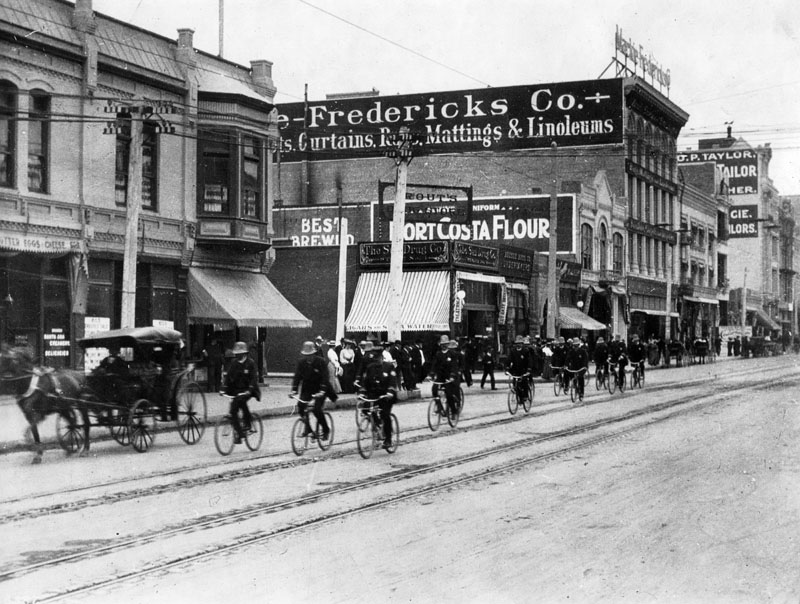 |
|
| (ca. 1904)^ - Scores of uniformed bicyclists (police officers) share the road with a horse-drawn buggy on Broadway and 6th Streets, west side looking north, on May 24, 1904. The Sun Drug Company is visible, as is Mackie Fredericks Company. |
Historical Notes By 1900 Los Angeles had 70 police officers, one for every 1,500 people. In 1903, with the start of the Civil Service, this force was increased to 200, although training was not introduced until 1916. |
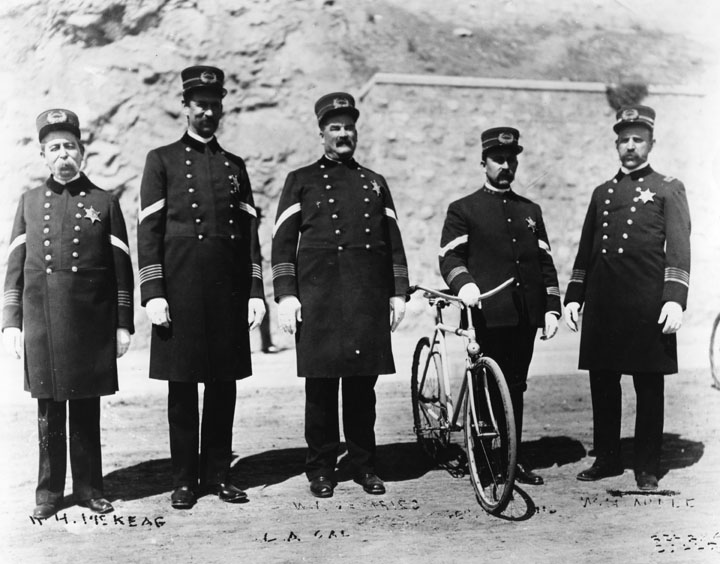 |
|
| (Early 1900s)^ - Five policemen in uniforms from the early part of the century pose for their picture. One holds a bicycle. |
Historical Notes In the early 1900s, the office of Chief of Police became increasingly politicized. From 1900 to 1923 there were sixteen different chiefs. The longest-lasting was Charles E. Sebastian, who served from 1911 to 1915 before going on to become mayor. In 1910 the department promoted the first sworn female police officer with full powers in the United States, Alice Stebbins Wells. Georgia Ann Robinson became the first African-American female police officer in the country in 1916. |
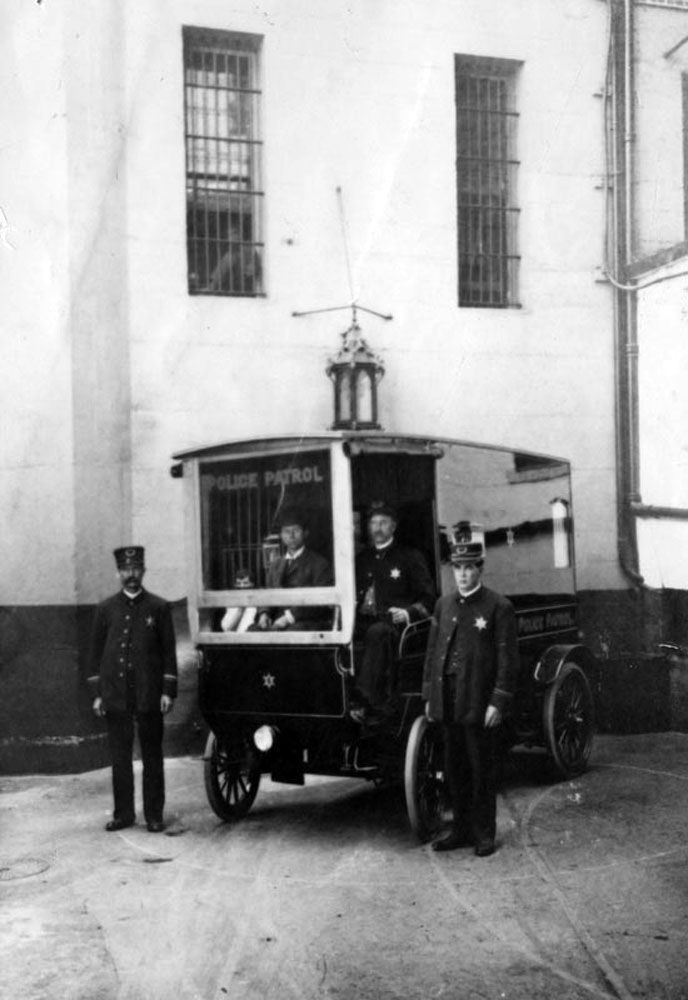 |
|
| (Early 1900s)^ - Photo of Los Angeles' first horseless patrol wagon in front of the prison. |
Historical Notes Los Angeles' first patrol wagon was also used as an ambulance. It was bought in 1904, was driven by electricity and boasted 20 miles per hour. |
\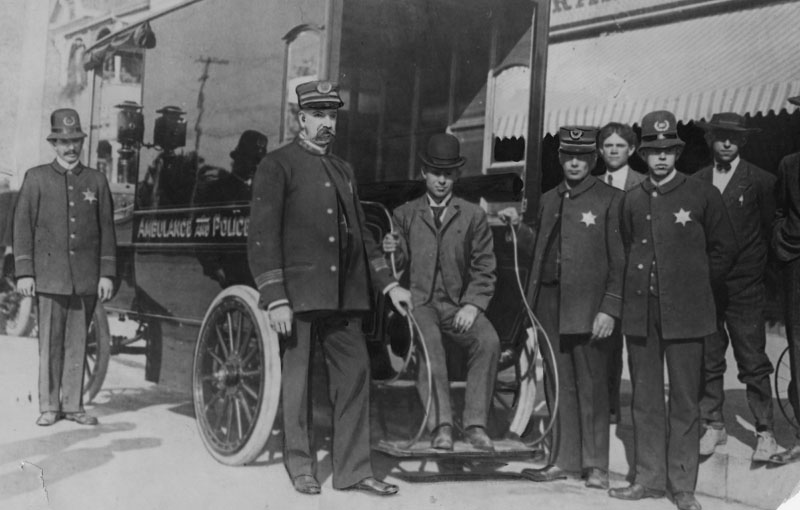 |
|
| (Early 1900s)^ - View showing police officers in front of Los Angeles' first horseless patrol wagon. At right is George Home, who became Chief of Police in later days. Captain C. L. Johnson is second from left. Photo dated: June 27, 1927. |
Historical Notes In the early 1900s, the office of Chief of Police became increasingly politicized. From 1900 to 1923 there were sixteen different chiefs. The longest-lasting was Charles E. Sebastian, who served from 1911 to 1915 before going on to become mayor. In 1910 the department promoted the first sworn female police officer with full powers in the United States, Alice Stebbins Wells. Georgia Ann Robinson became the first African-American female police officer in the country in 1916. |
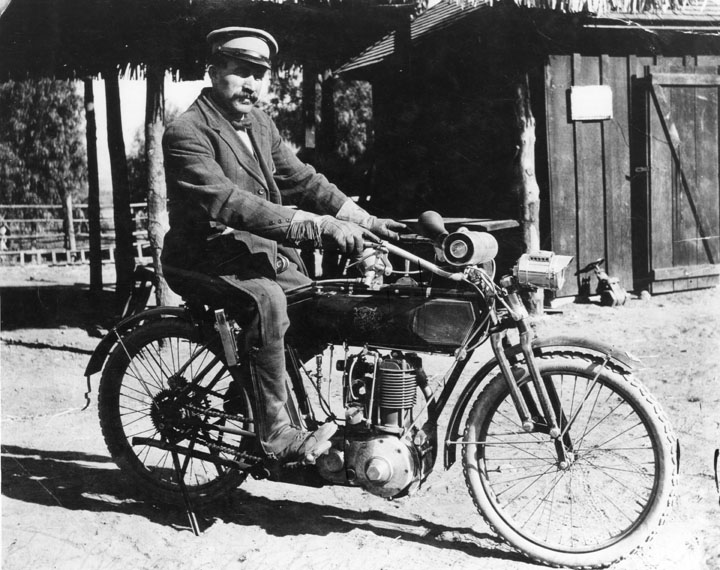 |
|
| (ca. 1910s)^ - The Griffith Park's first motorcycle officer, Bob Brown, sits here on his vehicle, by a building in the park. |
 |
|
| (1919)* - A group portrait of Los Angeles police officers standing in front of the Stephen M. White Statue, with the LA County Courthouse building behind them. At center, in front row is police chief George K. Home, wearing hat that says "Chief." The man second from left, front row, is Alexander W. Murray. |
* * * * * |
Pacific Electric Interurban Lines (Pasadena and Glendale-Burbank)
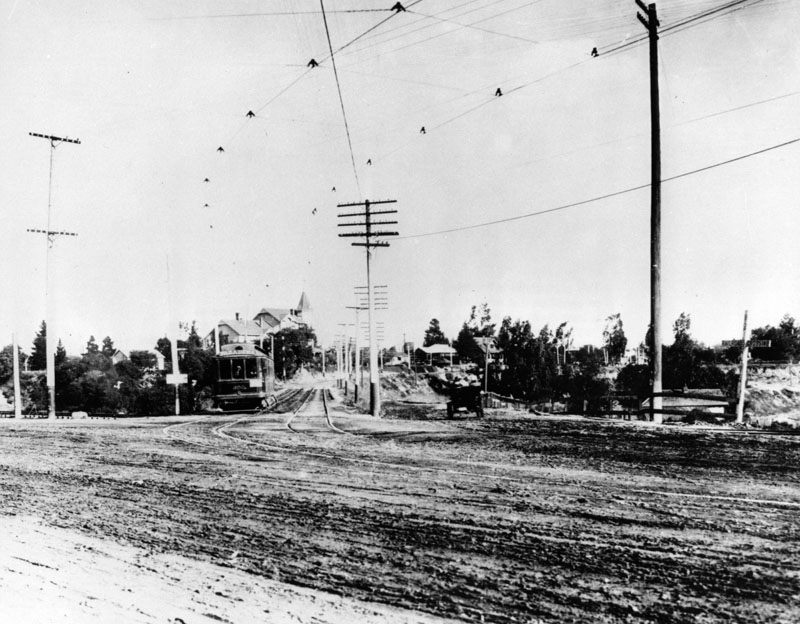 |
|
| (1904)* - Pacific Electric Railway car number 202 stopping at North Figueroa Street in Highland Park on its way to Los Angeles from Pasadena. A conductor on the left is flagging the car across the Los Angeles terminal tracks. An automobile is on the right. |
Historical Notes The Pacific Electric Interurban Lines serving Pasadena and Glendale-Burbank were vital components of Southern California’s early 20th-century electric railway network, connecting downtown Los Angeles with growing suburban communities through frequent, fast, and modern electric rail service. The Pasadena lines, among the earliest in the region, helped spur suburban development in the San Gabriel Valley, while the Glendale-Burbank line featured advanced infrastructure like a dedicated right-of-way and a downtown subway for efficient travel. Although these lines thrived during the 1910s through World War II, they declined after the war due to rising automobile use and freeway expansion, leading to their replacement by buses and eventual abandonment by the mid-1950s. |
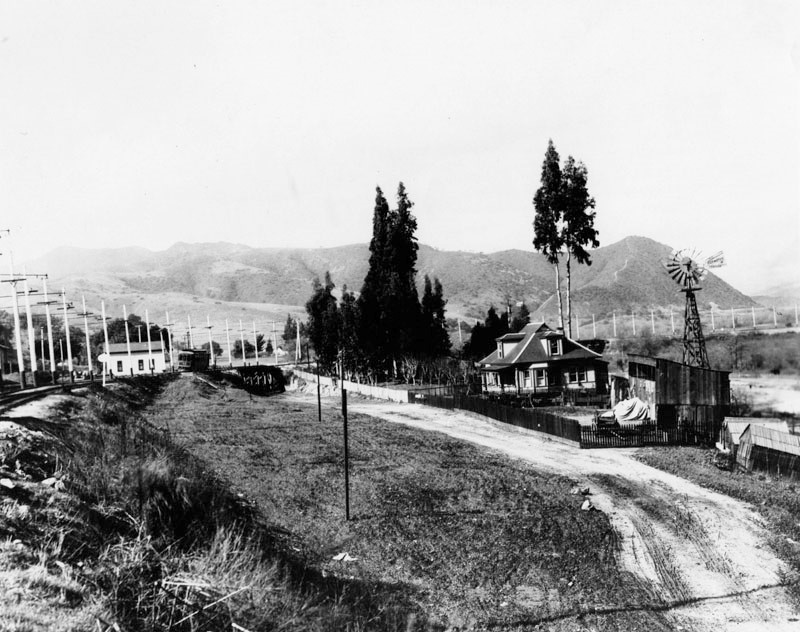 |
|
| (ca. 1904)^ - View of a Pacific Electric Railway car making its way south on its track near what is now called Riverside Drive, traveling south from the Silver Lake and Los Feliz areas. The 5 Freeway is now located at this spot. Griffith Park is visible in the background and a few homes can be seen as well. |
Historical Notes The Glendale-Burbank Line was for many years PE's finest example of suburban rail service. It presented multiple unit PCC cars, considerable private way and the subway entry into downtown Los Angeles. PE brought such crowds to Glendale that in 1906 the incorporation of the city was effected. |
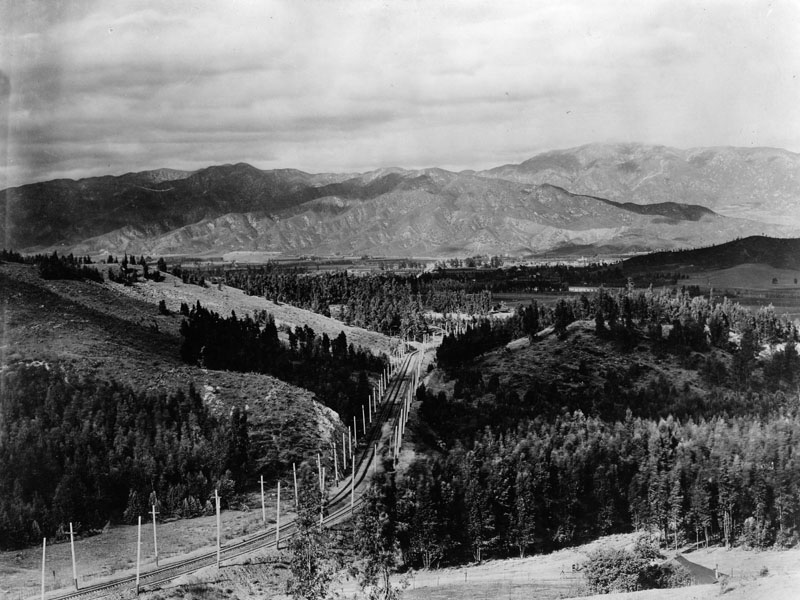 |
|
| (1904)^ - Panoramic view looking north toward Glendale along the Pacific Electric line through the Edendale Cut. |
Historical Notes The Edendale Cut was an unpaved road (some of which is now known as Silver Lake Ct.) and was the former route of the Glendale and Burbank interurban railway lines operated by Pacific Electric. The line crossed Fletcher Drive over a viaduct before continuing along a hillside ledge to the Monte Sano stop at Glendale Blvd. and Riverside Drive. |
* * * * * |
Fletcher Viaduct
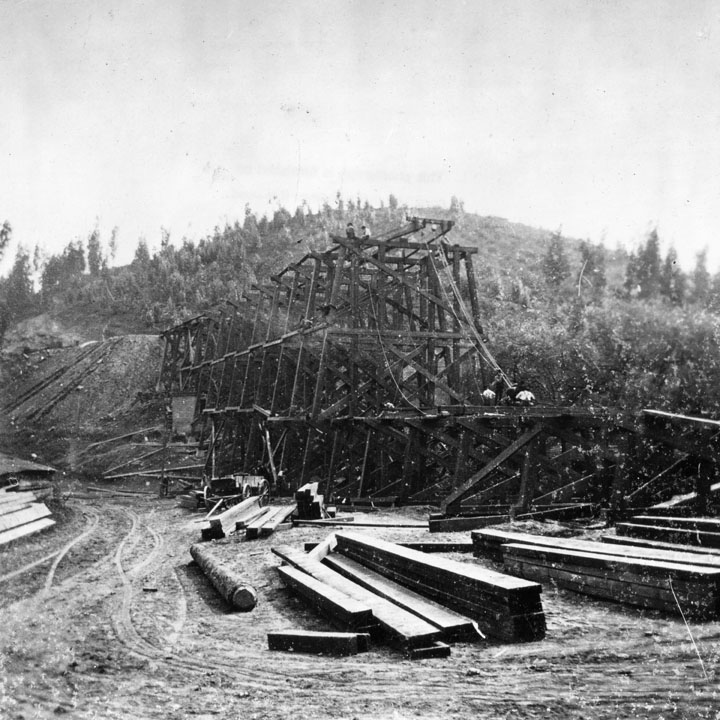 |
|
| (1904)^ - View showing the construction of the Fletcher Viaduct at Riverside Drive in Silver Lake. It was built for the PE Glendale-Burbank Line through Edendale. |
Historical Notes The Pacific Electric Glendale and Burbank interurban railway lines, including the Fletcher Viaduct, was constructed in 1904 and abandoned in 1955.* All viaducts are a type of bridge, but not all bridges are viaducts. The key difference between a viaduct and a bridge is that a viaduct is a long, elevated structure that carries a road or railway across a valley, gorge, or other low-lying area, while a bridge is typically used to cross a body of water. What makes the Fletcher overcrossing a viaduct and not a bridge is that it is an elevated, arched structure used to carry transportation infrastructure across a gap in the terrain, rather than over a river, lake, or other body of water. |
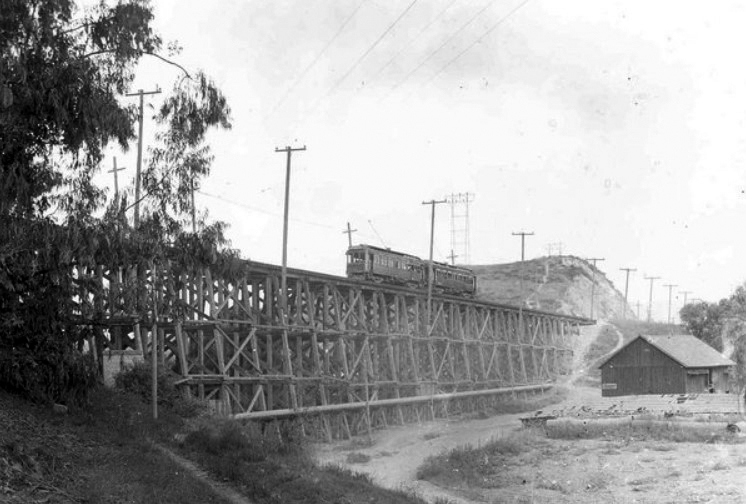 |
|
| (Early 1900s)^## – View showing two PE cars of the Glendale-Burbank Line on top of the Fletcher Drive timber bridge. |
Historical Notes In 1904, a nearly 454 foot long bridge, the Fletcher Viaduct, was built over Fletcher Drive, which ran forty feet below. The viaduct stood until 1928 when it was replaced by a steel structure bridge.* |
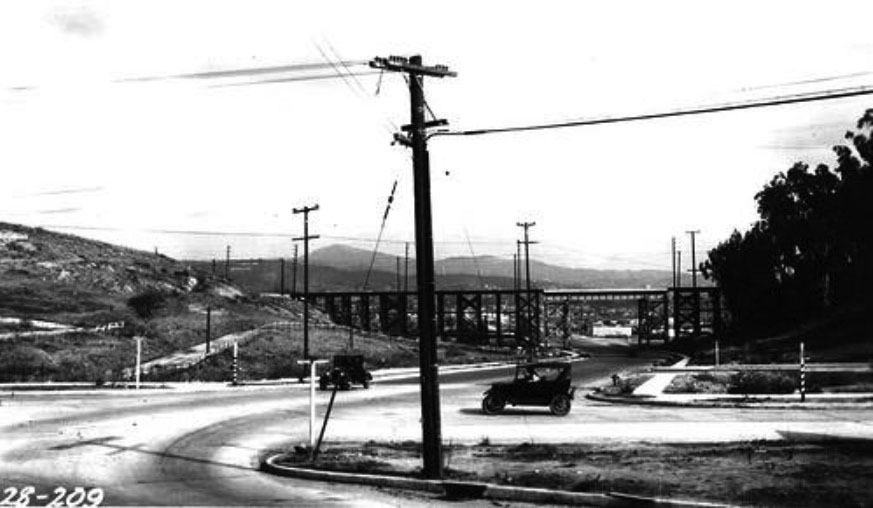 |
|
| (ca. 1920)* – View looking northeast from the intersection of Fletcher Drive and Glendale Boulevard showing the Fletcher Drive Viaduct in the distance. |
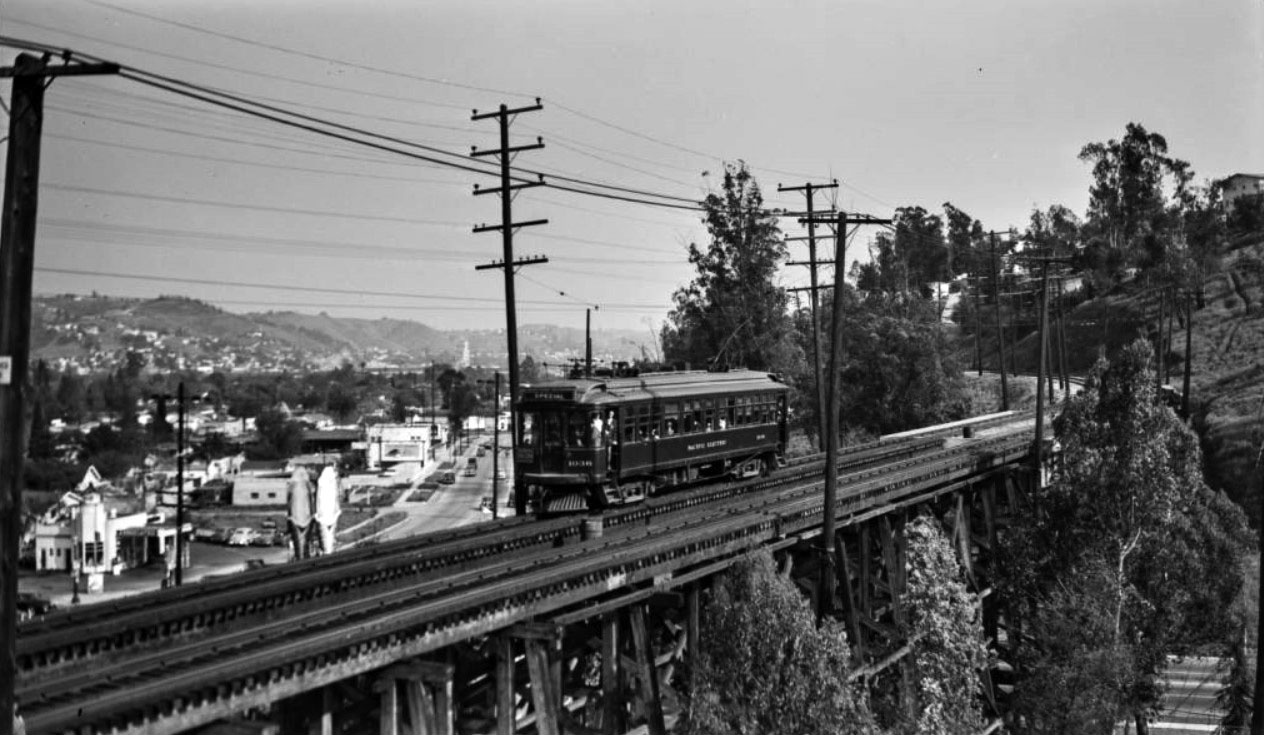 |
|
| (ca. 1928)* - Pacific Electric Railway streetcar going over the Fletcher Drive trestle on the Glendale-Burbank. Currie’s Ice Cream (large cone on top of building) can be seen in at center-left. |
Historical Notes In 1928, when Fletcher was paved, the original timber bridge was replaced with a steel structure mounted on concrete footings. The newer structure soared more than 60 feet above the street.* |
 |
|
| (ca.1938)^ – View looking north from what was once commonly known as Edendale shows Pacific Electric railroad tracks crossing Fletcher Drive and the intersection of Fletcher and Riverside Drive in Silver Lake. The ice cream cone shaped sign and long gabled roof building of Currie's Ice Cream can be seen on the northwest corner just past the bridge. |
 |
|
| (ca. 1939)^ – View looking east on Fletcher at Riverside as seen from the top of the Fletcher Viaduct. |
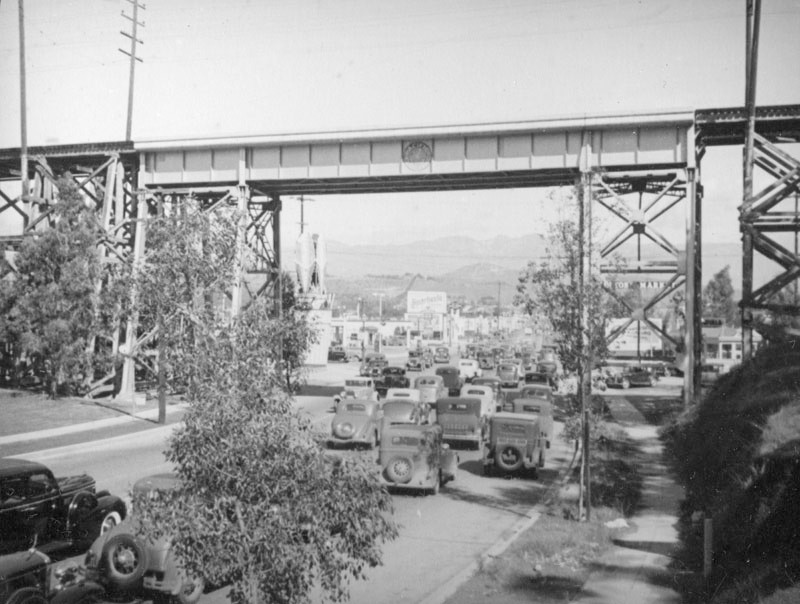 |
|
| (ca. 1938)^ - View of the Fletcher Drive Viaduct seen here with steel trestles that replaced the wooden bridge in 1928. The ice cream cone shaped sign for Currie's Ice Cream (2500 Riverside Drive) can be seen on the left just past the bridge. Atwater Village, Glendale, and the San Gabriel Mountains are seen in the center. |
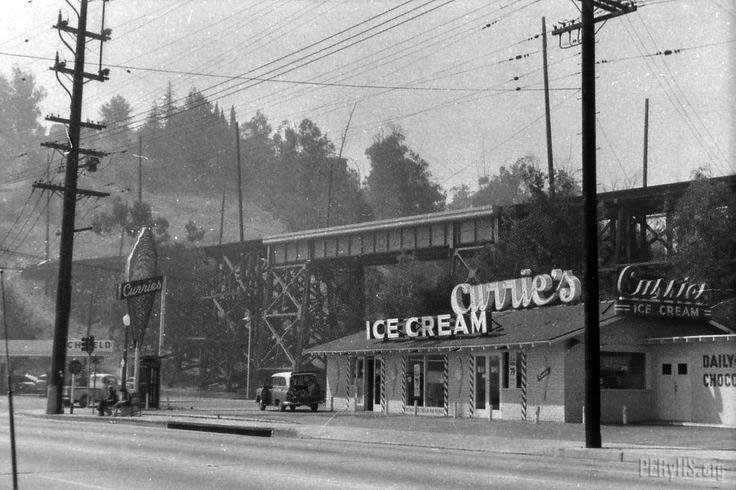 |
|
| (ca. 1940s)* – View showing the Fletcher Drive Viaduct with Currie’s Ice Cream (2500 Riverside Drive) seen in the foreground. The building is still there, just remodeled and expanded. It is now occupied by Home Restaurant and Bar. Click HERE for contemporary view. |
Historical Notes People still fondly remember the Currie’s chain and its “mile-high cone” whose replica was often displayed billboard-style on roofs. The chain was started in 1927 by three brothers named Kuhns. After WWII they sold it to the Good Humor Company who later sold it to Lipton in the 1960s. In 1964 the chain opened its 87th store, in North Hollywood. Although Currie’s anticipated launching units in every community in Southern California, only three outlets were listed in the 1967 Los Angeles phone book and the chain had disappeared by the 1980s.* |
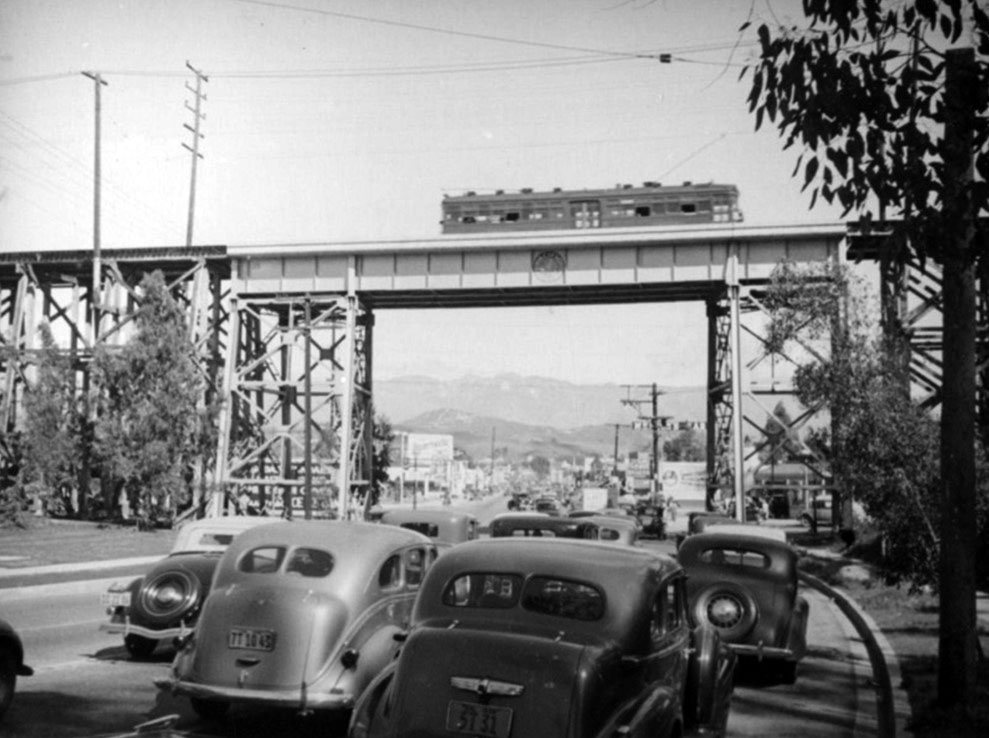 |
|
| (ca. 1939)^ - Ground view of the steel-framed Fletcher Drive Viaduct that replaced the original wooden bridge. |
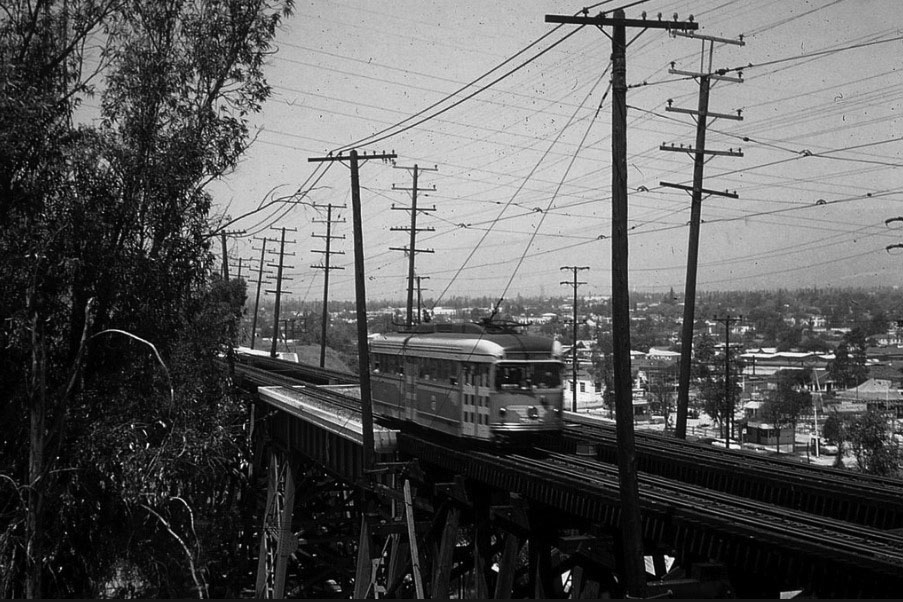 |
|
| (1955)^## – View showing Pacific Electric Railway car no. 5008 inbound at the Fletcher Drive trestle. The steel-framed viaduct would be torn down in 1959 leaving behind only its concrete footings. |
Historical Notes The 1928-built steel trestle remained in place until 1959, when it and the nearby Riverside Drive Viaduct at Glendale Boulevard were demolished. |
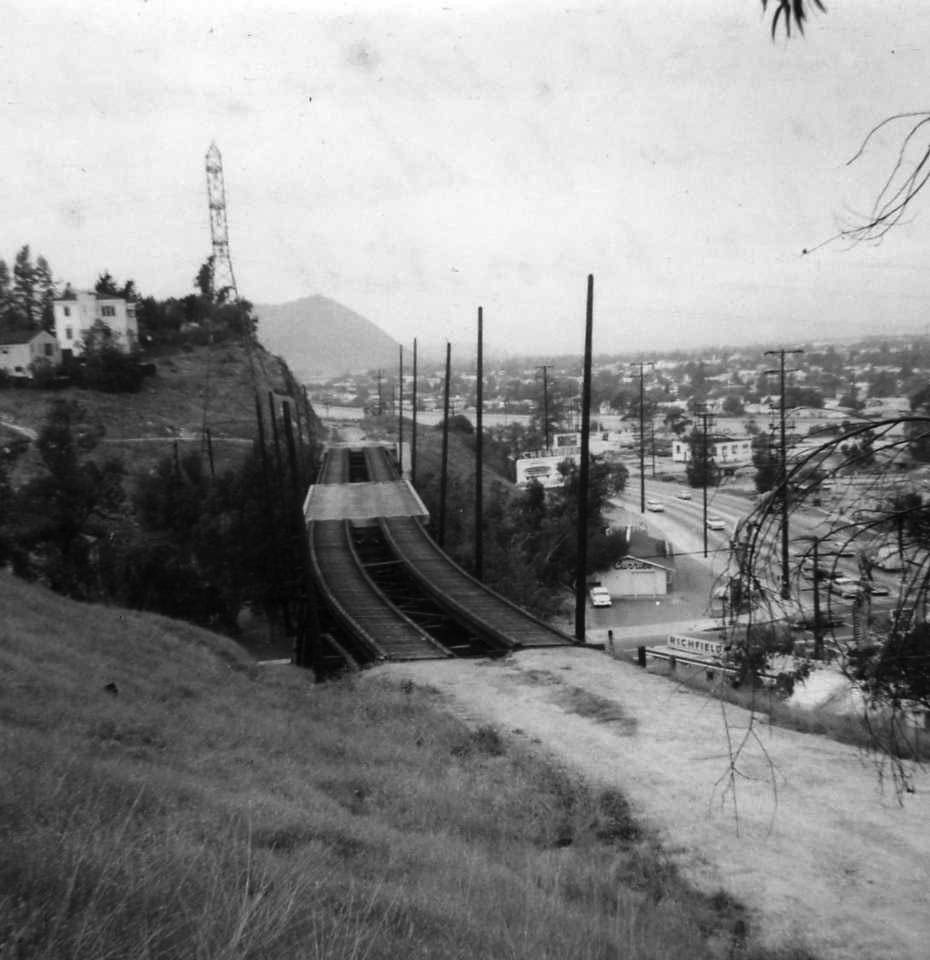 |
|
| (1959)^ – Top view of the Fletcher Viaduct shortly before it was demolished. Note the Richfield Service Station just below at center-right. |
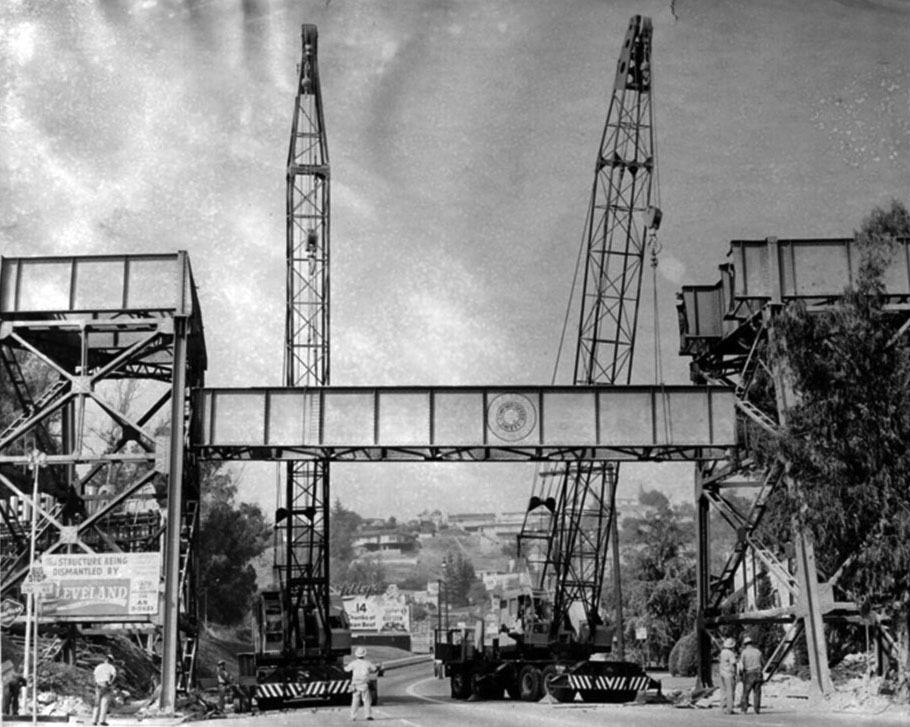 |
|
| (1959)* - Demolition of the old Pacific Electric bridge (aka Fletcher Viaduct) at Fletcher and Riverside drives. |
Historical Notes The viaduct, originally constructed in wood in 1904, was rebuilt as a steel trestle in 1928. It stood until 1959 when it, along with the nearby Riverside Drive Viaduct at Glendale Boulevard, was demolished |
 |
|
| (2022)* – Looking SW on Fletcher Drive from near Riverside Drive toward where the old Fletcher Viaduct used to stand. |
Historical Notes Today the Fletcher Viaduct's concrete footings and pylons are still there and have been designated as LA Historic-Cultural Monument No. 770 (Click HERE to see complete listing). |
Then and Now
 |
|
| (1959 vs 2022)* – Looking SW on Fletcher Drive from near Riverside Drive showing the Fletcher Viaduct before and after demolition. Photo comparison by Jack Feldman. |
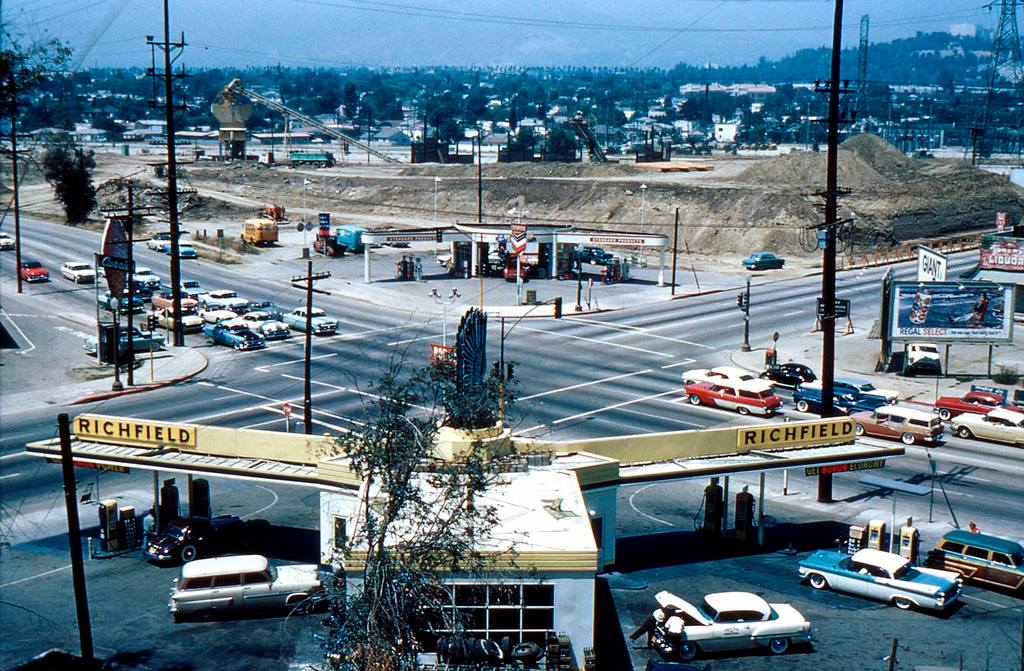 |
|
| (1950s)* – View looking northwest down toward the intersection of Fletcher and Riverside drives as seen from a Glendale Red Car on top of the Fletcher Viaduct. Currie’s Ice Cream store sign is visible on the left and the I-5 (Golden State Freeway) is at the excavation stage. The chapel at Forest Lawn can be seen in the distance (upper-right). Richfield Gas Station is the foreground. Click HERE to see more Early LA Gas Stations. |
Then and Now
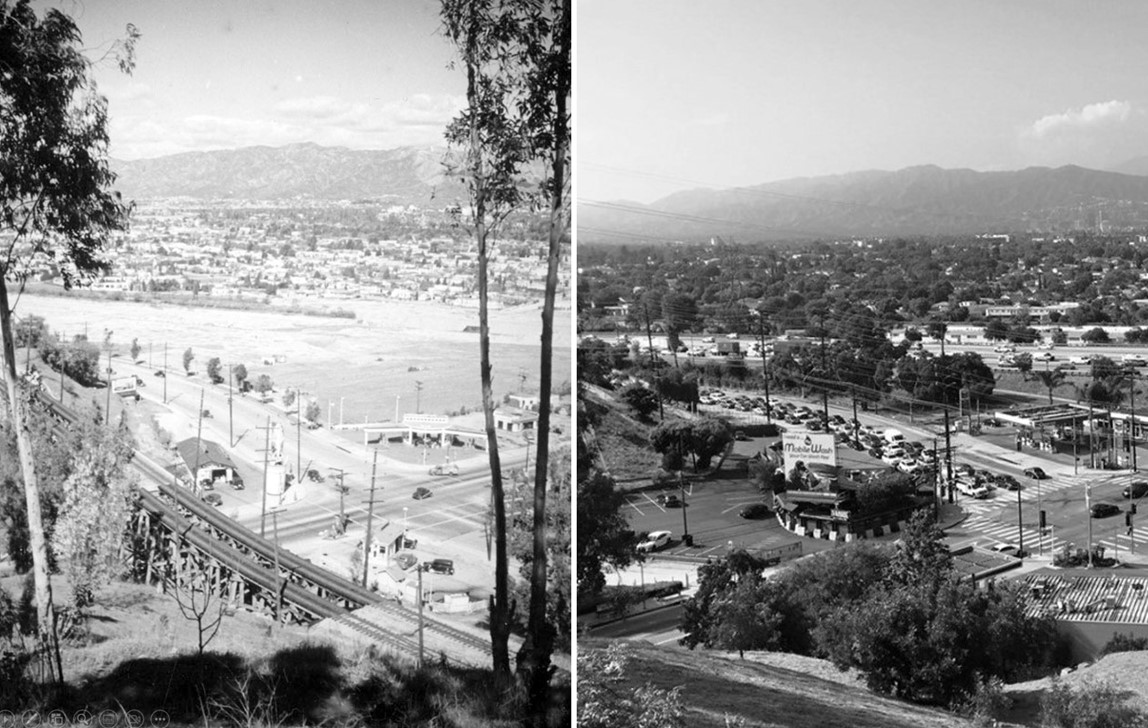 |
|
| (1938 vs. 2019)^ - View looking down toward the intersection of Fletcher and Riverside drives. Photo comparison by Jack Feldman. |
* * * * * |
Edendale
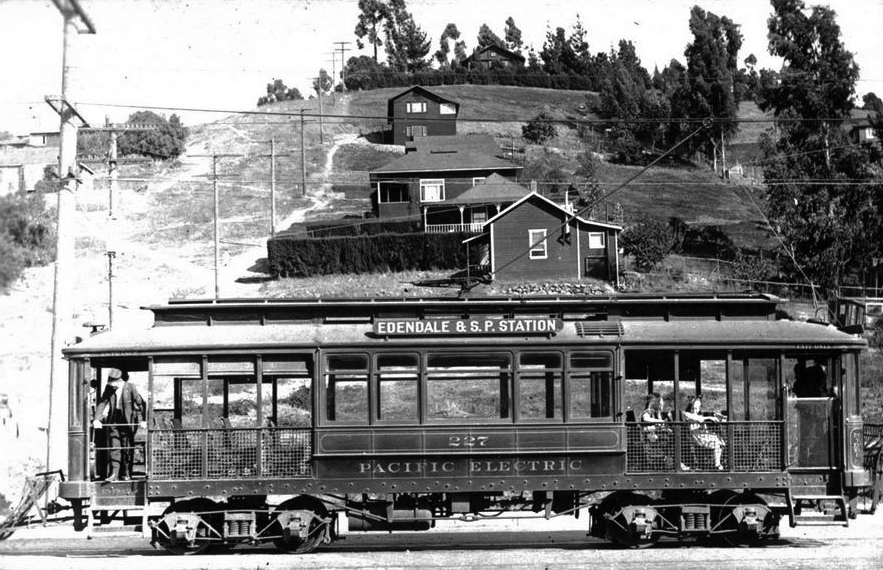 |
|
| (ca. 1914)^## – View showing Pacific Electric City Car No. 227 on the Edendale Glendale-Burbank Line. |
Historical Notes Edendale was the valley along Glendale Boulevard that traverses from Echo Park to the beginning of the 2 Freeway. Today the area is considered Silverlake on the west side and Elysian Park to the east. The grass median that runs along Glendale Boulevard used to be the Red Line Train that ran from downtown and would eventually be extended to Glendale along the hills behind the Red Lion Tavern. Edendale was widely known as the home of most major movie studios on the West Coast. Among its many claims, it was home to the Keystone Kops, and the site of many movie firsts, including Charlie Chaplin's first movie, the first feature-length comedy, and the first pie-in-the-face. The Edendale movie studios were mostly concentrated in a four-block stretch of Allesandro Street, between Berkeley Avenue and Duane Street. Allesandro Street was later renamed Glendale Boulevard (and a smaller nearby street took on the name Allesandro). The name Edendale is no longer used as a place name, and is little known today. A few remnants of the name are the local post office (officially called Edendale Station), a public library branch, an urban farm called Edendale Farm and a restaurant called Edendale. Although many of the structures from the 1910s remain and can be identified by careful comparison with old photos, this district today is located in an unremarkable commercial zone called the "Glendale Boulevard Corridor," which is known mostly for its function as a commuter thoroughfare between the southern end of the Glendale Freeway and downtown Los Angeles.*^ Click HERE to see a 1916 map showing the location of Edendale. |
 |
|
| (1910s)^.^ – Edendale Map showing all the studios along Allessandro Street (later Glendale Boulevard). |
Historical Notes The Los Angeles district of Edendale was one of the biggest producers of motion pictures in the entire world. It was here that the first screen pie fight broke out. It was also here that Roscoe “Fatty” Arbuckle and Mabel Normand became household names. Ant it was also in Edendale that an unknown English music-hall performer named Charles Chaplin first picked up a cane and derby, pasted on a stage mustache, slid into some baggy pants and an unusually large pair of mismatched boots, and waddled into the hearts of movie watchers worldwide.^ The Edendale movie studios were mostly concentrated in a four-block stretch of Allesandro Street, between Berkeley Avenue and Duane Street. Allesandro Street was later renamed Glendale Boulevard (and a smaller nearby street took on the name Allesandro). The former Mack Sennett Studio where Keystone Kops films were shot still stands behind a Jack in the Box -- although it's been repurposed as a Public Storage facility. Click HERE for contemporary view. |
Selig Polyscope Company Studio
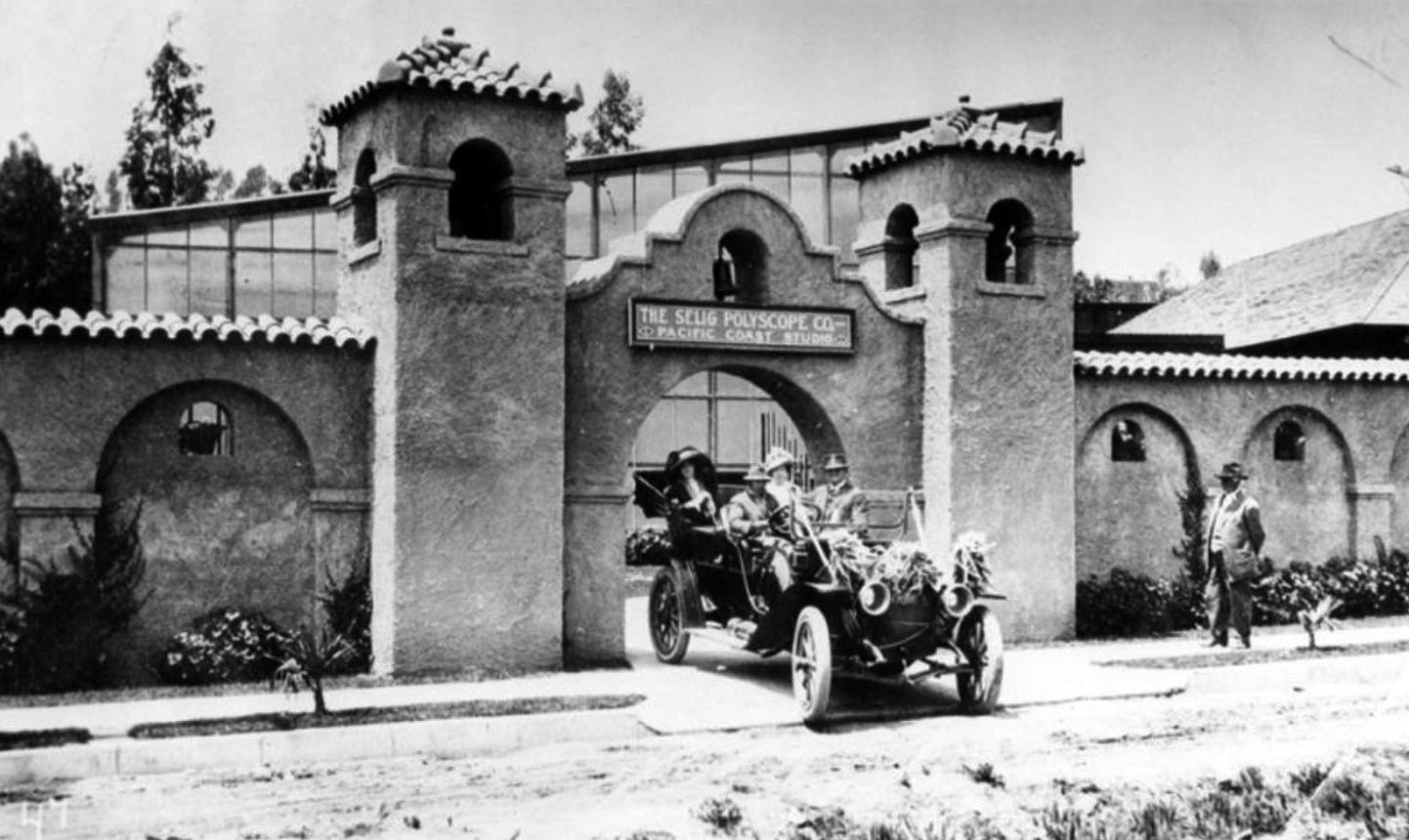 |
|
| (ca. 1909)^ - An early automobile is pulling out of the driveway of The Selig Polyscope Co., Pacific Coast Studio, onto an unpaved street. The studio is built in Mission Revival style located at 1850 Allesandro Street, later renamed Glendale Boulevard, in Edendale. |
Historical Notes Attracted by Southern California's mild, dry climate and varied geography for location shooting, William Selig set up his studio in Edendale in 1909 with director Francis Boggs, who began the facility in a rented bungalow and quickly expanded, designing the studio's front entrance after Mission San Gabriel.*^ |
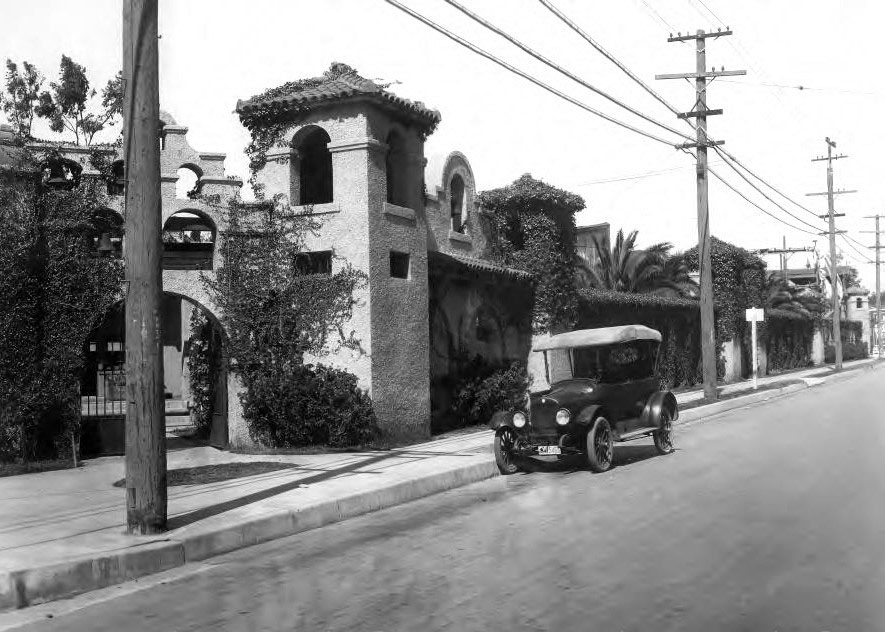 |
|
| (ca. 1910)*^ - Street view showing a car parked in front of the Selig Polyscope Company Studio in Edendale. |
Historical Notes Selig Plyscope Company produced hundreds of early, widely distributed commercial moving pictures, including the first films starring Tom Mix, Harold Lloyd, Colleen Moore, and Roscoe "Fatty" Arbuckle. In 1917 Selig sold the Edendale facility to producer William Fox and moved his movie studio to his zoo located in east Los Angeles. Meanwhile, World War I cut severely into the substantial revenues Selig Polyscope had been garnering in Europe and the company shunned profitable movie industry trends, which had shifted towards dramatic (and more costly) full length feature films. Selig Polyscope became insolvent and ceased operations in 1918.*^ Click HERE to see more on the Selig Zoo. |
William Fox Studio (formerly Selig Studio)
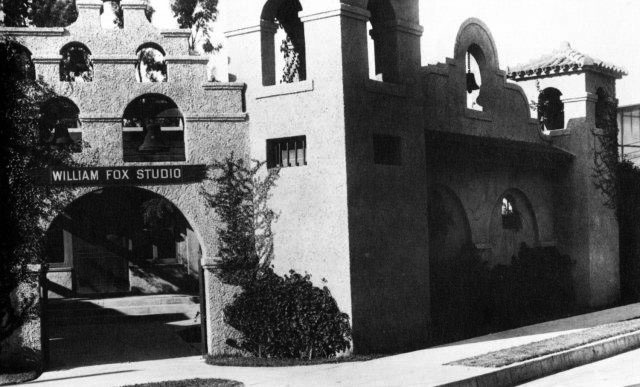 |
|
| (ca. 1917)^.^ - William Fox Studio at the former Selig Polyscope Co. Studio. Fox bought it from Selig around 1917. |
Historical Notes Long before there was Twentieth Century-Fox, there was the William Fox Studios at 1845 Allesandro St. in what was then called Edendale. |
 |
|
| (ca. 1916)^ - Selig studio building and swimming pool, leased by William Fox, located at the corner of Alessandro Avenue (later Glendale Boulevard) and Clifford Street. Two cars are parked, and there is a wave-making machine in the pool. |
Historical Notes William Fox (born as Wilhelm Fuchs) was a Hungarian-American motion picture executive, who founded the Fox Film Corporation in 1915 and the Fox West Coast Theatres chain in the 1920s. Although he lost control of his movie empire in 1930, his name lives on in the names of various media ventures, which are currently either owned by Rupert Murdoch, such as the Fox Broadcasting Company and the Fox News Channel, or by The Walt Disney Company, such as 20th Century Fox and 21st Century Fox.*^ |
Mack Sennett Studios (aka Keystone Studios)
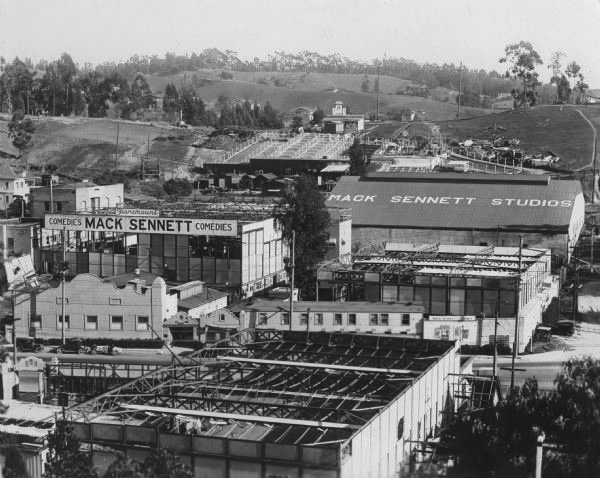 |
|
| (ca 1917)* - A high view of the Mack Sennett Studios showing many open-roofed studios with cloth diffusers. A huge sign reads: "Paramount-Comedies-Mack Sennett-Comedies." Paramount Pictures distributed Sennett's silent films from 1917 to 1921. The present address of the site is 1712 Glendale Boulevard, Echo Park. |
Historical Notes Keystone Studios was an early movie studio founded in Edendale (which is now a part of Echo Park) on July 4, 1912 as the Keystone Pictures Studio by Mack Sennett with backing from actor-writer Adam Kessel and Charles O. Baumann, owners of the New York Motion Picture Company. The company filmed in and around Glendale and Silver Lake for several years, and its films were distributed by the Mutual Film Corporation between 1912 and 1915.*^ The original main building, the first totally enclosed film stage and studio in history, is still standing at Glendale Blvd. between Aaron and Effie Streets in Echo Park, although it's been repurposed as a Public Storage facility. |
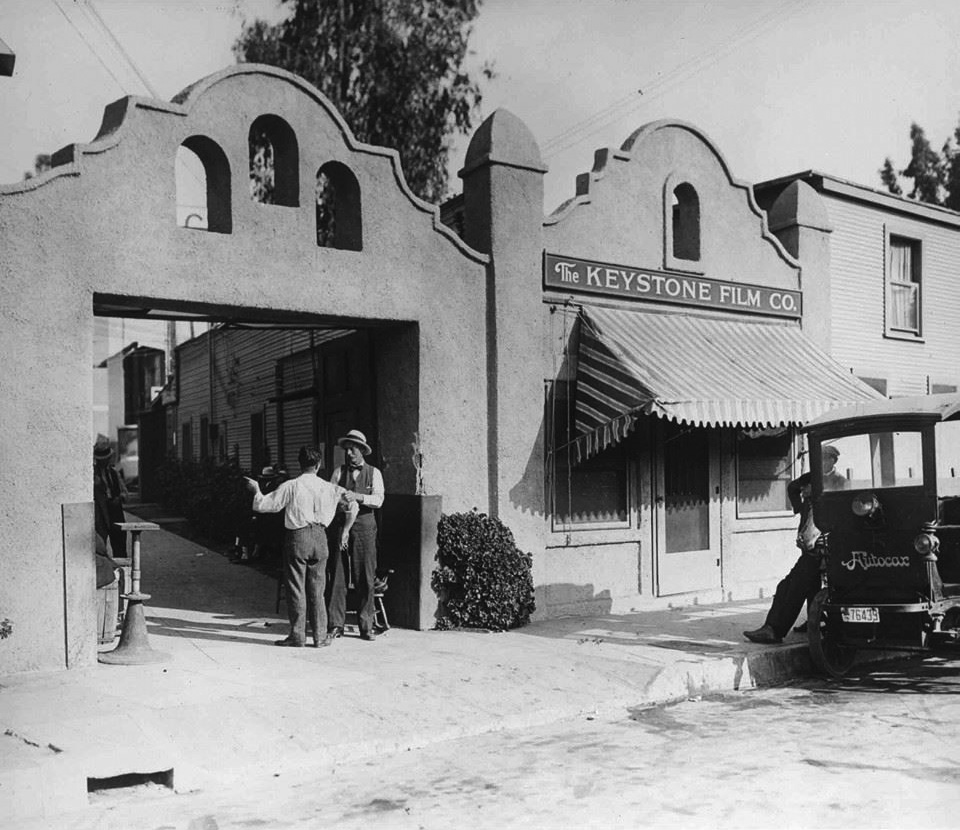 |
|
| (ca. 1917)* – Two men stand at the entryway to the Mack Sennett Studios while another two men are by an electric vehicle parked at the curb. The entrance was located at 1712 Allesandro Street (later Glendale Boulevard around 1922-23) in Edendale (later Echo Park). |
Historical Notes The studio is perhaps best remembered for the era under Mack Sennett when he created the slapstick antics of the Keystone Cops, from 1912, and for the Sennett Bathing Beauties, beginning in 1915. Charles Chaplin got his start at Keystone when Sennett hired him fresh from his vaudeville career to make silent films. Other important actors worked at Keystone toward the beginning of their film careers, including Marie Dressler, Harold Lloyd, Mabel Normand, Roscoe Arbuckle, Gloria Swanson, Louise Fazenda, Raymond Griffith, Ford Sterling, Ben Turpin, Harry Langdon, Al St. John and Chester Conklin.*^ |
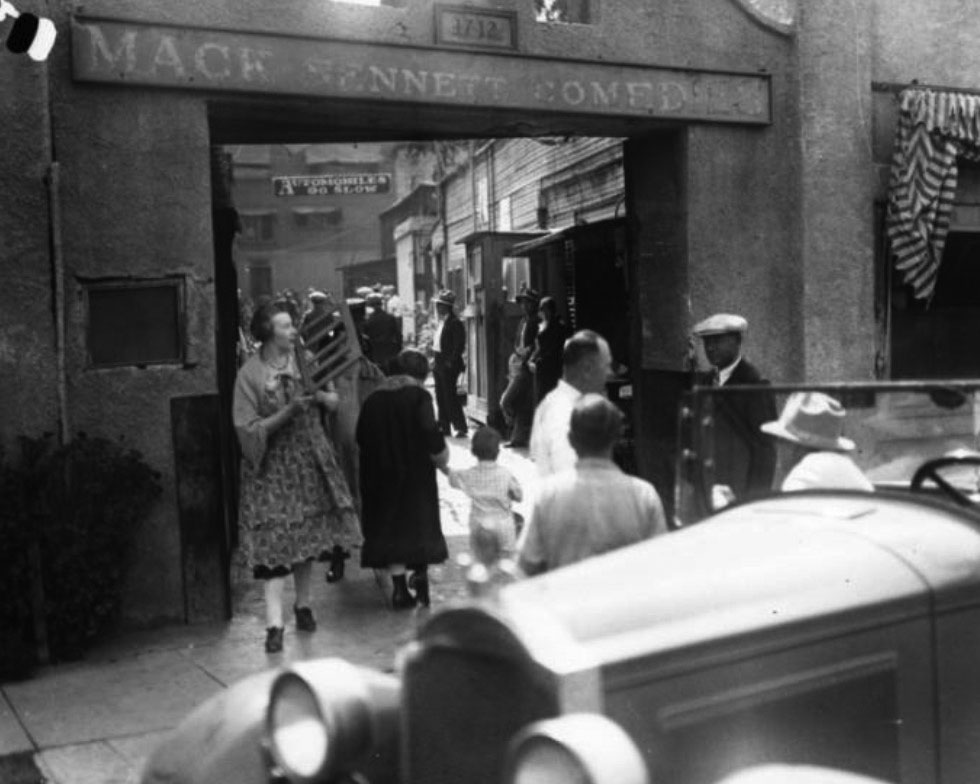 |
|
| (ca. 1917)^ – View showing the entrance to the Mack Sennett Comedies studio, located at 1712 Allesandro Street in Edendale. |
Historical Notes Mack Sennett's slapstick comedies were noted for their wild car chases and custard pie warfare, especially in the Keystone Cops series. Additionally, Sennett's first female comedian was Mabel Normand, who became a major star under his direction and with whom he embarked on a tumultuous romantic relationship. Sennett also developed the Kid Comedies, a forerunner of the Our Gang films, and in a short time, his name became synonymous with screen comedy which were called "flickers" at the time. Sennett departed the studio in 1917 to produce his own independent films (eventually distributed through Paramount). Keystone's business decreased after his departure, and finally closed after bankruptcy in 1935.*^ |
Norbig Studios
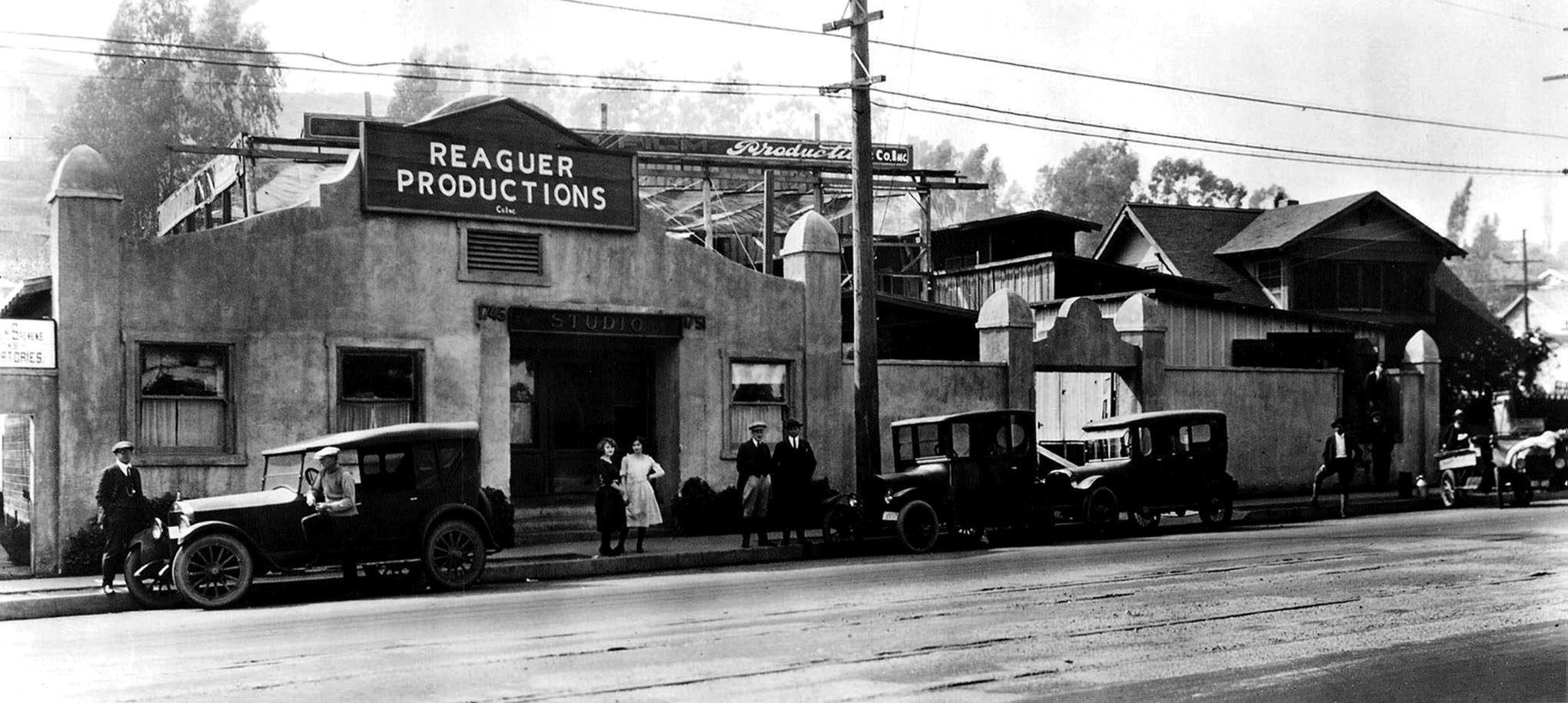 |
|
| (1922)^ – View showing Reaguer Productions located in the Norbig Studios at 1745-1751 Allesandro (now Glendale Blvd), between Aaron and Branden Streets, on the border between Echo Park and Silverlake. Click HERE for contemporary view. |
Historical Notes The above Edendale lot, now gone, was owned by Norbig Studios. It served as a rental lot housing many early companies, including: ◆ Norbig Studios (1914-1919) Studio is long since gone.* Edendale would eventually run out of moviemaking space and within a decade studios were moving over the hill to the dry Methodist community of Hollywood. Edendale’s final claim to fame would be the community of artists and communists that lived there right before World War II. With the construction of the Glendale Freeway cutting up the neighborhood, Edendale became Silverlake, Los Feliz, and Elysian Fields. |
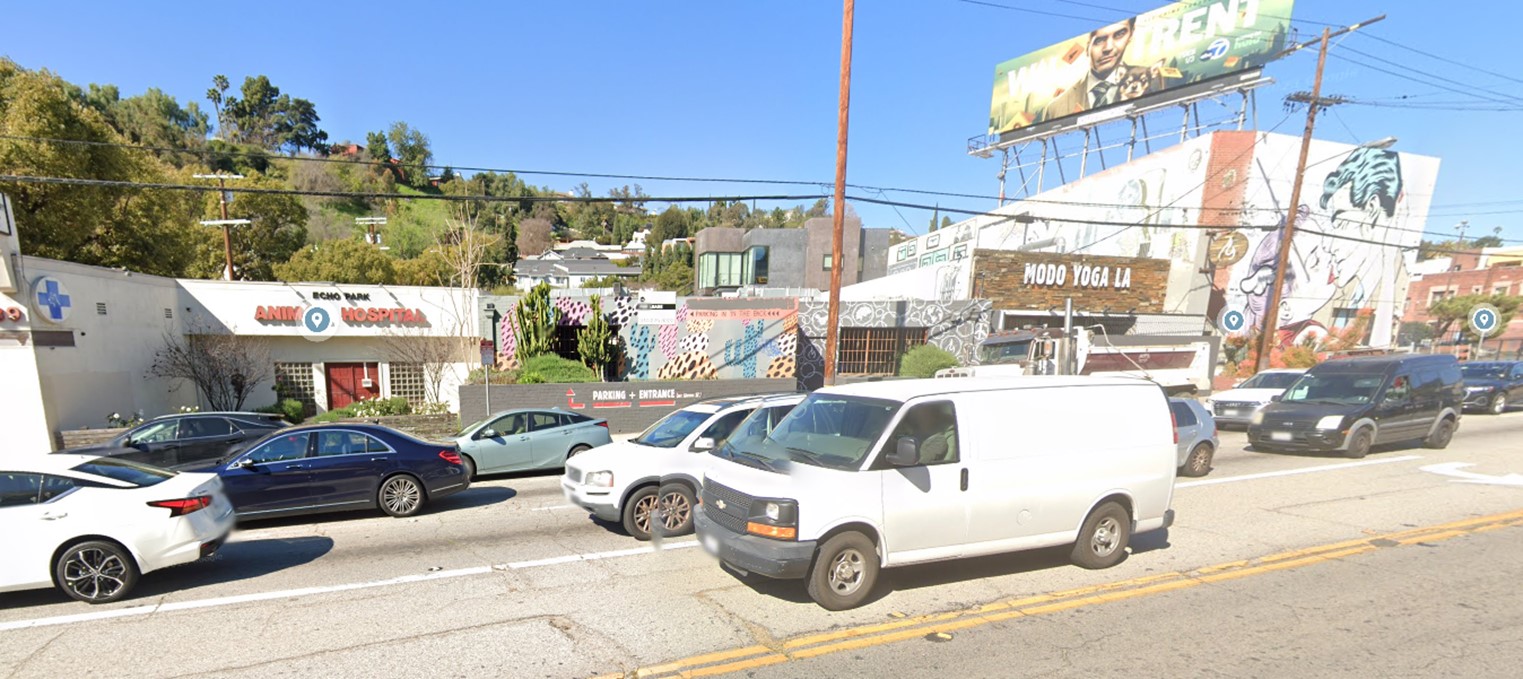 |
|
| (2023)* - Looking at the west side of Glendale Bouelvard (originally Alesandro Avenue) where Reaguer Productions, Norbig Studios, and so many other movie production companies once operated from. |
Then and Now
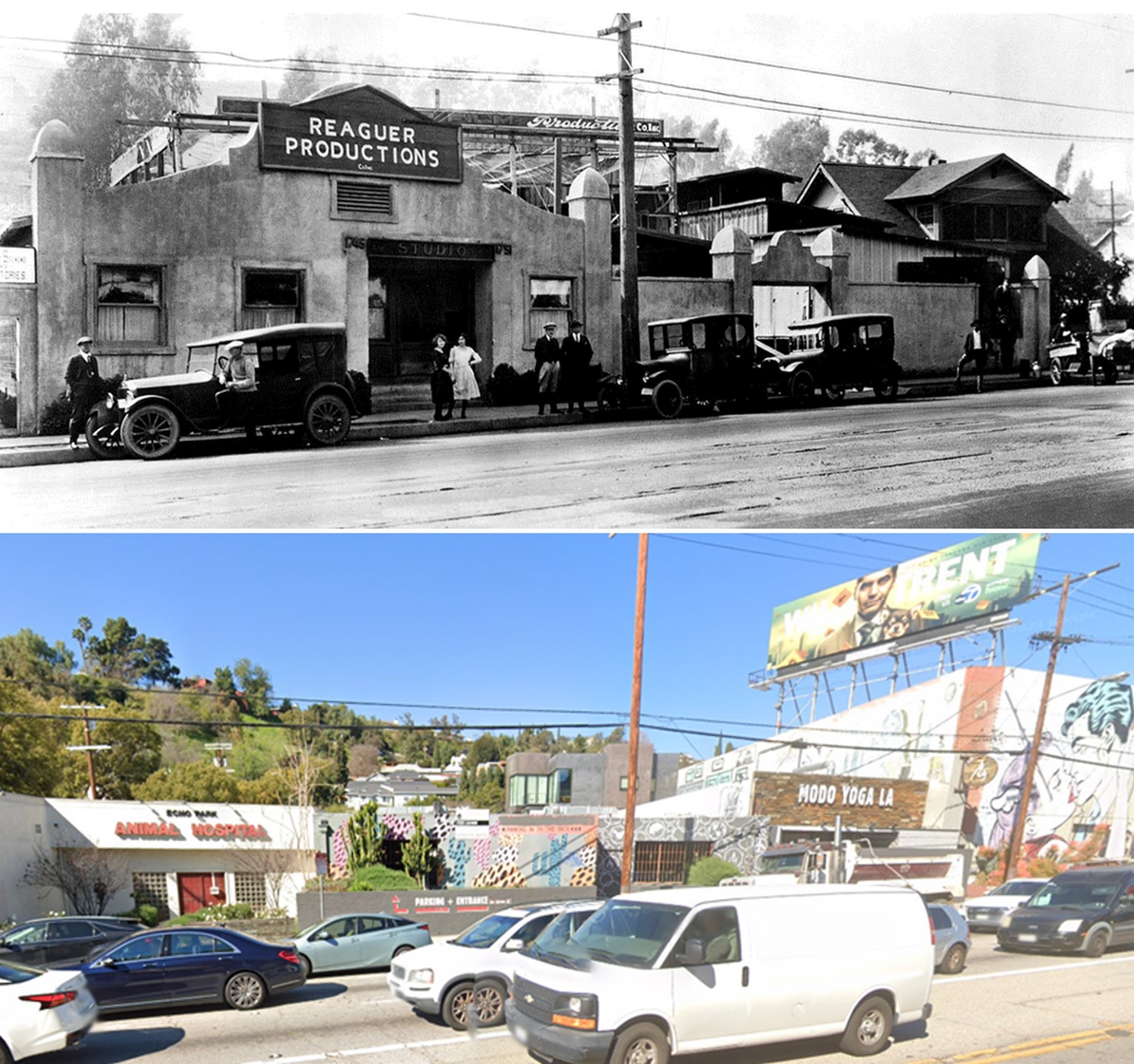 |
|
| (1922 vs 2023)* - Looking at the west side of Glendale Bouelvard (originally Alesandro Avenue) where Reaguer Productions, Norbig Studios, and so many other movie production companies once operated from. Located at 1745-1751 Allesandro (now Glendale Blvd), between Aaron and Branden Streets. Photo comparison by Jack Feldman. |
* * * * * |
Silver Lake
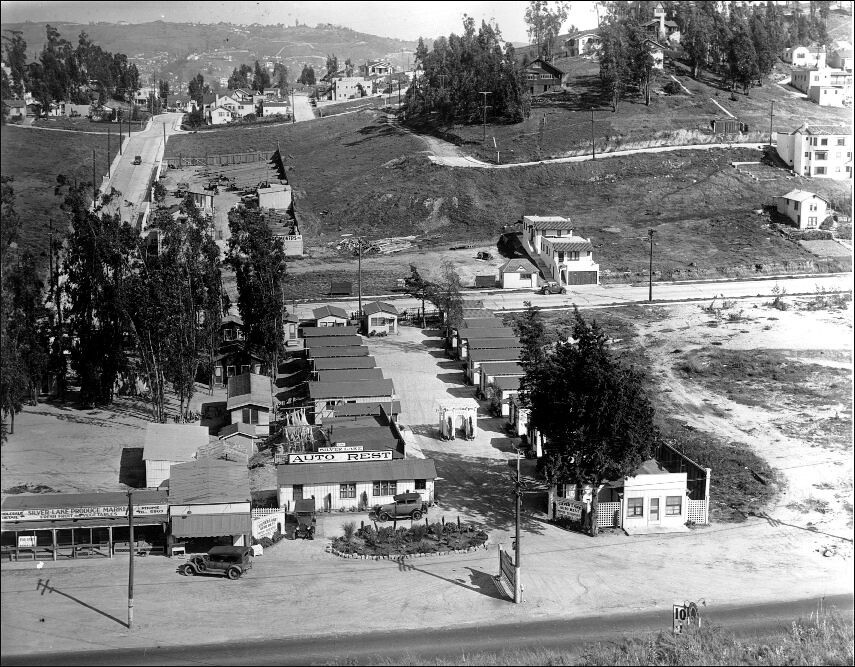 |
|
| (1920s)* - Looking down across Glendale Boulevard showing the Silver Lake Auto Court located at 2500 Glendale Blvd. The street on the left running away from the camera is India Street. |
Historical Notes Silver Lake is a residential and commercial neighborhood in the east-central region of Los Angeles. Originally home to a small community called Ivanhoe in honor of Sir Walter Scott. In 1907, the Los Angeles Water Department built the Silver Lake Reservoir, named for LA Water Commissioner Herman Silver, giving the neighborhood its name. The area is now known for its architecturally significant homes, independently owned businesses, diverse restaurants, painted staircases, and a creative environment. The neighborhood is also home to several highly rated public and private schools. Click HERE to see more on the Silver Lake Reservoir. |
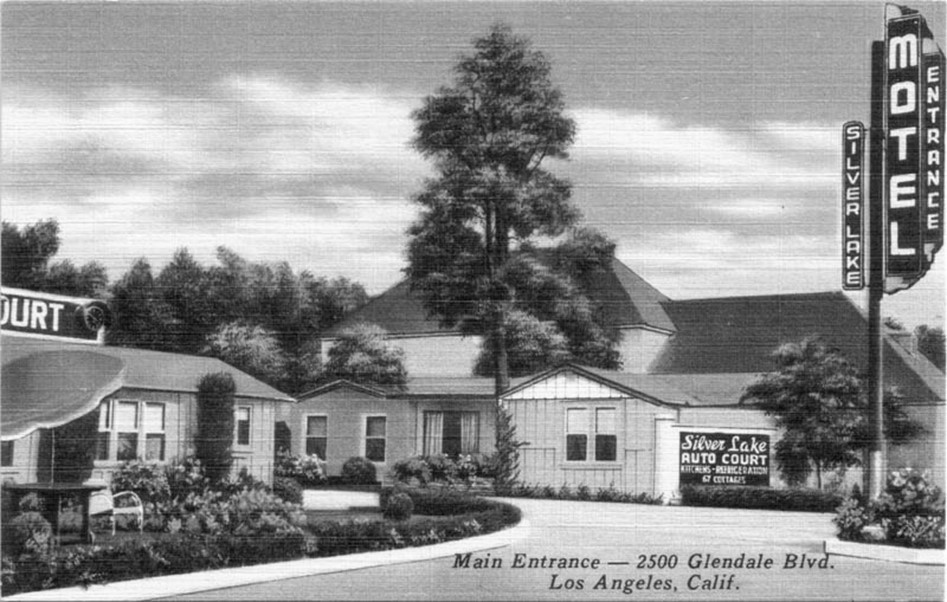 |
|
| (n.d.)* – Postcard view showing the main entrance to Silver Lake Auto Court at 2500 Glendale Blvd. |
Historical Notes On the reverse of the card it states: "A 67 unit Auto Court with Trailer Sites. Resort Atmosphere in the heart of the City, well known for its Hospitality and Service. Rates Most Reasonable." |
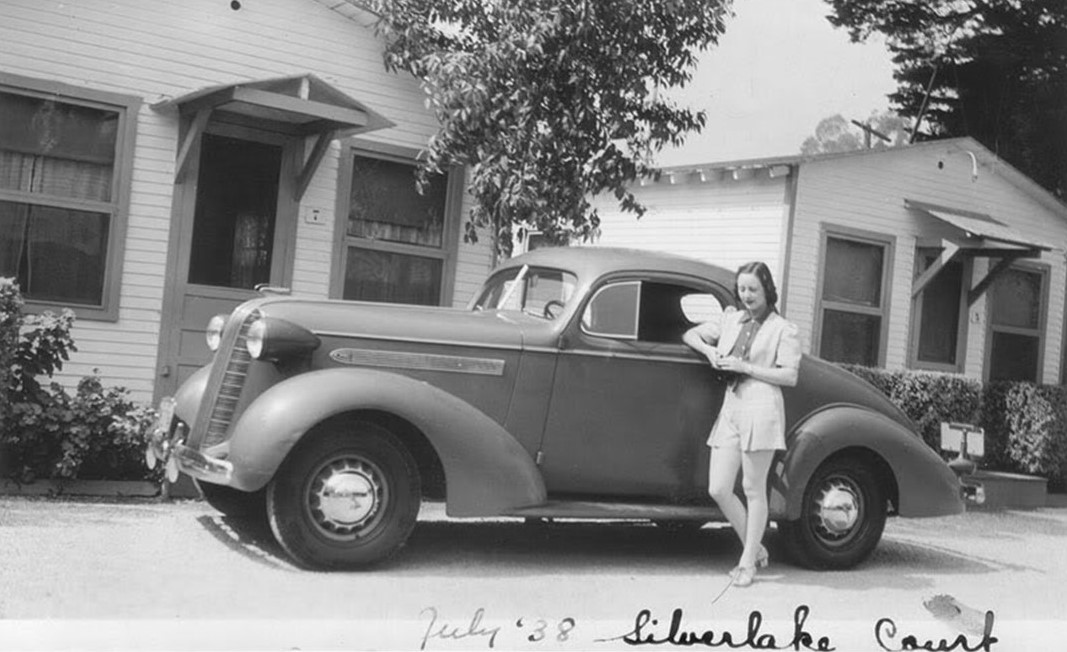 |
|
| (1938)* - A young woman stands next to a 1936 Pontiac Master Six Coupe at the Silver Lake Auto Court, 2500 Glendale Boulevard. |
Then and Now
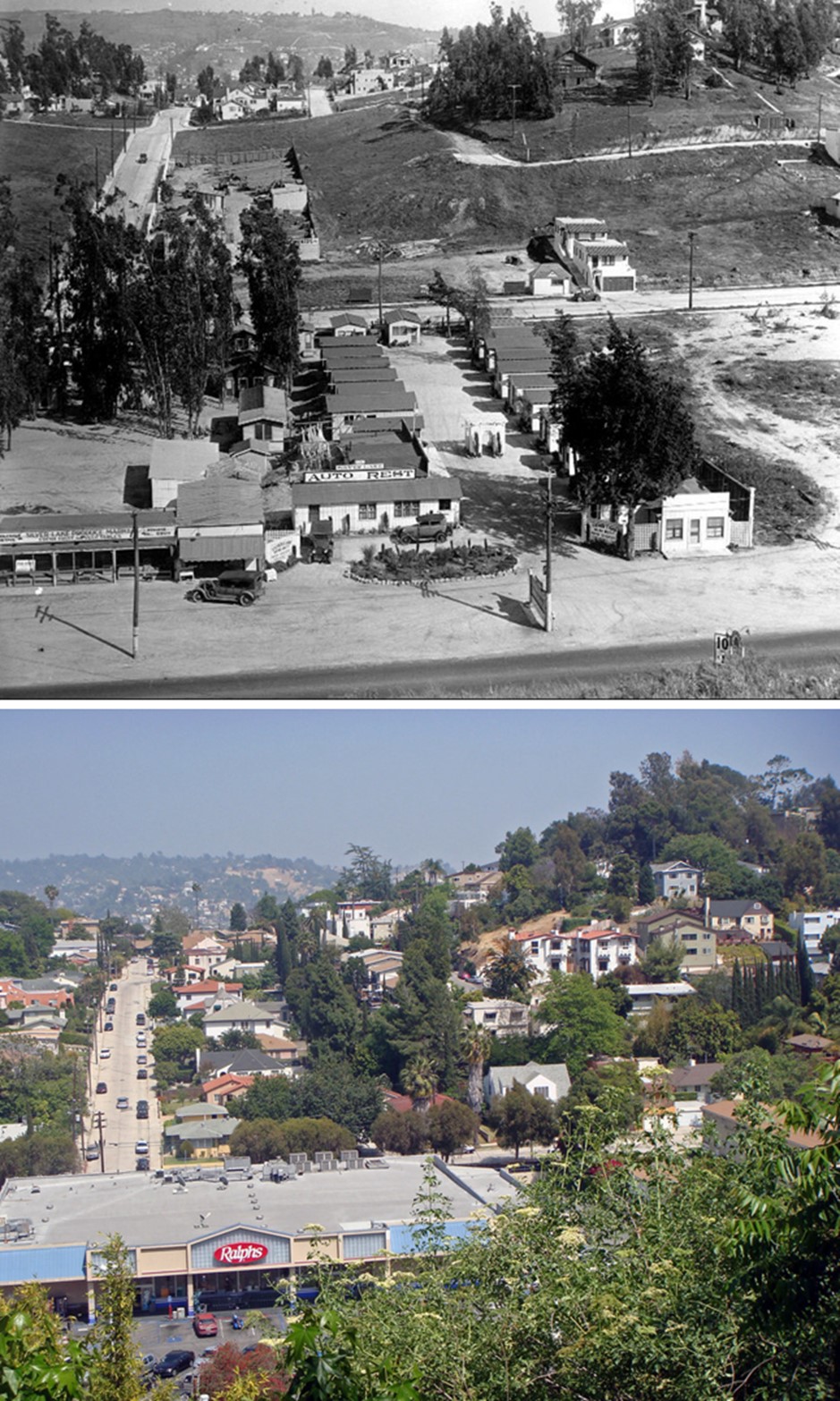 |
|
| (1920s vs 2016)* – Looking east from over Glendale Blvd with India Street running away from the camera on the left. The Ralphs Market seen below is now a Whole Foods Market (2520 Glendale Blvd). Photo comparison by Jack Feldman. |
Sunset Boulevard and Micheltorena Street
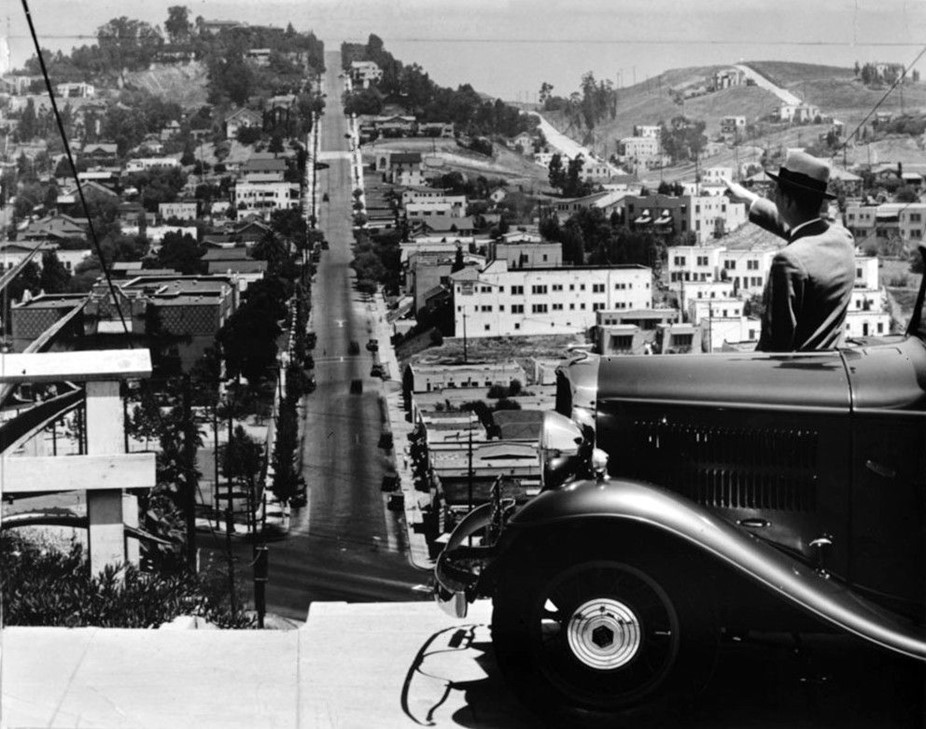 |
|
| (1932)* - A view of Silver Lake, looking north on Micheltorena Street from above Sunset Boulevard. |
Then and Now
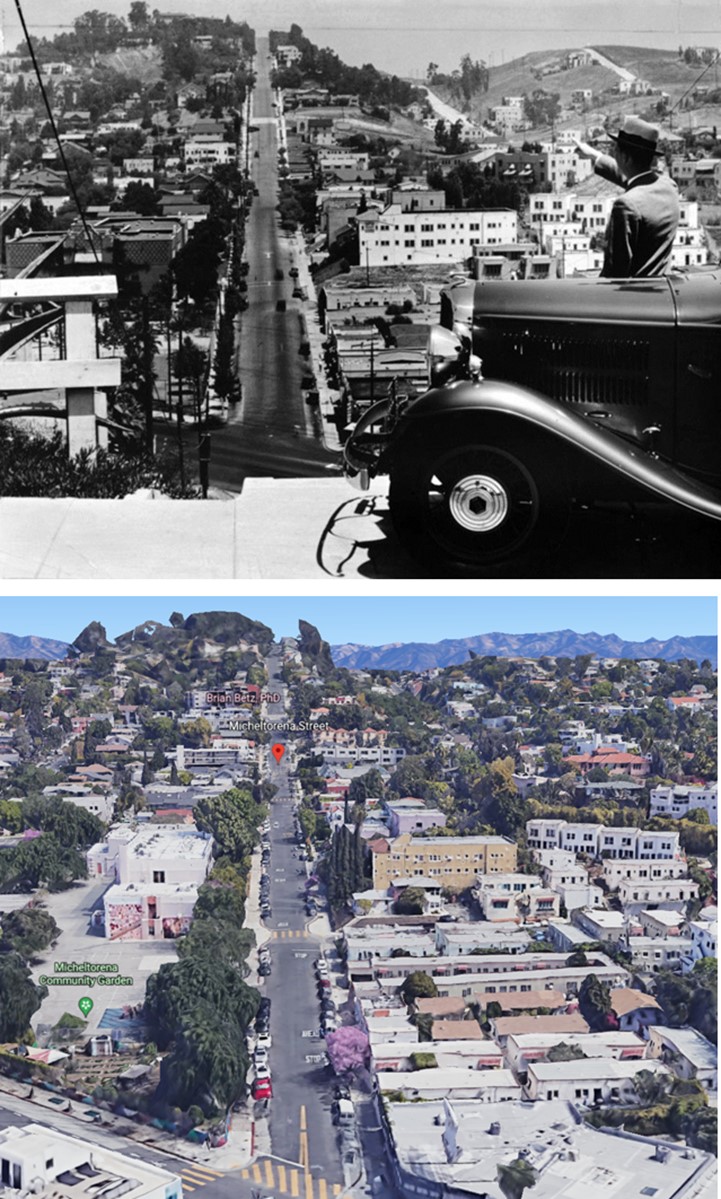 |
|
| (1932 vs. 2022)* - A view of Silver Lake, looking north on Micheltorena Street from above Sunset Boulevard. Photo comparison by Jack Feldman. |
* * * * * |
Glassell Park and Cypress Park
 |
|
| (1900)^ - The Los Angeles River and a farming area looking northeast from Elysian Park. The view is looking toward Cypress Park and Glassell Park. |
Historical Notes Glassell Park is bordered on the north by Glendale, on the northeast and east by Eagle Rock, on the southeast by Mount Washington, on the south and southwest by Elysian Valley and on the west by Atwater Village. |
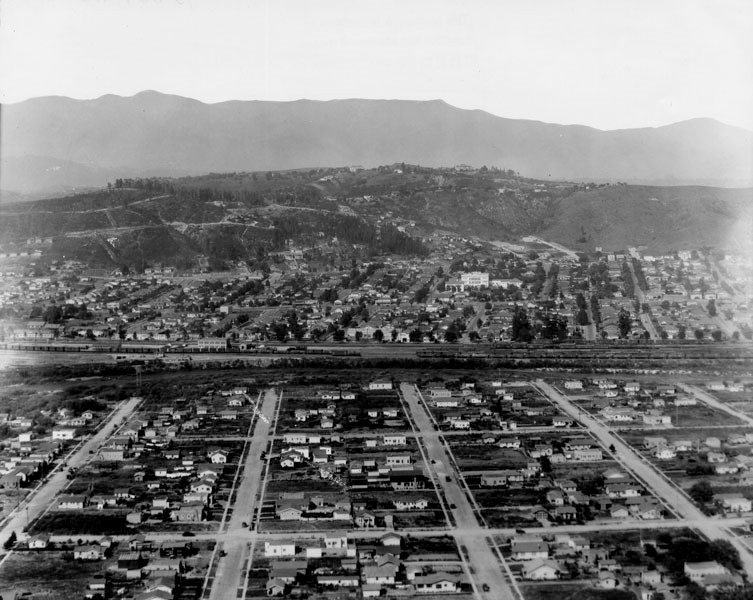 |
|
| (1926)^ - Panoramic view of residential areas bordering the Los Angeles River as seen from Elysian Park, looking northeast toward Glassell Park, Cypress Park and Mt. Washington. Compare to previous photo. |
Historical Notes Cypress Park is situated near the confluence of the Los Angeles River and Arroyo Seco, less than 2.5 miles north of Downtown Los Angeles. It lies within a historic alluvial floodplain shared with the Elysian Valley neighborhood, which is bounded by Elysian Park and Mt. Washington. |
* * * * * |
Highland Park
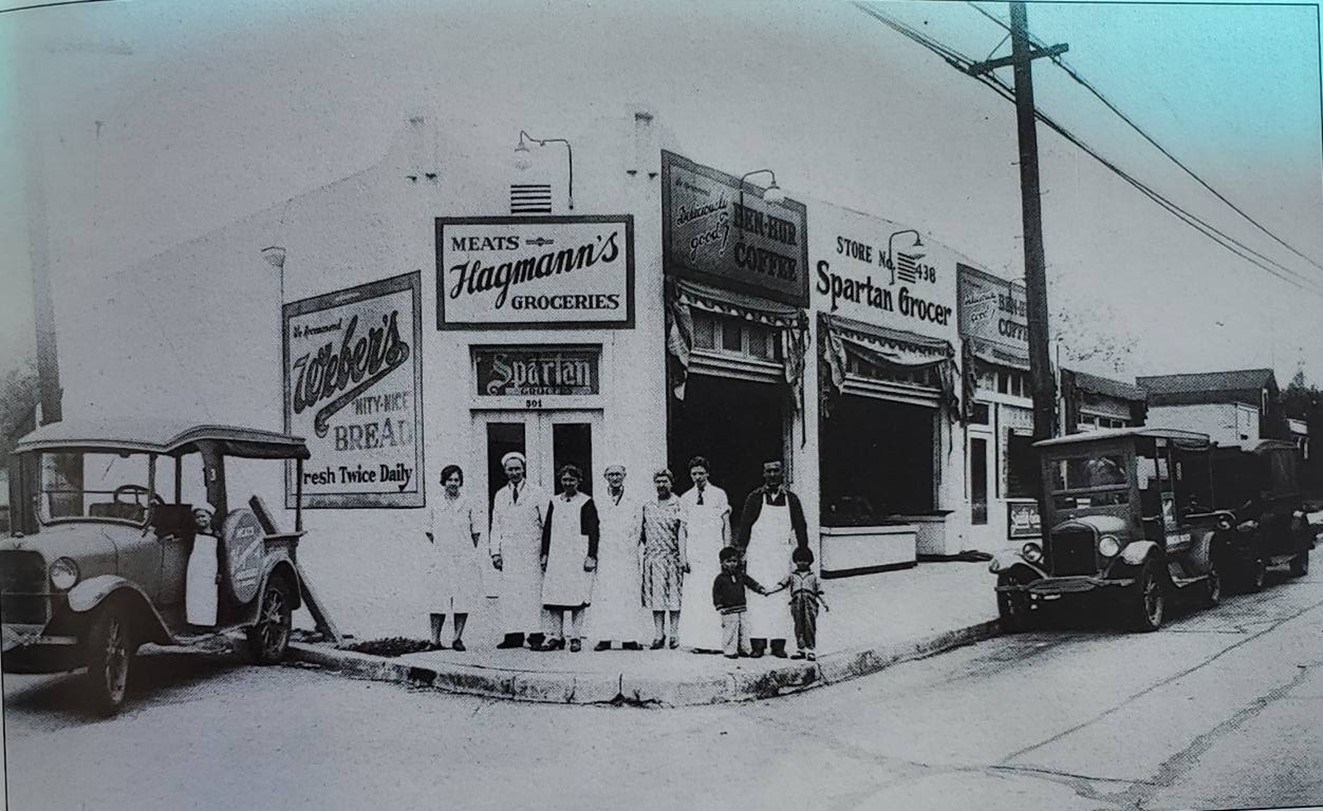 |
|
| (1920)* – Workers and likely owners, along with two children on the right and another child standing on the car's running board on the left, pose in front of Hagmann’s, a 'mom-and-pop' grocery store on the northwest corner of Figueroa Street and Springvale Avenue in Highland Park. This stretch of Figueroa was once part of historic Route 66. |
Historical Notes Figueroa Street in Highland Park was once part of Route 66 during its Transitional (1932-1934) and Alternate (1936-1940) alignments. It served as the main street of Highland Park until the Arroyo Seco Parkway opened on December 30, 1940, which bypassed the area. Before being named Figueroa, the road was known as Pasadena Avenue and had sections called Dayton Avenue. |
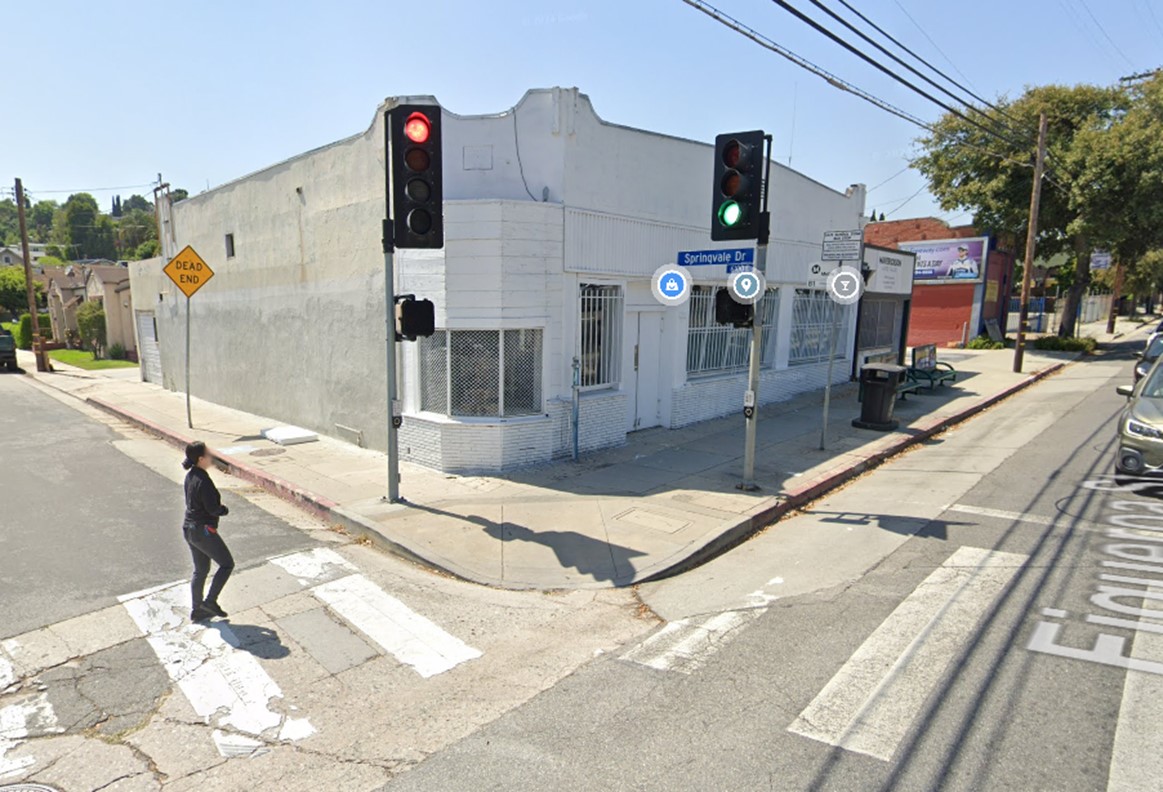 |
|
| (2024)* - A woman crosses the street toward the northwest corner of Figueroa Street and Springvale Avenue in Highland Park, approaching an unmarked building that once housed Hagmann’s grocery store in the 1920s |
Historical Notes Over the past decade, Figueroa Street in Highland Park has undergone a remarkable transformation, evolving from a predominantly working-class Latino area to one of northeast Los Angeles' most vibrant commercial corridors. The street has seen an influx of upscale businesses, including trendy restaurants, coffee shops, and creative enterprises, alongside rising property values and rents. Despite this rapid change, efforts have been made to preserve the area's historic character, with many older buildings being rehabilitated rather than demolished. New mixed-use developments are also emerging, aiming to increase housing and commercial space. This evolution has attracted media and tech companies, establishing Figueroa Street as a mini-design district. However, the rapid gentrification has raised concerns about displacement and affordability among long-time residents. Overall, Figueroa Street now represents a dynamic blend of old and new, balancing its historic charm with modern urban development, making it an increasingly desirable location for businesses and residents alike in Los Angeles. |
Then and Now
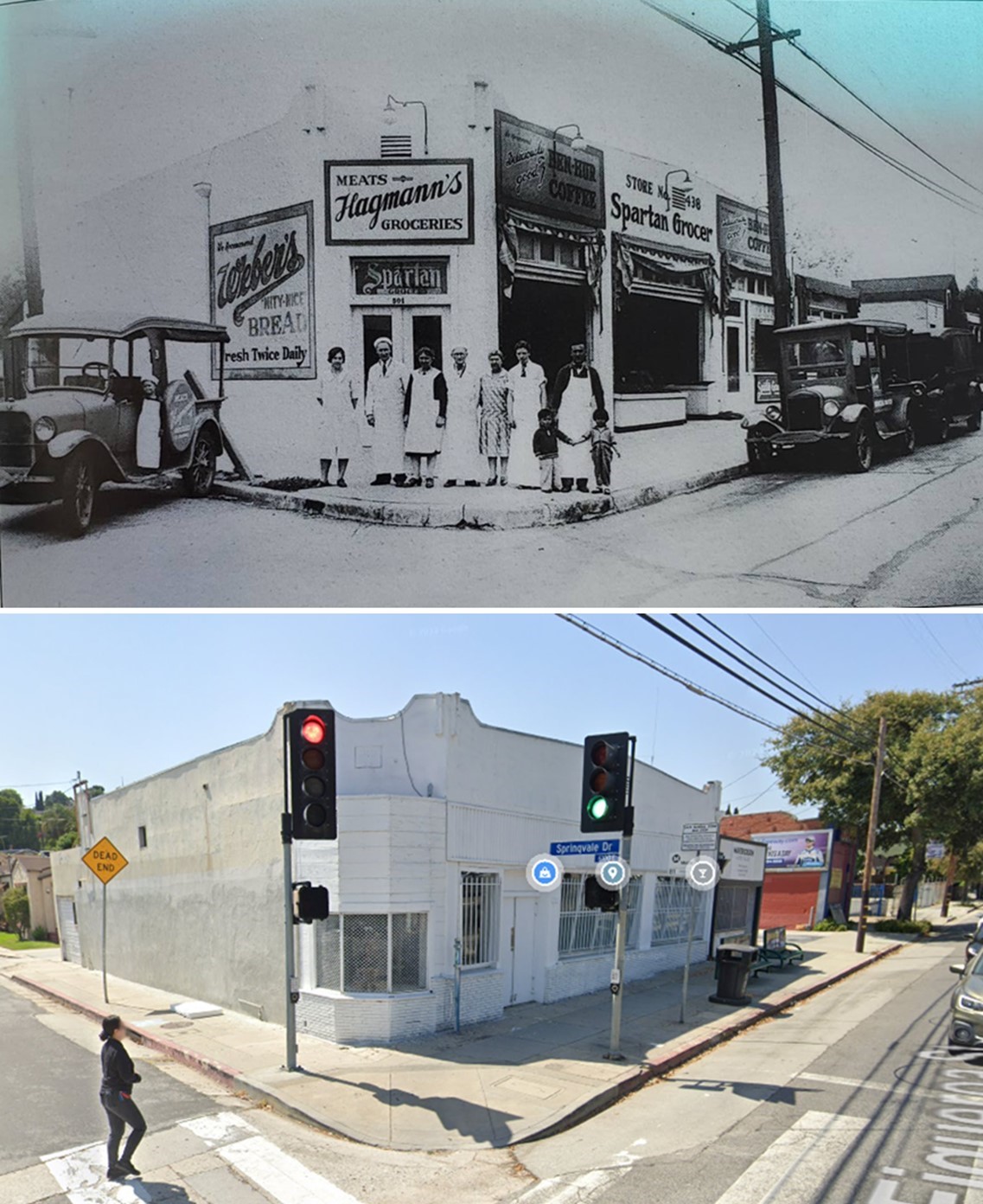 |
|
| (1920 vs. 2024)* – A view of the northwest corner of Figueroa Street and Springvale Avenue, once home to Hagmann’s grocery store. Photo comparison by Jack Feldman. |
Historical Notes Figueroa Street in Highland Park is currently grappling with a complex set of challenges stemming from rapid gentrification. The area is experiencing a significant displacement of long-time residents and local businesses due to rising property values and rents, leading to an affordable housing crisis and the erosion of the neighborhood's cultural identity. This has created tension between newer, often more affluent residents and established community members, resulting in protests and increased community activism. The street faces the difficult task of balancing new development with the preservation of its historic character and architectural heritage. Additionally, the influx of new businesses and residents has exacerbated traffic and parking issues, straining local infrastructure. Economic disparities are widening, and there's growing concern about maintaining the area's racial, ethnic, and economic diversity. The overarching challenge lies in finding ways to improve the neighborhood that benefit all residents, not just newcomers, while preserving the community ties and cultural richness that have long defined Highland Park. |
* * * * * |
Figueroa and Piedmont
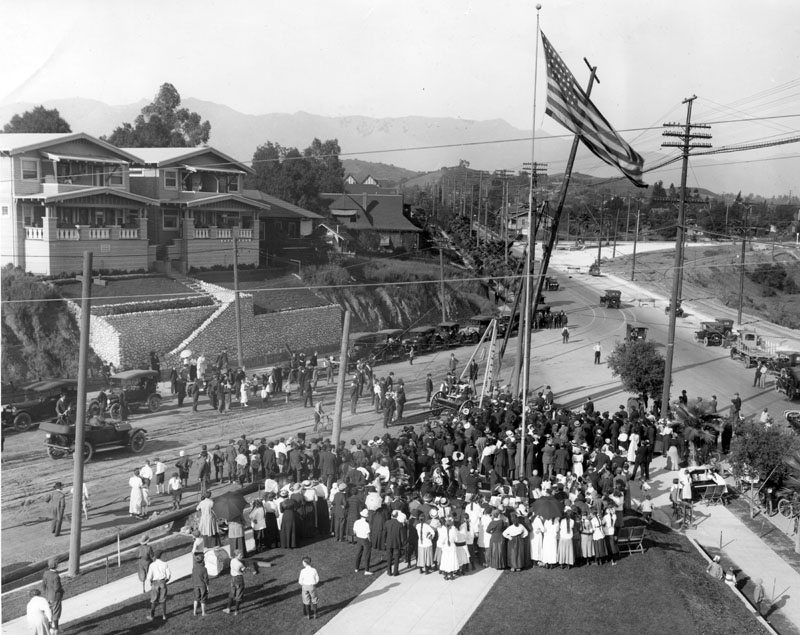 |
|
| (1916)* – A crowd gathers to watch the raising of a power pole at the corner of Pasadena Avenue (now Figueroa Street) and Piedmont Avenue in Highland Park. This event marked the inauguration of a power distribution system by the Los Angeles Bureau of Power and Light (now LADWP) and represents a significant milestone in the utility’s history. This photo was taken from the top of Arroyo Seco Branch Library. |
Historical Notes On March 18th, 1917, the Bureau of Power and Light opened its first major hydro-electric power plant, San Francisquito Power Plant No. 1. The plant used water from the recently completed Los Angeles Aqueduct to generate electricity. The LA Bureau of Power and Light would now be able to sell its excess San Francisquito generated power to Pasadena over two newly constructed 34 kV lines between the two cities. By 1917, World War I had forced the price of fuel oil to rise making the new lower cost hydroelectric power extremely desirable. The Los Angeles Bureau of Power and Light became part of the Los Angeles Department of Water and Power (LADWP) in 1937. Click HERE to see more on Los Angeles' 1st Municipal Power Pole. |
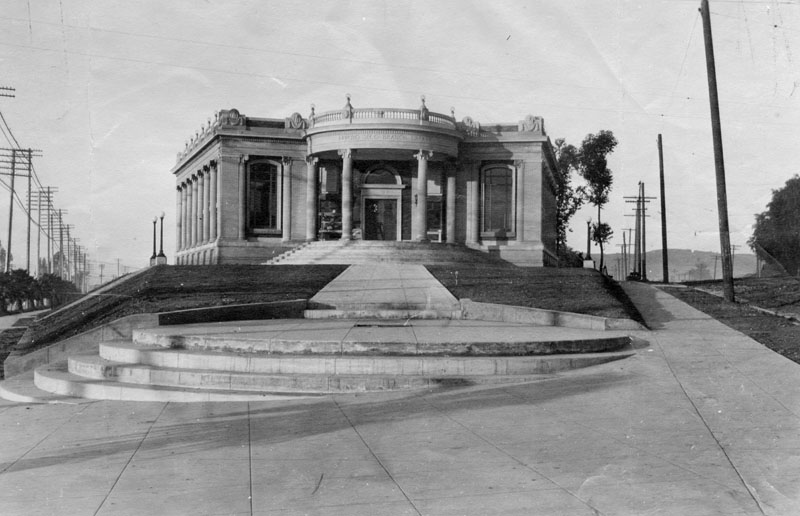 |
|
| (ca. 1916)* - View of the Arroyo Seco Branch Library at the intersection of Pasadena Avenue (now Figueroa Street) and Piedmont Avenue. |
Historical Notes The Arroyo Seco Branch Library was completed in 1914. It was the second of six branches built between 1913 and 1916 with a $210,000 Carnegie grant obtained by Los Angeles in 1911. All but one of these branches included a basement assembly room and an outdoor reading area. In 1932, Pasadena Avenue in Highland Park was renamed to Figueroa Street as part of a larger urban planning initiative in Los Angeles. This change coincided with the completion of the Figueroa Street Tunnels, which created a more direct route between downtown Los Angeles and Highland Park. The renaming was designed to establish Figueroa Street as a continuous thoroughfare from downtown through Highland Park and up to Eagle Rock. Prior to this change, the section of what is now Figueroa Street in Highland Park above Avenue 39 was known as "Pasadena Avenue." |
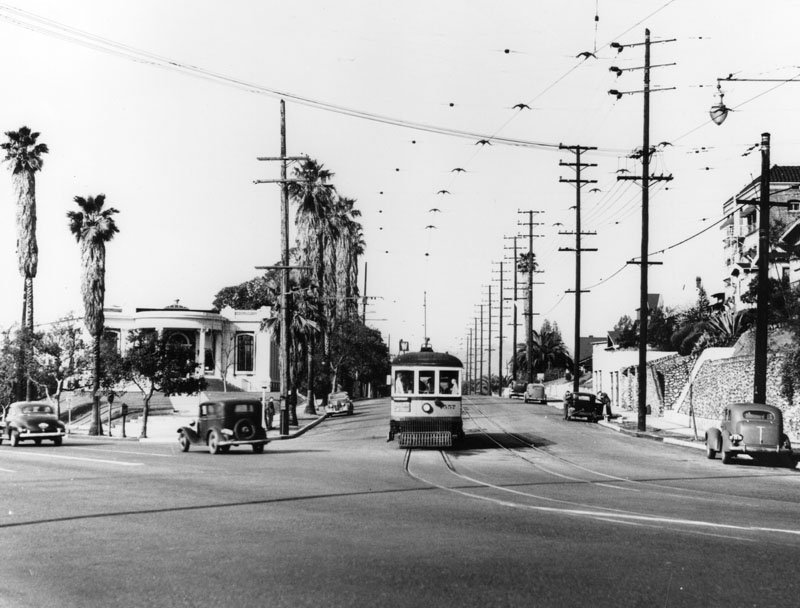 |
|
| (1946)* - View looking southwest on Piedmont Avenue, with the Arroyo Seco Branch Library on the left and a streetcar approaching the bend at N. Figueroa Street. |
Historical Notes In the 1940s, Highland Park's streetcar service along North Figueroa Street, particularly at the intersection with Piedmont Street, was primarily provided by Line 5, operated by the Los Angeles Railway (LARy). This line connected Eagle Rock to downtown Los Angeles and was known for its frequent service, contributing to the vibrant commercial atmosphere of the neighborhood. |
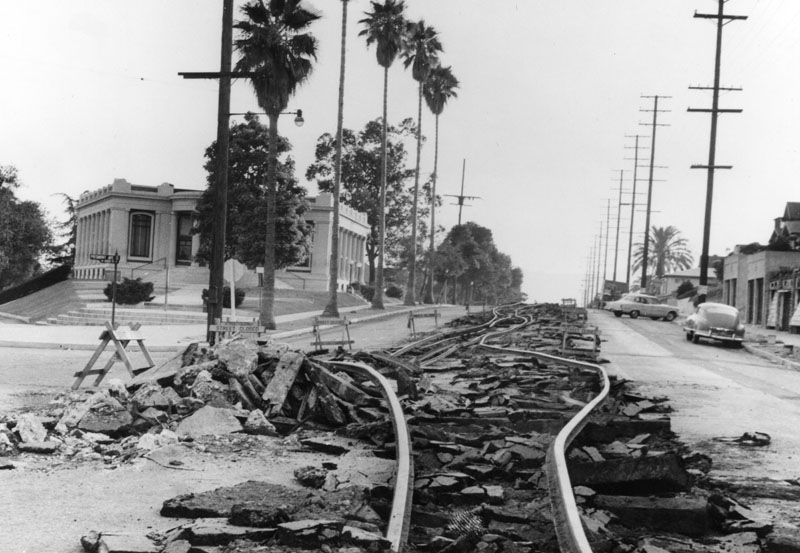 |
|
| (1958)* - View of the old streetcar tracks being torn up on Piedmont Avenue, with one of LADWP’s first power poles still standing in its original location at the corner of Piedmont Avenue and N. Figueroa Street. |
Historical Notes The decline of streetcar service along North Figueroa Street and Piedmont Street in Highland Park was part of a larger trend affecting the Los Angeles Railway (LARy) system in the mid-20th century. Operating from 1895 to 1963, LARy faced financial challenges as early as the 1920s and 1930s, leading to service cuts and the introduction of more efficient streetcars. The rise of bus services and increasing private automobile ownership further pressured the system. Despite a brief period of improved service in the 1920s, the Great Depression and subsequent decades saw a gradual shift away from streetcars. By the 1940s and 1950s, many lines were being replaced by buses. The specific line serving Highland Park, Line 5, continued operating until May 22, 1955, when it was discontinued due to Arroyo Seco Parkway construction. This marked the end of the streetcar era in Highland Park. |
Before and After
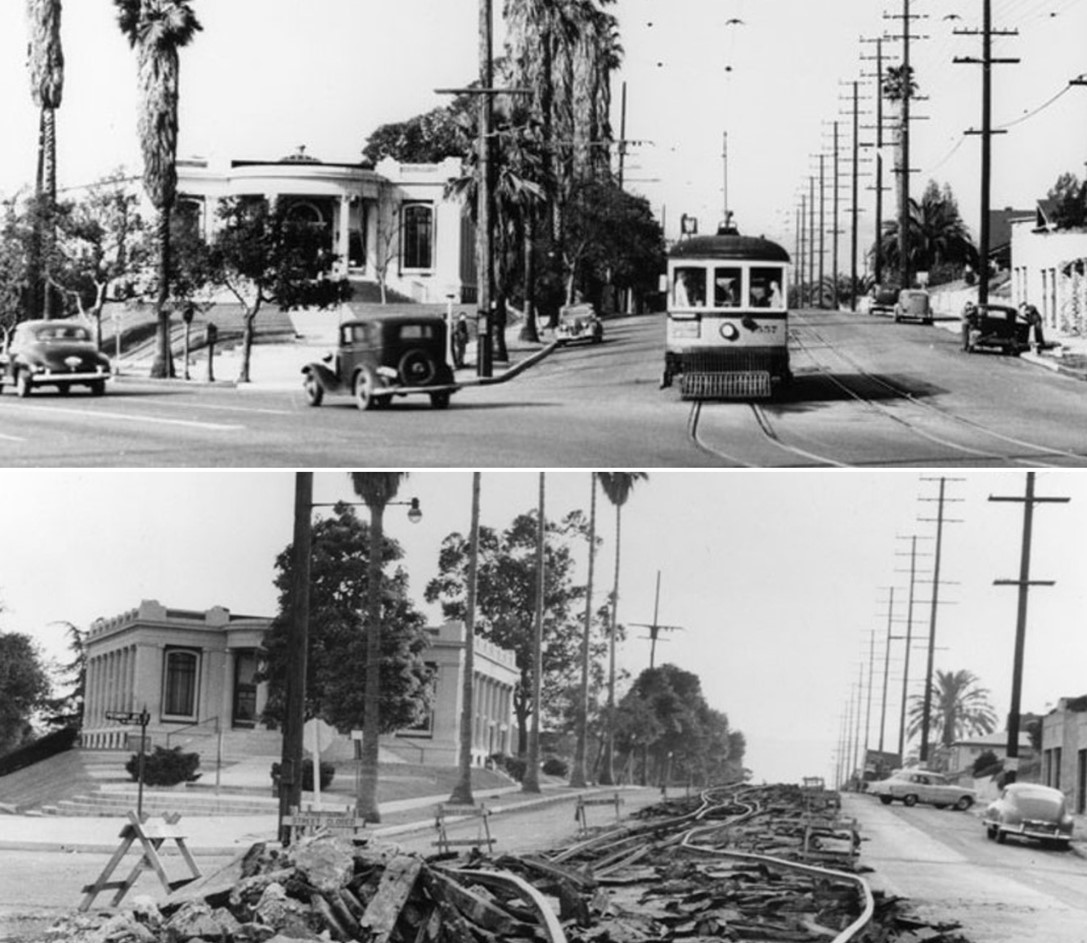 |
|
| (1946 vs. 1958)* - Before and after the removal of the Los Angeles Railway (LARy) tracks on Piedmont Avenue at N. Figueroa Street, with the Arroyo Seco Branch Library on the left. |
Then and Now
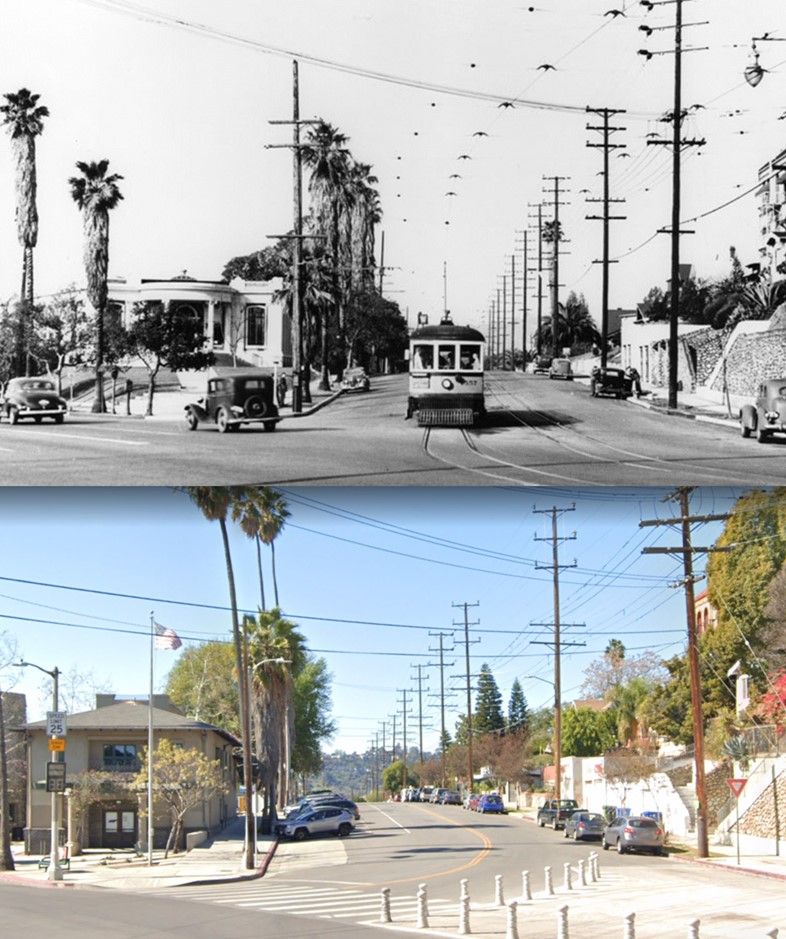 |
|
| (1946 vs. 2021)* – Looking southwest on Piedmont Avenue, with a streetcar heading toward the bend at N. Figueroa Street in Highland Park. Photo comparison by Jack Feldman. |
Historical Notes The original Arroyo Seco Library, built in 1914 in the Classical Revival style, was replaced by a new building in 1960, and then again in 2003. Click HERE to see more. |
* * * * * |
Glendale
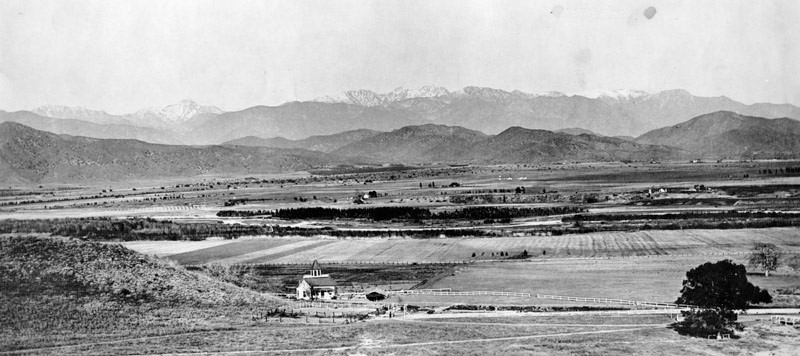 |
|
| (ca. 1900)^ - Panoramic view from Griffith Park of the site of the later city of Glendale as it appeared sometime between the partition of the great San Rafael Rancho in 1870 and the founding of the town in the middle eighties. The Verdugo Hills and San Gabriel Mountains are seen in background. |
Historical Notes In 1884, residents gathered to form a townsite and chose the name "Glendale" (it was bounded by First Street (now Lexington Drive) on the north, Fifth Street (now Harvard Street) on the south, Central Avenue on the west, and the Childs Tract on the east). Residents to the southwest formed "Tropico" in 1887. The Pacific Electric Railway brought streetcar service in 1904. Glendale incorporated in 1906, and annexed Tropico 12 years later. |
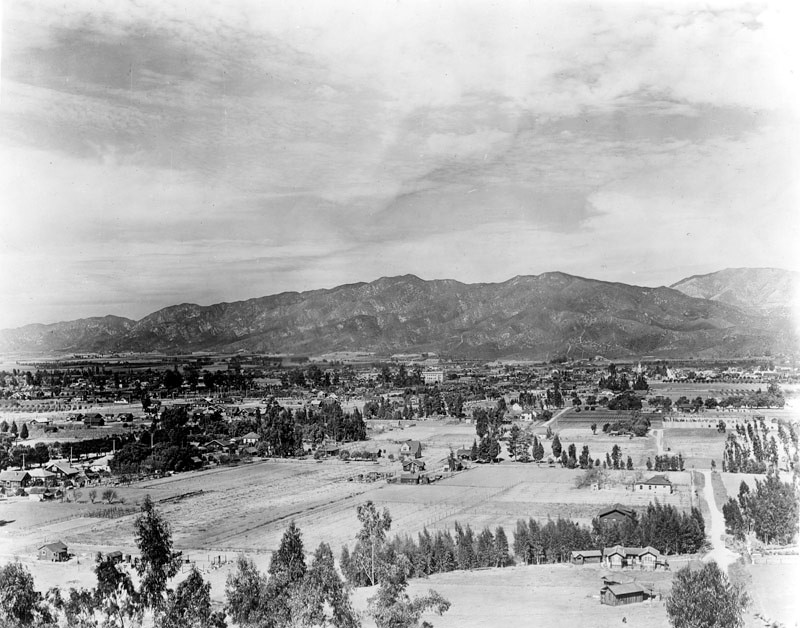 |
|
| (ca. 1910)* - Panoramic view of Glendale, taken from Forest Lawn Hill. |
 |
|
| (ca. 1915)* - Panoramic view of Glendale showing the Pacific Electric Railway running north and south on Brand Boulevard. |
Historical Notes The Pacific Electric Railway brought streetcar service to Glendale in 1904. An important civic booster of the era was Leslie Coombs Brand, who built an estate in 1904 called El Miradero featuring an eye-catching mansion whose architecture combined characteristics of Spanish, Moorish, and Indian styles (today’s Brand Library and Art Center). Brand partnered with Henry E. Huntington to bring the Pacific Electric Railway, or the "Red Cars," to the area. Today, he is memorialized by one of the city's main thoroughfares, Brand Boulevard. |
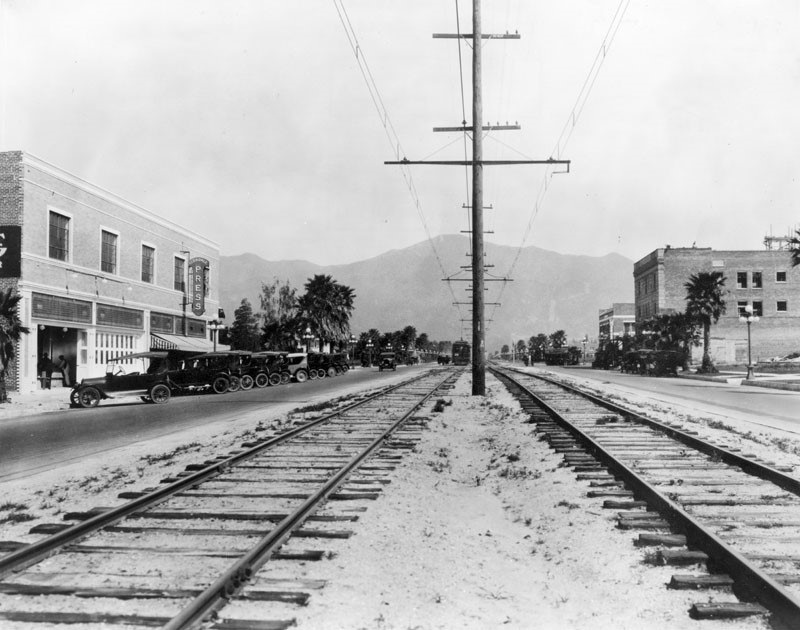 |
|
| (1919)^ - View of Brand and Lexington and the surrounding area. The Glendale Press building is on the left. The train in the distance is stopped to pick up passengers waiting along the way. |
Then and Now
 |
|
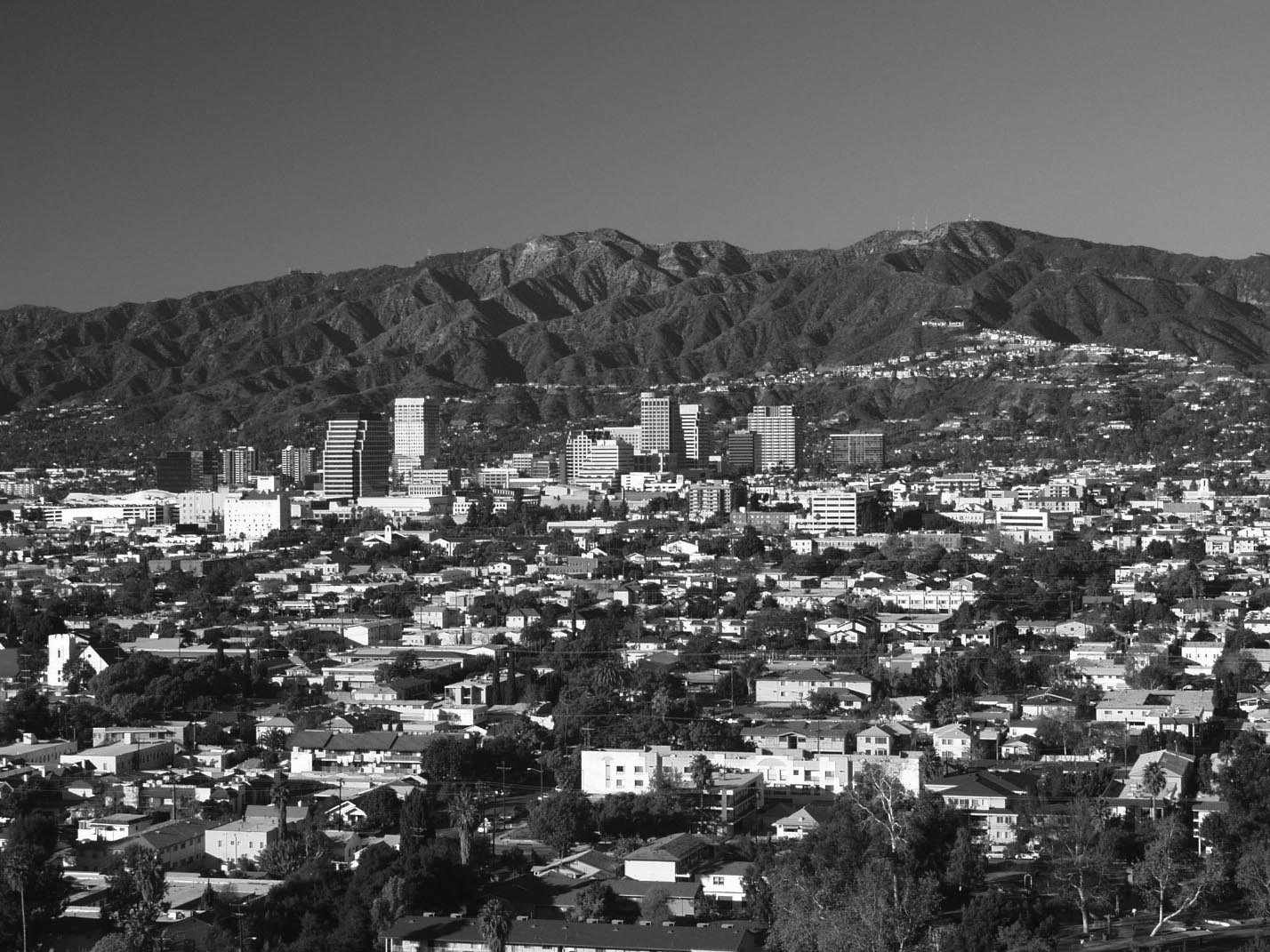 |
|
| (1910 vs 2009)* - View of Glendale from Forest Lawn Memorial Park. Photo comparison by Jack Feldman. |
Historical Notes When incorporated in 1906, Glendale consisted of only 1,486 acres. By 1920, the City had grown through nine annexations to over 7,000 acres. From 1920 to 1930, ten annexations brought the total area to 12,294 acres. Click HERE to see more Early Views of Glendale |
* * * * * |
City of Tropico
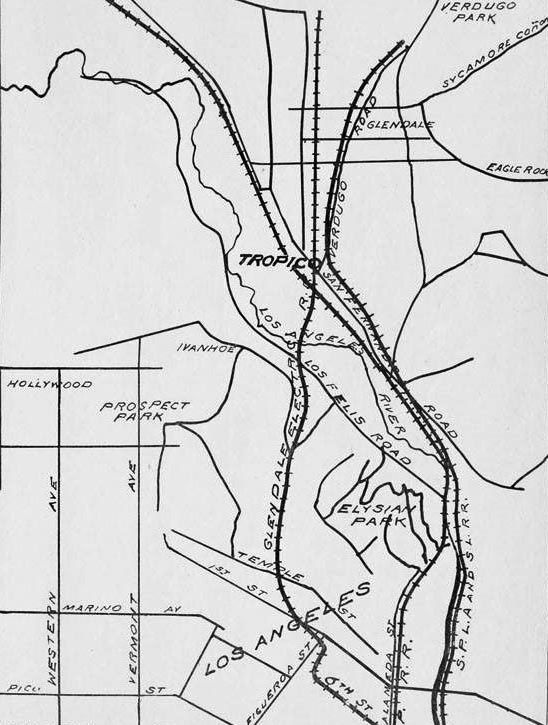 |
|
| (1903)#+++ – A map of Tropico showing rail lines and surrounding area. |
Historical Notes Tropico was put on the map as a fertile agricultural spot in the late 1800s. Shortly thereafter, the town began distancing itself from the rest of Glendale. In 1918, the neighborhood formally succeeded in becoming an independent entity for a short time. |
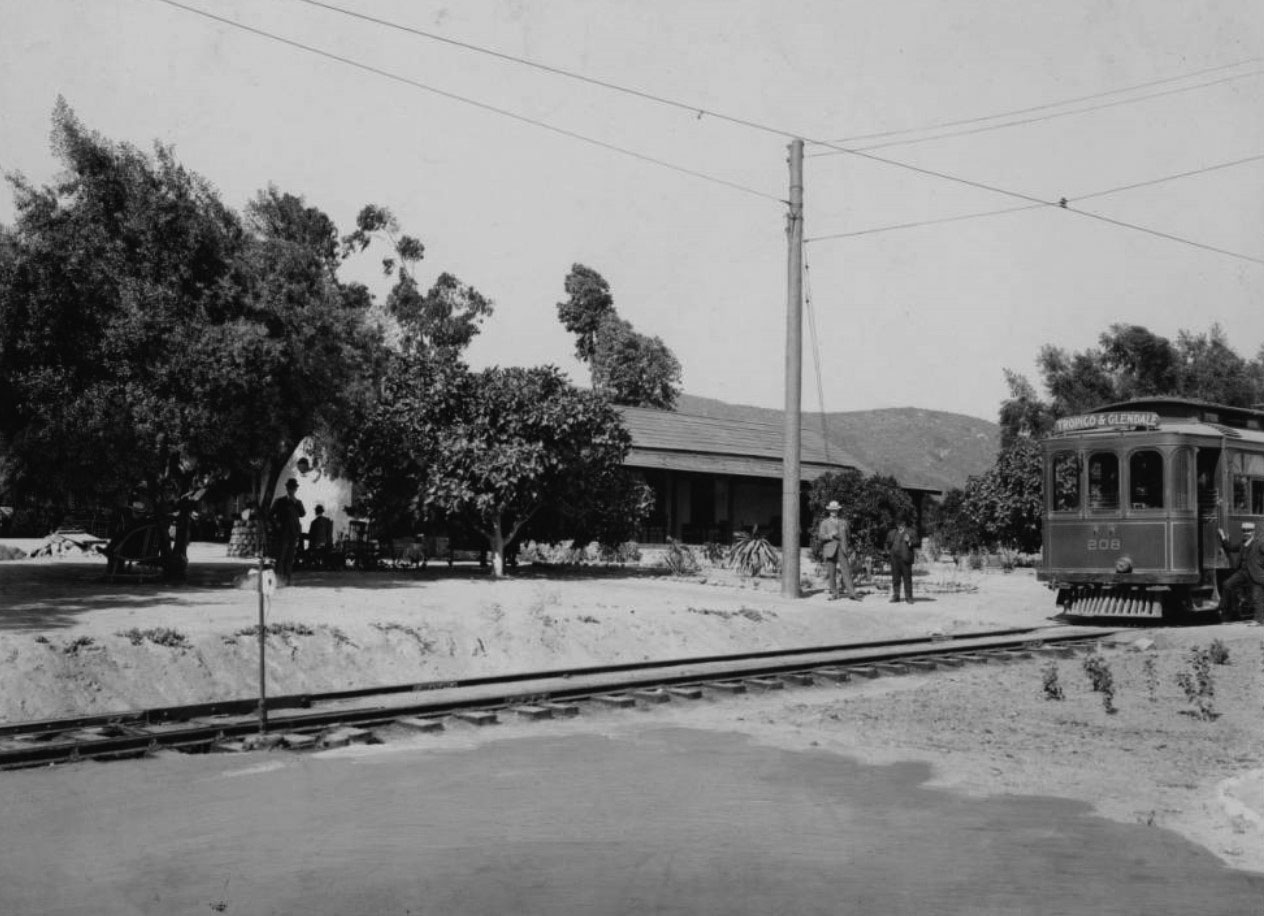 |
|
| (ca. 1900)^^ – View showing a "Tropico & Glendale" electric car outside Casa Verdugo adobe (Catalina Verdugo Adobe) in Glendale. The conductor stands outside of his electric car on the right with the tracks in front of him leading to the left foreground. Two more men stand next to an electrical pole at center while others sit under the shade of trees at left. The adobe can barely be seen through the trees. |
Historical Notes Rancho San Rafael was granted to José María Verdugo on October 20, 1784. Don José died April 12, 1831, leaving his estate to his son Julio and his blind daughter Catalina. This adobe was built for Dona Catalina in the 1830s; she lived here until her death in 1861. Still in excellent condition, the Catalina, or Original Mud Block, Adobe is now in private ownership. Location: 2211 Bonita Dr, Glendale The Catalina Verdugo Adobe is registered as California Historical Landmark No. 637 and the California Parlor No. 247. Click HERE to see more California HIstorical Landmarks in LA. |
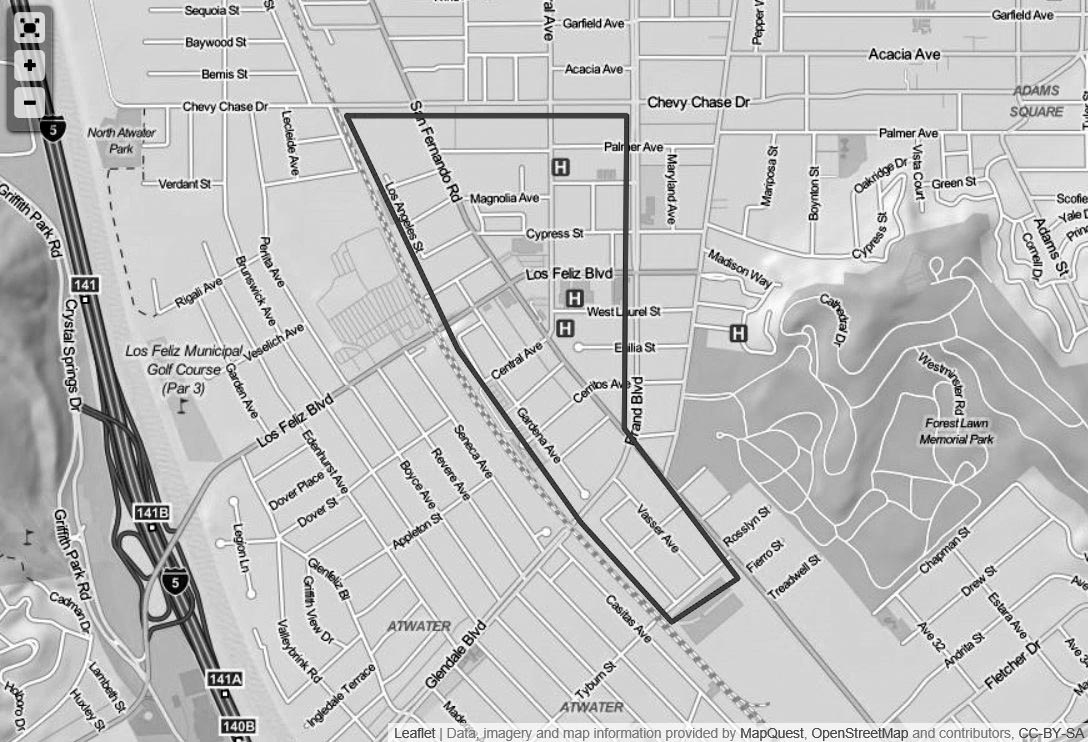 |
|
| (n.d.)*^ – Map view showing the boundaries of Tropico. |
Historical Notes Tropico was the name of the southern portion of Glendale, south of Windsor Road, between the late 1800s and 1918. The name "Glendale" had originated in the 1880s and was utilized north of Windsor Road. Political factions had divided the town in two. By the turn of the century, the commercial center of Tropico was at Central and San Fernando Road and its population was 700. ^##^ |
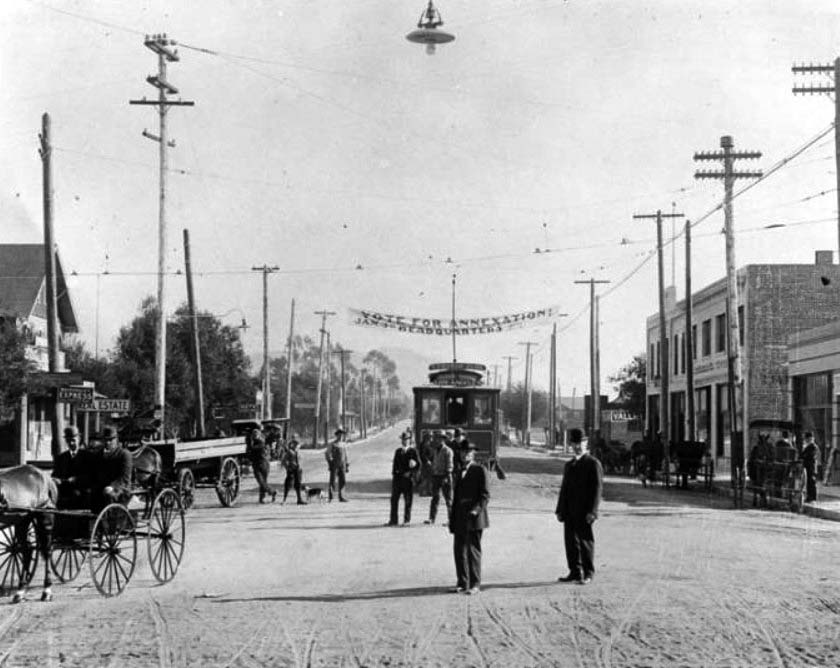 |
|
| (1911)##^ – A banner in support of the annexation of Tropico to Glendale in 1911 hangs outside the measure's headquarters on Broadway near Brand Boulevard in Glendale. The measure failed to pass, with Tropico instead voting for its own incorporation as a city. The issue would be revisited in 1918, when the upper half of Tropico would become a part of Glendale. |
Historical Notes Tropico was just a sleepy little village in the early 1900s. The business district included a few wooden buildings containing a general store, a blacksmith shop, meat store, livery stable, real estate offices and a few other small concerns. The buildings were all clustered near the intersection of San Fernando Road and Central Avenue. But within a few short years, the wood-frame buildings were replaced with brick, business boomed and the community became vibrant. The Tropico Art Tile Works stood just west of the railroad tracks, employing many people, and Tropico also became the shipping center for the strawberries raised in the area. Because of its proximity to Los Angeles, the area became a popular residential spot. The Tropico Chamber of Commerce organized in 1910, along with the Bank of Tropico, and soon the community realized it needed a city government. With so many of its residents commuting into Los Angeles, many favored annexing to Los Angeles. Others, seeing Glendale's successful example of home rule, wanted to be part of Glendale, which had incorporated in 1906. #+#+ |
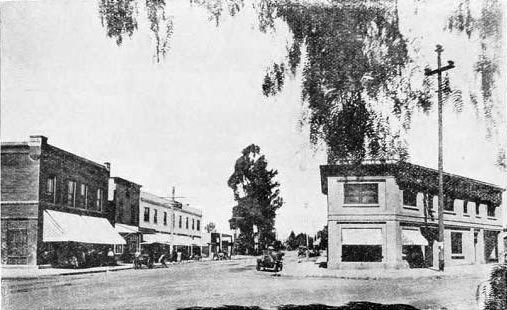 |
|
| (1910s)#+++ - View looking N/W on San Fernando Road at Central Ave with the Bank of Tropico located on the triangular lot at right. |
Historical Notes With so many of its residents commuting into Los Angeles, many favored annexing to Los Angeles. Others, seeing Glendale's successful example of home rule, wanted to be part of Glendale, which had incorporated in 1906. They felt that since the two communities were adjacent and in the same valley, they should be affiliated. Those favoring annexation with Glendale (mainly in the northeast part of Tropico) approached Glendale officials in 1911 and asked that an election be called. The publishers of the Tropico Sentinel vehemently opposed annexation, and the issue failed. Instead, Tropico incorporated as its own city, with Elkanah W. Richardson, son of Tropico's founder, W.C.B. Richardson, serving as a member of the board of trustees. The new city government immediately embarked on a badly needed improvement of the roads, but the annexation issue didn't go away. Petition after petition was filed, each one eventually failing, until finally, in 1918, the annexation proposal passed. The upper half of Tropico voted to go with Glendale, and the lower half voted to merge with Los Angeles. Today, that portion makes up the area known as Atwater. #+#+ |
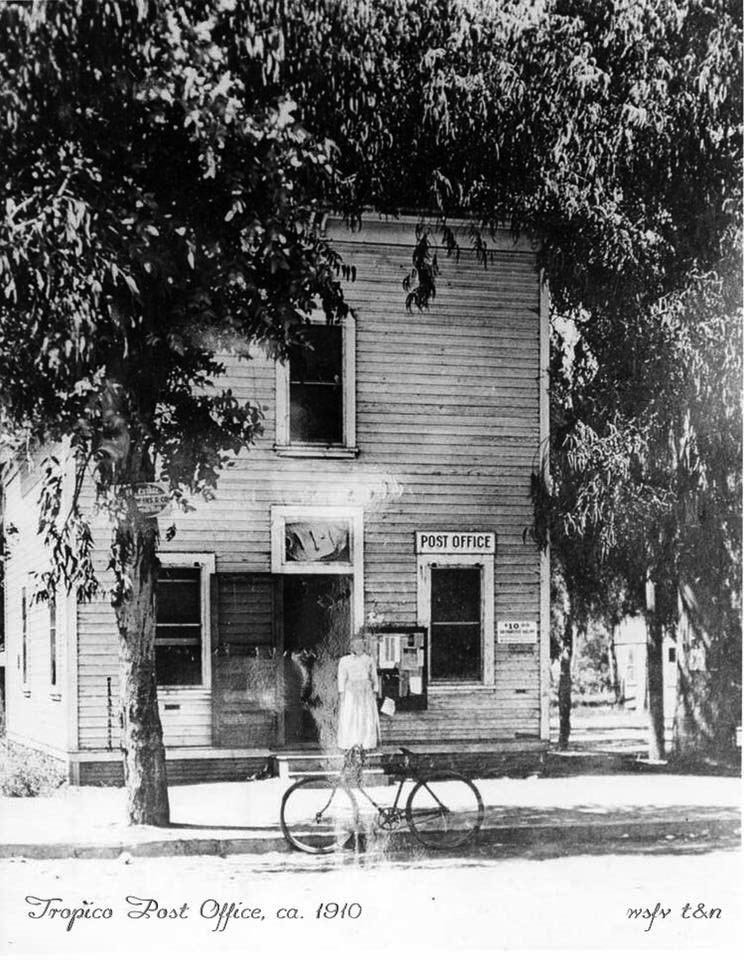 |
|
| (ca. 1910)#+++ – View showing a woman standing in front of the Tropico Post Office, with a bicycle parked by the curb. |
Historical Notes The Tropico Post Office building was owned by WCB Richardson and was located near the corner of Central Avenue and San Fernando Road. |
Then and Now
 |
|
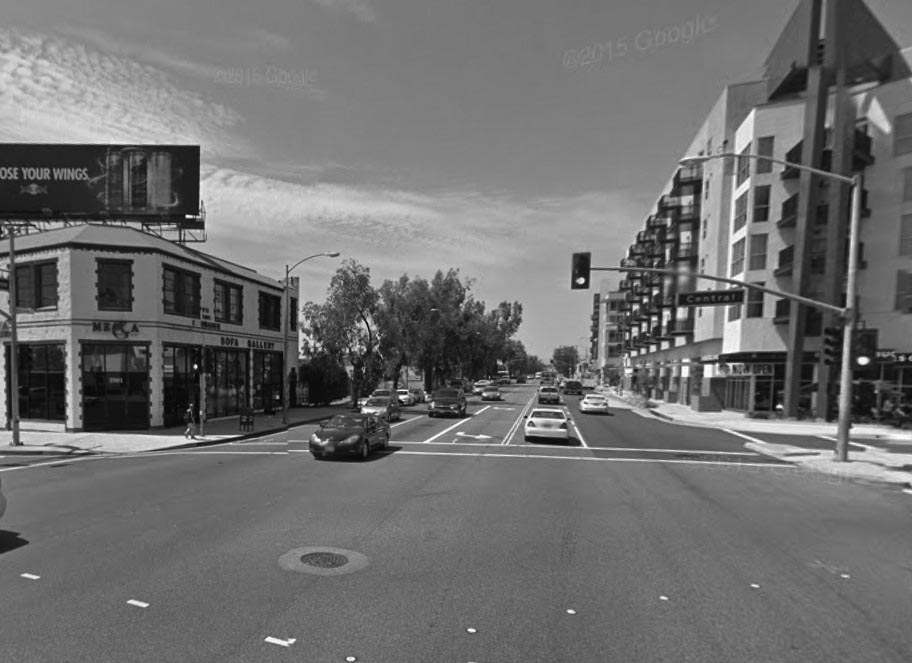 |
|
| (1910s) vs. (2015)##^^ – View looking N/W on San Fernando Road at S. Central Avenue. Photo comparison by Jack Feldman. |
El Miradero
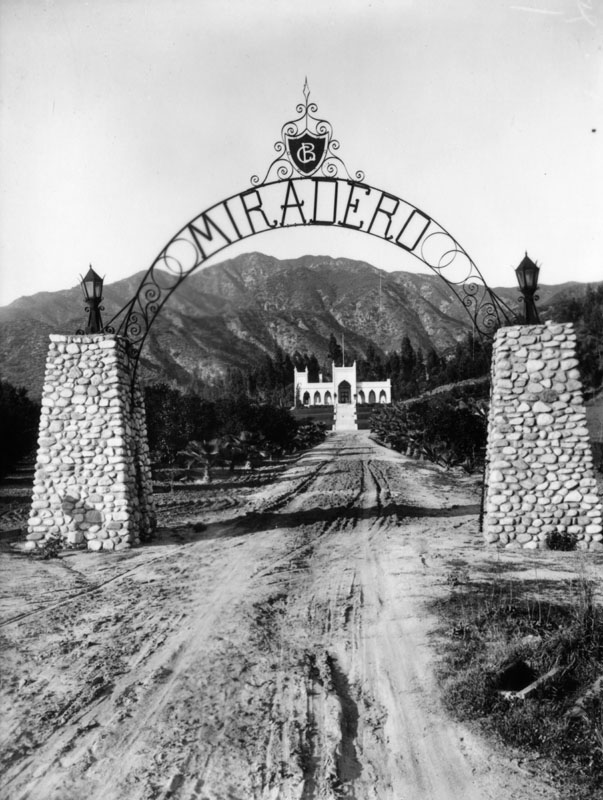 |
|
| (ca. 1904)^ - View of El Miradero, the estate of Leslie C. Brand, as seen from the entrance gates of the property. |
Historical Notes Born in Missouri in 1859, Leslie Coombs Brand became the sole provider for his family at age 11. In 1886, Brand came to California to take advantage of its first boom period. #*#^ Brand was a major figure in the settlement and economic growth of the Glendale area. He had purchased land on the lower slopes of Mount Verdugo overlooking the city, and in 1904 built an imposing residence that became known as Brand Castle, also El Miradero (which today houses the Brand Library).*^ |
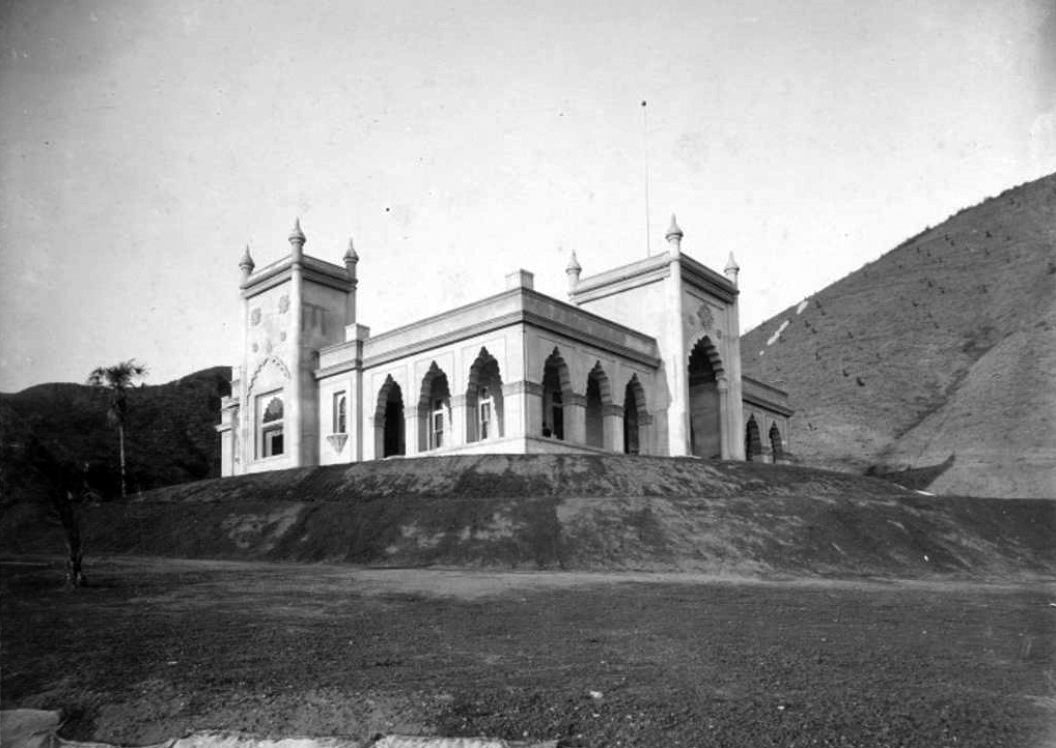 |
|
| (1904)^*# – West side view of the newly constructed ‘El Miradero’, home of Leslie C. Brand. |
Historical Notes Designed by Leslie C. Brand's brother-in-law Nathaniel Dryden, the mansion was completed in 1904 and is similar in style to that of the East Indian Pavilion built for the 1893 Columbian World Exposition held in Chicago. The architecture is considered Saracenic, with crenellated arches, bulbous domes and minars combining characteristics of Spanish, Moorish, and Indian styles.^ |
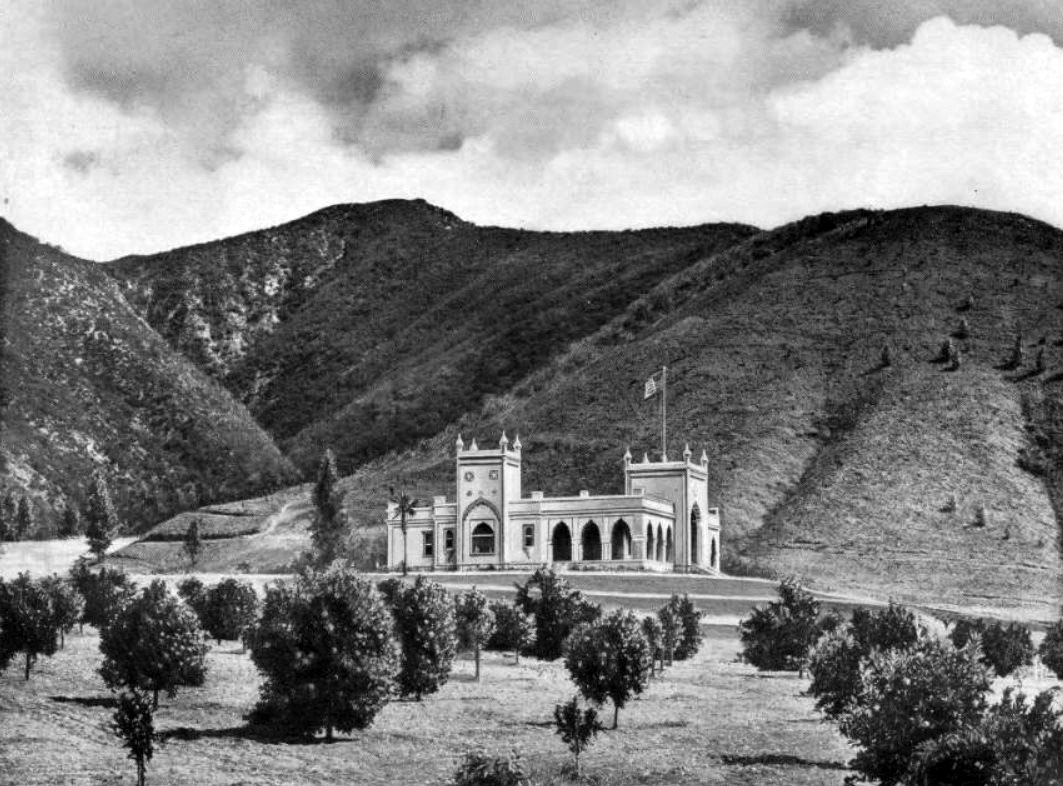 |
|
| (ca. 1906)^*# – View of El Miradero Mansion standing between orange groves in the foreground and the Verdugo Hills in the background. |
Historical Notes Leslie C. Brand helped develop the city of Glendale. Together with Henry E. Huntington, he brought Pacific Electric to the town to develop it. The 'Brand Library' section of the Glendale Public Library is named in his honor. Brand Boulevard in Glendale is also named in his honor.*^ |
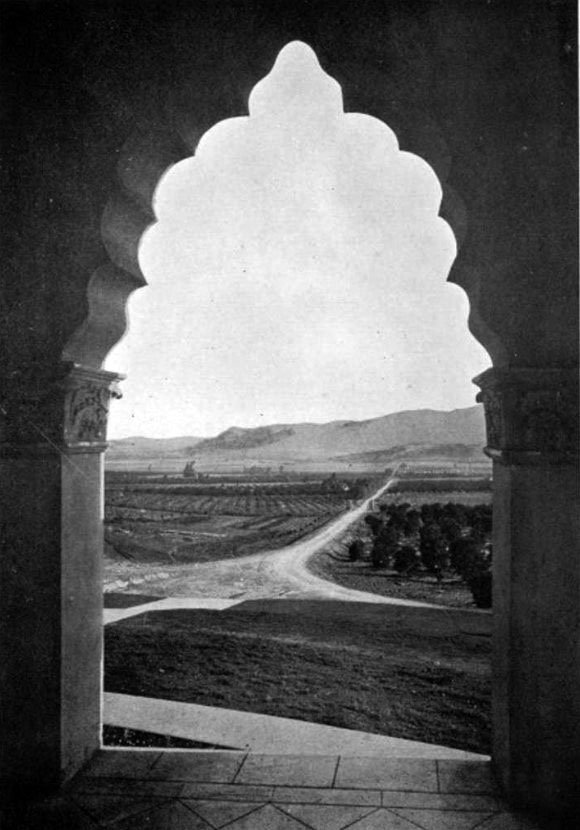 |
|
| (ca. 1906)^*# – View looking South over Glendale and Griffith Park toward Los Angeles through one of the many arches of ‘El Miradero’. |
Historical Notes Just across the mostly dry Los Angeles River, Brand could see the Griffith Park Aerodrome's grass field, built in 1912. Just three years later he decided to build his own grass airstrip below his mansion.*^ |
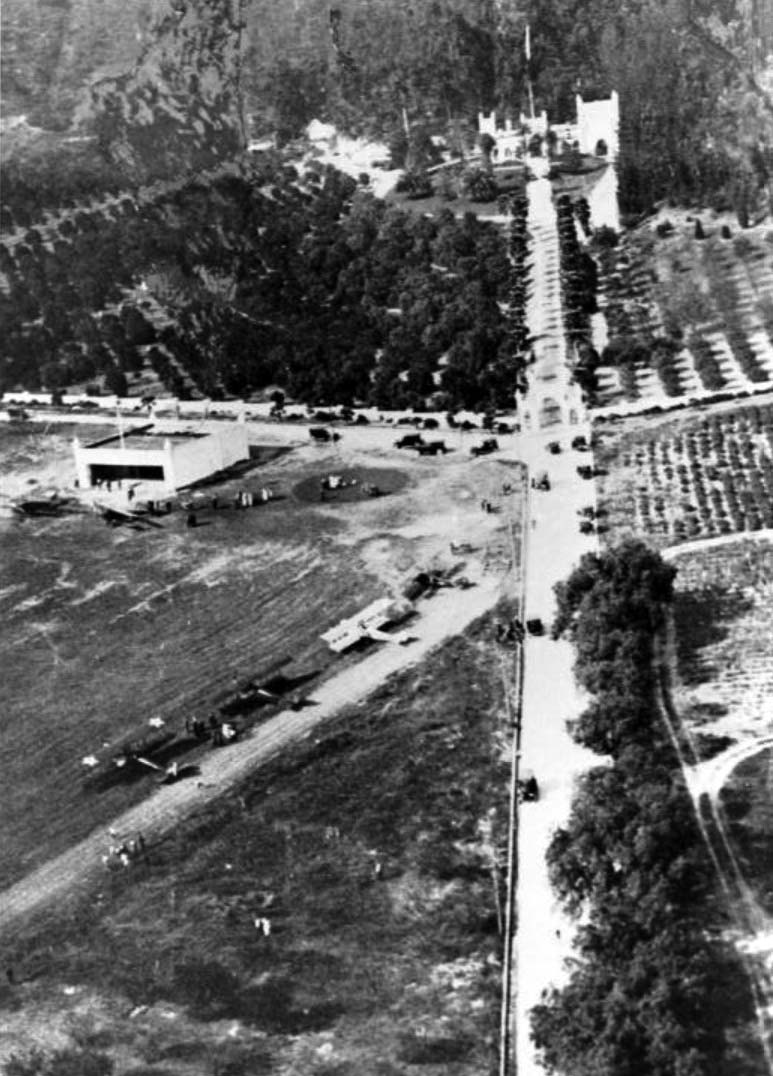 |
|
| (1921)***^ - An aerial view of L. C. Brand's airfield in front of his home, El Miradero in Glendale. The airplanes took off downhill toward Kenneth Road. |
Historical Notes Brand established a grassy, well-manicured airfield in front of the mansion. The airfield consisted of a 1,200' rolled dirt runway, with a white hangar at one end and a putting green on the other. The hangar matched the architectural style of the mansion - with turrets atop each of the 4 corners.*#*# |
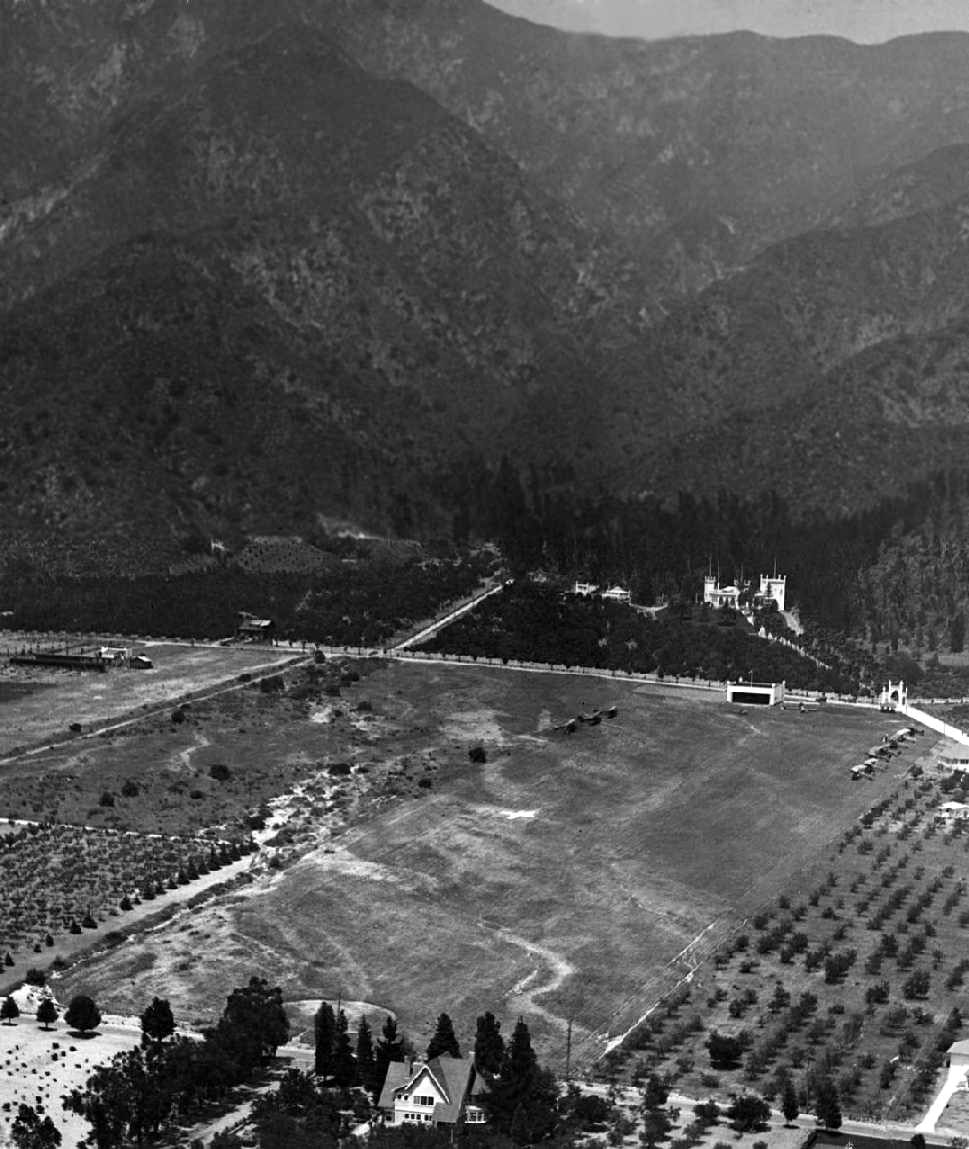 |
|
| 1923)*#*# – Aerial view looking north at Brand Field, showing the hangar and 10 aircraft on the field, and the mansion across the street. Note the steep terrain – obviously takeoffs to the north wouldn't be advisable. |
Historical Notes Only 3 aircraft are known to have been actually based at Brand Field. However, Brand apparently bought many war surplus Jennies, some to tinker with and fly as a sport, although most languished in storage buildings.*#*# |
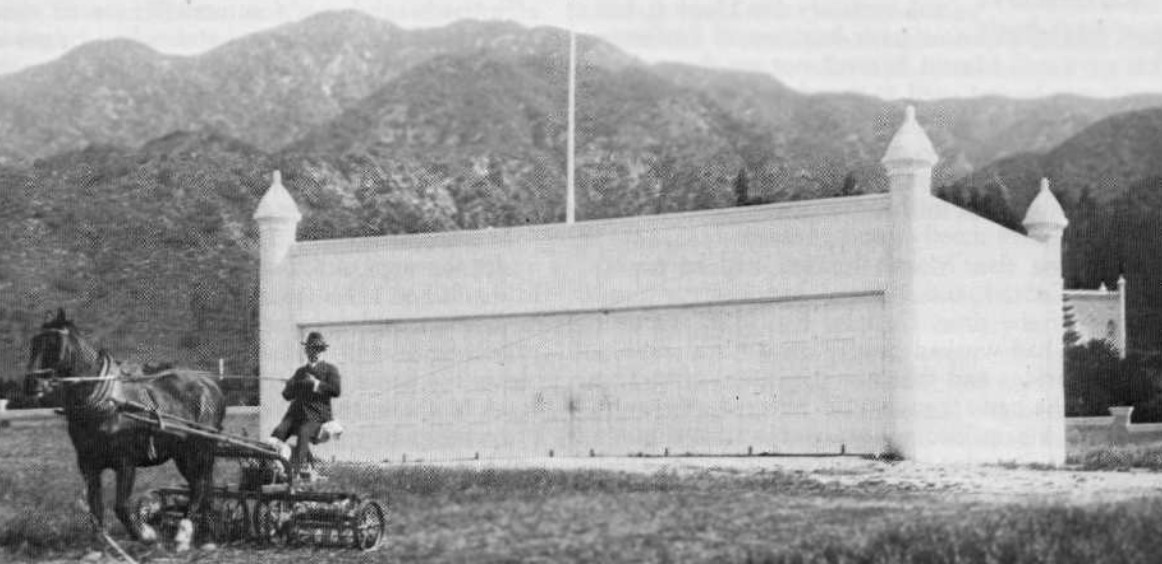 |
|
| (ca. 1920s)*#*# – View of millionaire Leslie C. Brand mowing the lawn in front of the Moorish-style hangar at his private Airfield. |
Historical Notes Brand built his first hangar in 1916 and put together a fleet of planes, and held fly-in parties. The only requirement was that guests had to arrive in their own planes and bring passengers.*^ |
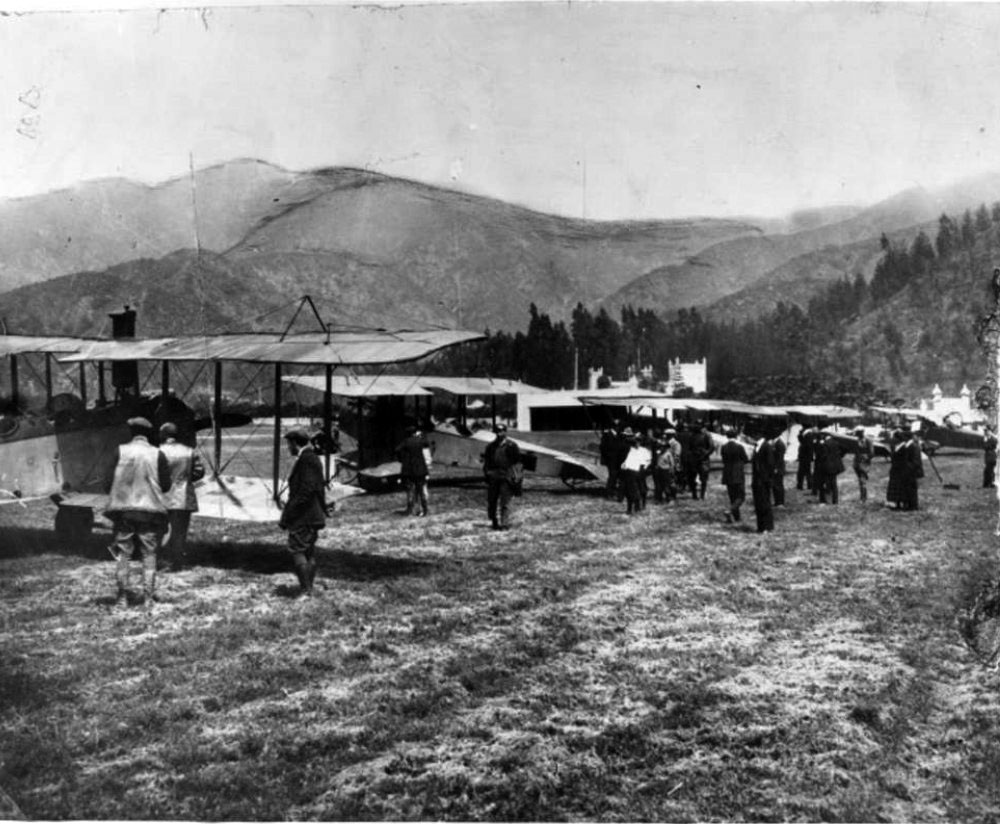 |
|
| (1921)^*# – Several airplanes and guests arriving at Brand's fly-in luncheon party on April 1, 1921. El Miradero Mansion is seen in the background. Click HERE to see more in Aviation in Early L.A. |
Historical Notes Brand Field was no longer depicted on a 1931 street map, but “Brand Park” was depicted, so the airfield may have ceased operation by that point.*#*# |
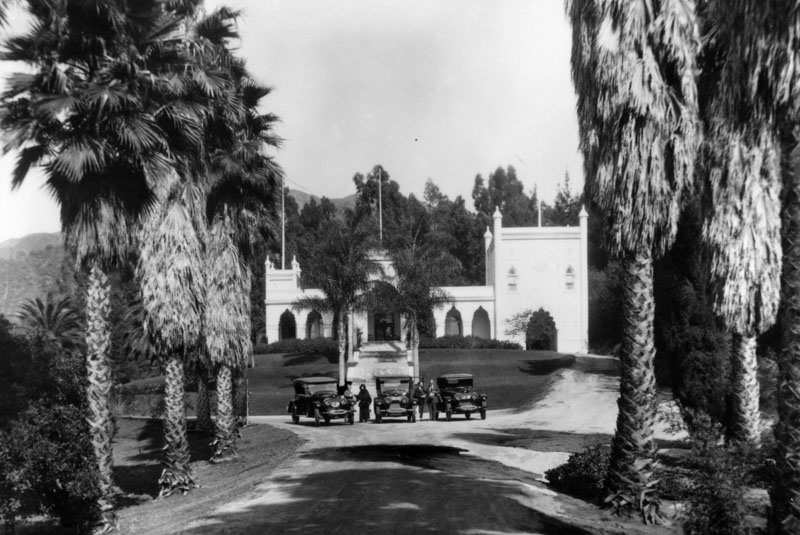 |
|
| (ca. 1920)^ - View of El Miradero and estate grounds, once home to Leslie C. Brand. Three vehicles are seen parked next to one another where the driveway and path to the front door meet. Four people, three men and one woman, are standing next to the automobiles. |
Historical Notes It was stated in Brand's will that El Miradero would be bequeathed to the city upon his wife's death, on the condition that the property be used exclusively for a public park and library. Mrs. Mary Louise Brand retained rights of the residence from 1925, when Mr. Brand died, until her death in 1945.^ |
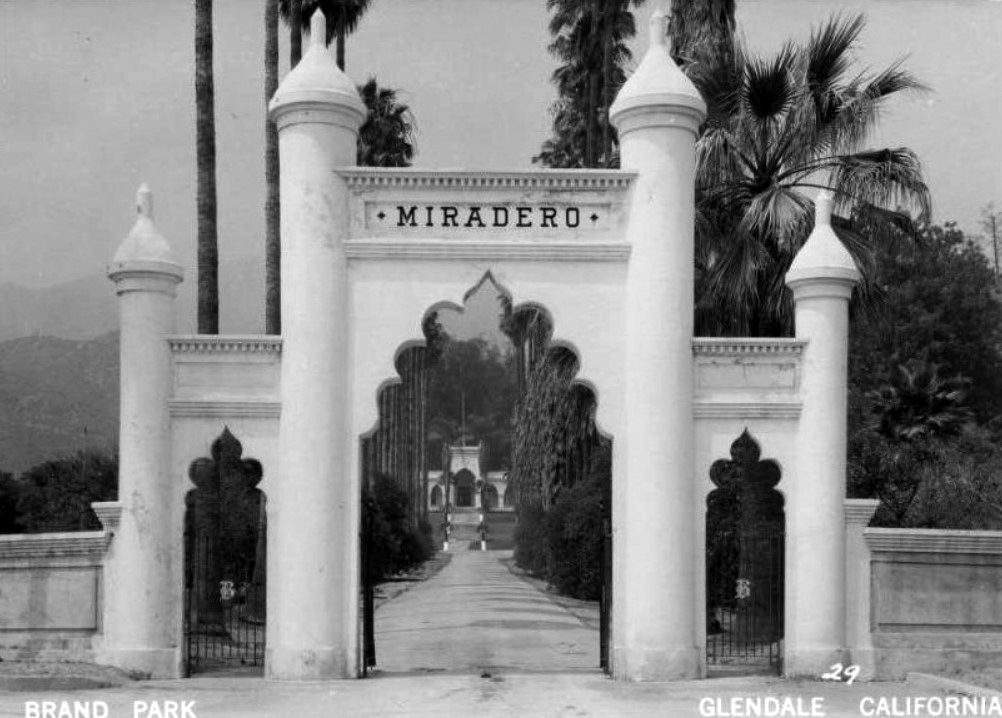 |
|
| (ca. 1940s)#^^ - Postcard view of the entrance to El Miradero, the estate of Leslie C. Brand, located in Brand Park. |
Historical Notes In 1956 the mansion became the Brand Library, the art and music branch of the Glendale Public Library. The address is 1601 West Mountain Street, Glendale.^ |
* * * * * |
Downtown Los Angeles
 |
|
| (ca. 1904)^^ - Panoramic view of downtown Los Angeles from the Melrose Hotel, looking east. Large Victorian residential buildings are in the foreground. The commercial district, city government buildings and churches are visible further back. City Hall stands in the middle of the photo. |
Historical Notes The Melrose Hotel was located at 138 S. Grand Ave. on Bunker Hill. It started as a Victorian mansion in 1881 and eventually became a hotel apartment. Click HERE to see more on the Melrose Hotel. If still standing today, the view from the front porch of the Melrose Hotel (looking west) would be that of Disney Hall, located directly across the street, on the other side of Grand Ave. |
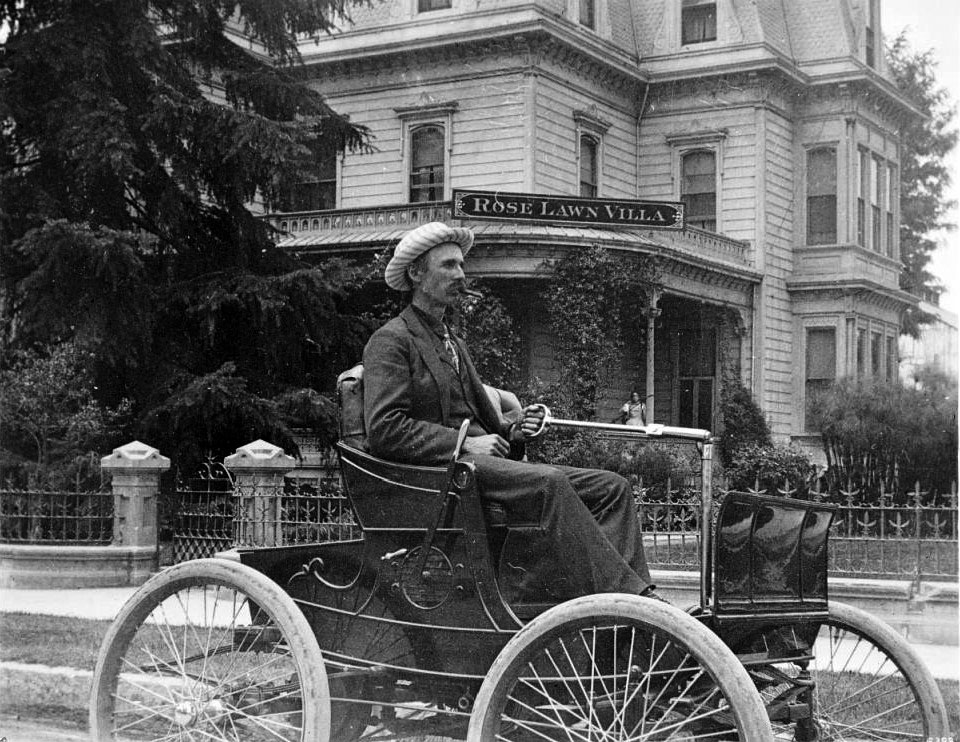 |
|
| (ca. 1902)^^ - View of man driving on Spring Street in front of the Van Nuys family residence. The man, dressed in a dark suit and candystriped hat, steers the topless carriage with a rod-and-stirrup device. In the background, the Victorian architecture of the I.N. Van Nuys residence can be seen, with its gingerbread roof, molded window frames and clapboard veneer. A wrought-iron fence marks the perimeter of the lawn. A woman is partially visible in the background from behind the vine-grown porch of the residence, over which hangs a sign reading "Rose Lawn Villa". Tree foliage obscures the left side of the residence. |
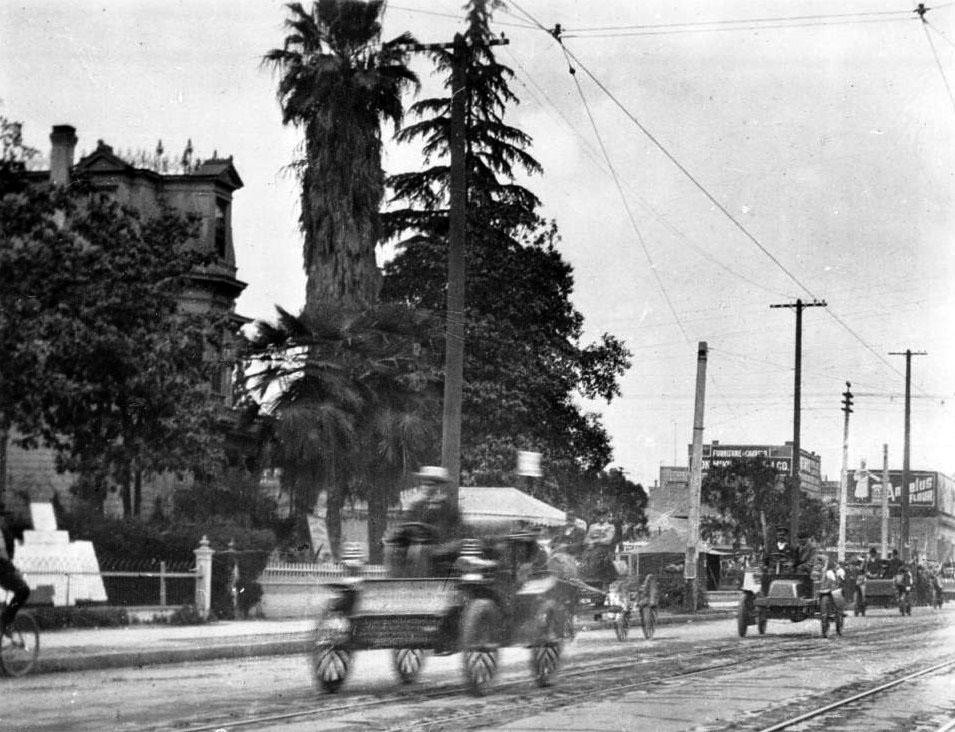 |
|
| (1904)^^ - View of Spring Street looking north from Seventh Street featuring the I.N. Van Nuys residence, May 24, 1904. Several early automobiles drive towards the camera along the unpaved street in which trollycar tracks are visible. Only the wrought-iron fence and the top of the Victorian architecture of the Van Nuys residence is visible from behind the lush treecover surrounding it. Telephone poles are visible, as well as large signs attached to building in the background which read "Furniture and Carpets" and "Angelus Flour". |
* * * * * |
State Normal School
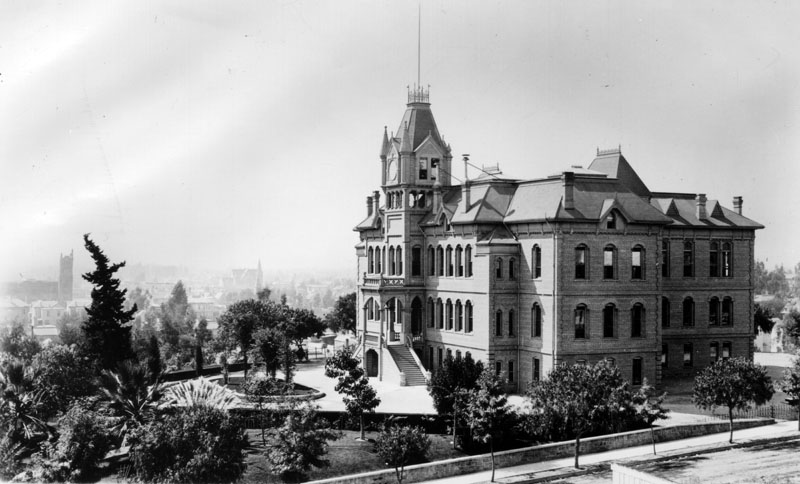 |
|
| (Early 1900s)^ -Side view of the State Normal School, located at Grand Avenue and 5th Street. From this location one could get a great panoramic view of downtown Los Angeles. |
Historical Notes In March 1881, after heavy lobbying by Los Angeles residents, the California State Legislature authorized the creation of a southern branch of the California State Normal School (which later became San Jose State University) in downtown Los Angeles to train teachers for the growing population of Southern California. The State Normal School at Los Angeles opened on August 29, 1882, on what is now the site of the Central Library of the Los Angeles Public Library system.*^ |
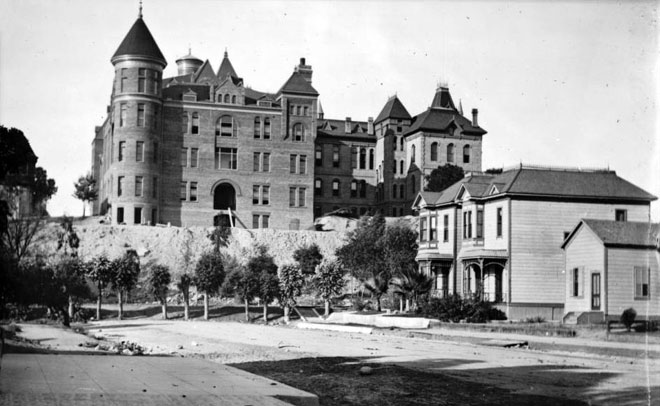 |
|
| (Early 1900s)^^ - Exterior view of the State Normal School,. Residential homes sit on a cul-de-sac behind the school. |
Historical Notes Through the years, the State Normal School was expanded and several new wings were added. In 1887, the school officially became known as the Los Angeles State Normal School.*^ |
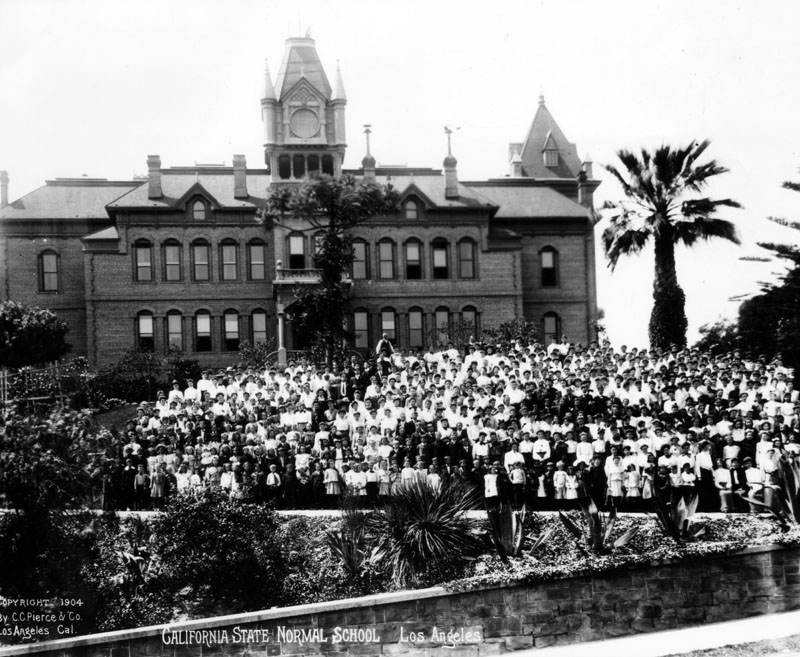 |
|
| (1904)^ - Panoramic photo of teachers and student body of the California State Normal School, located at 5th Street and Grand Avenue in Los Angeles. |
Historical Notes The California State Normal School included an elementary school where teachers-in-training could practice their teaching technique on children. That elementary school is related to the present day version, UCLA Lab School.*^ |
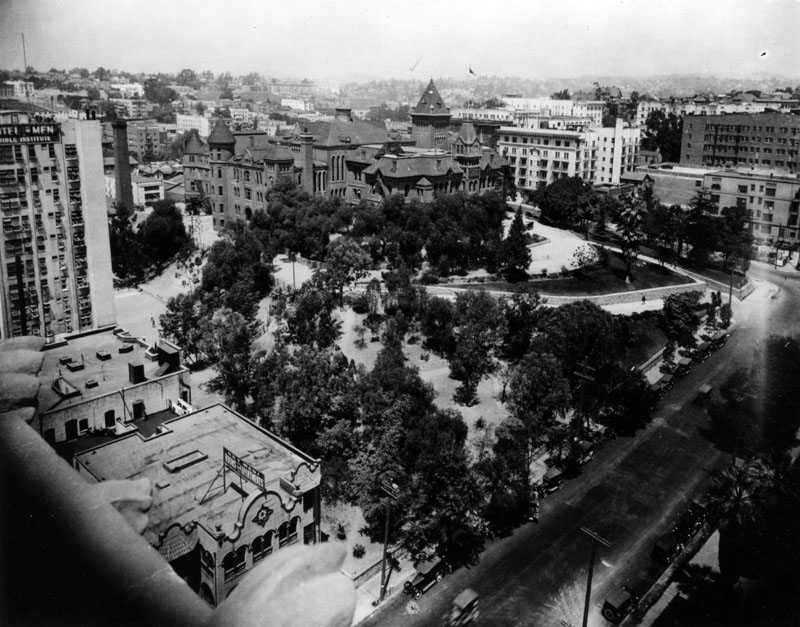 |
|
| (Early 1900s)^ - Aerial view of the State Normal School, located at Grand Avenue and 5th Street. Because the school sat impressively on the last knoll of Bunker Hill, aptly dubbed "Normal Hill". The large white building on the middle left is the Bible Institute, later to become the Church of the Open Door, that was located on Hope Street; the Key West Rooms and Apartments is visible on the lower left. |
Historical Notes By 1914 the little pueblo of Los Angeles had grown to a city of 350,000 and the school, whose enrollment far exceeded its capacity, moved to new quarters -- a Hollywood ranch off a dirt road which would later become Vermont Avenue. With a view toward expansion, Director Ernest Carroll Moore proposed in 1917 that the school become the first branch of the Berkeley-based University of California. Two years later on May 23, 1919, California Governor William D. Stephens signed the legislation that created the "Southern Branch" of the University of California -- no longer merely a teacher's college but an institution that offered two years of instruction in Letters and Science. Third- and fourth-year courses were soon added, the first class of 300 students was graduated in 1925, and by 1927 the Southern Branch had earned its new name: University of California at Los Angeles (the "at" became a comma in 1958). As the student population of the University continued to increase, the need for a new site became obvious and the search was soon under way for a permanent home for UCLA.^ |
Click HERE to see more Early Views of the Normal School and UCLA. |
* * * * * |
Patent Office (Hazard & Harpham)
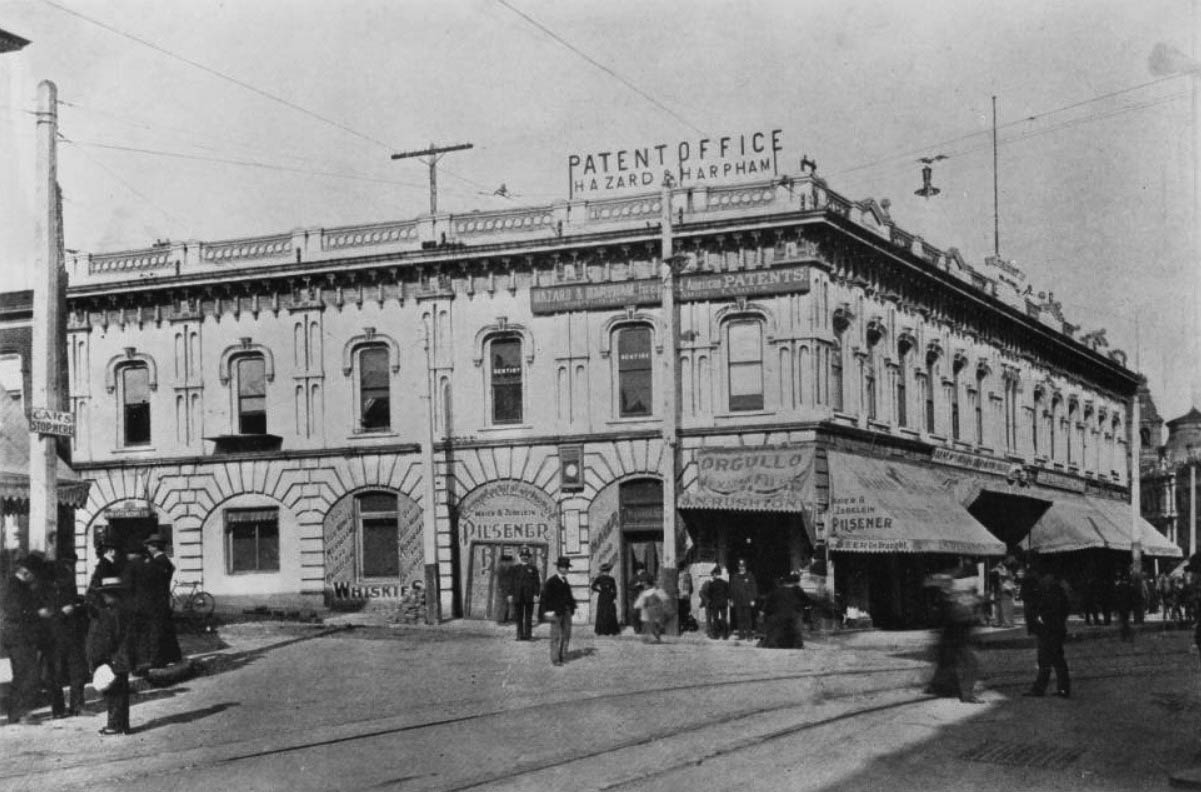 |
|
| (ca. 1904)^^ – View looking north showing the Downey Block on the N/W corner of Spring Street and Temple Street at the intersection of Spring, Main, and Temple streets. Men and women stand along the sidewalks and in the street in front of the Romanesque Downey Block, a building which houses several commercial interests; The Hazard and Harpham Patent Office advertises on the top floor, while signs on the bottom floor advertise all types of alcoholic beverages. |
Historical Notes The Downey Block was demolished in 1904. Since then the corner has been the site of two Federal Buildings: the Federal Building and Post Office (1910 - 1937) and the Federal Courthouse and U.S. Post Office Building (1940 - Present). The Hazard and Harpham Patent Office moved to a building on the southeast corner of Fifth and Spring streets (see next photo). |
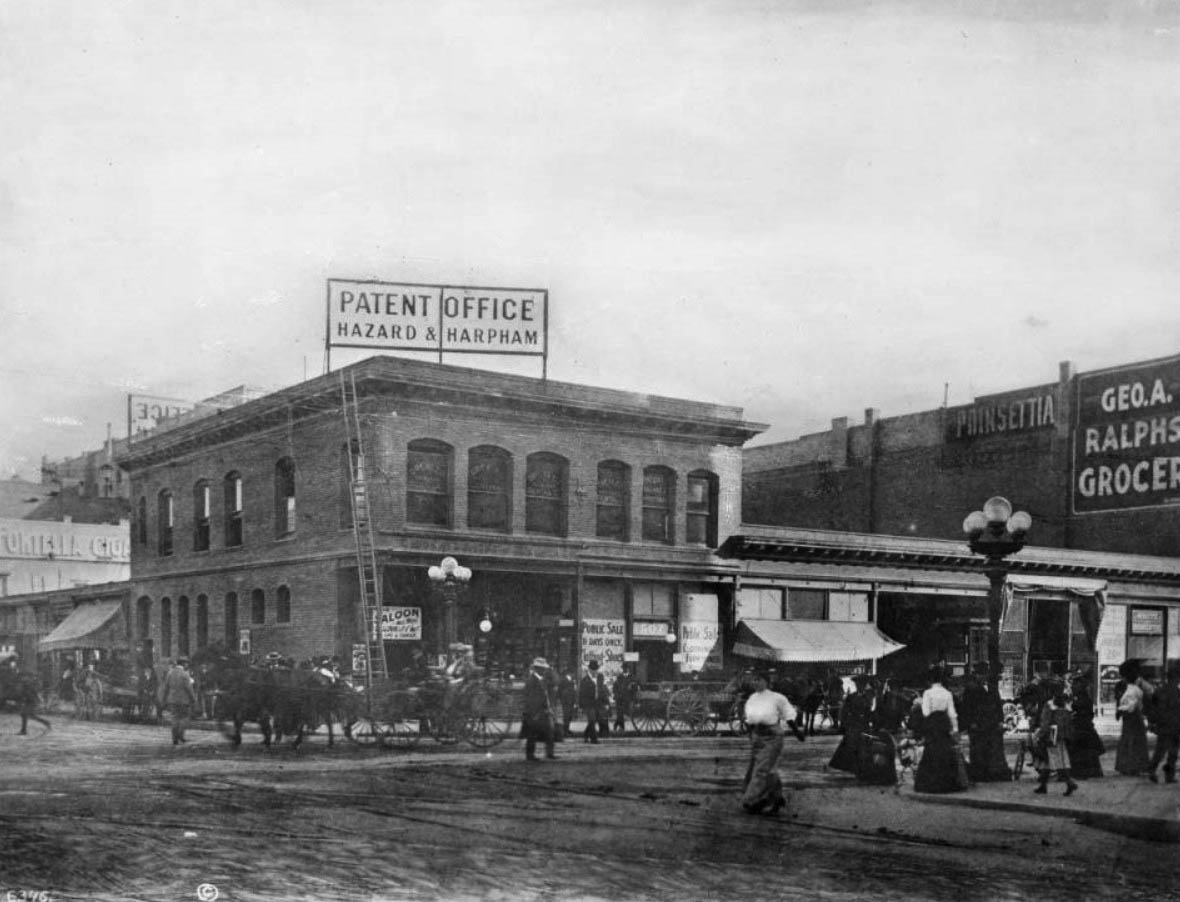 |
|
| (ca. 1905)^^ – View showing the southeast corner of Fifth and Spring Streets. At center, the Hazzard and Harpham Patent Office can be seen with a ladder leading to its roof on the second floor. Pedestrians are visible in the street as well as a horse and carriage at left. Further right, the George A. Ralphs Grocery Company can be seen, with a sign that reads "Poinsettia" on its visible wall. |
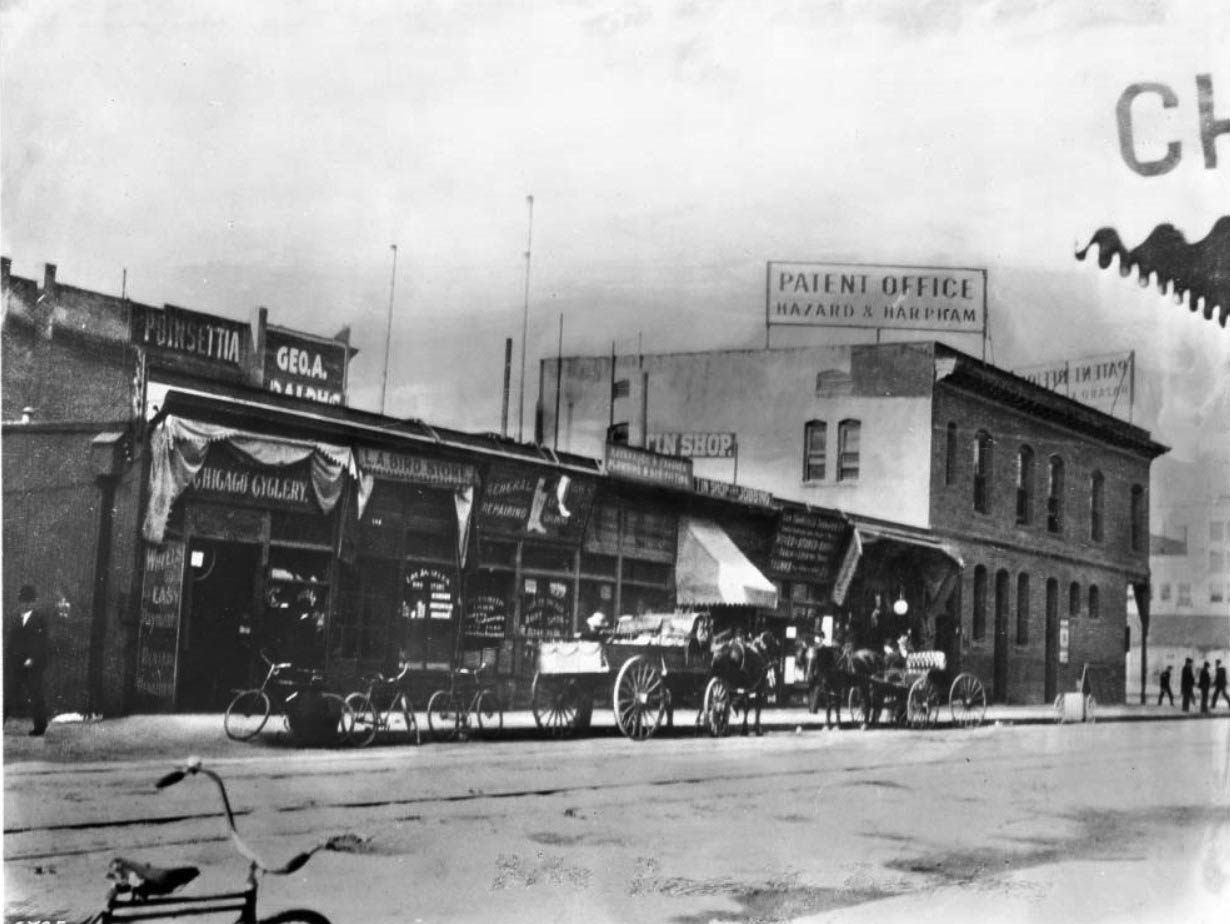 |
|
| (ca. 1905)^^ - View looking west on Fifth Street toward Spring Street. A short, one-story row of shopfronts terminates to the right of the photograph with the two-story brick Hazard & Harpham Patent Office building. A horse-drawn cart and a horse-drawn wagon stand along the sidewalk outside, along with three bicycles. A fourth bicycle is partially visible in the left foreground. A group of four men can be seen in the distance to the right, as well as a fifth that can be seen walking alone at the extreme left. Legible signs include: "Poinsettia", "Chicago Cyclery.", "Geo. A. Ralphs", "L.A. Bird Store" , "Wheels Sold as Easy Payments and Repaired", "General Repairing", "Boot / Shoe", and "Tin Shop and Jobbing". |
* * * * * |
Spring and 1st Street
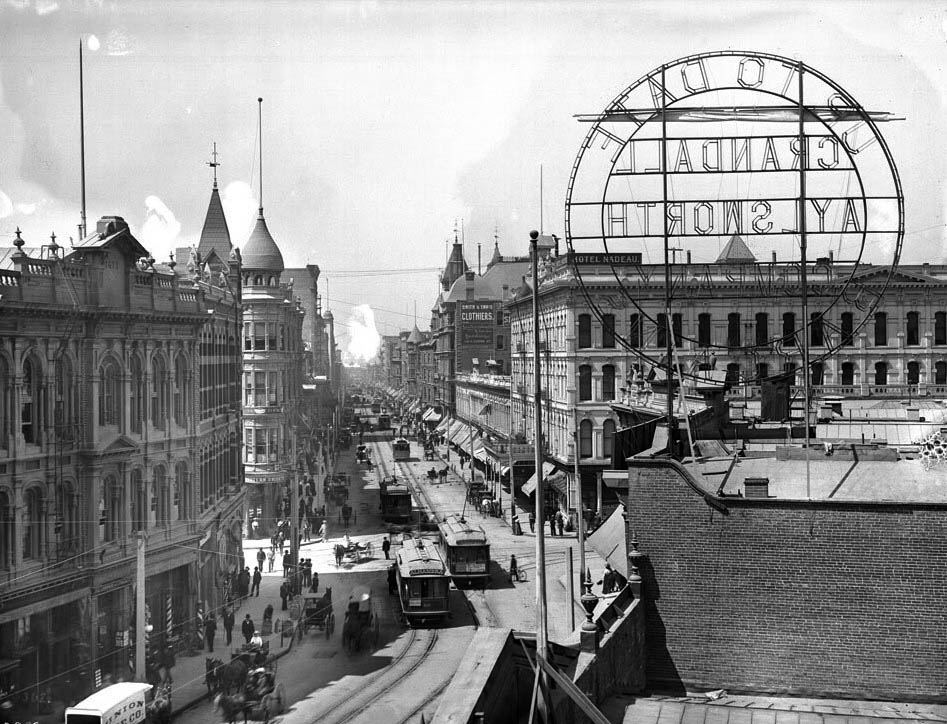 |
|
| (ca. 1904)^^ - Intersection of Spring Street and First Street looking south. The Nadeau Hotel (erected 1885) is visible at right (later the site of the Times Building). Most of the buildings appear to be commercial and average four-stories high. The busy street is crowded with streetcars, horse-drawn vehicles, and pedestrians. The street cars are labeled: "Alhambra and San Gabriel, 88", "Pasadena", "Pasadena, 85", "Plaza". The large circular sign on the roof top to the right reads: "Up to date bargains, Crandall Aylsworth Company". |
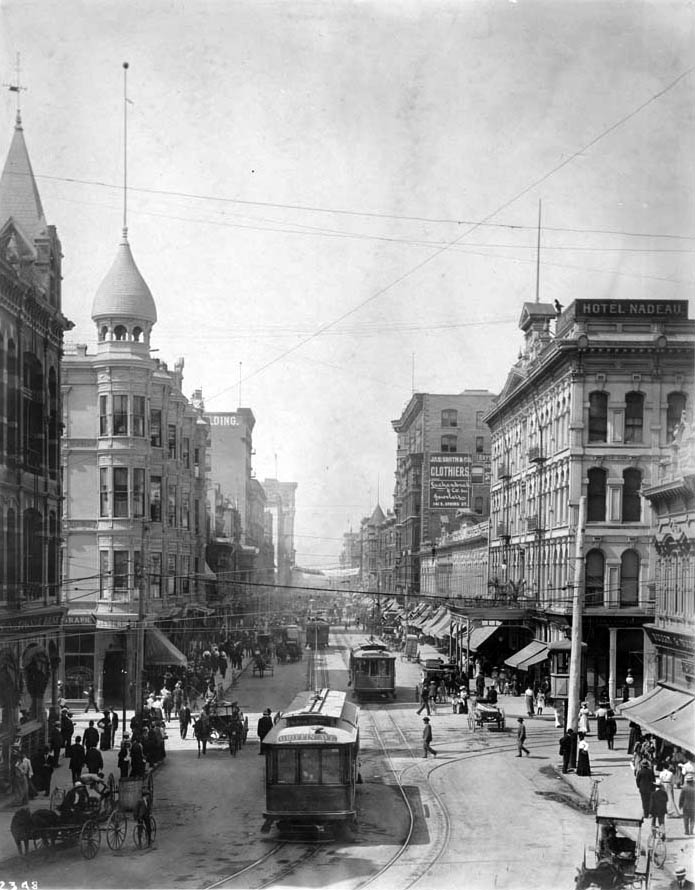 |
|
| (ca. 1905)^ - View of Spring Street at 1st, looking south, circa 1905. The Nadeau Hotel appears on the right. Spring St. was then the center of the city's financial activities. Electric cable cars can be seen in photo. |
Historical Notes In 1882, Remi Nadeau built the Nadeau Hotel on the SW corner of 1st and Spring streets. It was Los Angeles's first four-story structure and the first building with an elevator. The hotel was designed by Morgan & Walls. The Nadeau Hotel stood on the southwest corner until 1932, when it was demolished to make room for the current Los Angeles Times Building. |
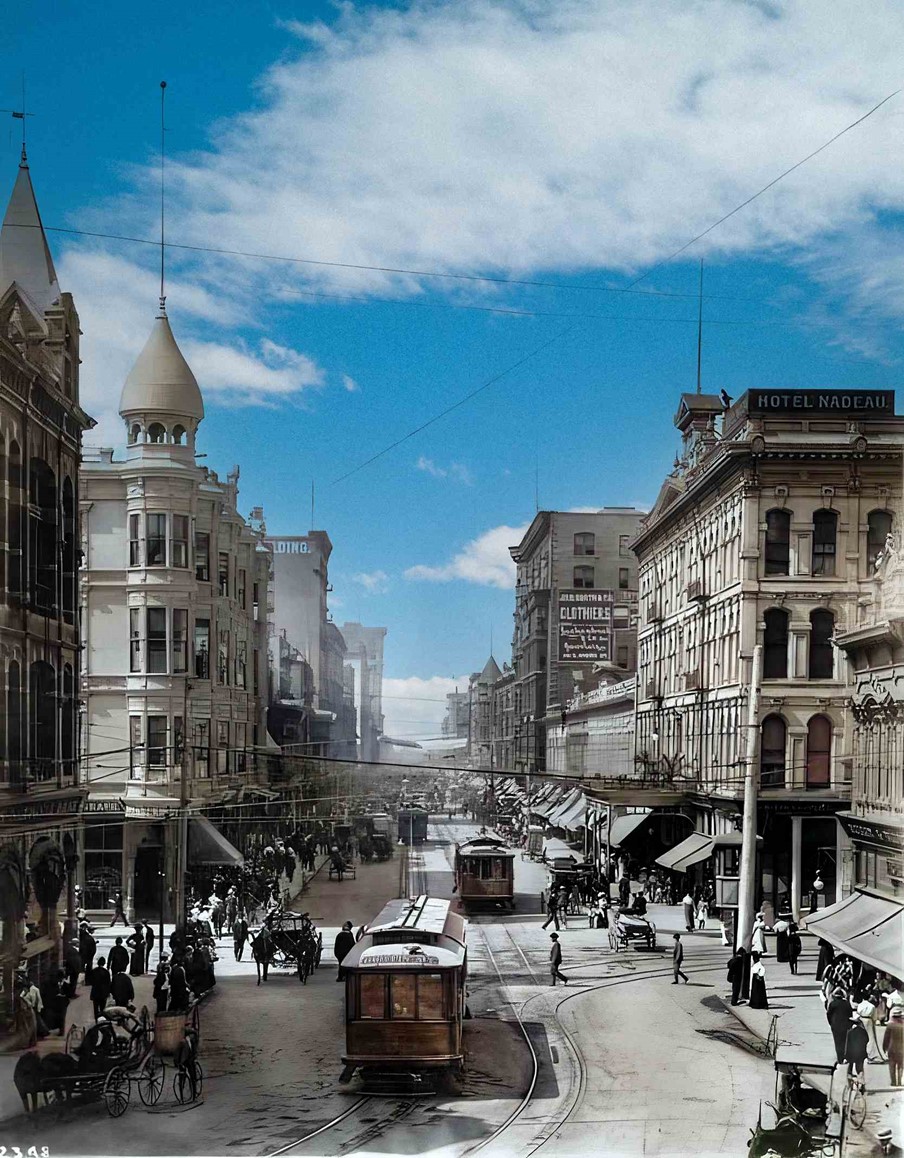 |
|
| (ca. 1905)^ - View of Spring Street at 1st, looking south with the Nadeau Hotel on the right (SW) corner. AI image enhancement and colorization by Richard Holoff |
Spring and 3rd Street
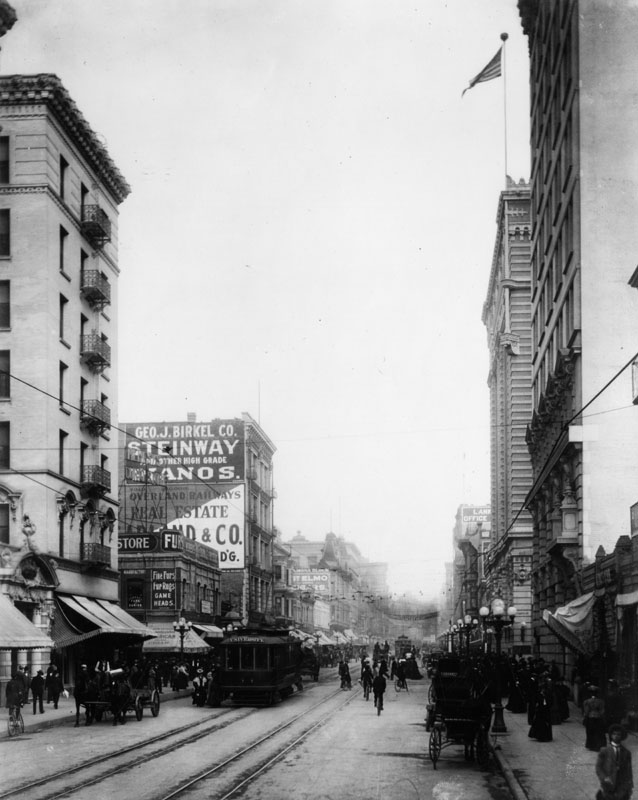 |
|
| (1905)^ - View of Spring Street looking north toward between 4th and 3rd Streets. A large number of pedestrians are on the sidewalk, and in the street are bicyclists, carriages and trolleys, one of which is marked "University." On the left is the George J. Birkel Co., selling Steinway Pianos. Other businesses include a store selling furs, rugs and game heads. Tall office buildings are on either side of the street, including the Braly Building and the Hellman Building at right. |
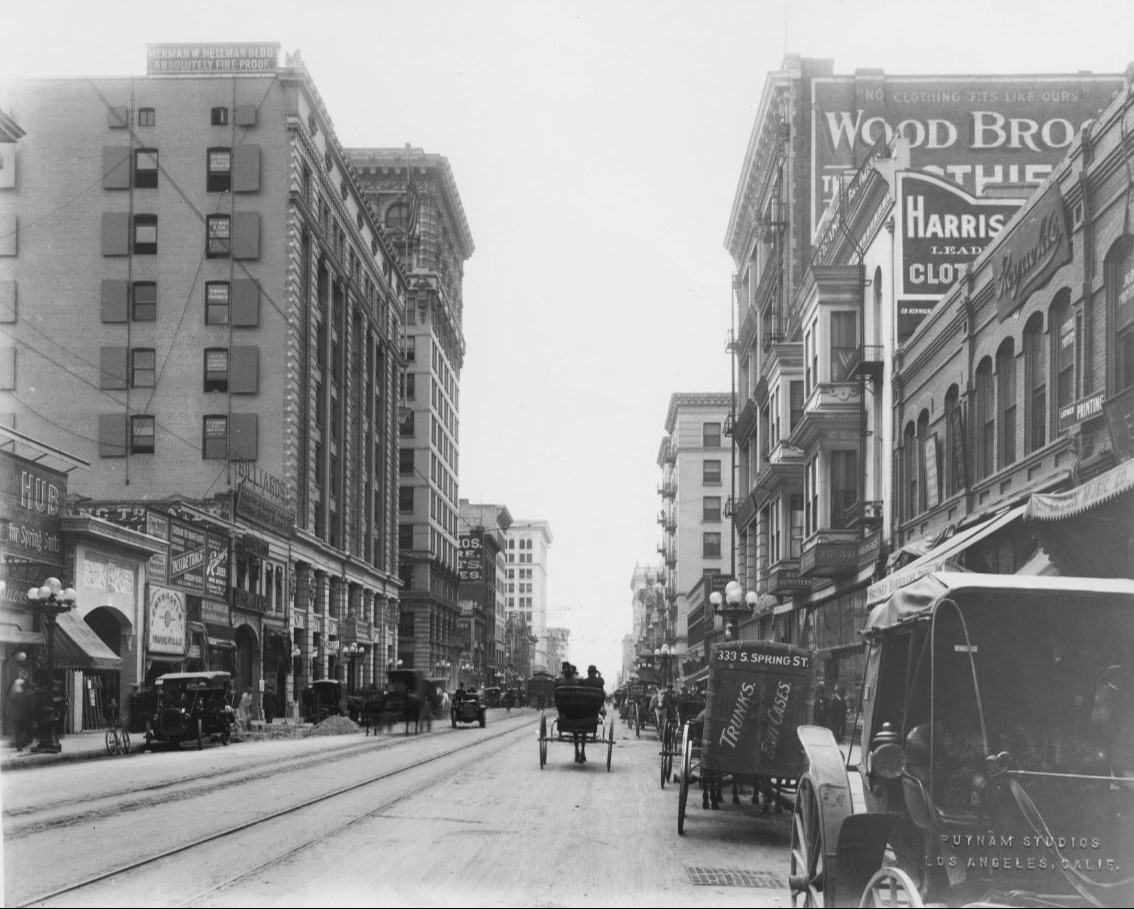 |
|
| (ca. 1904)* – View looking south on the 300 block of Spring Street with the Hellman Building seen on the left (NE corner of Spring and 4th). Horse-drawn carriages share the street with early model cars. |
Spring and 4th Street
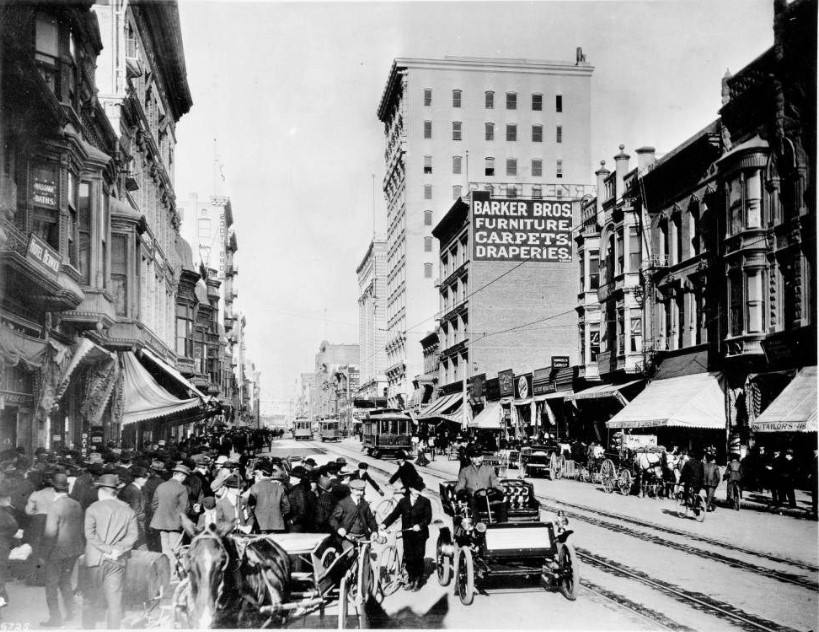 |
|
| (ca. 1905)^ - View of a very crowded Spring Street looking north from 4th Street near Barker Bros. Flat-faced commercial highrise buildings are packed closely together on the side of the street. Businesses include Barker Brothers which boasts "Furniture, Carpets, Draperies", Kunnel's Lunch, the Hotel Berwick, a bath and massage house, the Scott Brothers Building, and the Great Western Market. |
 |
|
| (ca. 1905)^^ - Closer view of previous photo shows a man with a moustache driving an early topless automobile while men stand next to him walking their bicycles. Horse-drawn carriages are visible parked along the sidewalk in the background while a streetcar makes its way up the street from the distance. |
* * * * * |
Hill and 7th Streets
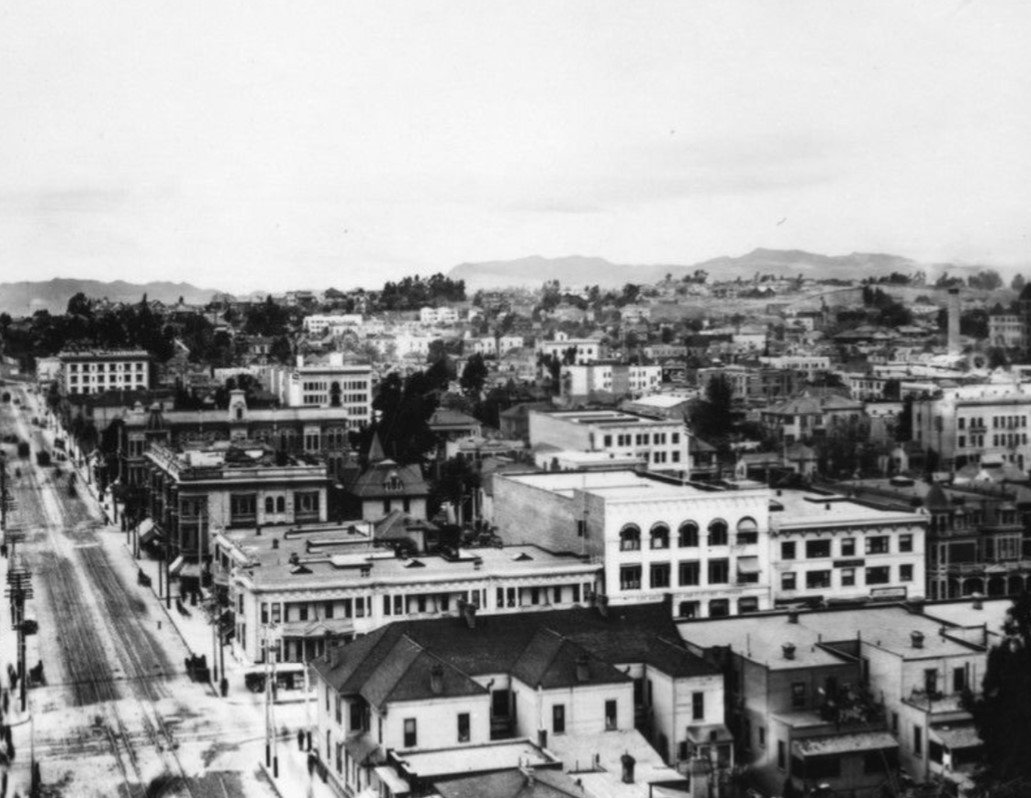 |
|
| (1905)* - Looking west on Hill Street at 7th Street in DTLA. The tall white building (center-right) that has arched windows and is wedged between two others is the Los Angeles Gas and Electric Company building located at 645 S. Hill Street. The original Hotel Biltmore can also be seen here (center-left). It’s the two-toned building located on the NE corner of Olive and 7th streets. |
Historical Notes The original Baltimore Hotel seen above, the two-toned building with the conical tower located on the NE corner of Olive and 7th streets, would become the future site of the Los Angeles Athletic Club (built in 1911, occupied in 1912). The new Hotel Baltimore was built at 5th and Los Angeles Streets in 1910. |
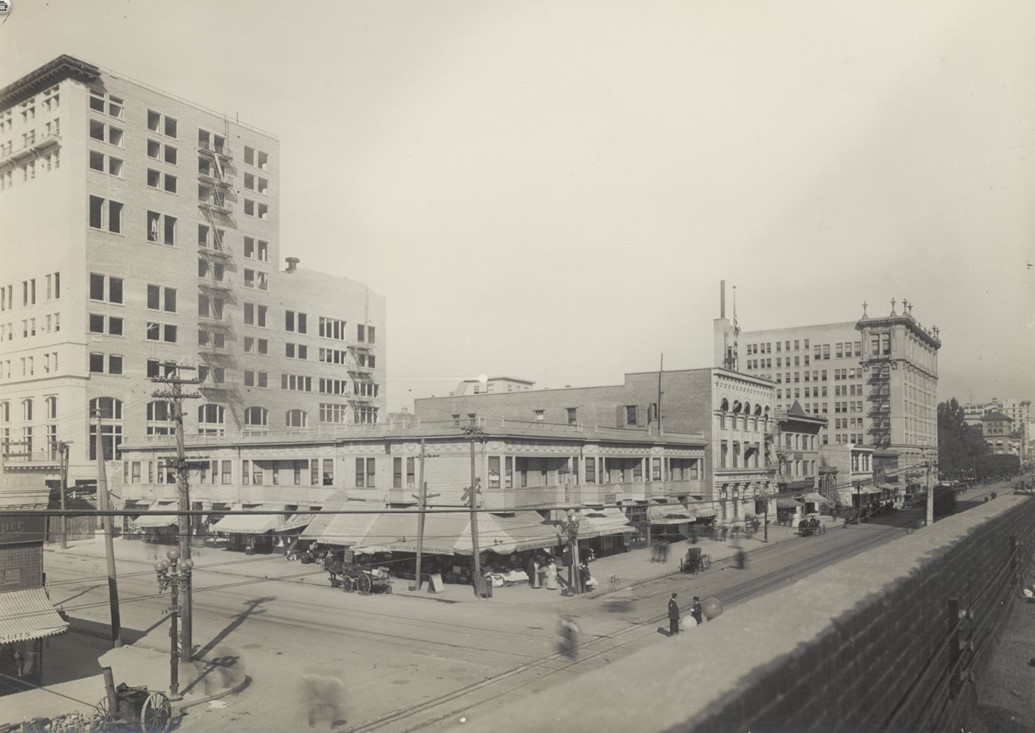 |
|
| (ca. 1911)* - Elevated view looking at the NW corner of S. Hill Street at 7th Street showing a two-story building at center, awnings over open market of stores and shops, three story Los Angeles Gas and Electric Company at 645 S. Hill St. right of market; multi-story building at left is the 1911-built Los Angeles Athletic Club (LAAC), built on the site of the original Hotel Biltmore. |
Historical Notes In 1912, the LAAC moved into its current 12-story Beaux-Arts clubhouse (seen above), designed by architects John Parkinson and George Bergstrom. This building was the first in Southern California to have an interior swimming pool on an upper floor. Click HERE to see more early views of the Los Angeles Athletic Club. |
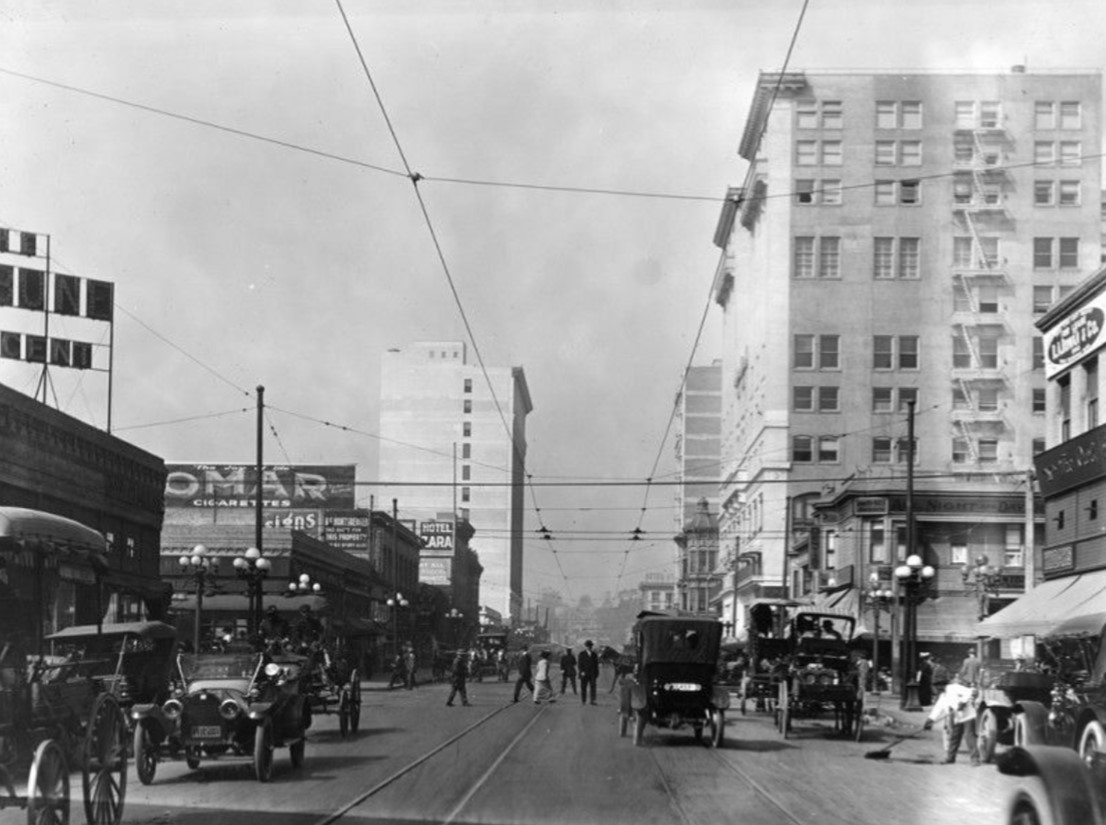 |
|
| (1912)* - Looking west on 7th Street from near Hill Street. The L.A. Athletic Club is the large building on the right. In the foreground from the club appears a sign identifying the "Seventh and Hill St. Branch" of All Night and Day Dentist. |
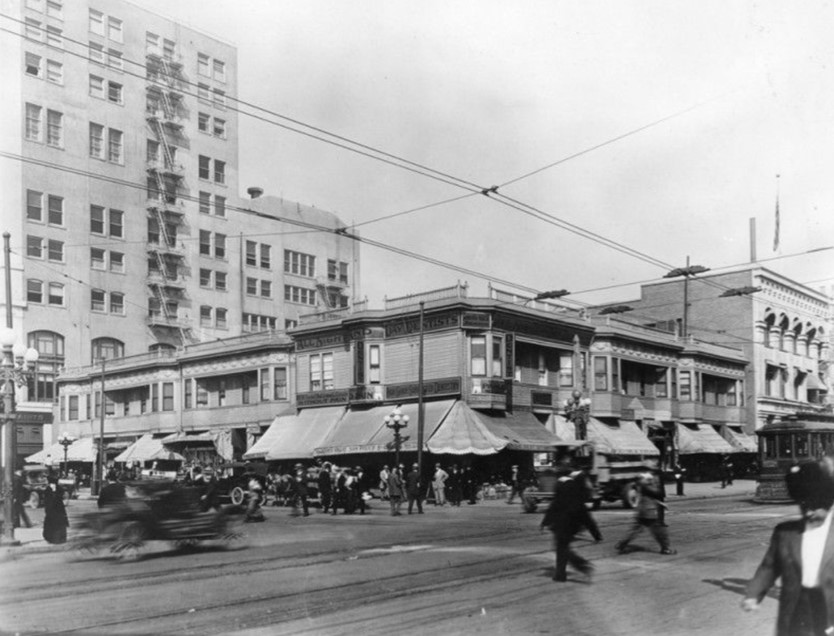 |
|
| (ca. 1912)* - Street view looking at the NW corner of 7th Street at Hill Street. The Los Angeles Athletic Club is the large white building on the left. In the middle of the photo is a dental building identified as the Seventh-Hill St. branch of the All Night and Day Dentists. Other signs read, "Teeth treated, filled, crowned and extracted without pain", "Absolutely no pain", "High grade guaranteed dentistry", and "Latest painless method". Below the dental offices, a small shop sells candies, fruit and .05 cent cigars. On the extreme right, behind a trolley, the Los Angeles Gas and Electric Co. can be seen with Old Glory on its roof. |
Los Angeles Gas and Electric Co. (645 S. Hill St)
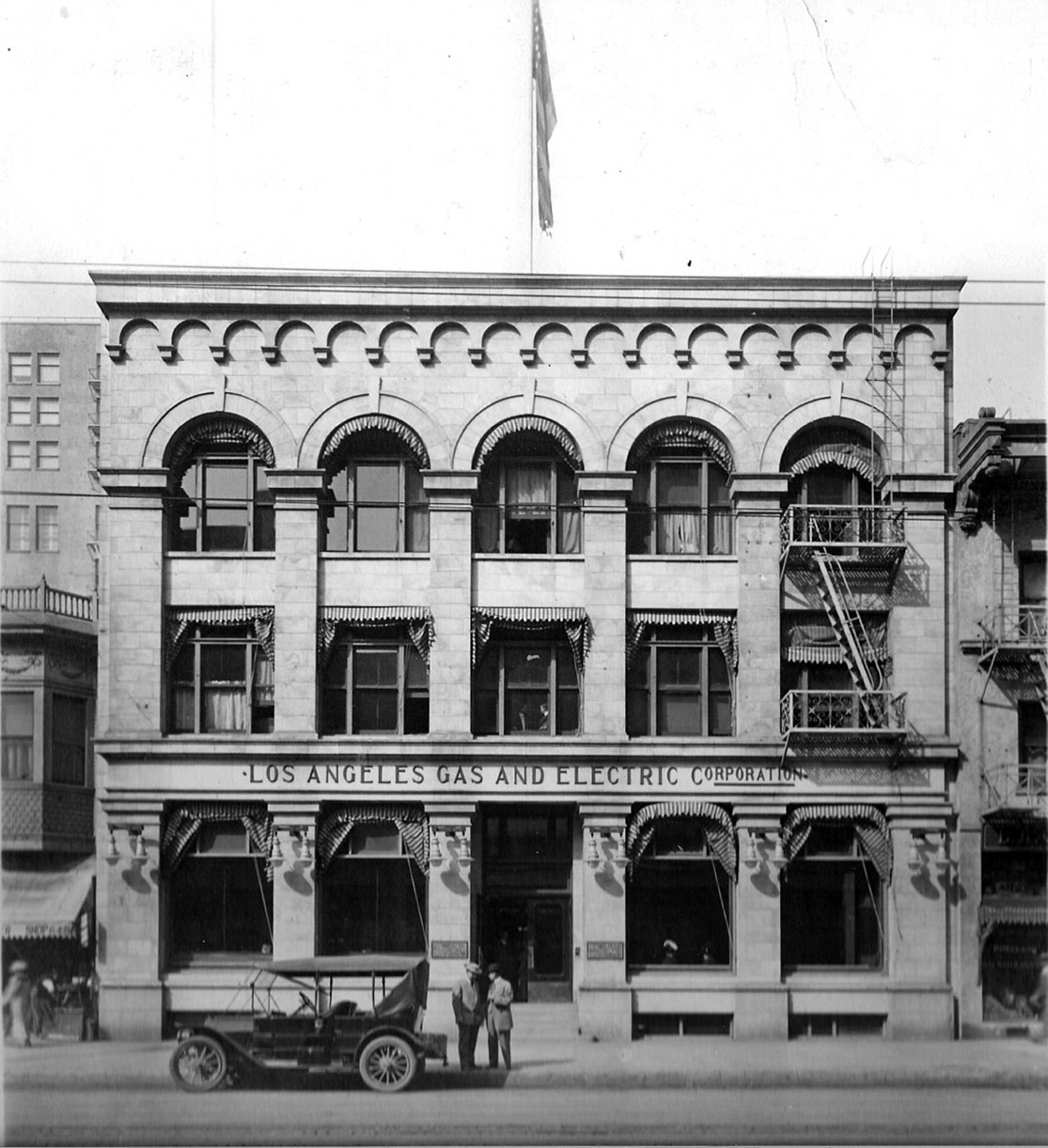 |
|
| (1920s)* - Two men are standing next to an early model car in front of the Los Angeles Gas and Electric Co. Building located at 645 S. Hill Street (two lots north of 7th Street). |
Historical Notes The Los Angeles Gas and Electric Corporation (LAGC) was one of the first utilities in Los Angeles. It competed with Los Angeles Bureau of Power and Light (BP&L) and SCE in the early 1900s. In 1936, BP&L (later LADWP) would buy out the electrical side of LAGC to become the sole provider of electricity in Los Angeles. The gas side of LAGC would then become Southern Californa Gas Company. Click HERE to see more on the Los Angeles Gas and Electric Corporation. |
Boylston Street
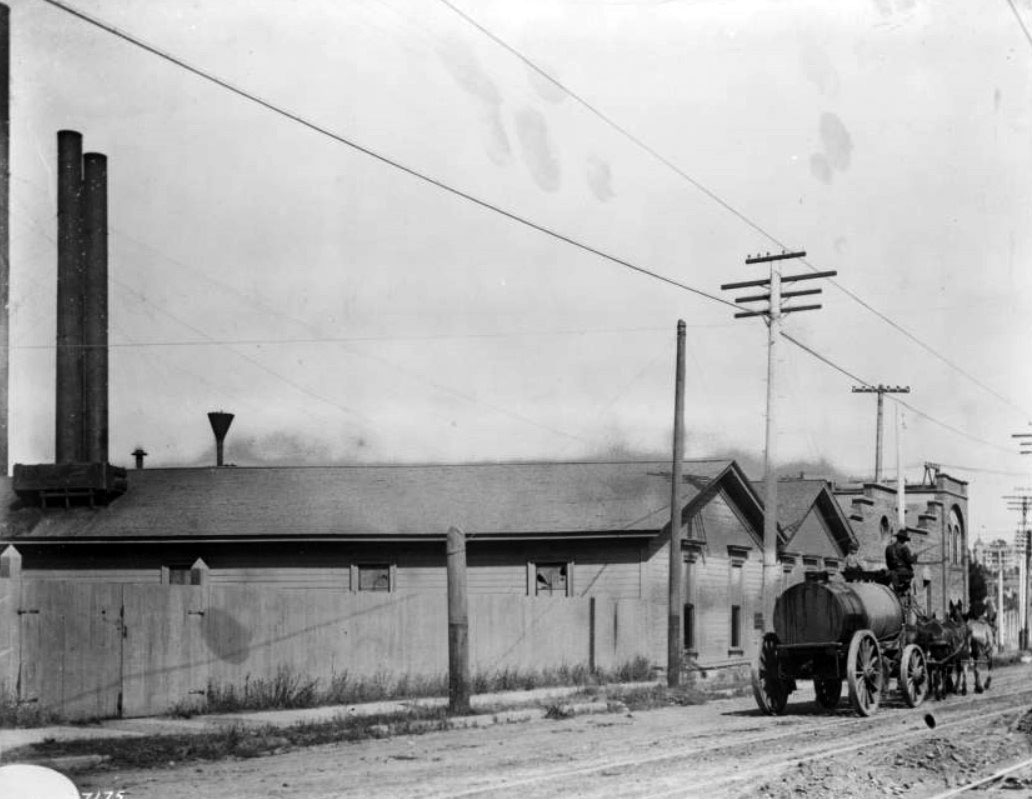 |
|
| (ca. 1900)^^ - View of Second Street looking east toward Boylston Street showing the Edison Electric Company Steam Plant No. 1. A man with a horse-drawn tanker wagon is making his way away from the camera along the unpaved road, with the Edison Electric power house behind a picket fence to his left. |
Historical Notes Between 1897 and 1906 the power house was in use as Edison Electric Company Steam Plant No. 1. This was Edison's first power plant located in the City of Los Angeles. |
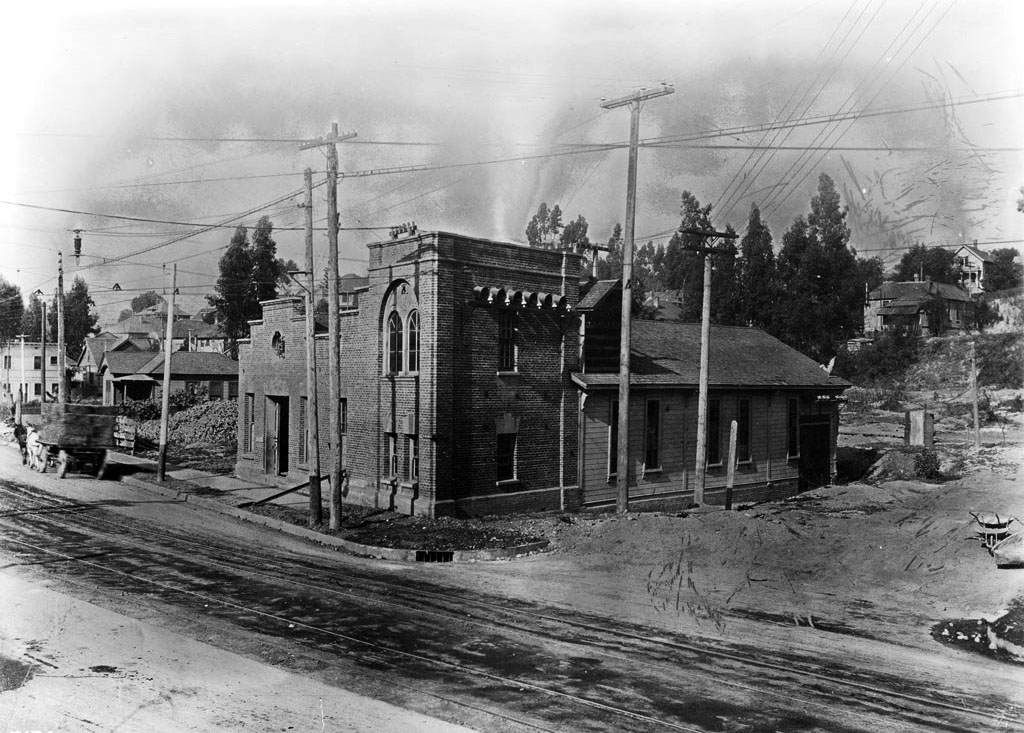 |
|
| (ca. 1906)^ - View showing the 'old' Edison Electric Steam Plan No. 1 located on the northwest corner of 2nd and Boylston streets. The auxiliary buildings with clapboard veneers and smokestacks that once were attached to the corner brick building have been removed.The two-story brick utility building now stands next to a cleared lot in front of an unpaved road in which streetcar rails can be seen, surrounded by utility poles. |
Historical Notes At the time of this photo the brick building at the corner of 2nd and Boylston streets, once part of Edison Electric Steam Plant No. 1, was no longer being used as a power plant. It now was serving as an Edison Electrical Sub-Station. In 1909, Los Angeles Edsion Electric changed its name to Southern California Edison (SCE). |
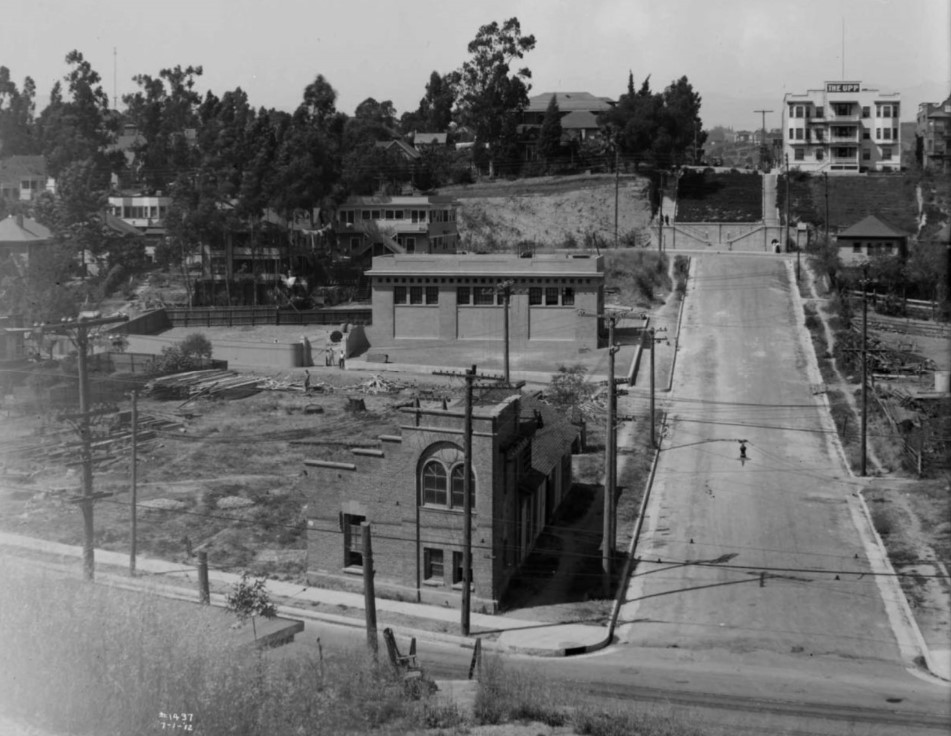 |
|
| (1912)* – View looking north on Boylston Street from above 2nd Street. The 'old' Edison Steam Plant No. 1, later converted to a Sub-Station, is on the N/W corner. A newer, more modern Sub-Station stands a couple hundred feet behind the old one at center of photo. The hill in the background is filled with apartment buildings and homes. Today this same hill is occupied by Belmont High School. |
Historical Notes Over the years the Boylston facility has been used by the West Side Lighting Company, Los Angeles Edison Electric, Southern California Edison, and the Los Angeles Department of Water and Power, which has occupied the site since 1940. Click HERE to see more in Early Boylston Street Yard. |
* * * * * |
Los Angeles and Central Oil Fields
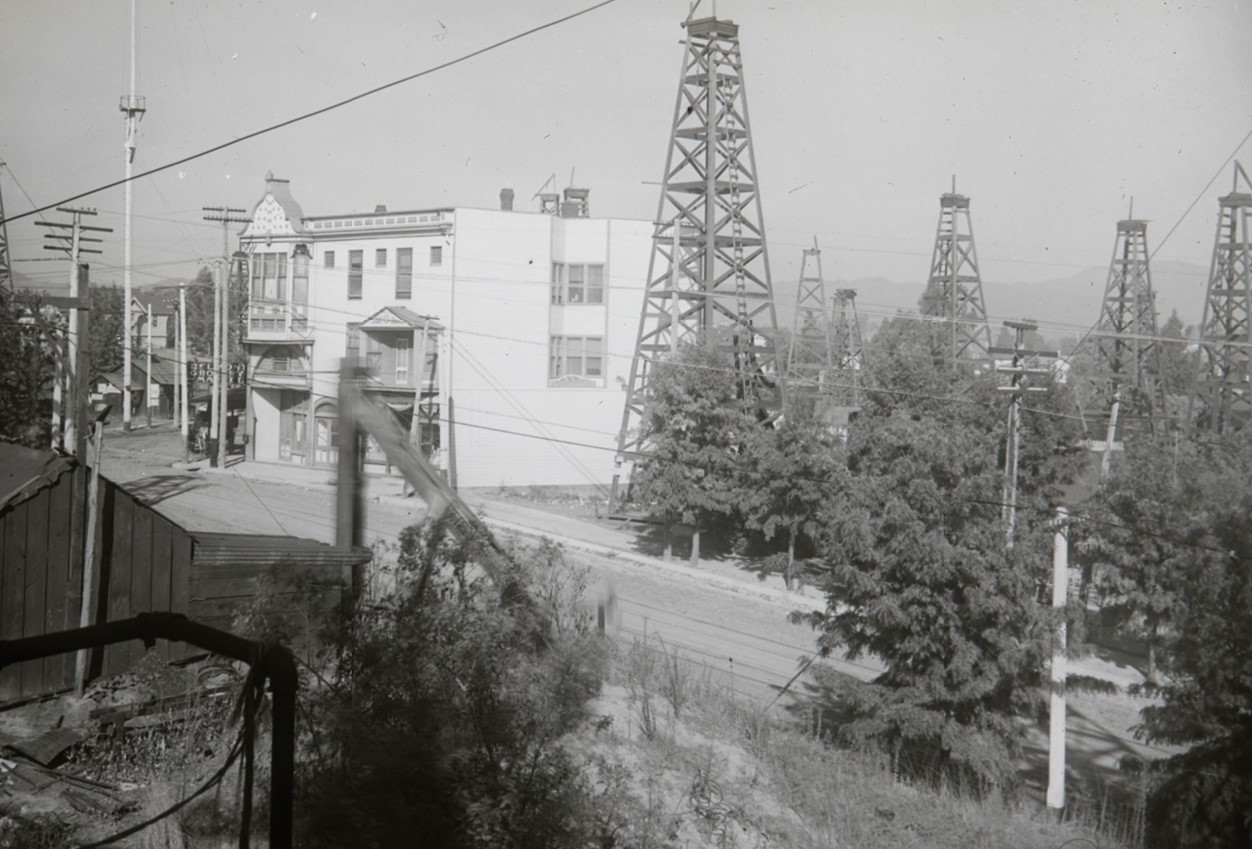 |
|
| (1905)* - Central Los Angeles Oil Field, from top of tank, nw corner 1st Street and Lake Shore Ave. |
Historical Notes The Central Oil Field above is situated just south of the largest producing oil field in the history of the Southland called the Los Angeles Oil Field. The Los Angeles City Oil Field is a large oil field north of Downtown. Long and narrow, it extends from immediately south of Dodger Stadium west to Vermont Avenue, encompassing an area of about four miles long by a quarter mile across. Its former productive area amounts to 780 acres. |
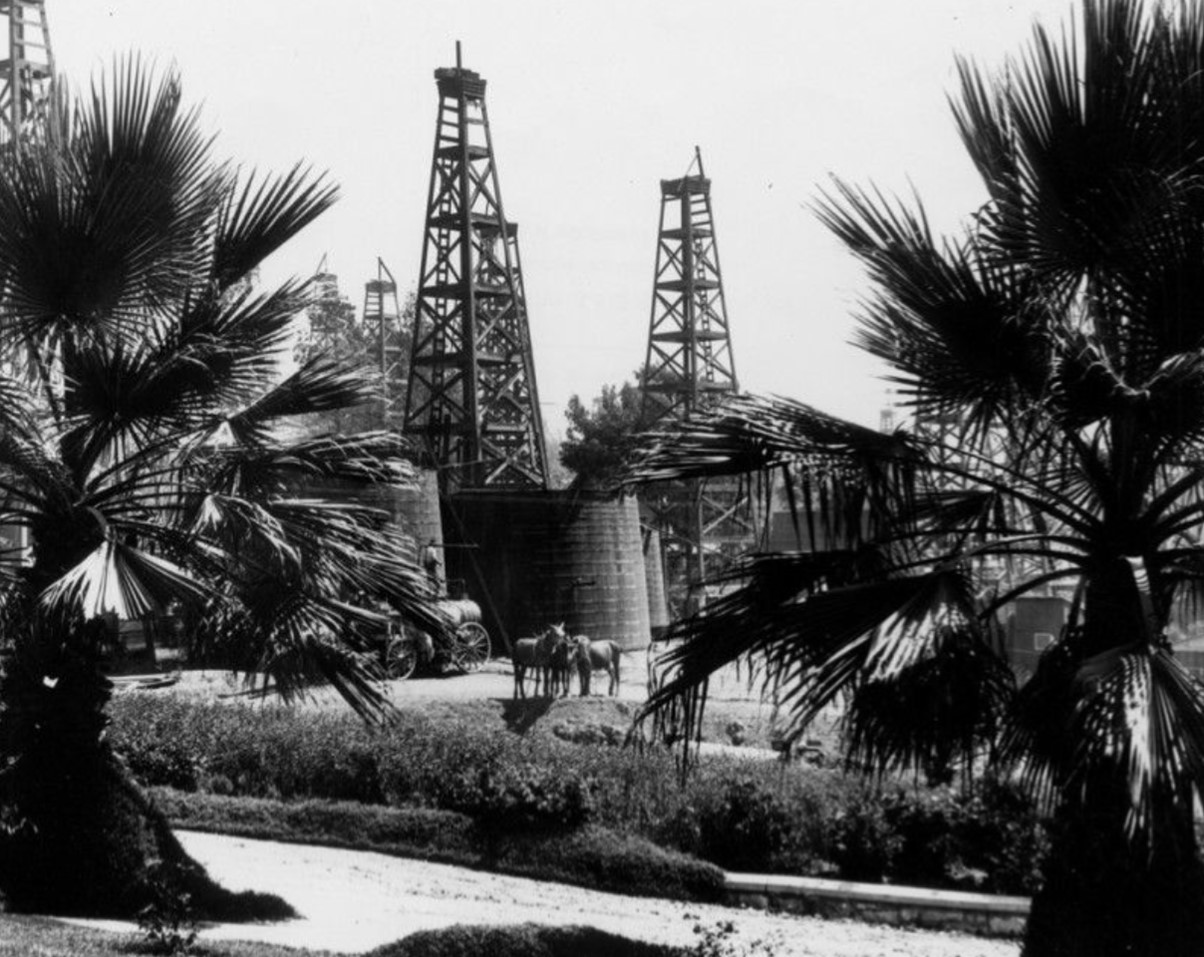 |
|
| (ca. 1890s)* - Oil field east from the corner of 1st Street and Belmont Avenue. |
Historical Notes Discovered in 1890, and made famous by Edward Doheny's successful well in 1892, the Los Angeles Oil Field was once the top producing oil field in California, accounting for more than half of the state's oil in 1895. In its peak year of 1901, approximately 200 separate oil companies were active on the field, which is now entirely overbuilt by dense residential and commercial development. |
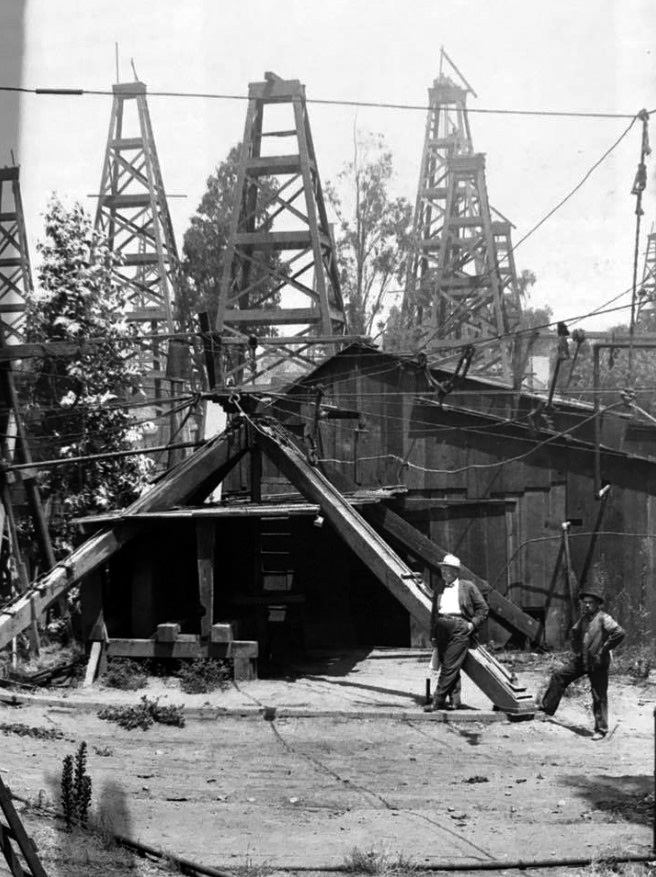 |
|
| (1904)^ – Close-up view showing two men standing in front of an oil rig located at Court and Toluca streets, with several oil wells seen in the background. Click HERE to see a Google map view of the above location. |
.jpg) |
|
| (1906)* - Los Angeles oil fields map of the wells just west of downtown in 1906. The filled in circles represent producing wells, non-filled circles represent non-producing wells (Source: Library of Congress). |
Historical Notes The fortunes made during development of the Los Angeles Oil field led directly to the discovery and exploitation of other fields in the Los Angeles Basin. Of the 1,250 wells once drilled on the field, and the forest of derricks that once covered the low hills north of Los Angeles from Elysian Park west, little above-ground trace remains today. |
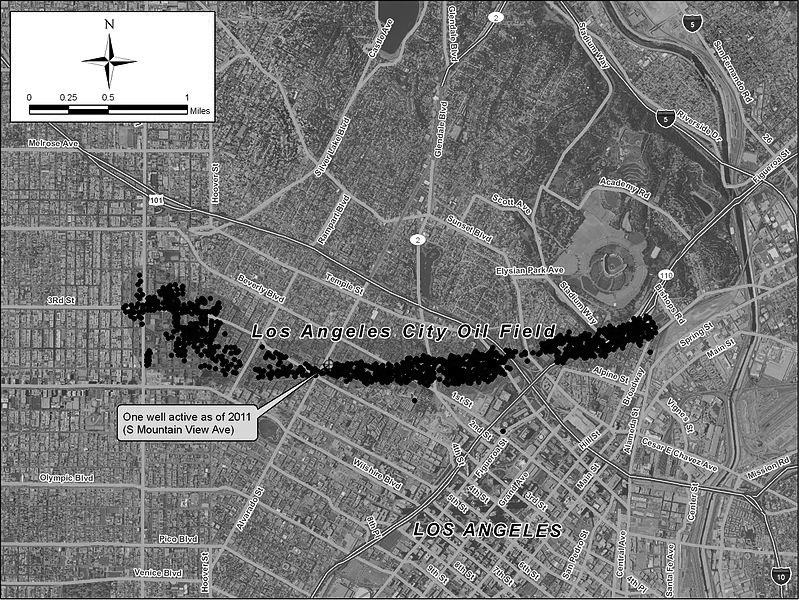 |
|
| (2011)* - Detail of the Los Angeles City Field, showing locations of former wells, and single active well remaining in 2011. |
Before and After
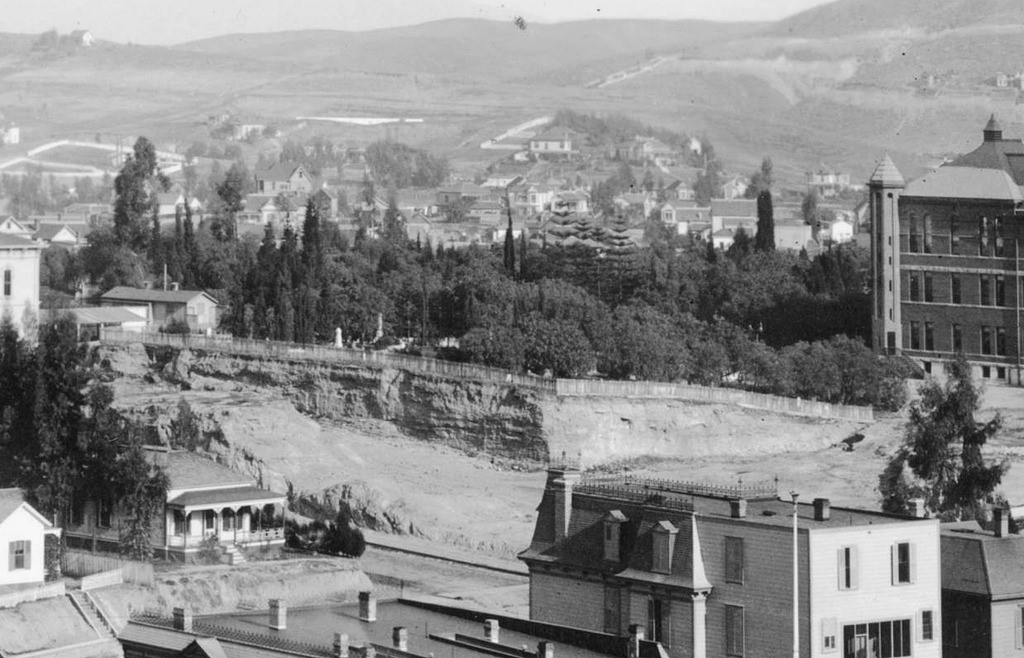 |
|
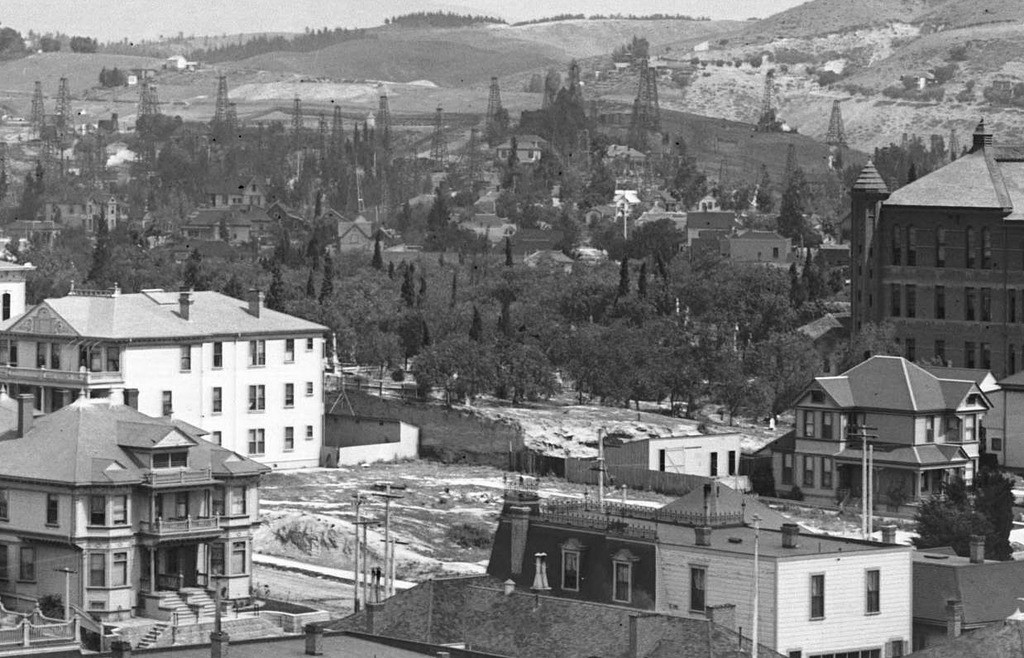 |
|
| (1898 vs. 1904)^ – Before and after views looking northwest from the County Courthouse showing how quickly the landscape has changed (six years) as a result of Edward Doheny’s discovery of oil . Note the numerous oil derricks in the background with Los Angeles High School seen at right. |
Historical Notes Click HERE to see more on the Los Angeles Oil Boom of the 1890s |
* * * * * |
Early Downtown LA
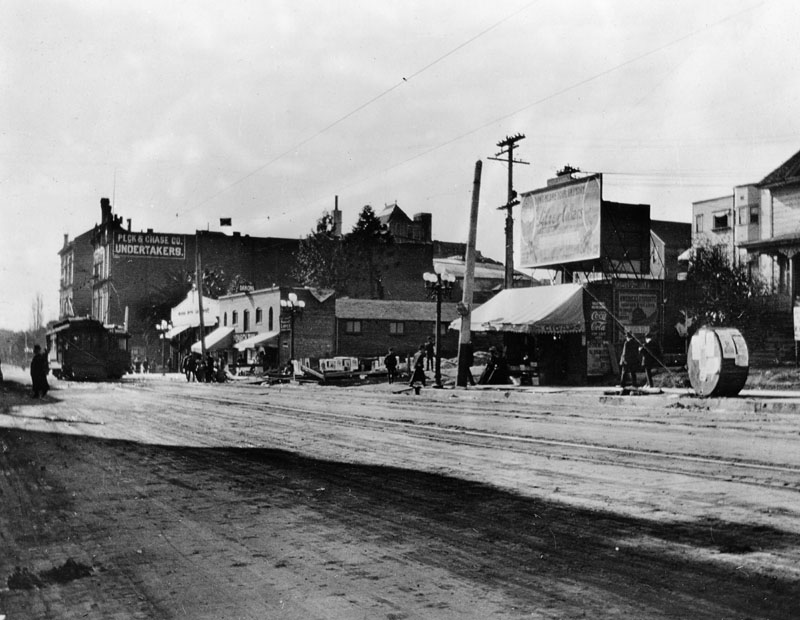 |
|
| (1905)^ - A large, wooden cable wheel plastered with posters stands at the ready on Hill St. looking south from 4th. To the left, a streetcar passes in front of a dance club. The sign on the building behind is for "Peck & Chase Co., Undertakers". Although tracks for the streetcars are laid, the street is unpaved. |
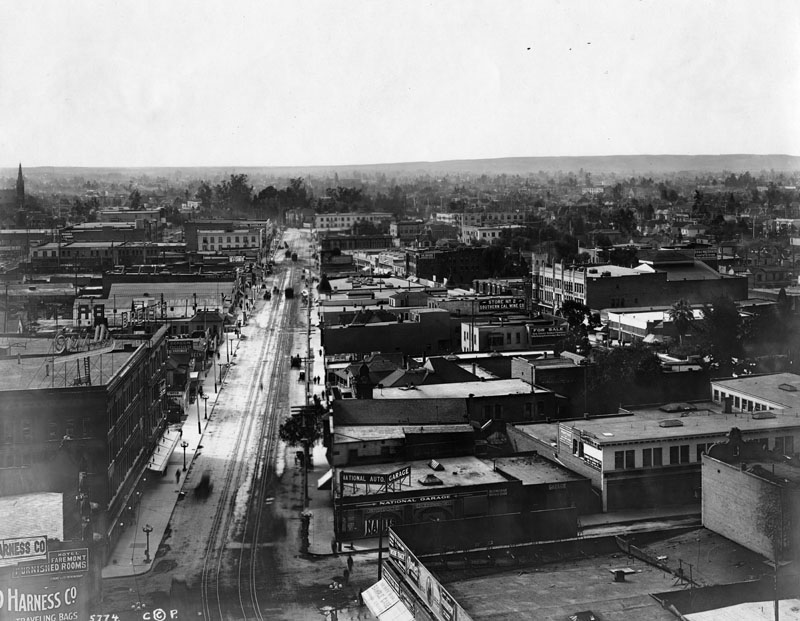 |
|
| (1905)^ - Panoramic view of Main Street, looking south from 7th Street. At left is the Hotel Faremont, next to which is Overall's, Brent's, followed by a hardware, Hunger's Laundry, a sign shop, and Hotel Cadillac. At right is National Auto. Garage, a real estate office and other buildings. Southern California Wine Co. store no. 2 is seen on Spring Street, angling in at right, which joins Main in the distance. |
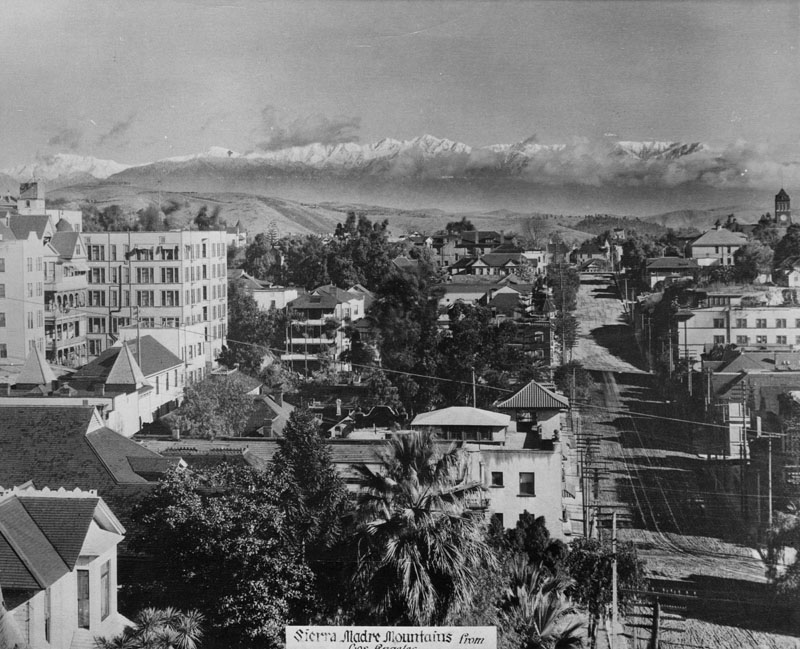 |
|
| (ca. 1905)^ - View from the 200 block of South Olive St. on Bunker Hill looking northeast towards Sierra Madre and the snow-capped San Gabriel Mountains. Although the background hills have few trees, the city is a forest with palms, evergreen, and deciduous trees interspersed among the buildings. The long building behind the palm fronds (foreground) is the Mission Hotel/Apartments on the southwest corner of 2nd St. and Olive. The two larger structures, left, are rear views of the Richelieu and Melrose hotels on Grand Avenue. The Los Angeles High Schooltower is on the far right at the top of the picture. Although utility lines are in, the streets are still unpaved. |
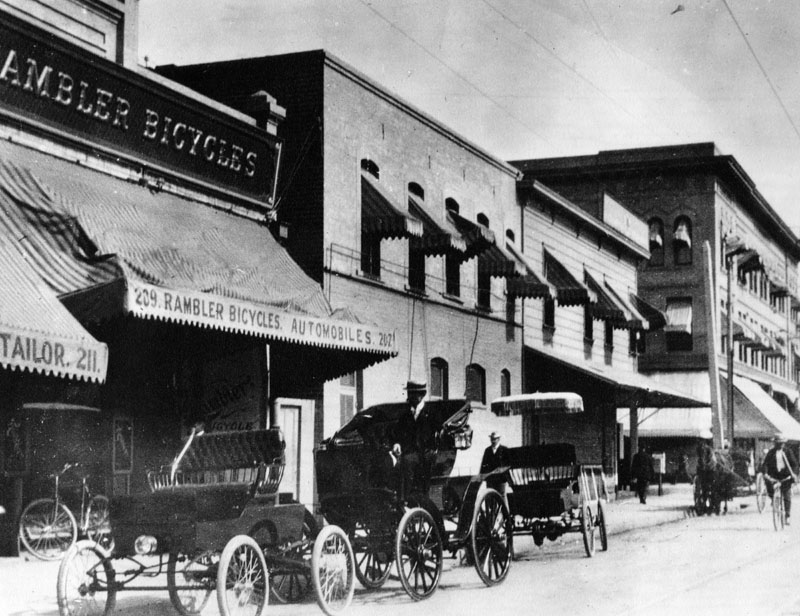 |
|
| (1905)^ - Three cars are parked in front of Rambler Bicycles at 207-209 W. 5th St. near Spring. |
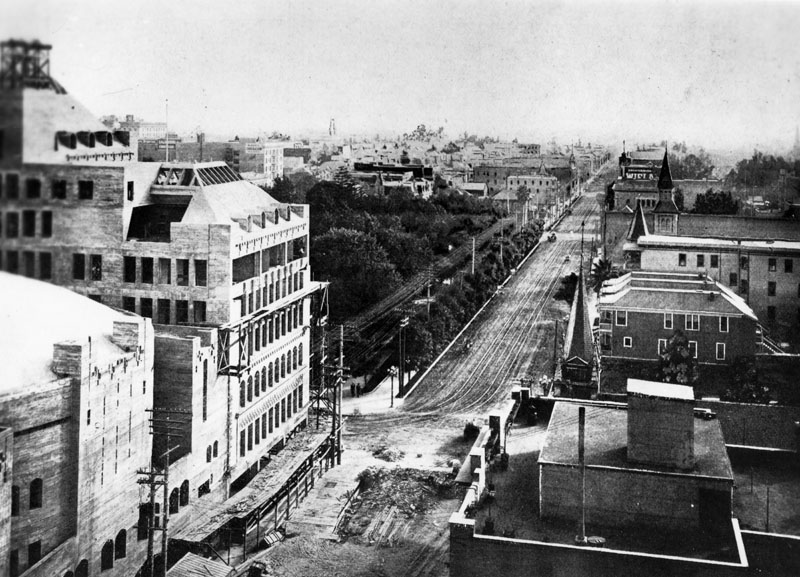 |
|
| (1905)^ - Panoramic view of 5th and Olive Streets, looking south in 1905. Central Park (later Pershing Square) is seen, and there are churches at right. At left the Auditorium Building is under construction. |
* * * * * |
Broadway
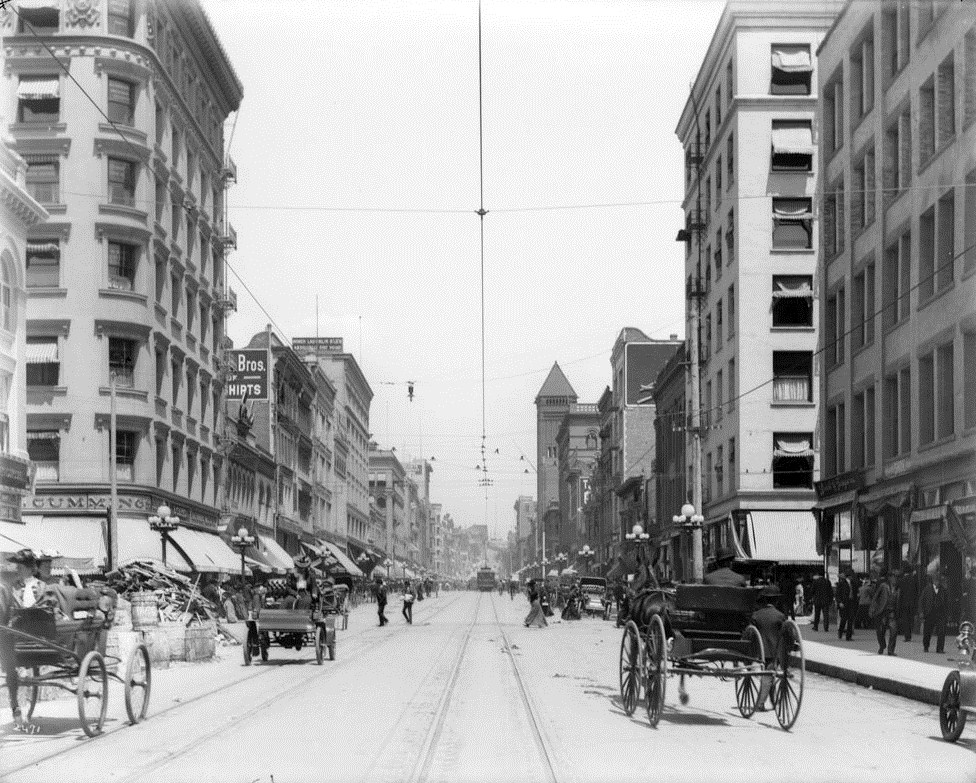 |
|
| (1905)^^ - View looking north on Broadway from Fourth Street. Horse-drawn carriages can be seen on both sides of Broadway. On the left, heading south on Broadway, a woman is behind the stick (no wheel) of an early model car. Ornate multi-lamp streetlights adorn both sides of the street. |
Historical Notes The tall tower in the distance is the Old City Hall, located at 226 Broadway. It was LA’s 3rd City Hall. Built in 1888, it stood until the current City Hall was completed in 1928.^ |
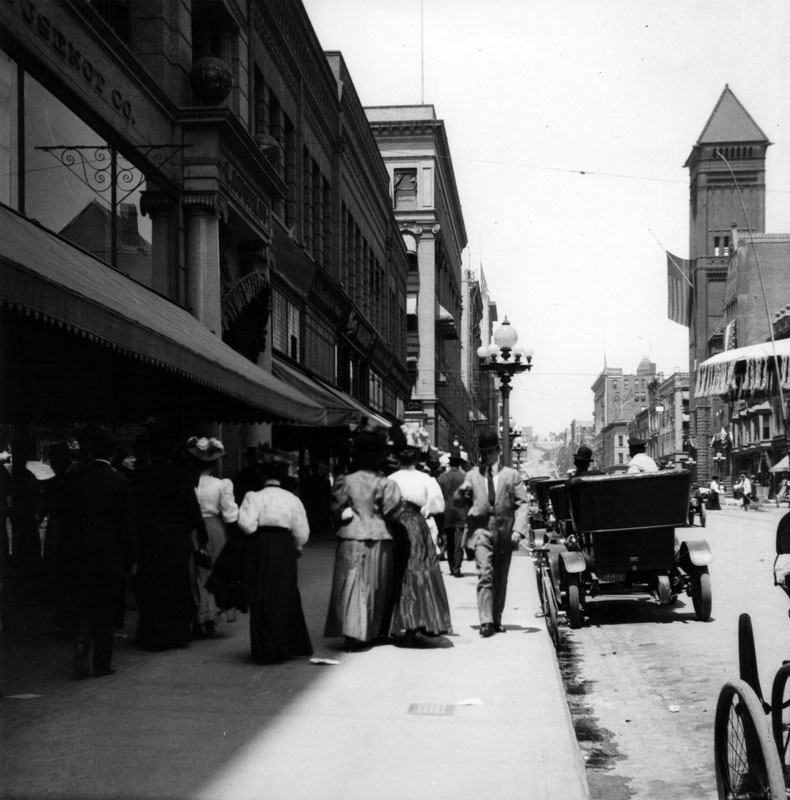 |
|
| (ca. 1905)^ - This photo shows numerous pedestrians walking along Broadway near Second Street in Downtown L.A. The women can be seen wearing long skirts, long sleeved blouses and/or tapered jackets, and all are wearing hats. The gentlemen are dressed in 2-piece suits and all of them can be seen wearing bowler hats as well. Several open cars are parked along the street. City Hall can be seen in the background across the street. |
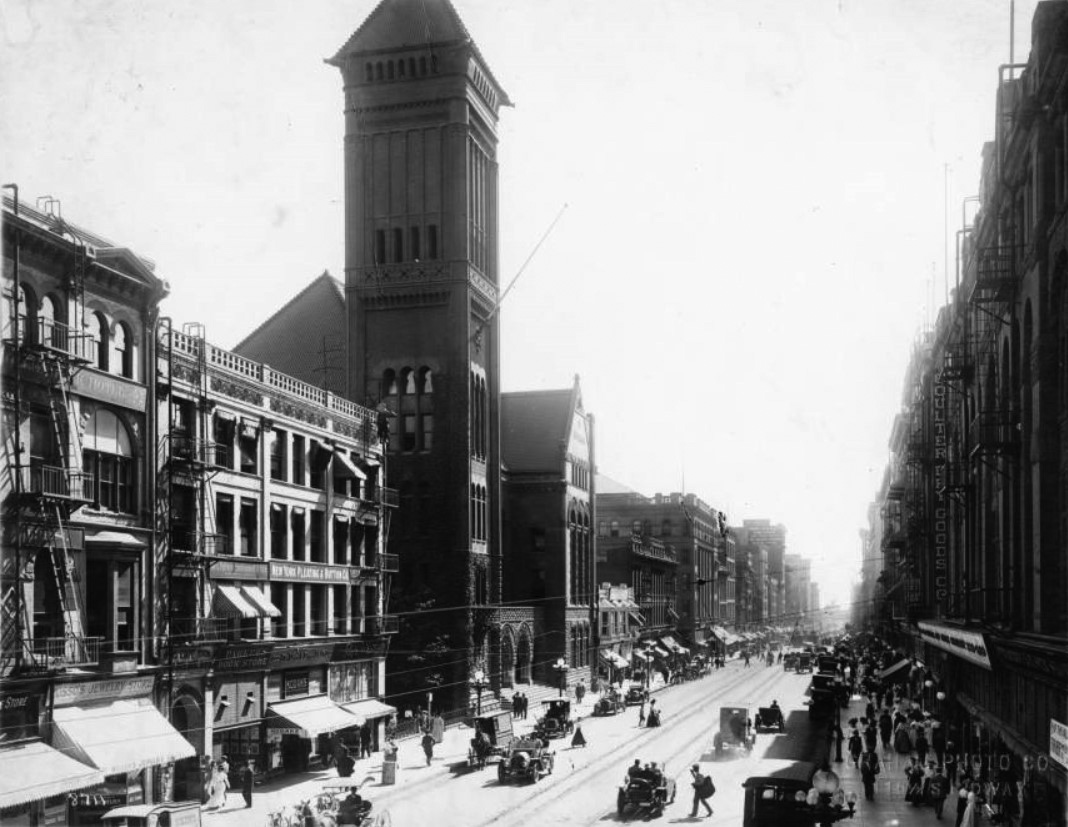 |
|
| (ca. 1905)^ - View looking south on Broadway between 2nd and 3rd streets showing the old Los Angeles City Hall . Early model cars are seen throughout and streetcar tracks run up and down Broadway. |
 |
|
| (ca. 1905)^ - Looking south on Broadway between Second Street and Third Street, showing the old Los Angeles City Hall, ca.1905. The city hall building is across the street at center and is identified by a massive rectangular tower. There are other tall buildings on both sides of the street, most between two and five stories high. The street is paved and is divided by streetcar tracks in the middle. Several early-model automobiles can be seen on the road, and many pedestrians are walking along the sidewalks.; The Bradbury Building (1893) can be seen farther down the left side of the street at the intersection of Third and Broadway (304 S. Broadway). It is quite likely the only extant structure of all those pictured in this photo.; Legible signs include, from left to right: "Hotel", "Russo's Jewelry Store Branch of Naples, Italy", "Parker's Book Store", "Mrs. Patten's Employment Office", "New York Pleating & Button Co.", " The Merick Reynolds Co.", "Kodaks", "Pig 'n Whistle", and "Coulter Dry Goods Co. |
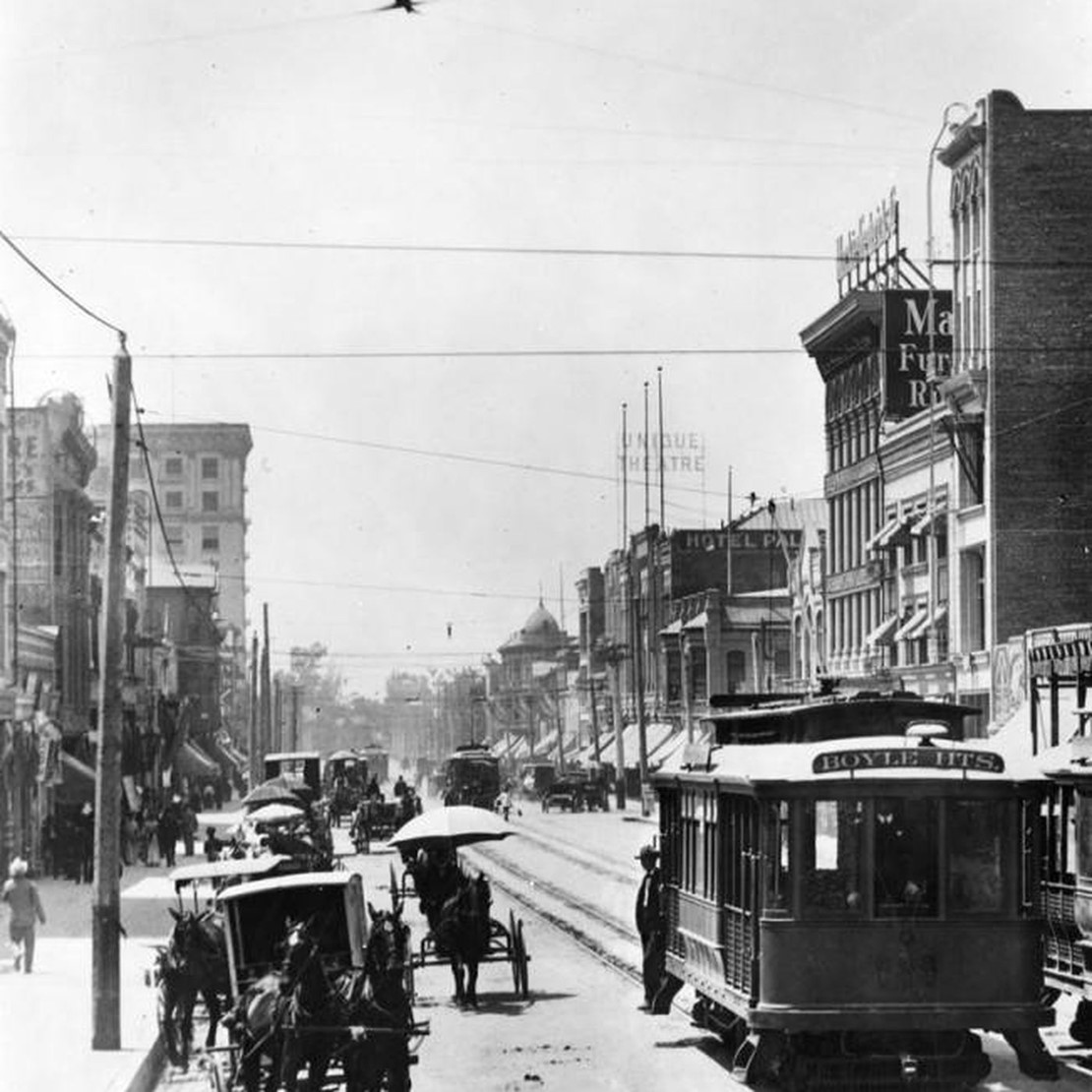 |
|
| (ca. 1905)* - Looking south on Broadway from 5th Street. Pacific Electric "red cars" share the street with horse carts. The sign on the electric car is marked "Boyle Hts." |
Then and Now
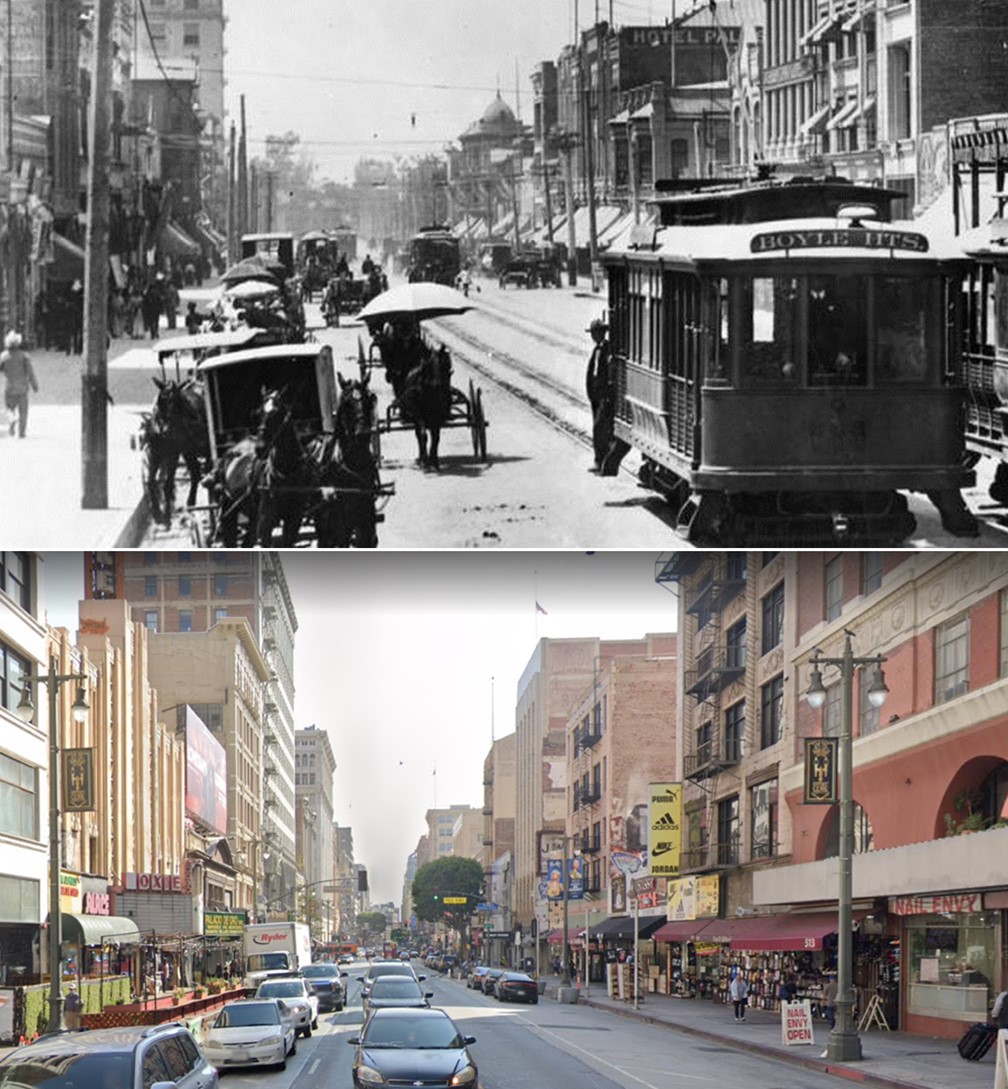 |
|
| (1905 va, 2021)* - Looking south on Broadway from near 5th Street. Photo comparison by Jack Feldman. |
* * * * * |
Hill and 4th Street (Looking East)
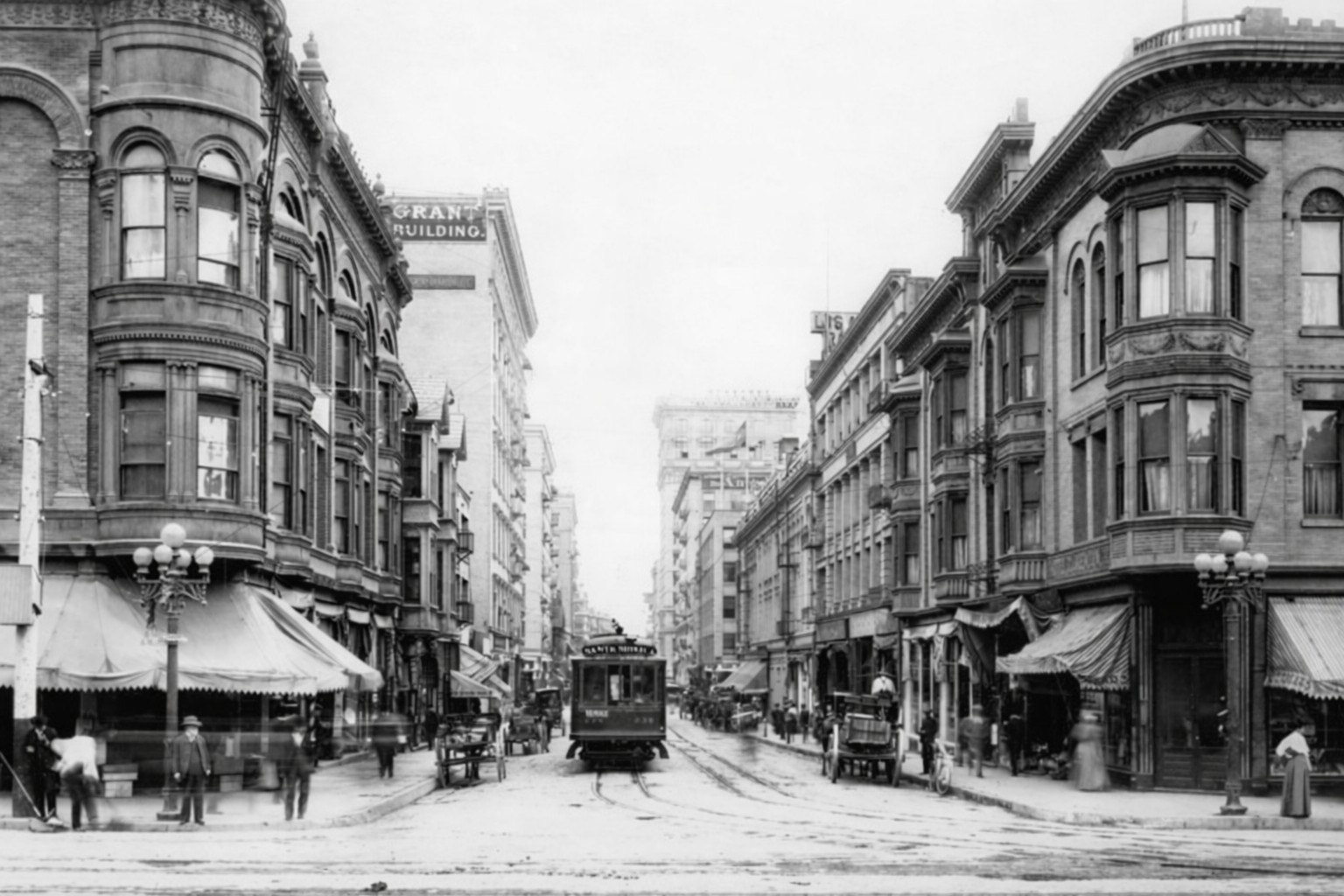 |
|
| (ca. 1900)* - Looking East on 4th Street at Hill Street. Photo enhancement by Jack Feldman. |
Historical Notes This view shows Fourth Street at the edge of Los Angeles’ most active downtown district at the turn of the century. Hill Street marked the transition between the commercial core to the east and the residential heights of Bunker Hill to the west. Streetcars and horse traffic shared the roadway, while awnings, shopfronts, and upper floor rooms made these blocks busy from morning into the evening. By 1900, Los Angeles was no longer a small town with a few standout buildings. It was becoming a true city, with growing retail, offices, hotels, and entertainment clustered close together. Intersections like Hill and Fourth were valuable because they captured through traffic from several directions, and because they sat within easy walking distance of Broadway’s rising shopping district and the civic center farther north. |
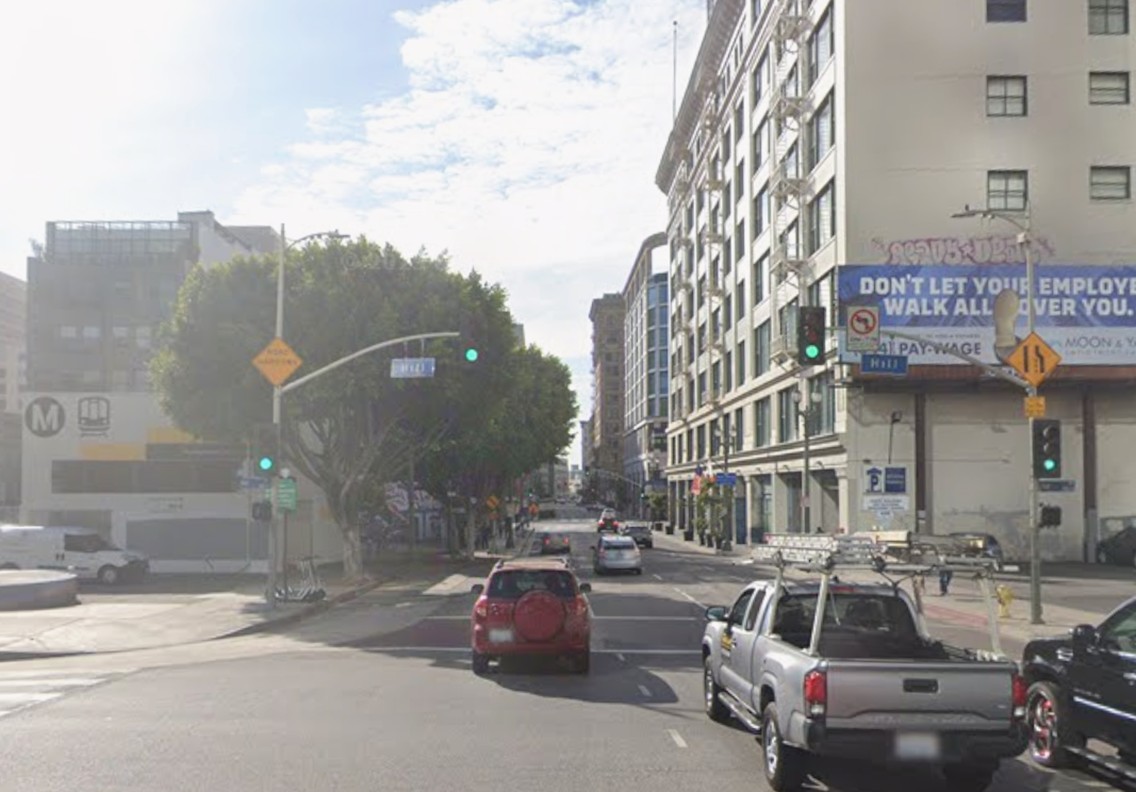 |
|
| (2022)* - Contemprary view looking east on 4th Street at Hill Street. |
Historical Notes The modern view shows the same corridor as a fully built out downtown street shaped by automobiles, signals, and mid and high rise construction. The street alignment remains familiar, but the scale is larger and the streetscape is more regulated. Where earlier storefronts and awnings once dominated the scene, the modern block reads as a mix of residential, commercial, and institutional uses, layered over many decades of redevelopment. This location also reflects a long pattern in downtown Los Angeles: constant reinvention on the same street grid. Even when individual buildings change, the old paths of movement remain. Fourth Street still works as a connector between Broadway and Hill, and Hill still functions as a boundary line between the historic core and the slopes that once held Bunker Hill’s homes. |
Then and Now
 |
|
| (1900 vs 2022)* - Looking east on 4th Street at Hill Street. Photo comparison by Jack Feldman. |
Historical Notes The 1900 image captures a street that still feels open and human scaled, even as it is clearly urban. Transportation is mixed and slower, and the street has a softer edge created by awnings, small businesses, and frequent doorways. The scene belongs to a period when downtown commerce depended on foot traffic and short streetcar rides, and when many people lived close enough to walk to work and shopping. In the modern view, the street has a heavier, more engineered character. Paving, lane markings, signals, and larger buildings reflect a city built around the automobile and shaped by later waves of growth. What makes the comparison compelling is continuity amid change: the same eastward view line, the same intersection geometry, and the same role of Fourth Street as a connector through the downtown fabric. |
* * * * * |
Hill and 4th Street (Looking North)
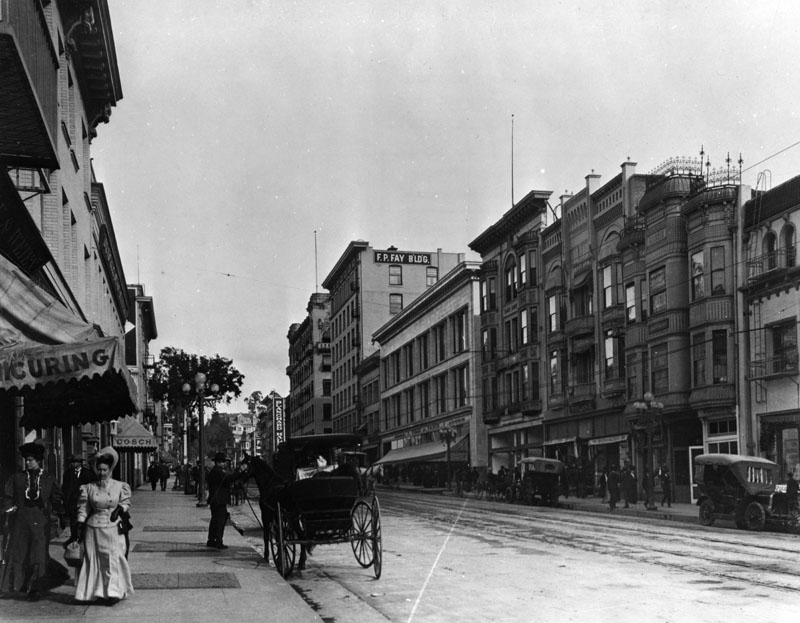 |
|
| (1905)* - View of Hill Street at 4th looking north. The F P Fay Building is in the center, and the Ville de Paris department store is the second building to the right. |
Historical Notes This 1905 view captures Hill Street at a lively moment when animals, pedestrians, and retail all shared the same space. A man pauses with a horse while women move under a protective awning, a common feature in downtown Los Angeles before air conditioning and modern street design. The street feels intimate, but the architecture and signage show a confident business district already competing for attention. The F P Fay Building anchors the scene as a prominent commercial structure, and it remained a recognizable downtown landmark for decades before being demolished in 1990. The Ville de Paris connection points to the larger retail world expanding just a short walk away, including the Homer Laughlin Building complex that housed Ville de Paris showrooms and sales floors during the early 1900s. Together, these buildings and businesses show how Hill Street was becoming part of a wider downtown shopping and office environment, not just a local street of small storefronts. |
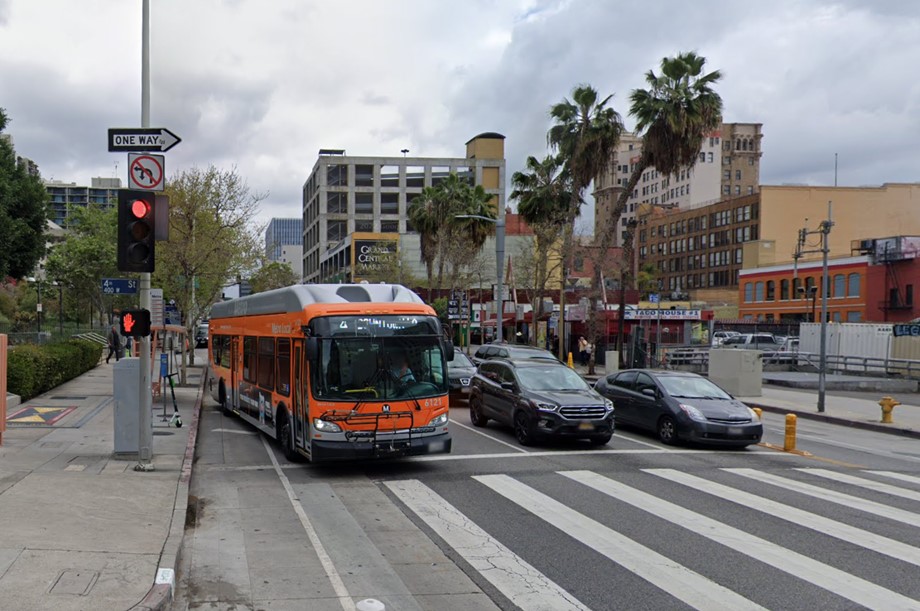 |
|
| (2021)* - Contemporary view looking north on Hill Street at 4th Street. |
Historical Notes The modern view shows Hill Street as a wide, regulated urban corridor, shaped by traffic flow and larger building footprints. The earlier awnings, open sidewalks, and curbside activity have largely been replaced by a cleaner but more standardized streetscape. Where the 1905 scene is full of small scale details, the modern scene tends to read in larger blocks, with fewer visual cues at the level of the pedestrian. Even so, the basic role of the street remains the same. Hill still acts as a major north south route through downtown, and Fourth remains a key cross street. The comparison also highlights what downtown Los Angeles tends to do over time: older mid rise commercial buildings give way to newer construction, while the street grid and the daily need for movement and commerce continue without interruption. |
Then and Now
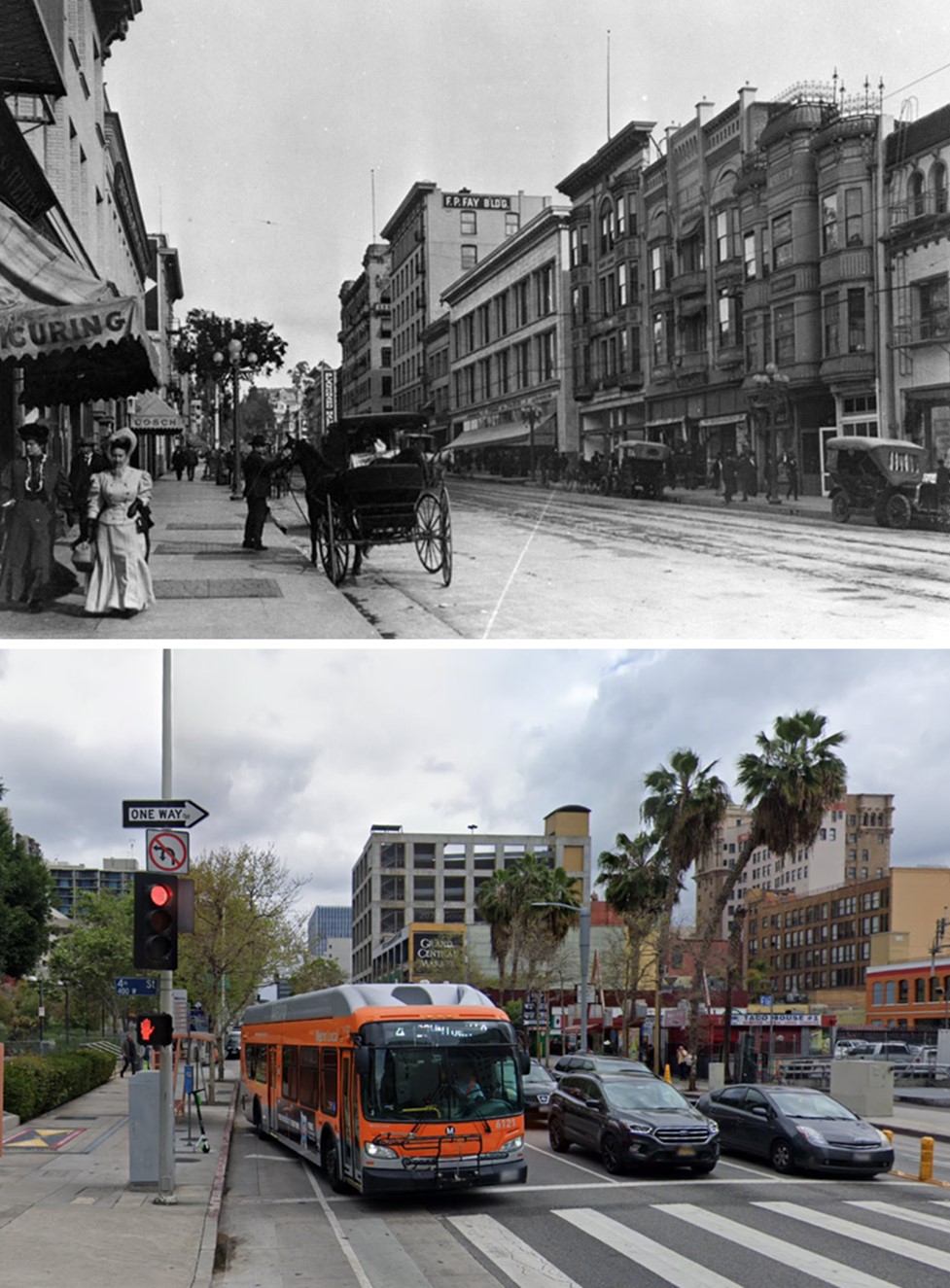 |
|
| (1905 vs 2021)* - Looking north on Hill Street at 4th Street. Photo comparison by Jack Feldman. |
Historical Notes The 1905 side of the comparison is striking because it shows a city that is urban, but still personal. The street belongs to the pedestrian and the merchant. The awnings suggest a shopping street designed for walking, stopping, and browsing, and the presence of horses and casual street level interaction makes the scene feel slow and socially connected. The modern side shows the same place as a faster, more controlled environment. Cars, signals, and larger buildings dominate. What makes this comparison especially compelling is that the location is unmistakable even when the architecture changes. The intersection still functions as a downtown hinge point, and the before and after view captures the biggest story of twentieth century Los Angeles in one glance: the shift from a walkable streetcar city to an auto oriented metropolis. |
* * * * * |
Spring and 2nd Street (Looking North)
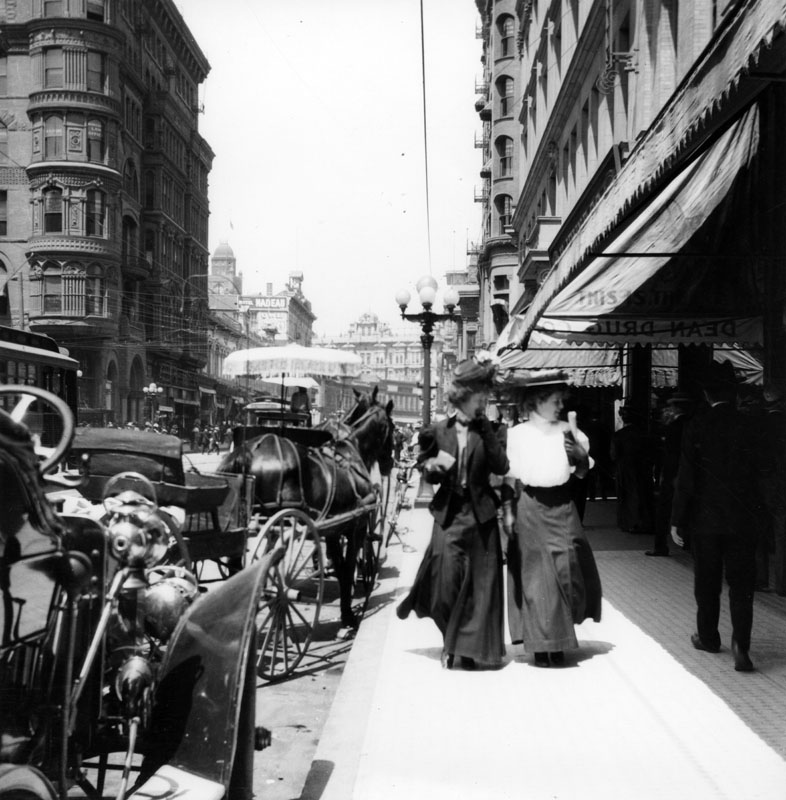 |
|
| (ca. 1905)^ - Two women are walking along Spring Street south of 2nd Street with the Bryson-Bonebrake Block seen on the left (NW corner). It appears that either the man walking by or something in the store window has caught their attention. Several open cars and horse-drawn carriages are seen parked along the street. Note the ornate streetlight behind the women. Click HERE to see more in Early Los Angeles Street Lights |
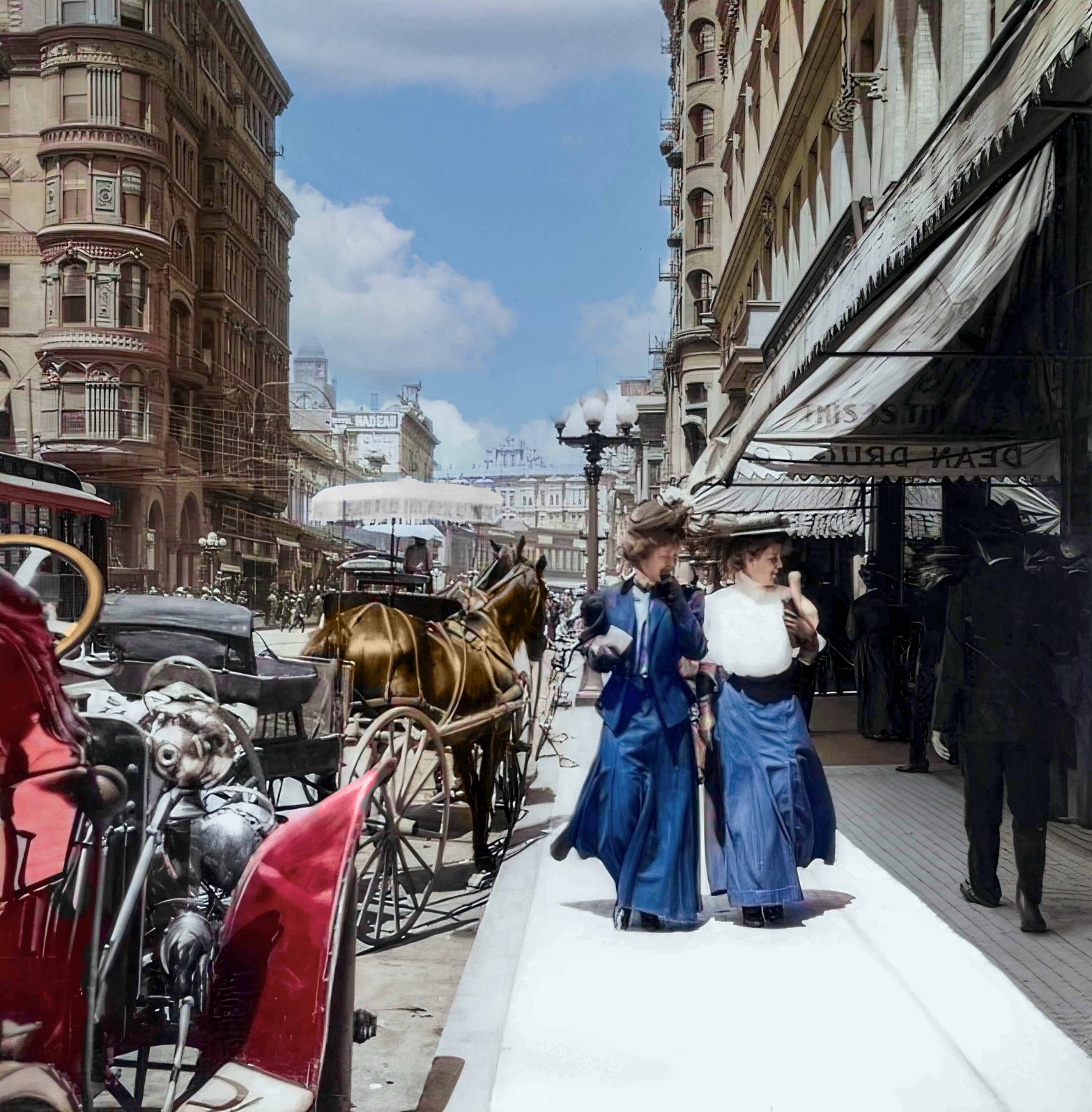 |
|
| (ca. 1905)^ - Two women are walking along Spring Street south of 2nd Street with the Bryson-Bonebrake Block seen on the left (NW corner). It appears that either the man walking by or something in the store window has caught their attention. Several open cars and horse-drawn carriages are seen parked along the street. Note the ornate streetlight behind the women. Click HERE to see more in Early Los Angeles Street Lights. Image enhancement and colorization by Richard Holoff. |
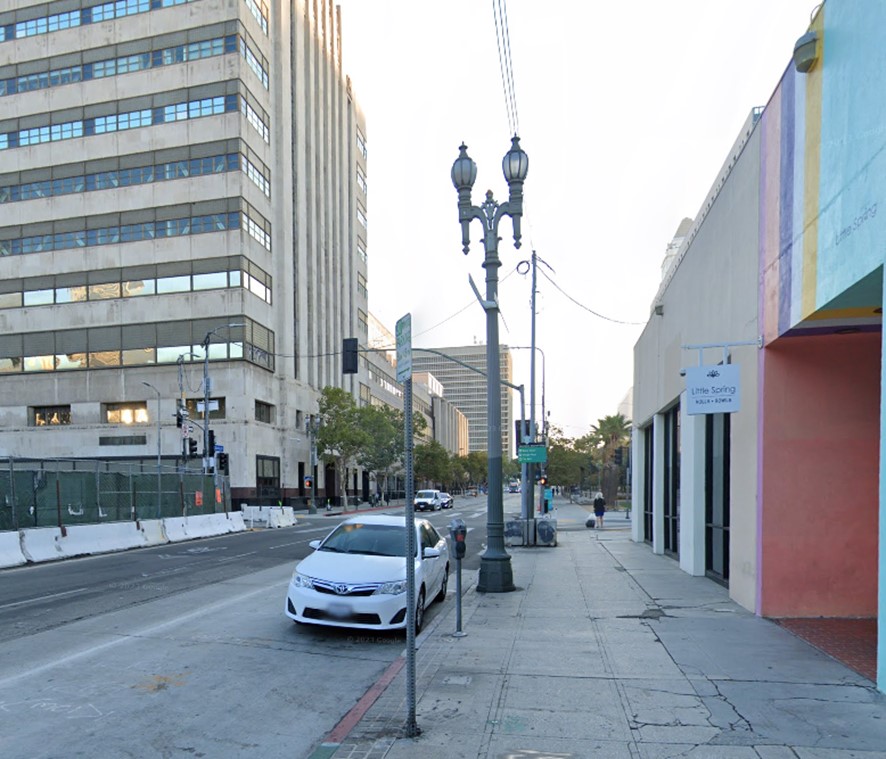 |
|
| (2022)* - Looking north on Spring Street toward 2nd Street. |
Then and Now
 |
|
| (1905 vs 2022)* - Looking north on Spring Street toward 2nd Street. Photo comparison by Jack Feldman. |
Spring and 6th Street
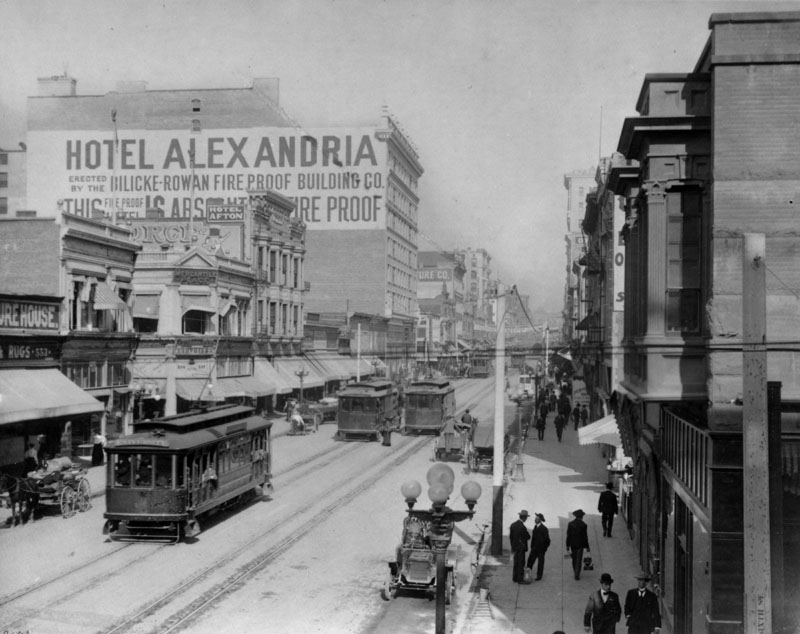 |
|
| (1906)^ - View looking north on Spring Street from 6th St. to the Hotel Alexandria located on the southwest corner at 5th St. |
Spring and 5th Street
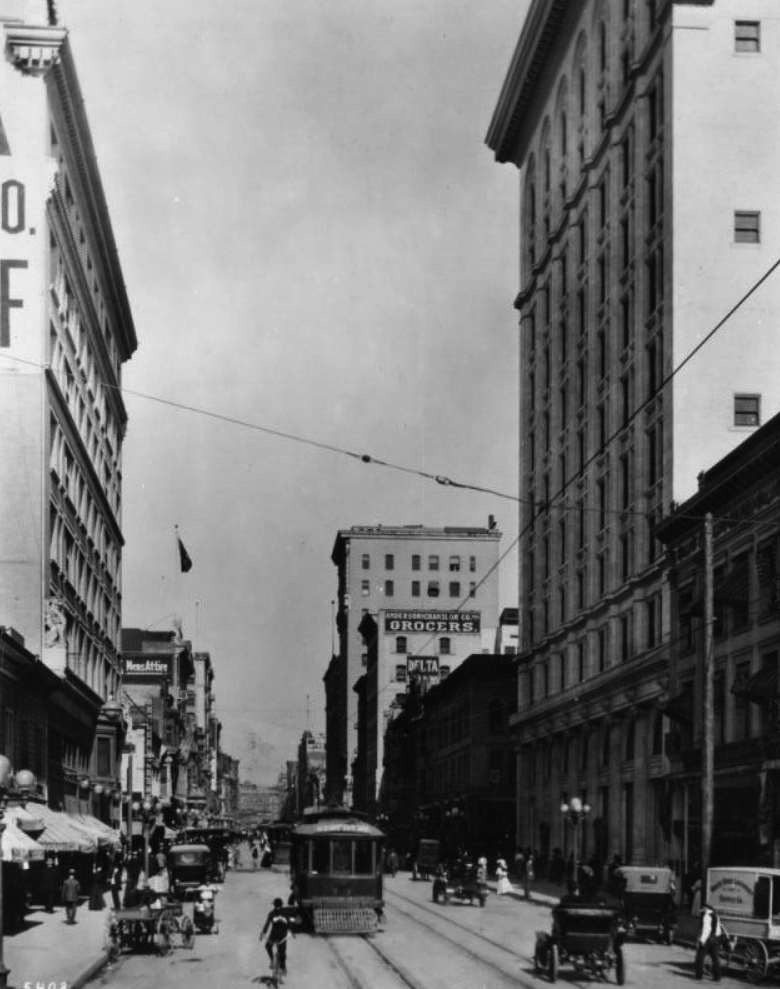 |
|
| (1905)^ – View looking north on Spring Street with the Alexandria Hotel partially seen at the southwest corner of Spring and 5th St. (left side of picture). On the right (east side) sits the tall Security Building. A cyclist shares the road with horse-drawn wagons, early model cars and streetcars. |
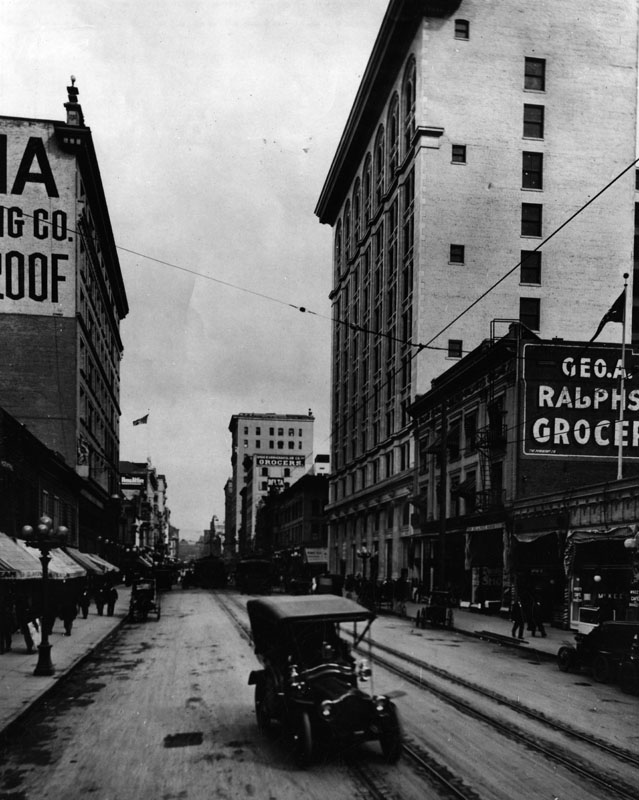 |
|
| (1905)^ - An early view of Spring St. with the Alexandria Hotel partially seen at the southwest corner of Spring and 5th St. (left side of picture). On the right (east side) George A. Ralphs Grocer sits below the taller Security Building. |
Historical Notes Ralphs Grocery Company was founded in 1873 by George Albert Ralphs with the original store being located at Sixth and Spring Streets. The company employed notable architects in designing its stores.*^ Click HERE to see an 1886 photo of George Ralphs standing in front of his original store in the Early LA Buildings (1800s) Section. |
 |
|
| (n.d.)^ - A man is standing next to a delivery truck of Ralphs Grocery Co. A sign on the side says, "Ralphs Grocery Co. Sells for Less." |
* * * * * |
Spring and 7th Street
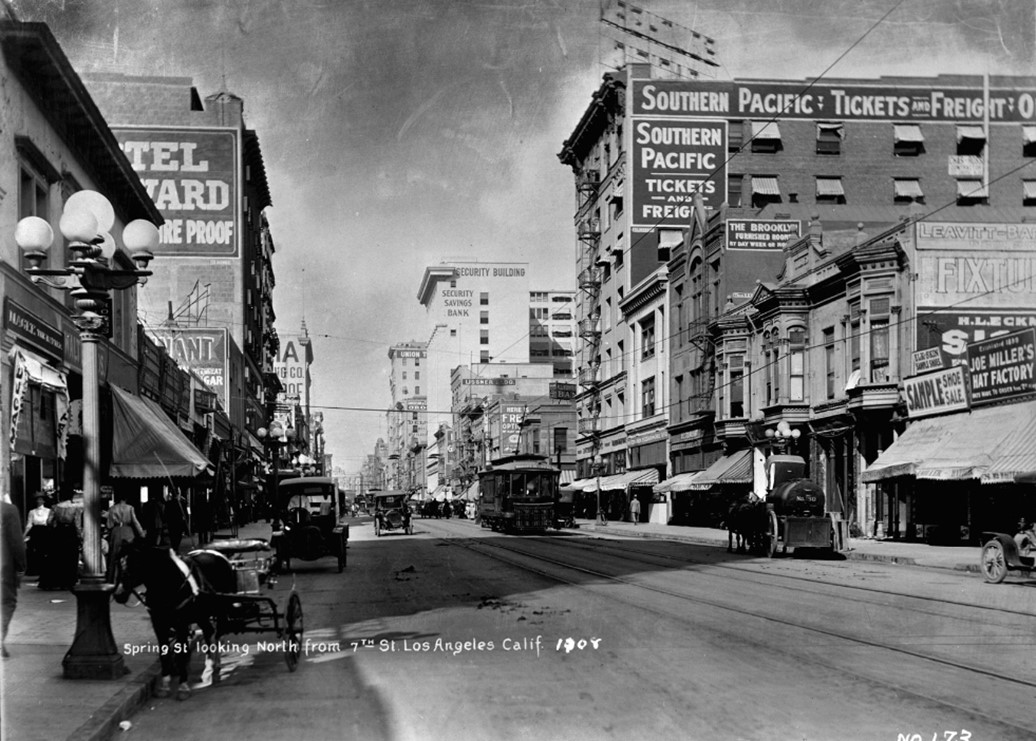 |
|
| (1908)* - Spring Street looking north from 7th Street. Note the horse-drawn wagon parked at the curb under an ornate 5-globe streetlight. |
Historical Notes Click HERE to see more on the early 5-Globe streetlights seen above. |
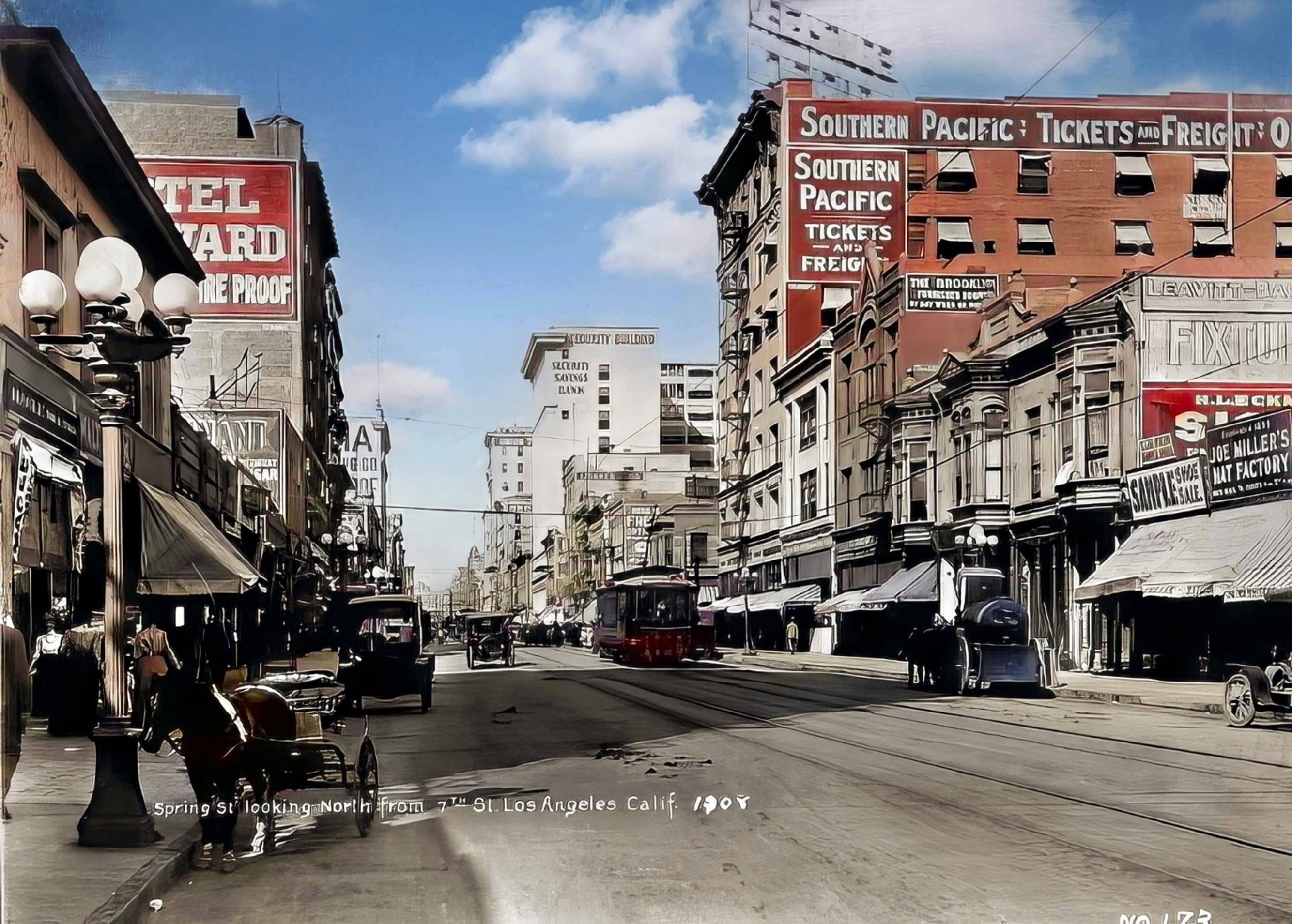 |
|
| (1908)* - Spring Street looking north from 7th Street. Note the horse-drawn wagon parked at the curb under an ornate 5-globe streetlight. Image enhancement and colorization by Richard Holoff. |
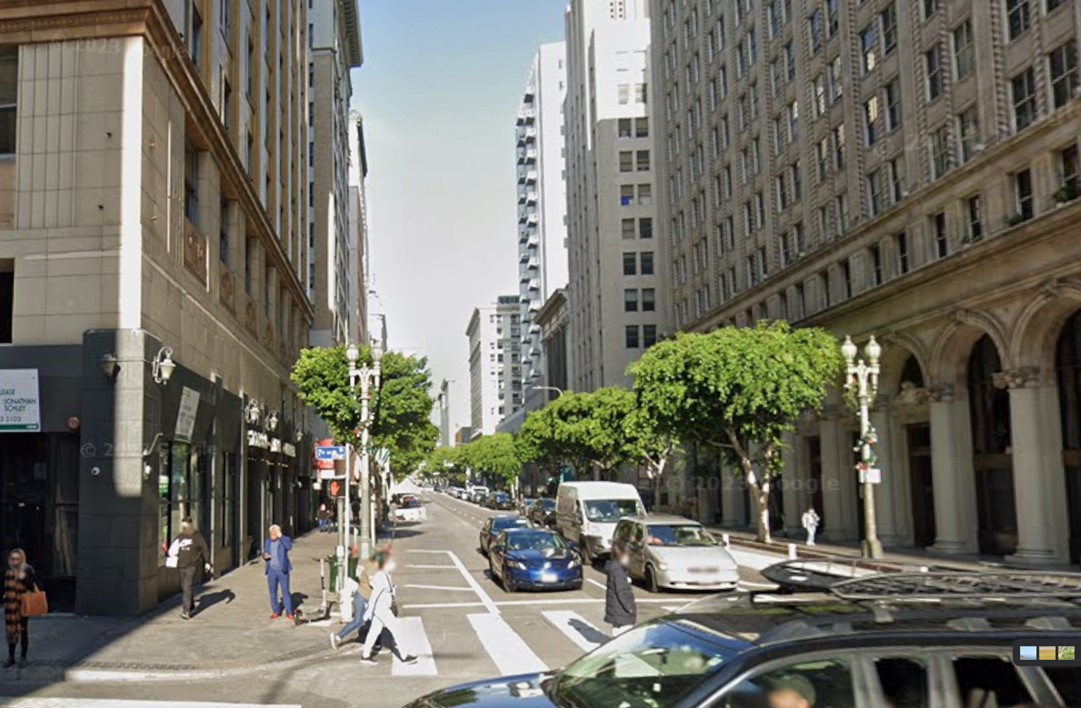 |
|
| (2022)* - Looking north on Spring Street at 7th Street in DTLA. |
Then and Now
 |
|
| (1908 vs 2022)* - Looking north on Spring Street at 7th Street in DTLA. Photo comparison by Jack Feldman. |
* * * * * |
7th and Spring
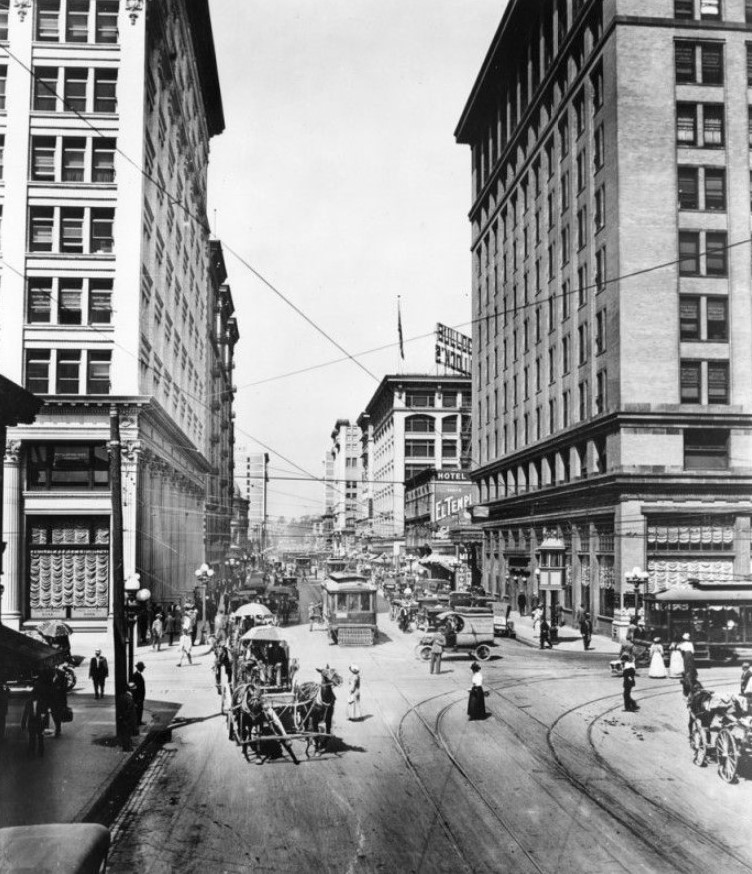 |
|
| (1915)* - A view of 7th Street as it crosses Spring Street, looking west. Horse-drawn wagons, electric streetcars, and early autos share the road in a bustling downtown scene. On the far right in the distance, perched atop its building at 7th and Broadway, the Bullock’s Department Store sign marks the northern edge of a thriving retail corridor that would soon define Los Angeles shopping for decades to come. |
Historical Notes In 1915, the intersection of Spring and 7th Streets in downtown Los Angeles was a pivotal part of the city's expanding financial and commercial core. Spring Street was known as the "Wall Street of the West," hosting many of the city's banks and financial institutions, marked by early skyscrapers like the Continental Building. Meanwhile, Seventh Street was transitioning from agricultural and residential uses into a major commercial corridor, becoming an upscale shopping district distinct from Broadway. By the 1920s, Seventh Street had developed into a dense urban area with numerous office buildings and flagship department stores, reflecting Los Angeles’s rapid economic growth and architectural flourish in styles such as Beaux Arts. |
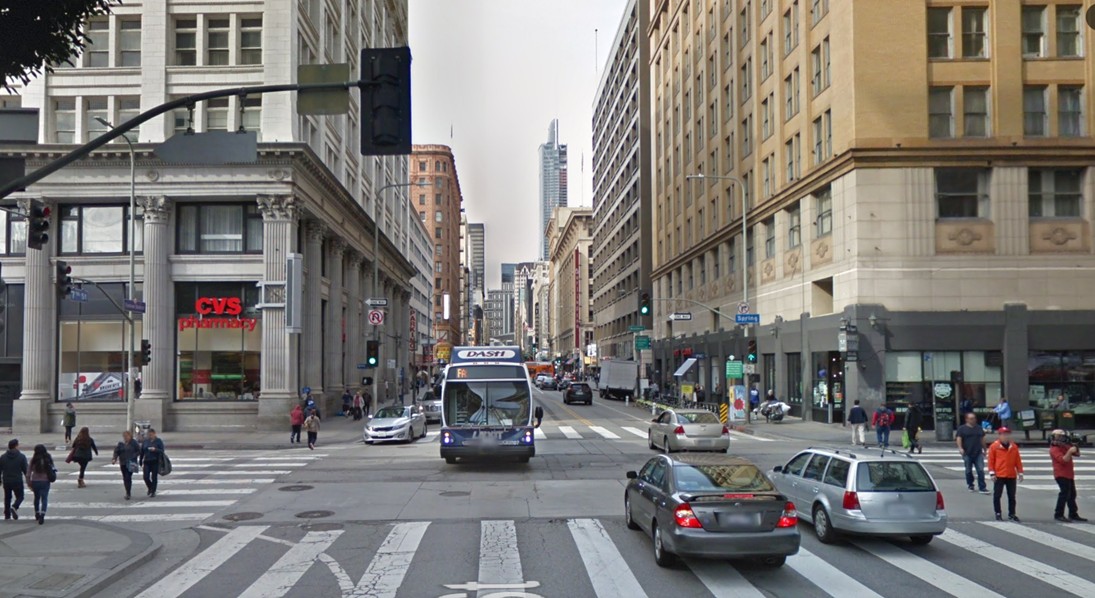 |
|
| (2017)* – Contemporary view of the intersection of 7th and Spring looking west, showing many of the same early 20th-century buildings still standing. The Hellman Building on the left now houses a CVS, and the street is shared by DASH buses, cars, and pedestrians. In the distance, the Wilshire Grand rises above a quieter but still active downtown streetscape. |
Historical Notes Today, the intersection of Spring and 7th Streets in downtown Los Angeles features many historic buildings that have been updated for new uses like housing and shops. The area has been improved with new bike lanes, sidewalks, street trees, and better lighting to make it safer and easier to get around. These changes are part of efforts to make downtown more accessible for people walking, biking, and using public transit. |
Then and Now
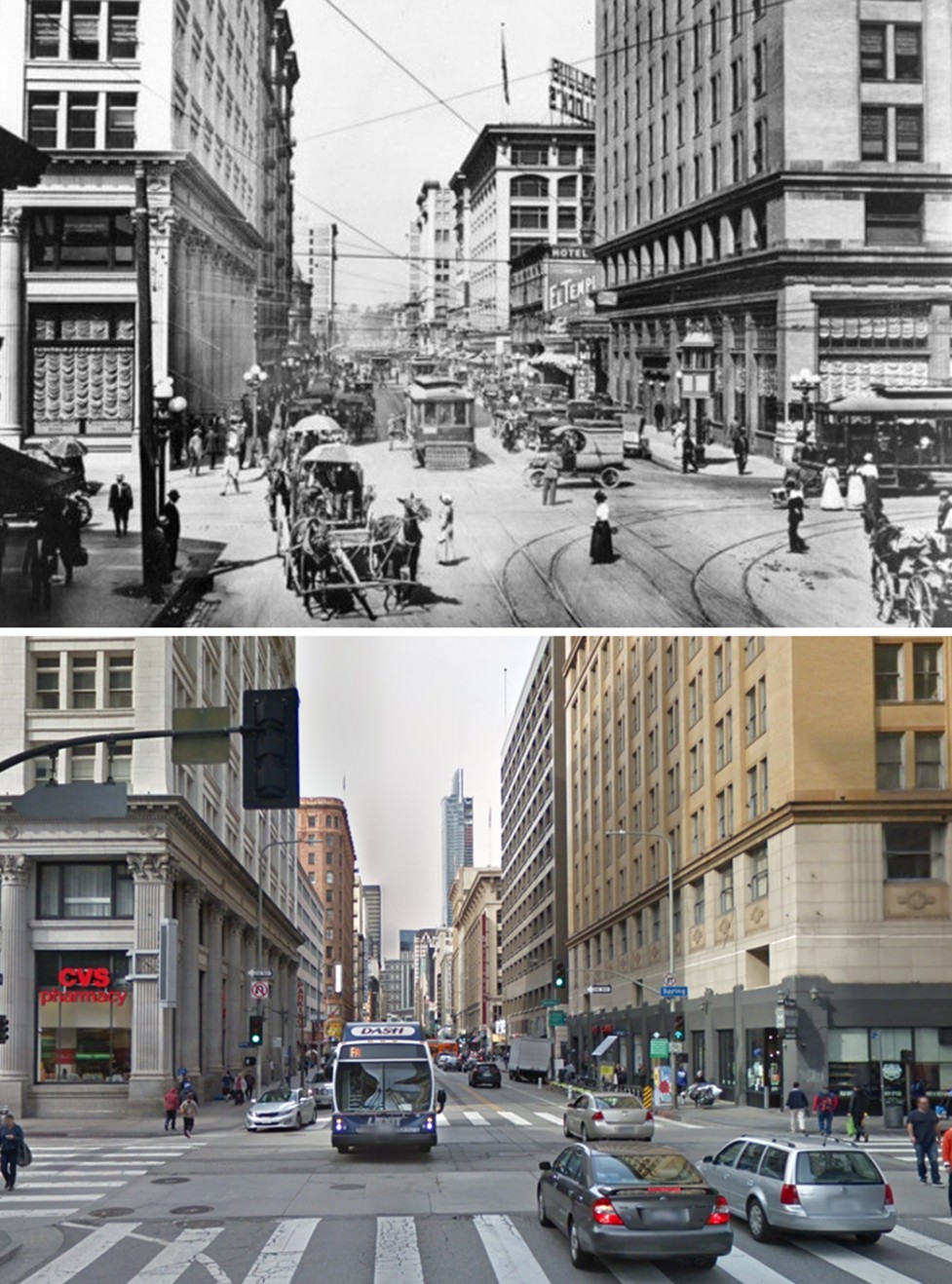 |
|
| (1915 vs 2017)* – Looking west on 7th Street at Spring Street in downtown Los Angeles. Photo conparison by Jack Feldman. |
Historical Notes From horse-drawn wagons and electric streetcars to buses and rideshares, this intersection has seen more than a century of change. Many buildings remain, but the street has lost some of the bustle—and a bit of its old vitality. |
* * * * * |
Fire Department - Hill and 16th Street (later renamed Venice Street)
 |
|
| (ca. 1905)^ - Firemen in their horse-drawn firewagons are seen outside of their station located at Hill and 16th (later renamed Venice Boulevard) streets. |
Hill and 5th Street
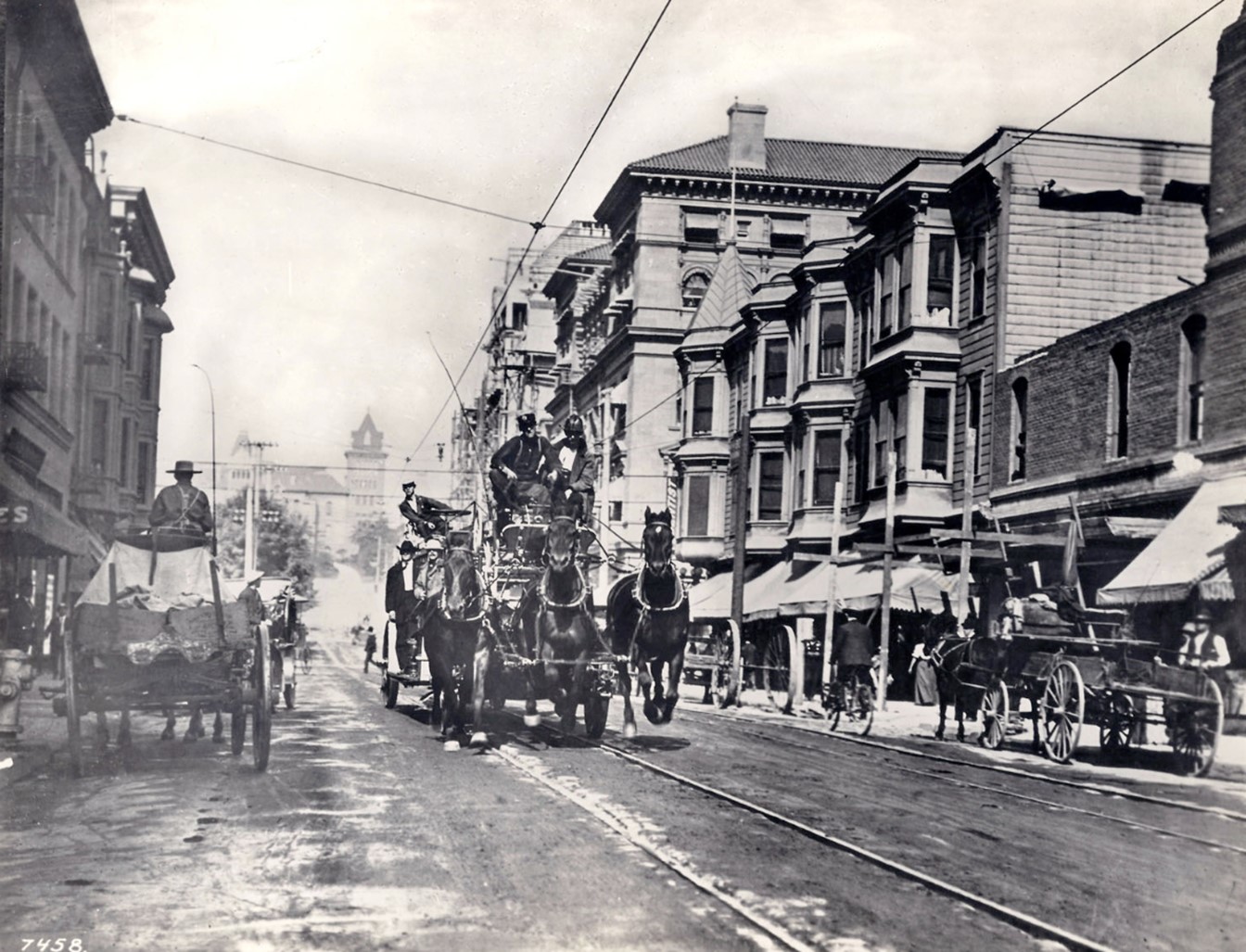 |
|
| (ca. 1906)* - A fire engine races east on 5th Street from Hill Street. The view is looking west. The prominent building in the background is the State Normal School. The building with awnings behind the fire engine is the California Club, at its 5th and Hill St. location, which it left in 1930. Photo by C. C. Pierce (2nd Image Source: LAPL).* |
Historical Notes The State Normal School later evolved into UCLA. Click HERE to see more in Early Views of the Normal School and UCLA. |
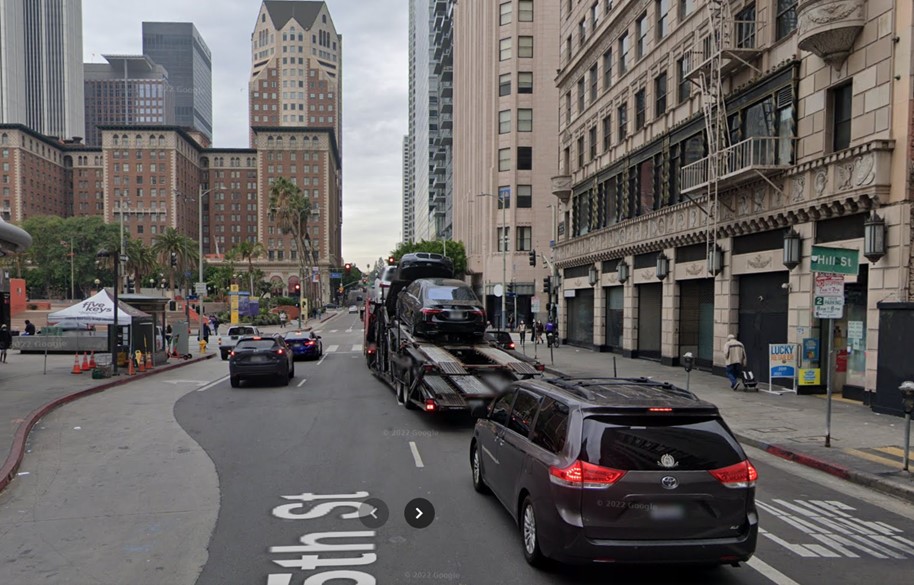 |
|
| (2021)* - Looking west on 5th Street toward Hill Street. |
Then and Now
Then_and_Now.jpg) |
|
| (1906 vs 2021)* - Looking west on 5th Street toward Hill Street. Photo comparison by Jack Feldman. |
Hill and 5th Street
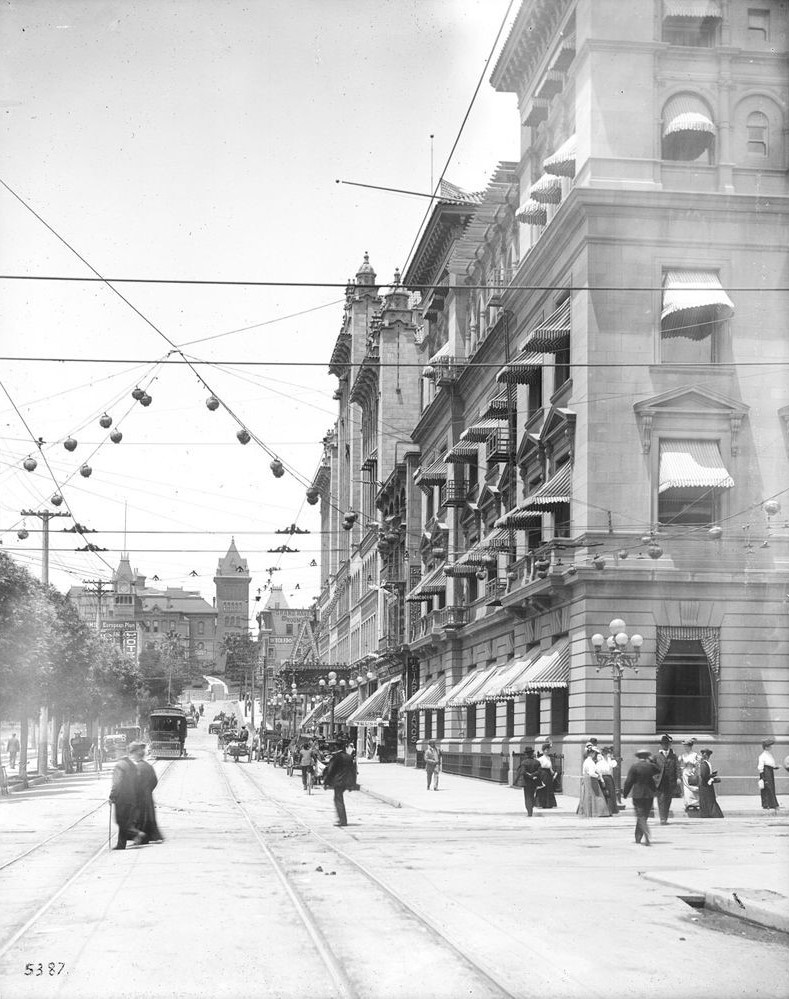 |
|
| (ca. 1910)* - Looking west on 5th Street at Hill Street in downtown Los Angeles. On the left is Central Park, renamed Pershing Square in 1918. In the distance the building with the tower is the State Normal School at Grand Avenue, where 5th Street originally dead-ended. After the State Normal School was demolished in 1924, 5th Street would be straightened and extended past Grand Avenue. The remaining school site became the location of the L.A. Central Library, which would be built in 1925. The building on the right with the awnings is the California Club. |
Historical Notes Note the beautiful ornate streetlight seen on the NW corner. These types of five-globe streetlights were originally installed on most streets in Downtown Los Angeles in the early 1900s, (except for Broadway which had the seven-globe lights). This particularly ornate model (called "Winslow") seemed to be limited to Hill Street and the streets adjacent to Pershing Square: the one block segments of 5th, Olive, and 6th. Today, the last of these poles are still being used as architectural features in the gardens and malls adjacent to City Hall. Click HERE to see more. |
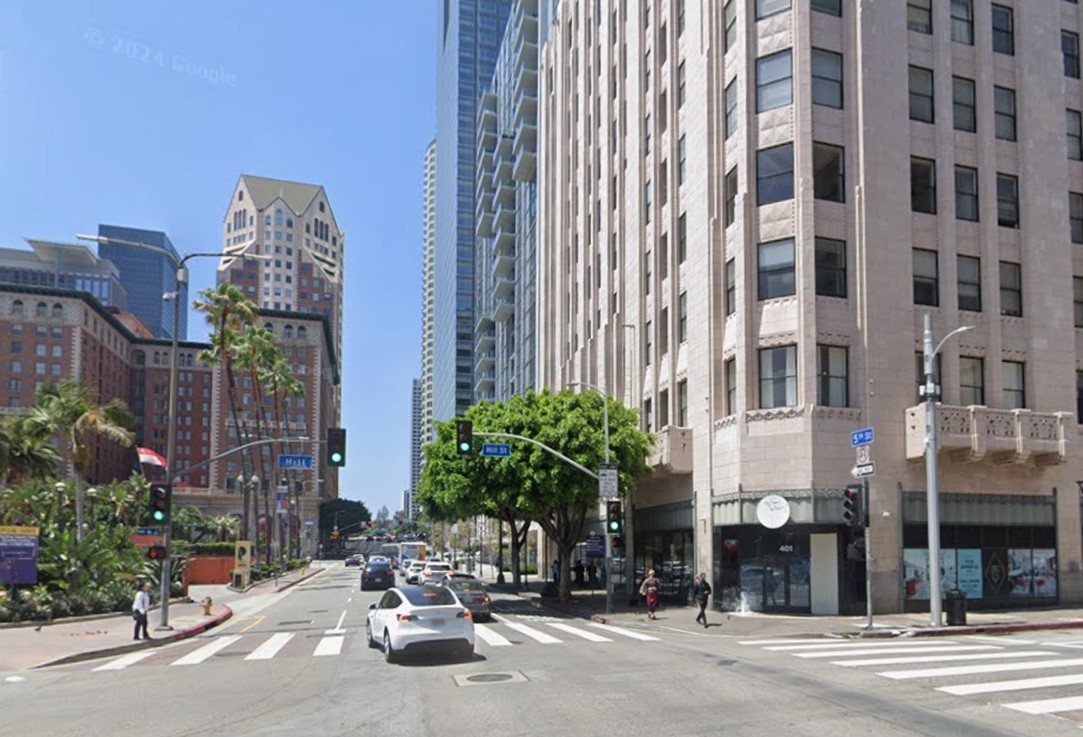 |
|
| (2024)* - Looking west on 5th Street at Hill Street with Pershing Square on the left. The Biltmore Hotel can be seen further back on the left. |
Then and Now
.jpg) |
|
| (1910 vs 2024)* - Looking west on 5th Street at Hill Street with Central Park (now Pershing Square) on the left. Photo comparison by Jack Feldman. |
Historical Notes The following is a chronology of name changes the park has seen before becoming Pershing Square: ◆ 1866 – La Plaza Abaja or "The Lower Plaza" ◆ 1867 – St. Vincent Park ◆ 1870 – Los Angeles Park ◆ 1886 – 6th Street Park ◆ 1890s- Central Park ◆ 1918 – Pershing Square |
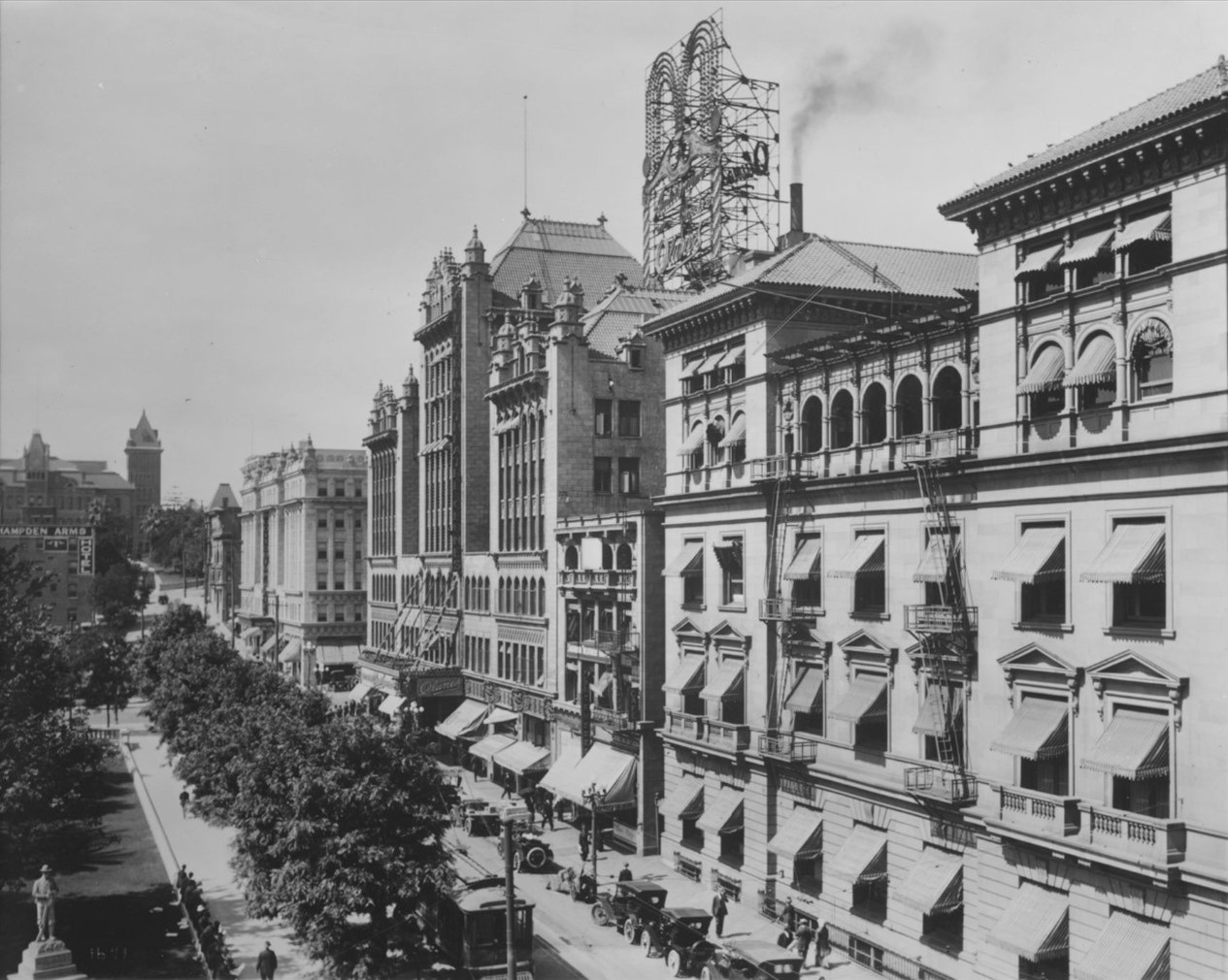 |
|
| (1915)* - Looking west on 5th Street toward Olive Street, with Central Park (later named Pershing Square) on the left. The famous Spanish-American War Soldier’s Monument stands at the lower-left corner of the park. This area was one of Los Angeles’ cultural and social hubs in the early 1900s. Several prominent buildings stand out, especially the Gothic-style Temple Auditorium (known at the time as Clune's Auditorium) with its oversized rooftop neon sign located on the northwest corner of 5th and Olive Street, and the California Club seen on the right on the northwest corner of 5th and Hill Street. |
Historical Notes The ornate theater, initially named Temple Auditorium, opened on November 7, 1906, with a performance of "Aida." Designed by Charles E. Whittlesey, it was the world's largest reinforced concrete structure at the time, featuring an Art Nouveau interior, a Spanish Gothic exterior, 2,700 seats, and the largest stage in the western U.S. In 1914, impresario William "Billy" Clune leased and transformed it into Clune's Auditorium, a pioneering movie palace known for elaborate prologues with music and dancers. Notably, it hosted the premiere of D.W. Griffith's "Birth of a Nation," with a full orchestra. Note: The Spanish-American War Soldier's Monument is still located in Pershing Square today. The monument, also known as the 7th Regiment Monument, remains the oldest piece of public art in the city and has been designated as Cultural-Heritage Monument No. 480 by the Los Angeles Cultural Heritage Commission. |
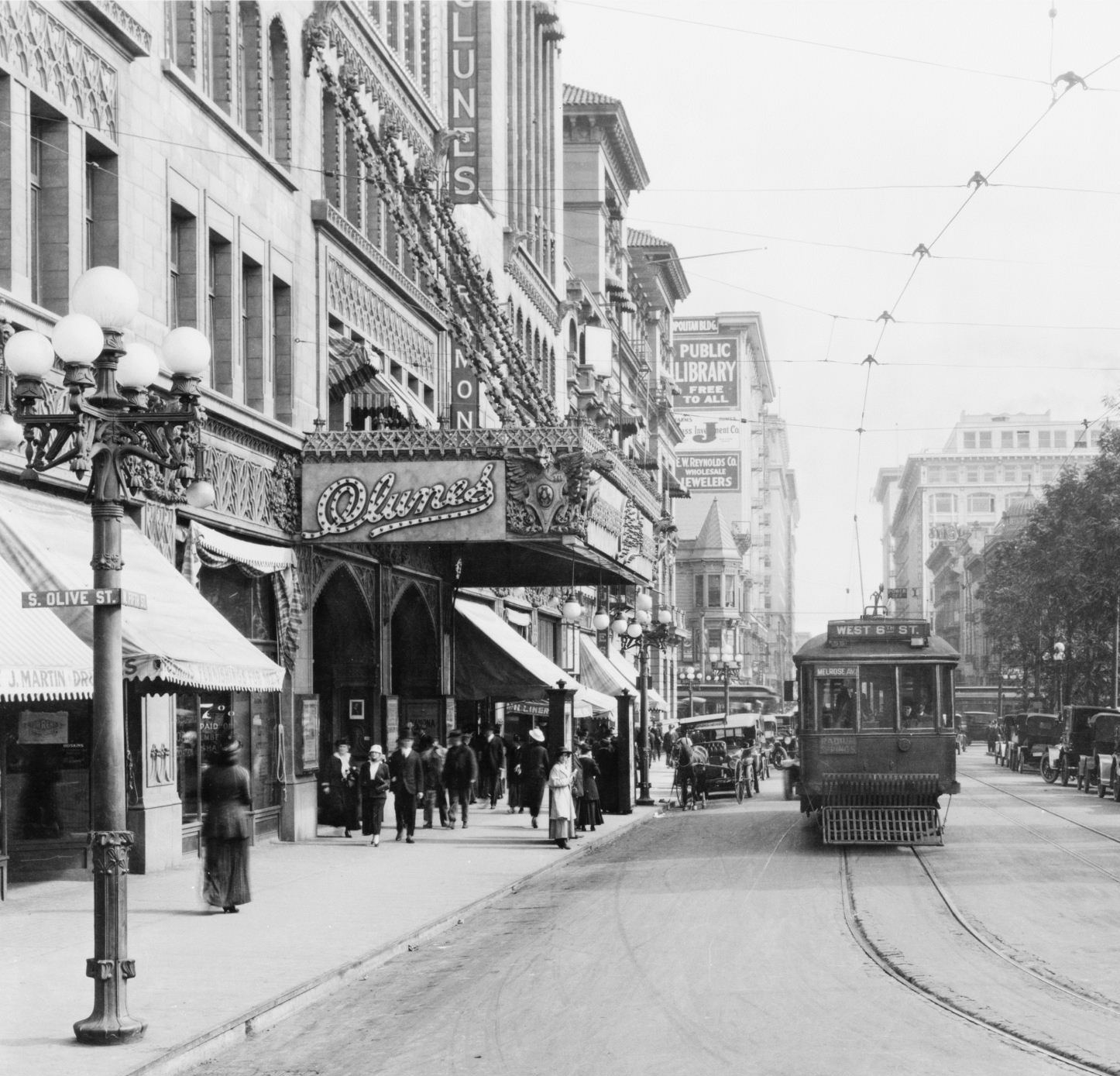 |
|
| (1914)* - View looking east on 5th Street at Olive Street, with Clune’s Theatre Auditorium on the left and Central Park (later named Pershing Square) across the street on the right. A horse-drawn carriage is parked by the curb while a streetcar is in the middle of the road. |
Historical Notes The Los Angeles Railway operated an extensive network of streetcars in the downtown area, including along 5th Street near what would become Pershing Square, during the period around 1914. |
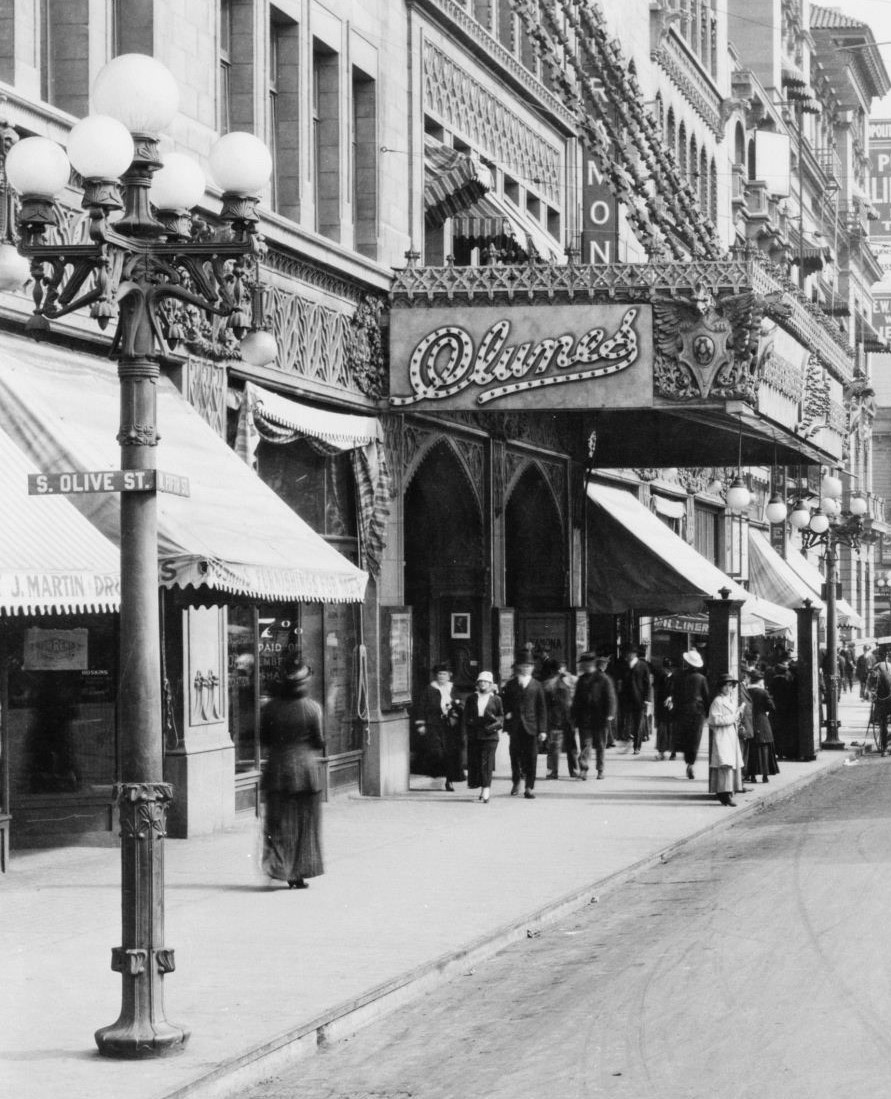 |
|
| (1914)* - A close-up view showing the details of both the Clune’s Theatre marquee and the ornate 5-lamp streetlight on the northeast corner of 5th and Olive Street. This beautiful streetlight, also known as 'Winslow,' added a certain charm to the downtown area. |
Historical Notes Note the details on the ornate streetlight on the corner, also known as the 'Winslow' electrolier. It was manufactured by the Llewellyn Iron Works, founded in 1889, which was one of the largest metalworking facilities in Los Angeles at the time. Click HERE to see more early views of 5-globe Llewellyn 'Winslow' Electroliers. |
Hill and 5th Street (Northwest Corner)
 |
|
| (1904)* - View of the California Club Building on the corner of 5th and Hill streets. A group of ladies are seen on the corner (lower-left) waiting to cross the street. |
Historical Notes The California Club is a private social club established in 1888 in downtown Los Angeles, the oldest such club in Southern California. The club's first location was in the second-floor rooms over the Tally-Ho Stables on the northwest corner of First and Fort (Broadway) streets, where the Los Angeles County Law Library now stands. It moved to the Wilcox Building on the southeast corner of Second and Spring streets in 1895, occupying the two top floors, the fourth and fifth. The building was distinguished as the first in Los Angeles to have two elevators — one for the public and the other for members. The men's dining room, reading room, bar and lounge were on the top floor. On the floor below was the ladies' dining room. The club remained at the Wilcox Building for ten years, Increased membership impelled the club to seek a new location in the southward and westward direction of the expansion of the city. In 1904 the club's headquarters were moved to a new five-story building with a basement and a roof garden on the northwest corner of Fifth and Hill streets. Beginning in the 1920s, blacks, Jews and women were barred from membership. Finally in 1987 the city of Los Angeles made discriminatory clubs illegal. Some members of the California Club then sought to maintain discriminatory membership policies, but their efforts were defeated by a majority of the members. Indeed, in the vote taken in June 1987, 90 percent of the voting members favored admitting women.* |
.jpg) |
|
| (2023)* - Looking at the NW corner of Hill and 5th streets. |
Then and Now
 |
|
| (1904 vs 2023)* - Looking at the NW corner of Hill and 5th streets. Photo comparison by Jack Feldman. |
* * * * * |
Downtown Los Angeles
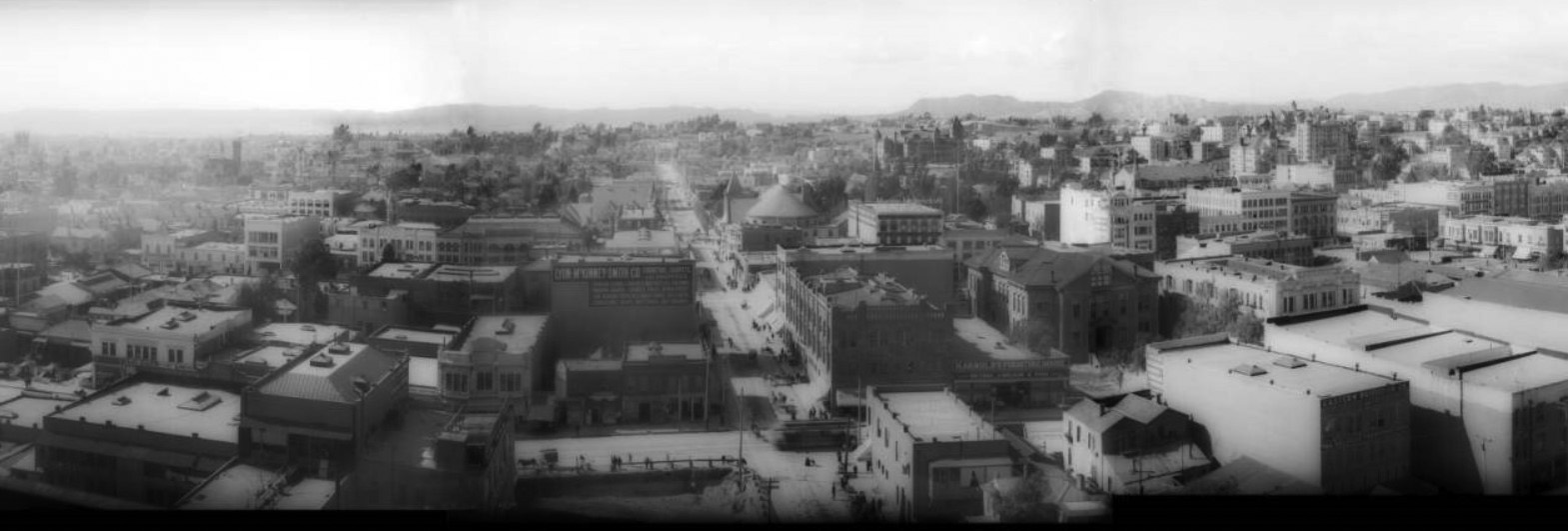 |
|
| (1904)^^ - Panoramic view of downtown Los Angeles, looking west on 6th street from the top of the still under construction Pacific Electric Building (6th Street & Main Street). |
Historical Notes The city is thriving with multi-storied commercial and residential buildings. Both, the large two-story mansion-style Spring Street School next to the H. Arnold Furniture Store building and the California State Normal School can be seen. Prominent buildings or landmarks include: Pershing Square (center right), Saint Paul's Episcopal Church, State Normal School (upper center) and the Metropolitan Building (still under construction -- behind the Los Angeles Examiner building). Mountains are visible in the distance: the Santa Monica Mountains to the left; the Hollywood Hills, center right; and a mix of the Verdugo and San Gabriel Mountains to the right. |
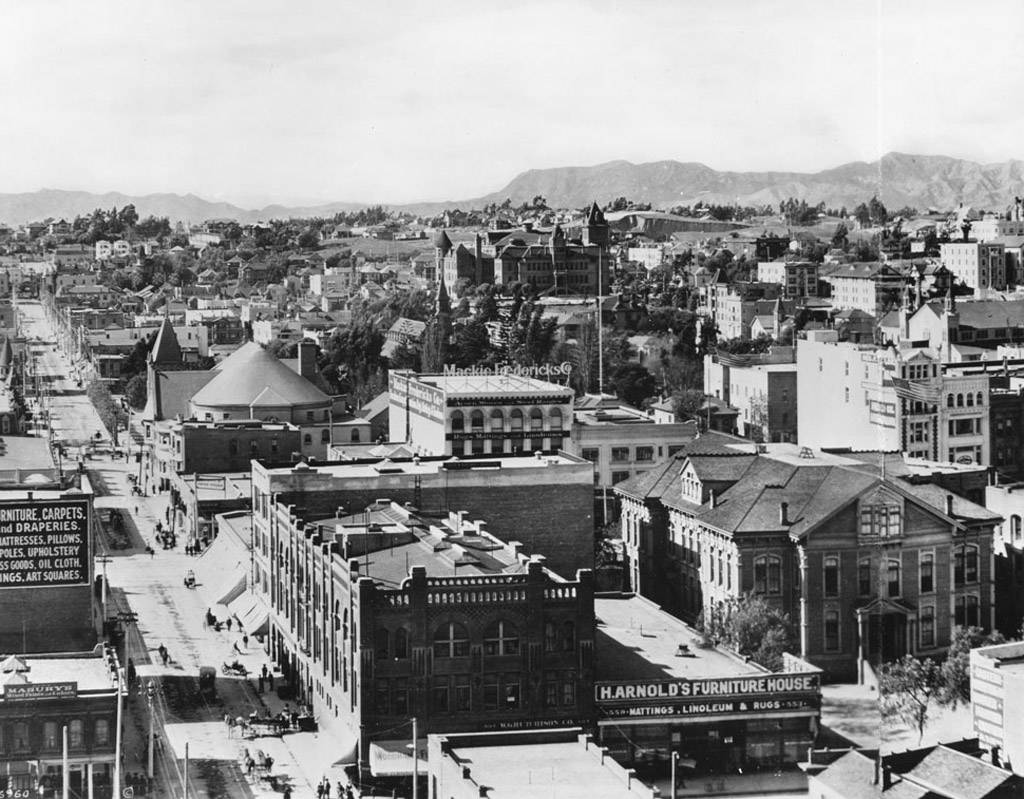 |
|
| (ca. 1904)^^ - View of Sixth Street looking west from Spring Street. The Hollywood hills can be seen in the distance. The large structure on the hill in the background (top-center) is the California State Normal School. The building at center-left with the conical-style roof is the First Methodist Episcopal Church. It's located on the NE corner of 6th and Hill, across the street from Central Park (later Pershing Square). |
Historical Notes Sixth Street stands to the left, stretching towards the horizon from the bottom of the photo, populated with pedestrians and horse-drawn carriages. Tall two- to four-story victorian-style business buildings line it to the left and right. To the extreme right, the large, two-story mansion-style Spring Street School can be seen next to the H. Arnold Furniture House that advertises "Mattings, Linoleum & Rugs". Mountains (Hollywood HIlls) are visible in the background. The California State Normal School is the largest structure in the background.^^ |
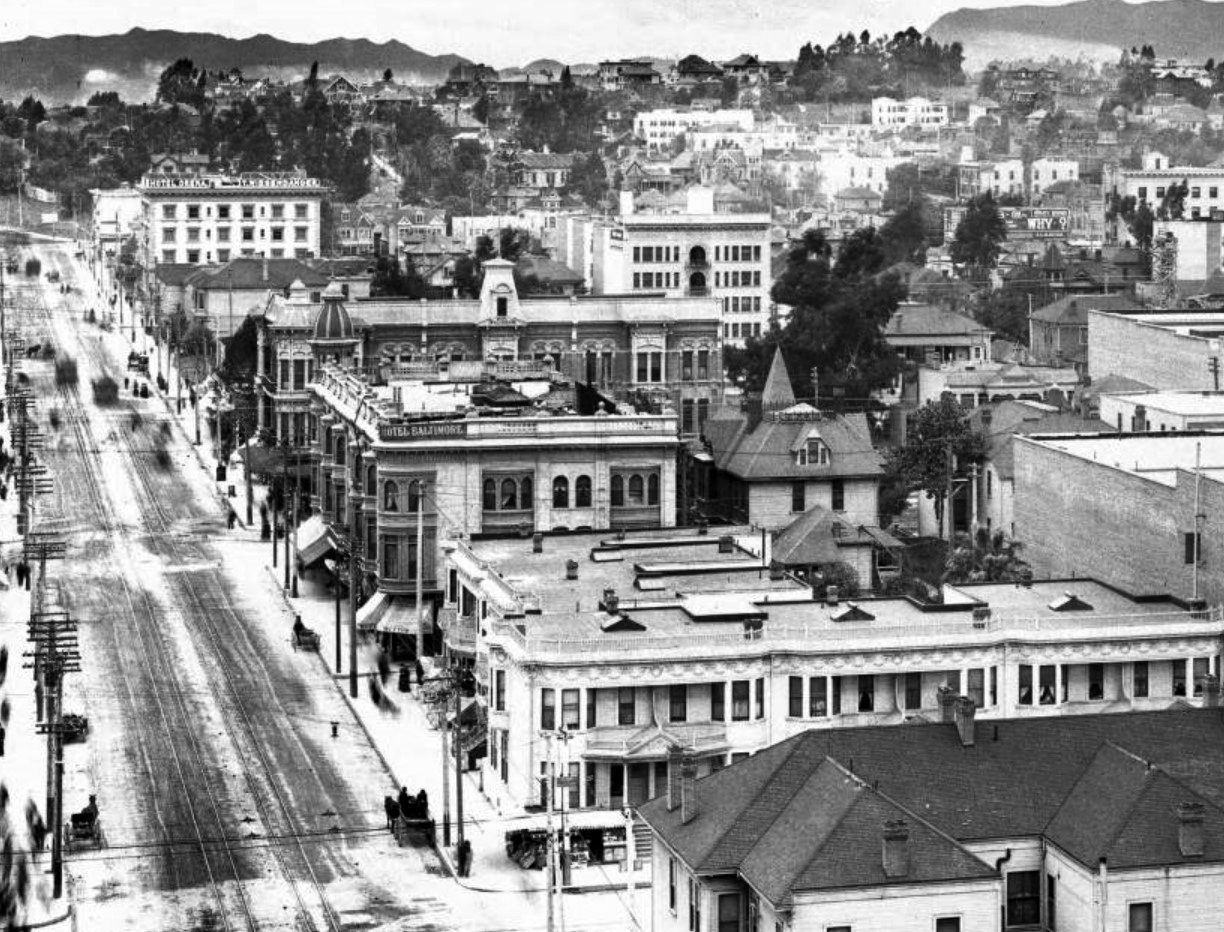 |
|
| (ca. 1905)^^ – View looking west on 7th Street from the Lankershim Hotel (SE corner of 7th at Broadway. The Hotel Baltimore (NE corner of 7th and Olive) can be seen at center-left. |
Pacific Electric Building
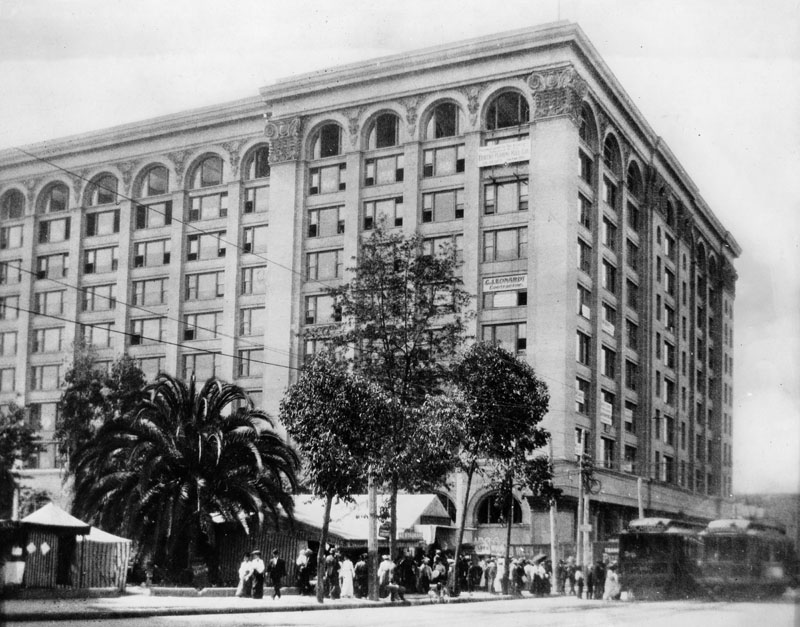 |
|
| (1905)^ - View of the Pacific Electric Railway building on Main and Sixth Streets, which housed the ticket office. Passengers are seen in line waiting to board the PE electric streetcars. |
Historical Notes The historic Pacific Electric Building (also known as the Huntington Building, after the Pacific Electric founder and developer, Henry Huntington) opened in 1905 as the terminal for the Pacific Electric Red Car Lines running east and south of downtown Los Angeles, as well as the company's main headquarters building. It was designed by architect Thornton Fitzhugh. Though not the first modern building in Los Angeles, nor the tallest, its large footprint and ten-floor height made it the largest building in floor area west of Chicago for several decades. Above the main floor terminal were five floors of offices and, on the top three floors, the Jonathan Club, one of the city's leading businessmen's clubs. The club moved to its own building on Figueroa Street in 1925.*^ |
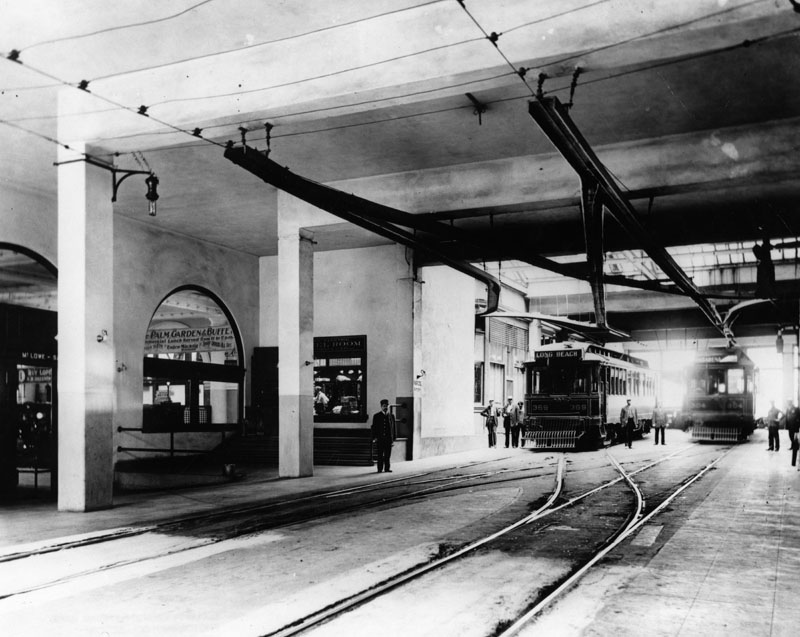 |
|
| (ca. 1905)^ - Interior view of the Pacific Electric Building, the main streetcar station located on Main and 6th streets. Two streetcars, one bound for Long Beach, the other for Pasadena, are seen surrounded by several conductors. The Palm Garden & Buffet, a small lunch counter managed by Eugen Mächtig, is visible on the left. Another business, perhaps a men's clothier, is also present in the building. One sign on the far left reads "Mt. Lowe", once a popular mountain destination for Pacific Electric customer (Click HERE to see more in Early Views of Mt. Lowe Railway). |
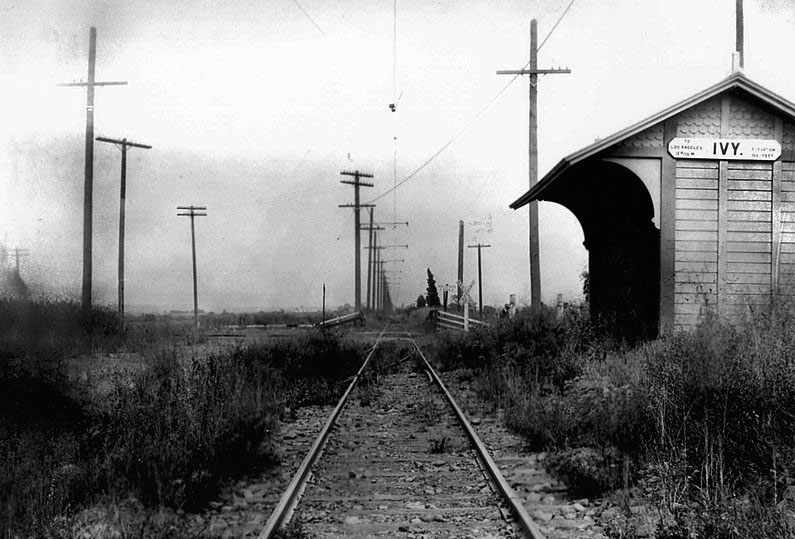 |
|
| (ca. 1905)^## - Westbound view of "Ivy Station" at the current location of the Culver City station of Los Angeles Metro's Exposition light rail line. |
Historical Notes Named after the Ivy Park housing development, the Ivy station stop along the Santa Monica Air Line served present-day Culver City. Located near the corner of Venice and Robertson Boulevards, the Ivy Station was later renamed Culver Junction. It eventually closed in 1953.^## |
* * * * * |
Venice of America
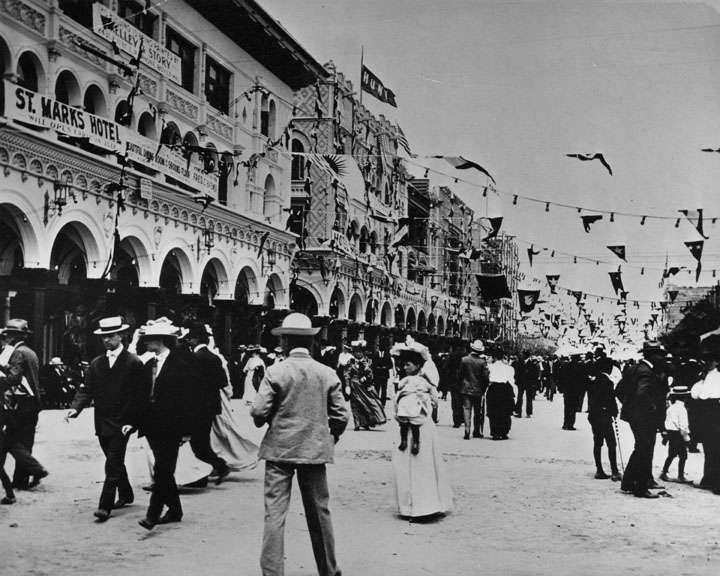 |
|
| (1905)* - The street is filled with people strolling, and the air with banners strung from the Hunt Hotel on the left. A banner on the building to the near left declares that "St. Mark's Hotel will open in early July". This was the grand opening celebration for Venice of America, July 4, 1905. Click HERE to see more in Early Southern California Amusement Parks. |
Historical Notes In 1891 Abbot Kinney built the resort of Ocean Park, which became the center of his coastal amusement paradise, Venice of America. Easily accessible by streetcar from both Santa Monica and Los Angeles, Venice, which opened in 1905, included canals, gondolas and gondoliers, Venetian-style buildings, an amusement pier, a dancehall and an auditorium. Kinney inherited his father's tobacco business and made a substantial fortune manufacturing Sweet Caporal cigarettes.* |
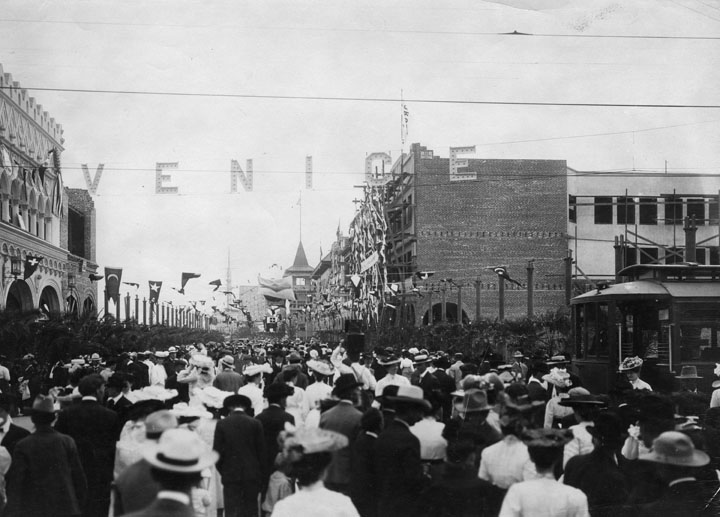 |
|
| (ca. 1905)^ - There are wall to wall people filling Windward Ave. in Venice of America, all looking and moving toward the ocean. "VENICE" is strung above their heads over the street in large letters. |
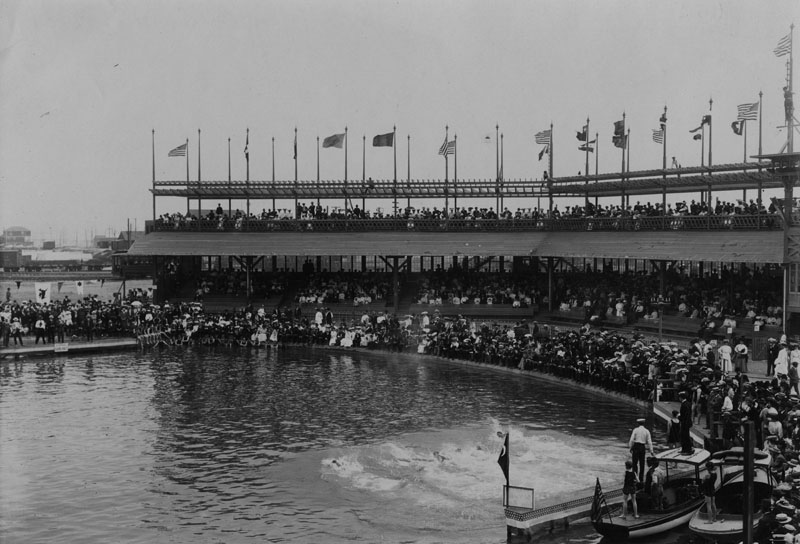 |
|
| (1905)^ - Swimming race at Venice of America. A large crowd is present in the amphitheater at Venice near Los Angeles to view the swimming races on July 4th. Here the 50 yard race has just begun. |
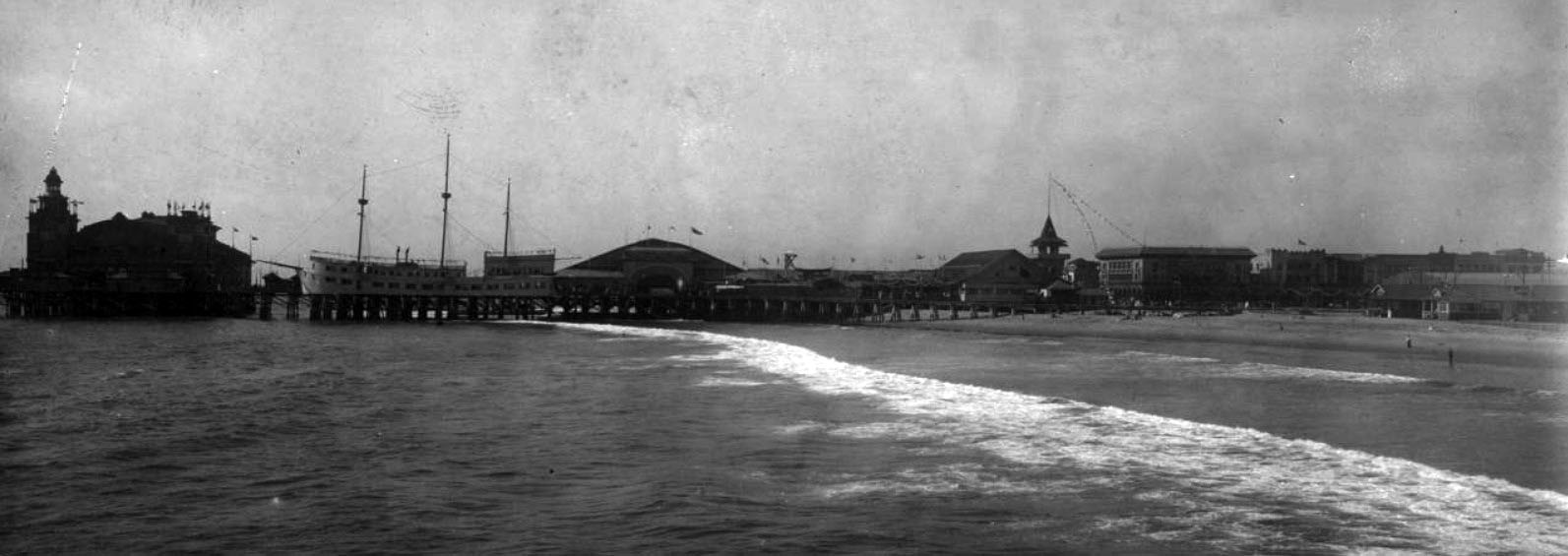 |
|
| (ca. 1905)^^ - Panoramic view looking north at the Pier at Venice Beach showing the amusement park and beach. The Ship Cafe is seen on the left. |
Historical Notes Among the South Bay piers, the most notable in this period was Abbot Kinney's Venice of America pier, started in 1904 and built to rival his former partner's Ocean Park Pier. Located at the end of Windward Avenue in Venice, Kinney's pier was 900 feet long, 30 feet wide and included an Auditorium, large replica Ship Cafe, Dance Hall, Dentzel carousel, a Japanese Tea House and an Ocean Inn Restaurant. Venice soon became considered its own neighborhood.*^ |
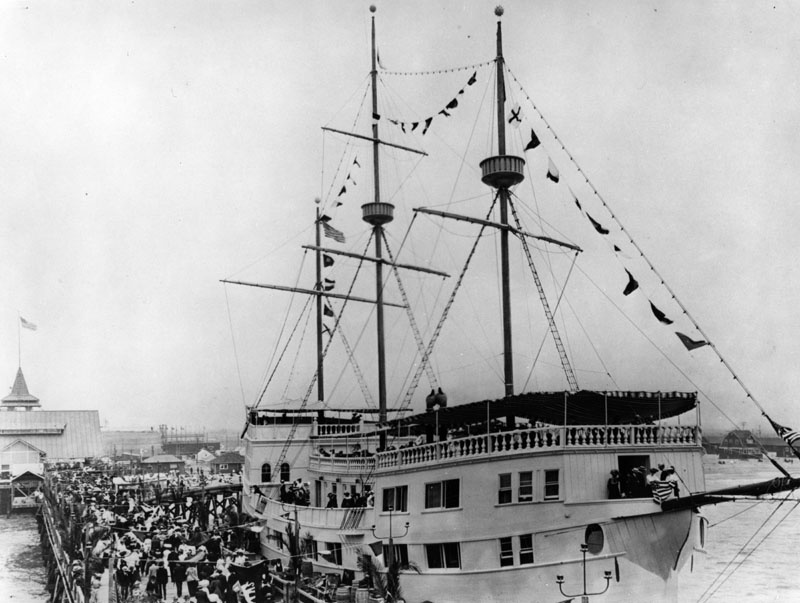 |
|
| (1905)^ - A big crowd is seen behind the large restaurant ship which was a replica of Juan Cabrillo's Spanish galleon. People can also be seen aboard the ship which was located in Venice at the Abbot Kinney Pier. |
Historical Notes Venice of America was founded by tobacco millionaire Abbot Kinney in 1905 as a beach resort town. He and his partner Francis Ryan had bought two miles of oceanfront property south of Santa Monica in 1891. They built a resort town on the north end of the property called Ocean Park, which was soon annexed to Santa Monica. After Ryan died, Kinney and his new partners continued building south of Navy Street in the unincorporated territory. After the partnership dissolved in 1904, Kinney built on the marshy land on the south end of the property, intending to create a seaside resort like its namesake in Italy.*^ |
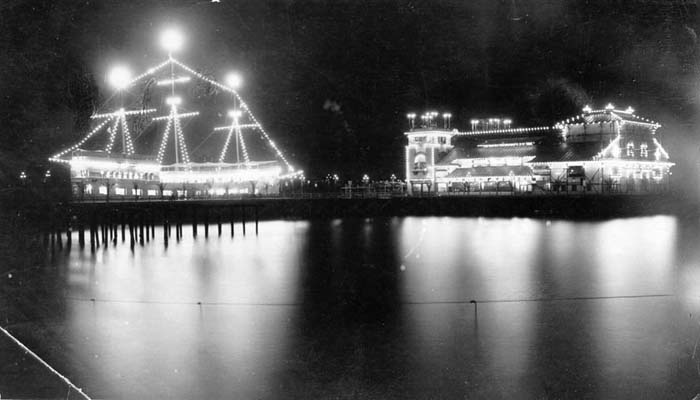 |
|
| (1905)^ - Nigthtime view of Abbott Kinney's Pier in Venice. The pier was destroyed by fire in 1920. |
Historical Notes When Venice of America opened on July 4, 1905, Kinney had dug several miles of canals to drain the marshes for his residential area, built a 1,200-foot long pleasure pier with an auditorium, ship restaurant, and dance hall, constructed a hot salt-water plunge, and built a block-long arcaded business street with Venetian architecture. Tourists, mostly arriving on the "Red Cars" of the Pacific Electric Railway from Los Angeles and Santa Monica, then rode Venice's miniature railroad and gondolas to tour the town.*^ |
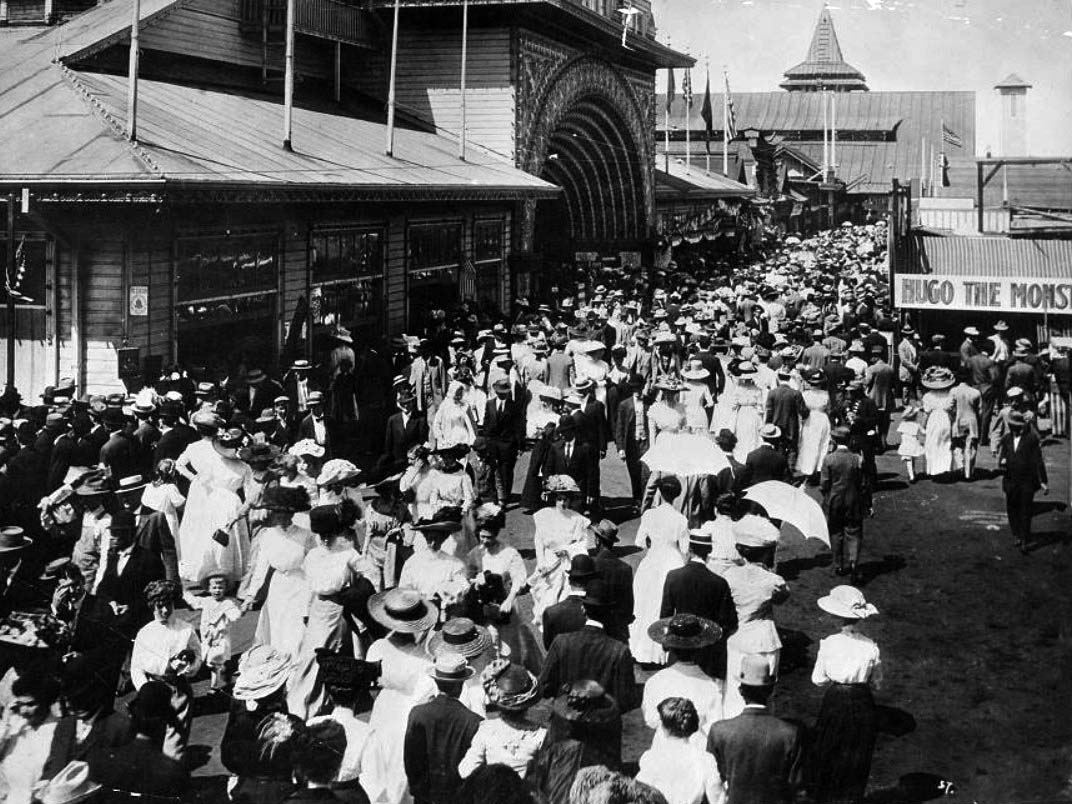 |
|
| (1908)^^ - Venice Pier on a crowded day with the Dance Hall seen in the background. |
* * * * * |
Naples Canals (Long Beach)
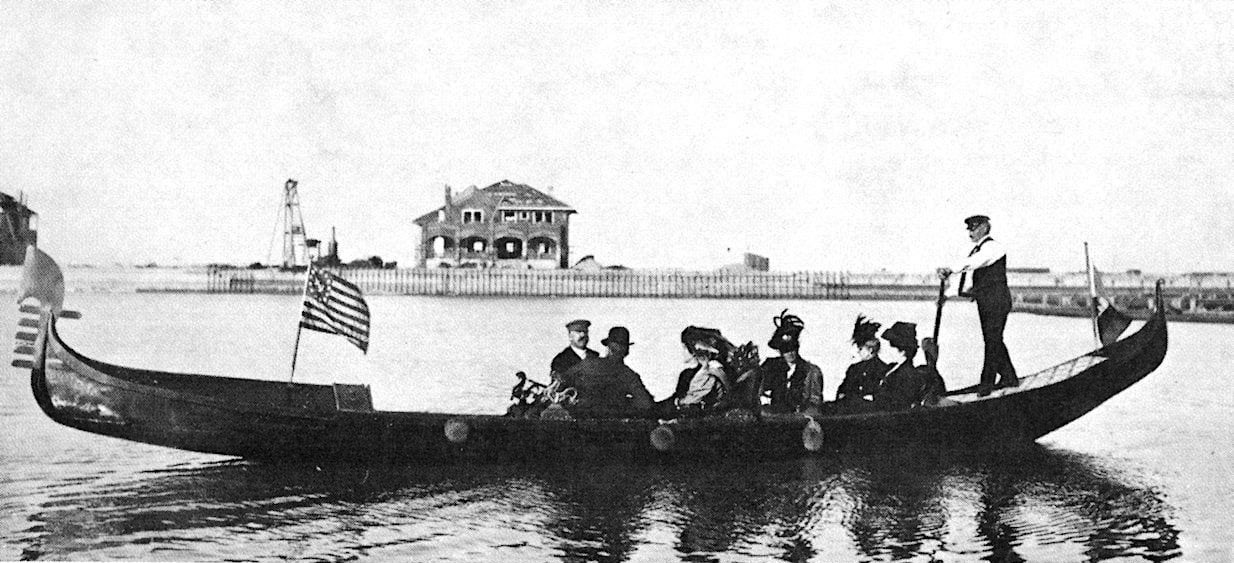 |
|
| (ca. 1905)* - A gondola carrying six passengers and a gondolier navigates the waterways of the canals in Naples, Long Beach. Note: this photo is often misidentified as the Venice Canals. |
Historical Notes In 1903, A.M. Parson and his son began plotting a path to build Naples into a resort village reminiscent of an Italian village. However, the area was considered a swampland known for flooding and was, therefore, difficult to build on. In an effort to showcase the beauty of the islands, Naples was one of the stops on the Triangle Trolley Trip excursion that began in Los Angeles. Passengers were transported by the Pacific Electric Red Trolley Cars to this small community of canals. |
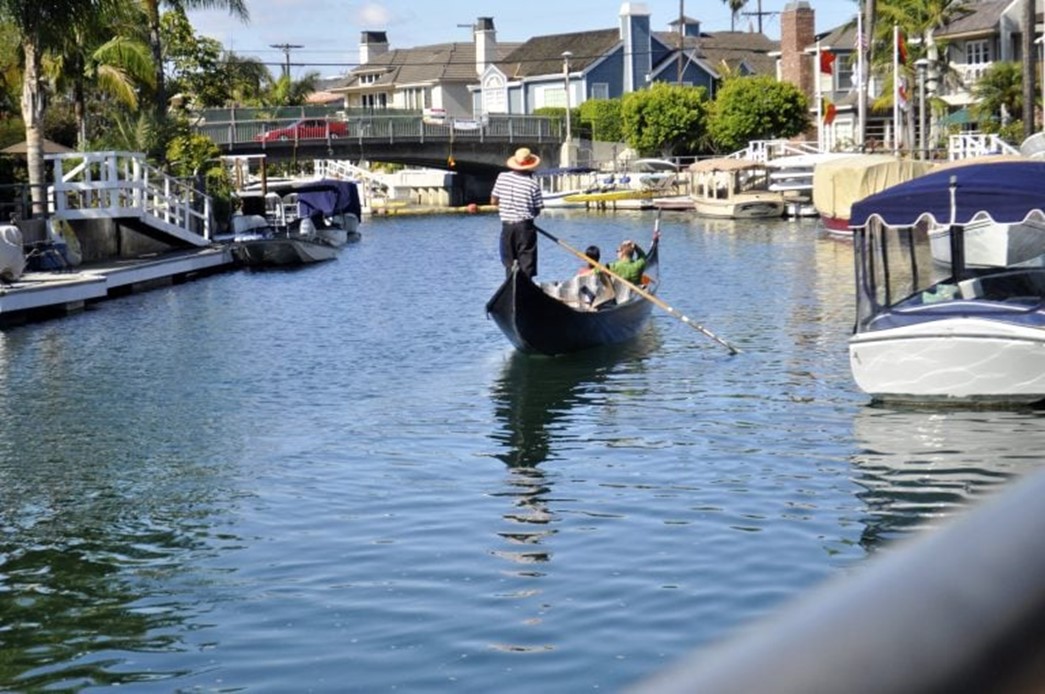 |
|
| (2016)* – Contemporary view of the canals adjacent to Naples Island in Long Beach. Photo courtesy of KW Coastal Properties |
Historical Notes Located between Belmont Shore and the Long Beach Marina are the islands that make Naples. The neighborhood consists of three islands along Alamitos Bay, which are divided by enticing canals that lead to the open bay. |
* * * * * |
Venice Canals
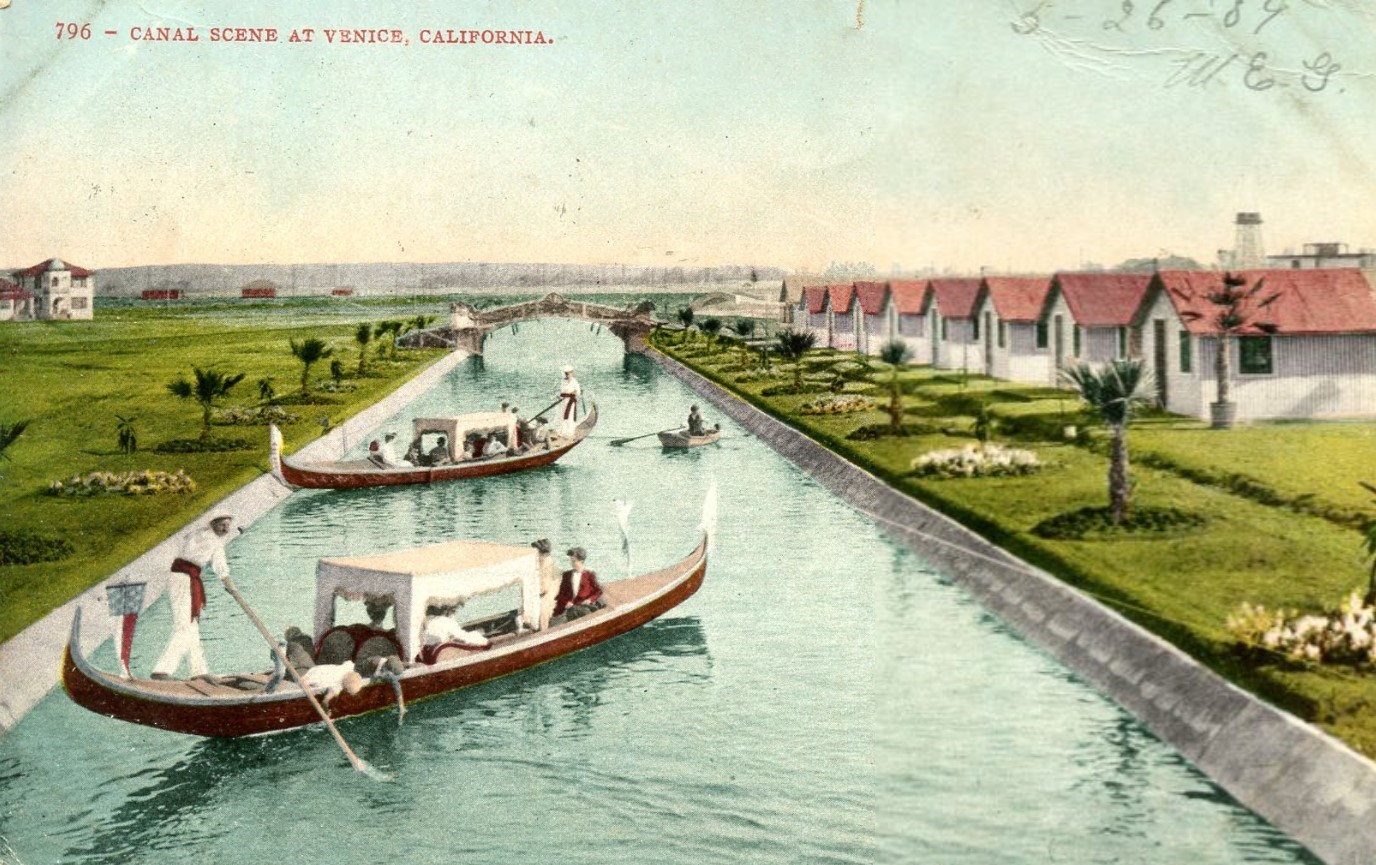 |
|
| (1909)* - This postcard depicts one of the canals built by Abbot Kinney in 1905 in Venice, California to replicated the feeling of Venice, Italy in Southern California. Complete with Venetian style buildings and gondolas (as seen here), Kinney's Venice of America opened on July 4, 1905. Written on back: "This little scene taken at one of our beaches is, of course, artificial that is - canals are cut to let in the ocean water. |
Historical Notes The Venice Canals were originally conceived by developer Abbot Kinney in 1905 as part of his vision to create a "Venice of America" in what is now the Venice neighborhood of Los Angeles. Inspired by the famous canals of Venice, Italy, Kinney aimed to recreate a romantic and picturesque waterfront community. |
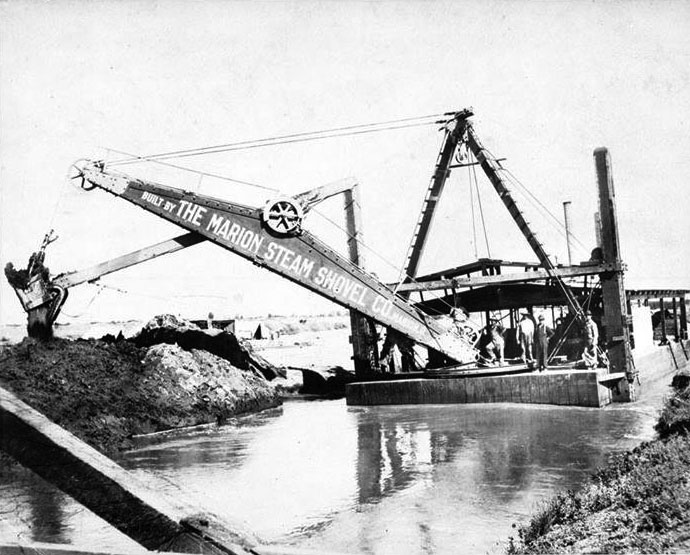 |
|
| (ca. 1904)^^ - View of canal dredging in Venice, showing a large steam shovel arm protruding from the bow of a barge. Several men are standing on the barge near the shovel arm. The arm reads "Built by the Marion Steam Shovel Co. Marion, O". |
Historical Notes Kinney dredged several miles of marshland to create the canals, which were accompanied by Italian-inspired bridges and walkways. Construction began in 1904, and by 1905, the first canals were completed. The area quickly became a popular tourist destination and residential area. |
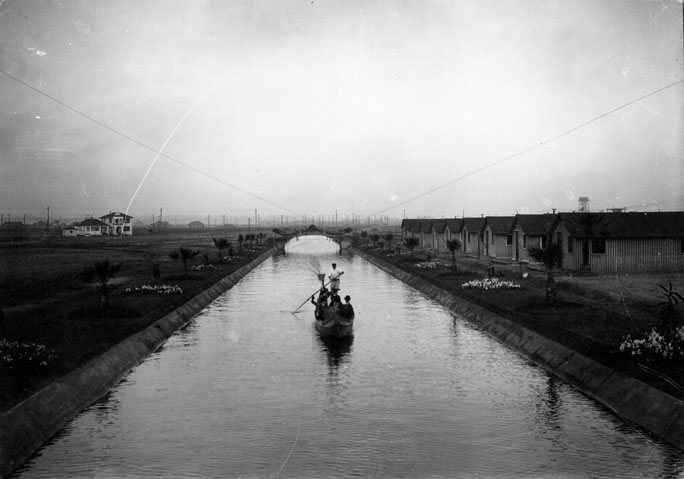 |
|
| (1905)^ - A boat glides along a canal in Venice, in 1905. Notice the newly planted palm trees along the sides of the canal, and bungalows are visible at right. The sky looks overcast. The oarsman is standing at back, and men with suits and hats are sitting together at front. |
Historical Notes The original Venice of America canals contributed to the success of Kinney's real estate development. Lots fronting the canals became a favorite choice for owners of the local amusement concerns or out-of-town tourists looking for a place to pitch a summer cottage. |
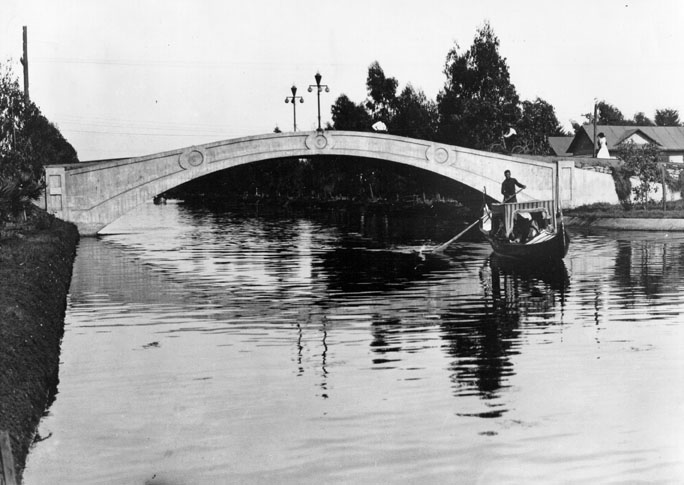 |
|
| (ca. 1905)^ - A gondolier and boat passes under one of the bridges on the canal route. At the same time a pedestrian and a bicycle rider are passing over the bridge. |
Historical Notes The beautifully lit canals with gondoliers and arched bridges drew widespread publicity and helped sell lots in Kinney’s Venice development. |
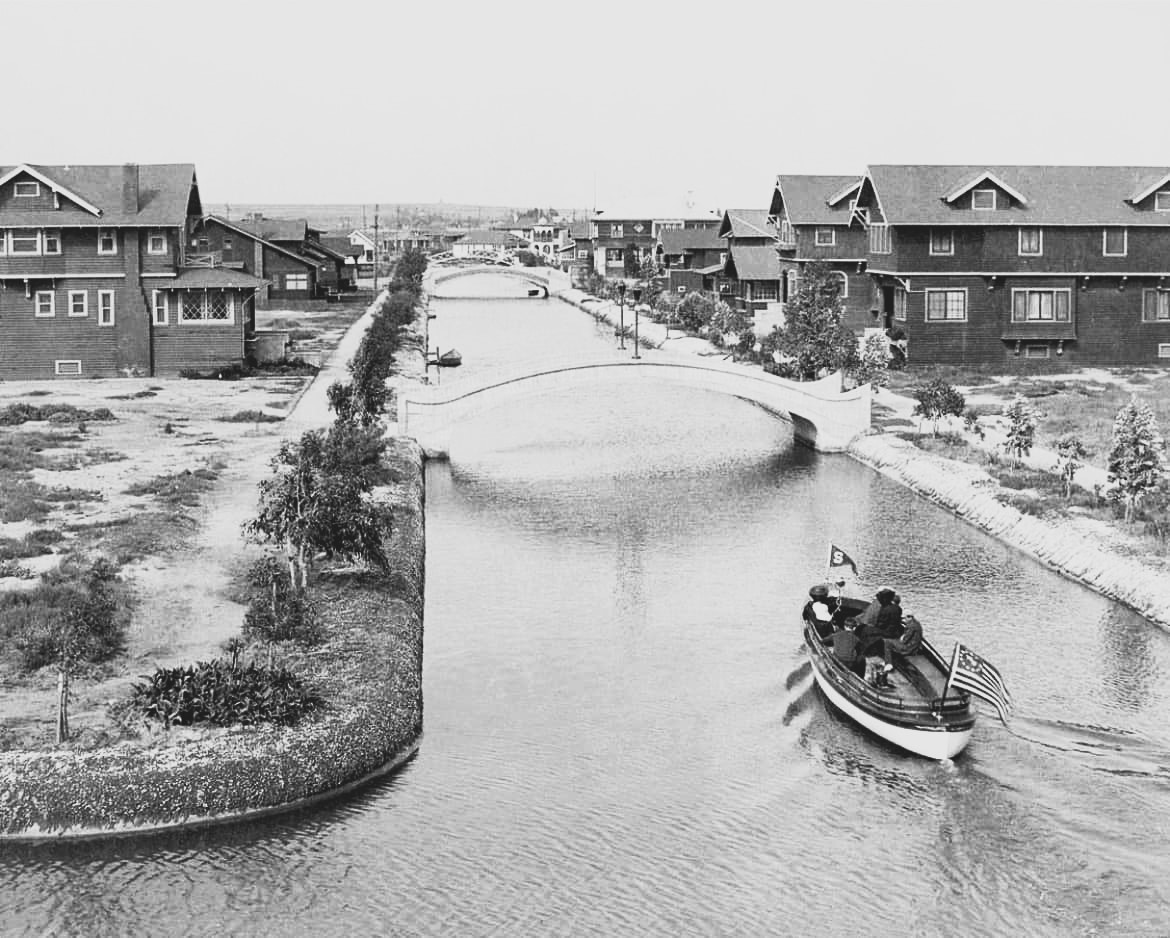 |
|
| (1911)* - A boat heads down the Aldebaran Canal. |
Historical Notes The Aldebaran Canal would later become Market Street after the canals were filled ca. 1929. |
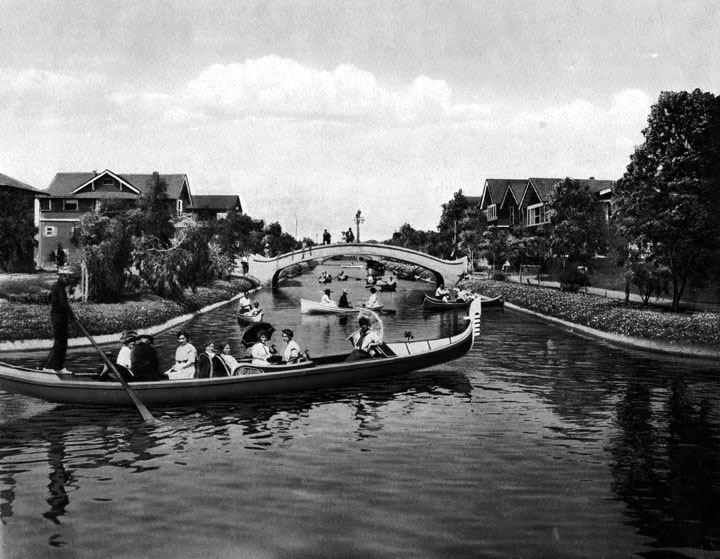 |
|
| (ca. 1909)^ – Postcard view showing gondoliers and row boats on the Aldebaran Canal. This would later become Market Street in Venice. |
Historical Notes As the automobile gained in popularity, the canals were viewed by many as outdated, and the bulk of the canals were filled in 1929 to create roads. |
 |
|
| (1924)^ - View showing a complex of rental bungalows known as United States Island. It was accessible only by the foot bridges seen on either side of it. In this view, looking north, Altair Canal is on the left and Cabrillo Canal on the right. |
Historical Notes When it opened on July 4, 1905, Venice of America boasted seven distinct canals arranged in an irregular grid pattern. Totaling nearly two miles and dredged out of former saltwater marshlands, the canals encircled four islands, including the tiny triangular United States Island. The widest of them, appropriately named Grand Canal, terminated at a large saltwater lagoon. Three of the smaller canals referred to celestial bodies: Aldebaran, Venus, and Altair. |
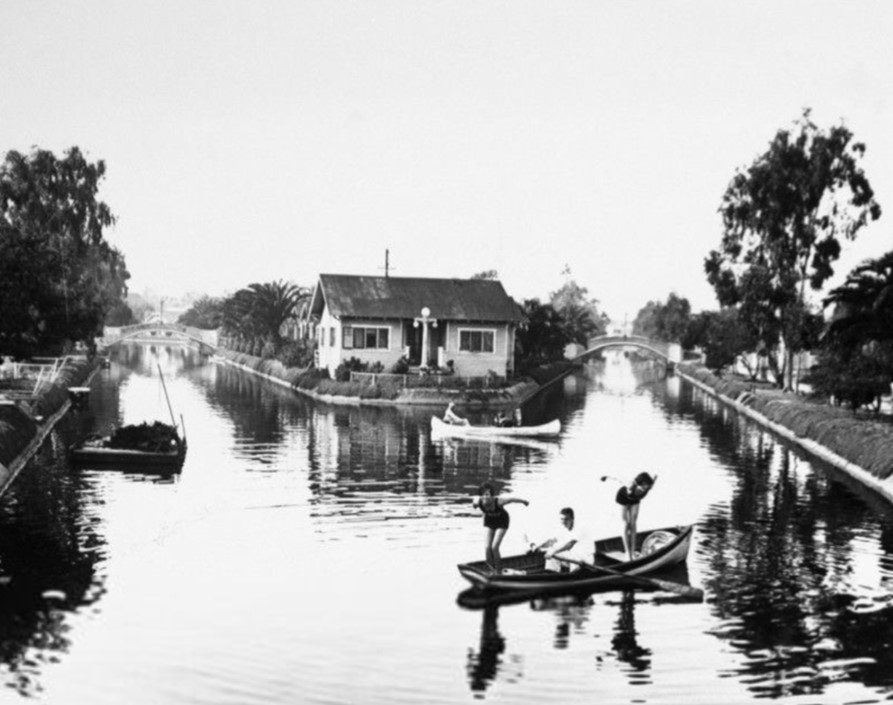 |
|
| (ca. 1924)* - Two young women preparing to dive into the water of the Venice Canals. In the background is a complex of rental bungalows on what was known as United States Island. It was accessible only by the foot bridges seen on either side of it. |
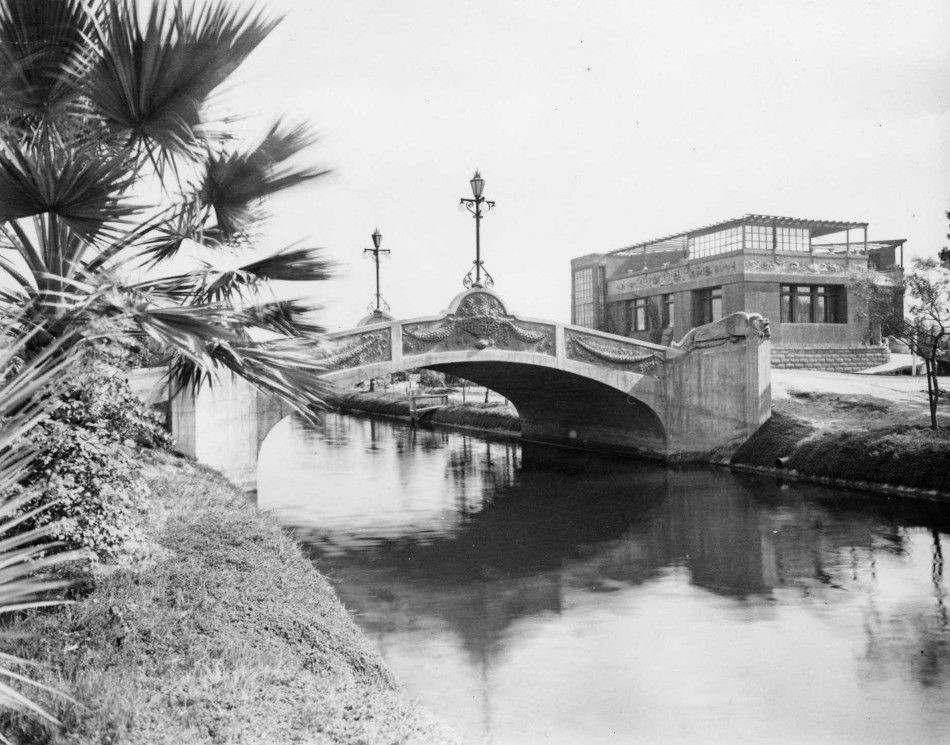 |
|
| (ca. 1920s)* - Lion Canal in Venice of America, part of Abbot Kinney's rich imagination and attention to detail. Note the majestic Lion resting on the bridge. |
Historical Notes Lion Canal, was renamed Windward, it stretched from the bathing lake, or lagoon past Saint Marks Island to Cabrillo Canal. |
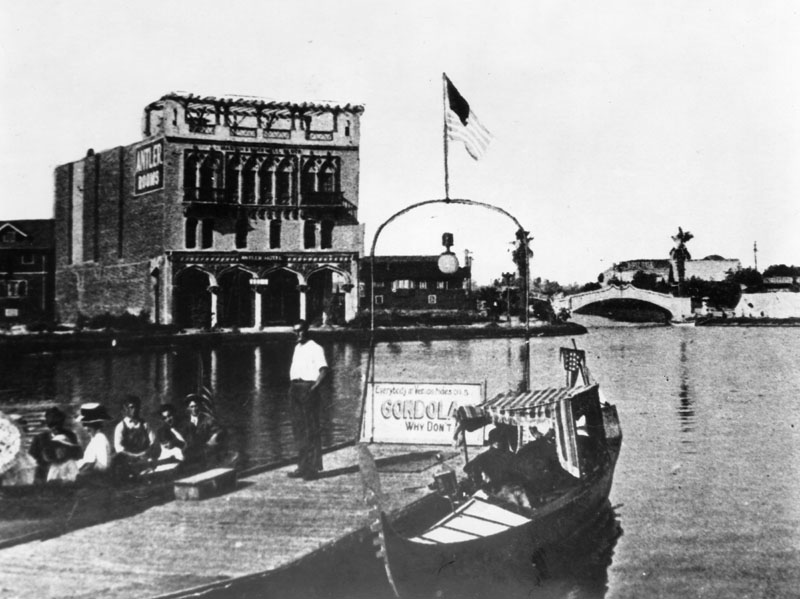 |
|
| (ca. 1905)^ - View of the Lagoon at Venice. Groups of people pay for a boat or a gondola ride on the canal. The Antler Hotel can be seen in the background to the left of the bridge over the canal. |
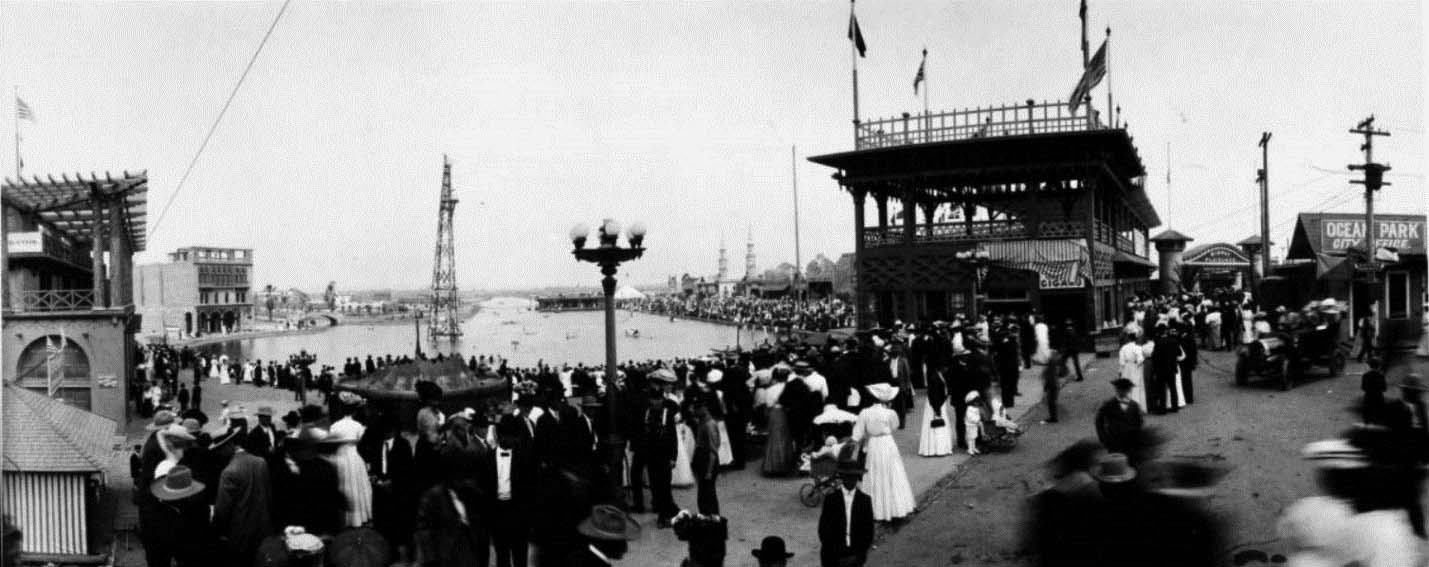 |
|
| (ca. 1910)* – View showing a crowd of people stretched from left to right between two pavilions at the Venice lagoon. The three story building in the distance (left) is the Antler Hotel. Next to it is a small bridge extending over a canal. At center, a Venice lagoon can be seen with a number of row-boats in it. What appears to be a watch tower stands in the middle of the lagoon. In the background, at center, another canal can be seen extending towards an extreme background. |
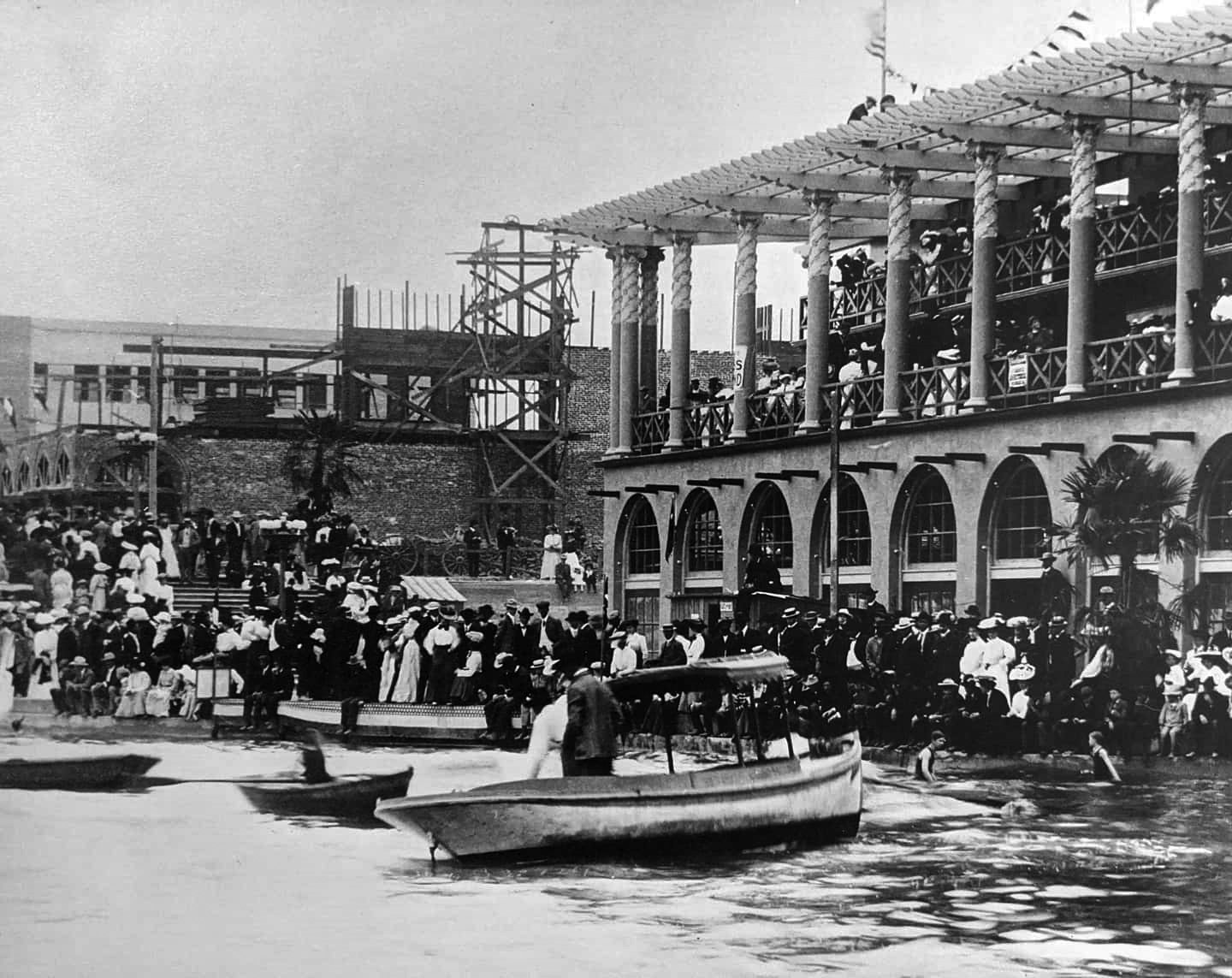 |
|
| (ca. 1910)* - Spectators watch what appears to be a row boat race in the Venice Lagoon. |
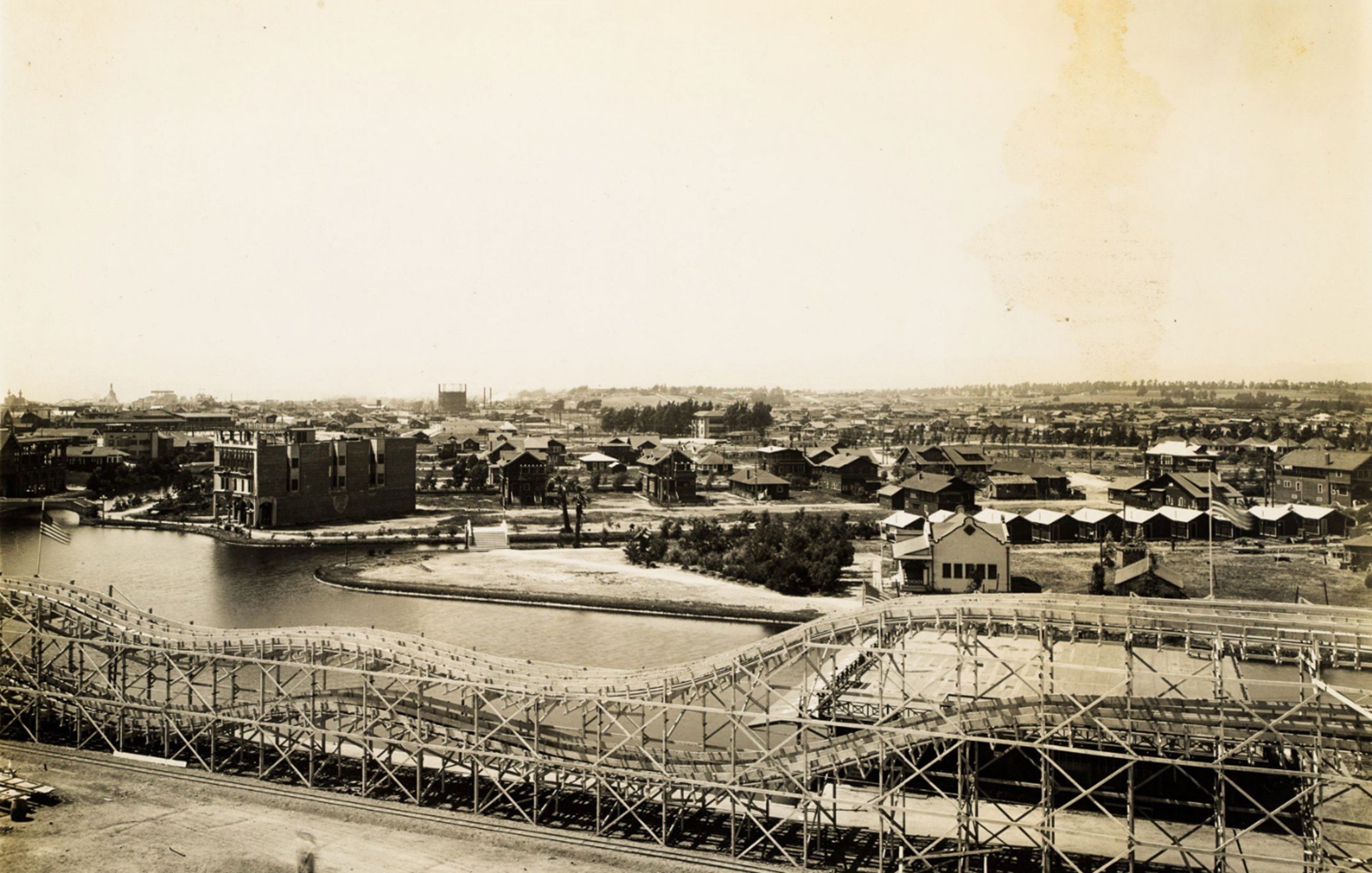 |
|
| (1910s)* - View of the Race Thru the Clouds racing roller coaster next to the Venice Lagoon in Venice, California. The Antler Hotel is visible on the left at the edge of the lagoon, with beach cottages, houses, and other buildings in the distance. Photo from the Ernest Marquez Collection. |
Historical Notes The "Race Thru the Clouds" was a prominent wooden roller coaster located at Venice Pier in Venice, California, during the 1910s. It was notable for being the first racing roller coaster on the West Coast and opened on July 4, 1911. The coaster was designed by John Miller, a renowned roller coaster designer, and was constructed by the Ingersoll Construction Company, with Thomas Prior and Frederick Church responsible for its operation and maintenance. The "Race Thru the Clouds" featured a twin-track design, allowing two coaster cars to race each other along parallel tracks. Each track was 4,000 feet long, and the coaster reached a height of 90 feet. This design provided a thrilling experience with numerous twists and turns, making it a popular attraction for visitors to Venice Beach. |
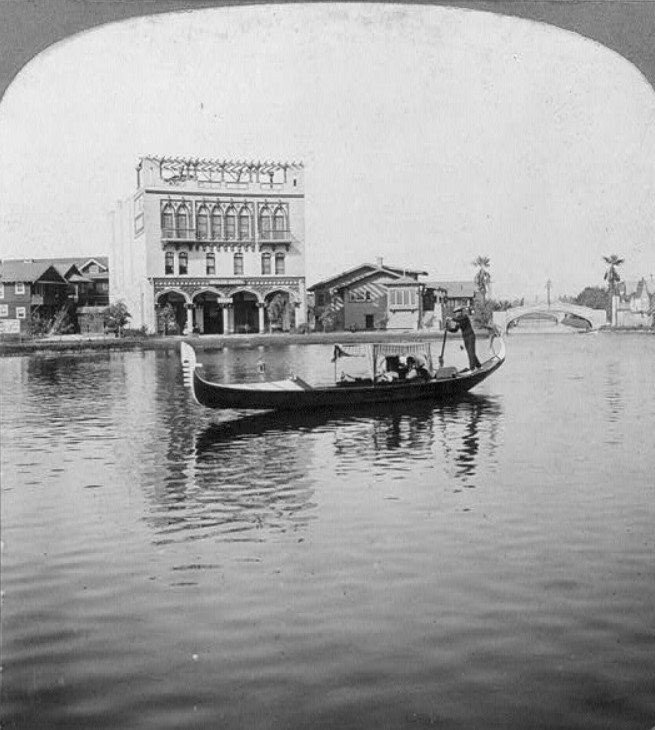 |
|
| (1913)* – Half of a stereoscopic image showing a gondola with a gondolier in the rear rowing on the Venice Lagoon. The Antler Hotel stands in the background. |
Historical Notes The Antler Hotel was a key landmark in Venice, California's early 20th-century "Venice of America" development, designed to mirror Venice, Italy, with canals and Venetian architecture. Located near the Venice Lagoon, the hotel was part of a vibrant area featuring attractions like the "Race Thru The Clouds" roller coaster. By the late 1920s, the lagoon was filled in, transforming the area into the Windward Circle. |
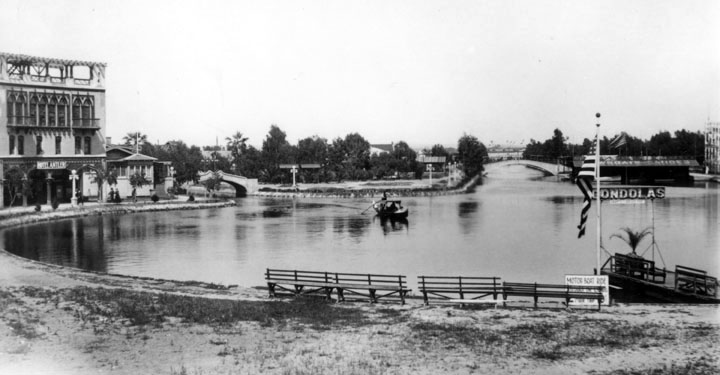 |
|
| (ca. 1910s)^ - Panoramic view showing a gondola being rowed across the canal towards the sign "Gondola" and another sign offering motor boat rides. On the left next to the water is the Hotel Antler. |
Historical Notes The canals converged on a large saltwater lagoon that later became a traffic circle. The bulk of the canals were filled in 1929 to create roads. |
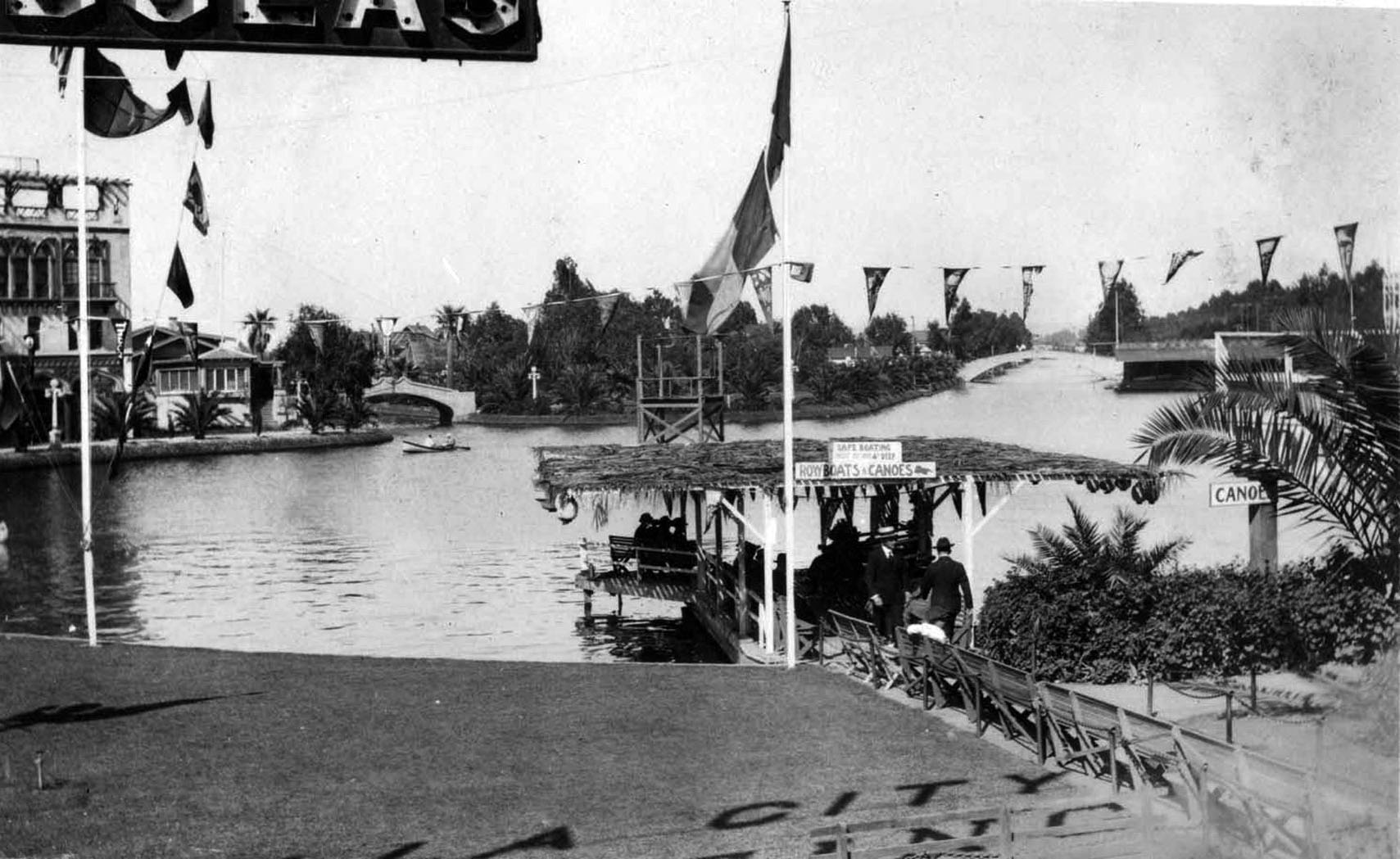 |
|
| (ca. 1910s)* - Venice Lagoon looking toward Grand Canal (right) and Lion Canal (left, later renamed Windward). In the foreground folks are patronizing a rowboat and canoe rental venue. Signage on the upper left corner of the photograph possibly advertises "gondolas." |
Then and Now
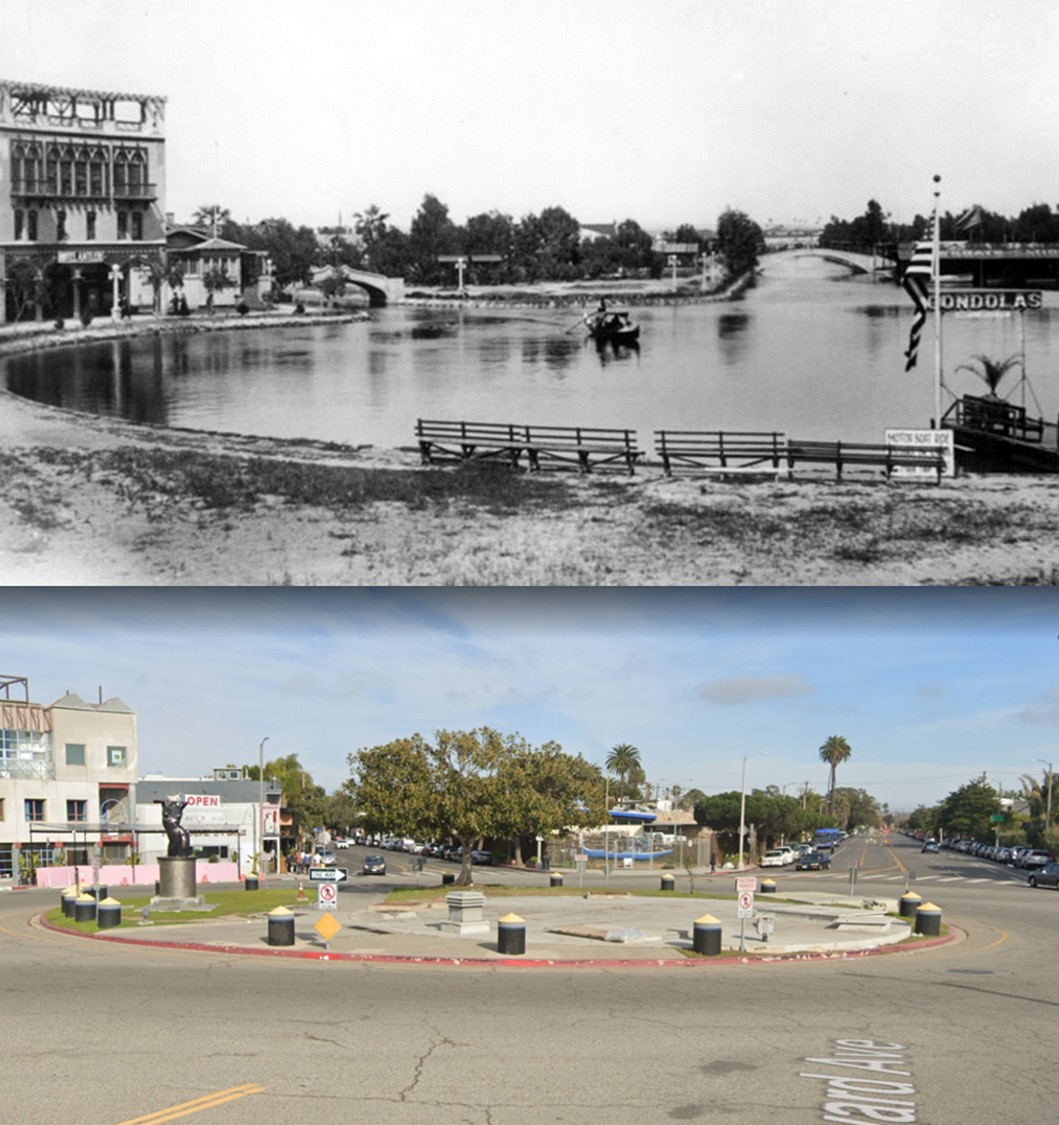 |
|
| Then and Now – Looking east showing the Venice Lagoon now the Windward Traffic Circle (1910s vs 2021)*. Windward Ave (previously Lion Canal) is on the left while Grand Blvd (previously Grand Canal) is on the right. The Antler Hotel is seen at upper-left. Photo comparison by Jack Feldman. |
Historical Notes The transformation of Venice's canals into roads was primarily driven by economic and maintenance considerations. As the canals began to deteriorate, the cost of upkeep became a significant burden for the city. Filling the canals was seen as a more economically viable solution, especially during the Great Depression, when resources were limited. This financial pressure, combined with the rise of automobile use and urban development priorities after Venice's 1926 annexation by Los Angeles, led to the widespread conversion of canals into roads. Despite resident opposition, most canals were filled, although some were preserved and later recognized as historic landmarks. |
Then and Now
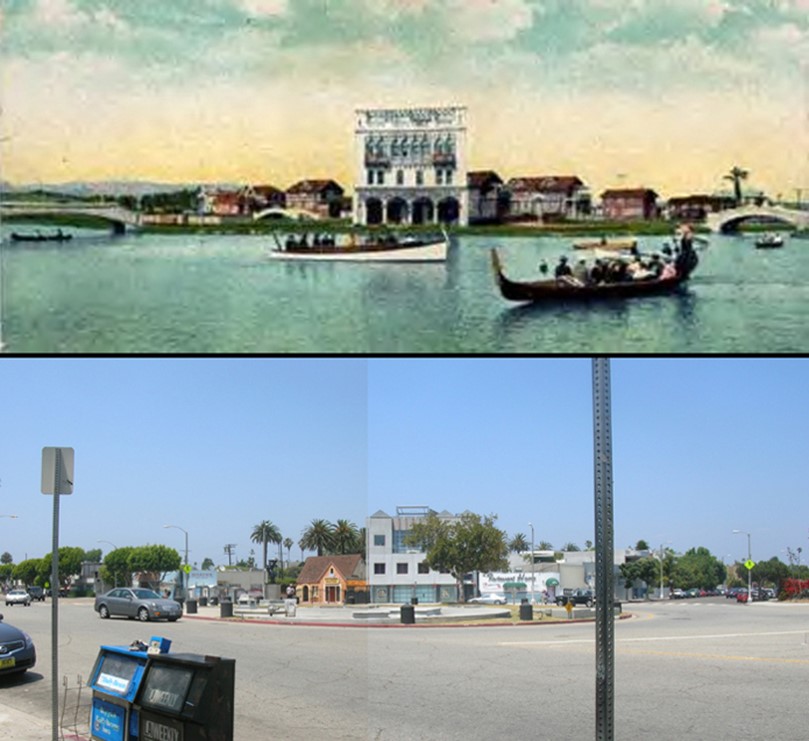 |
|
| Then and Now* – Venice Lagoon, now Windward Traffic Circle. |
Then and Now
 |
|
| (1910 vs 2020s)* - Grand Canal at the Rialto Bridge, today Grand Blvd at Rialto Avenue. |
Then and Now
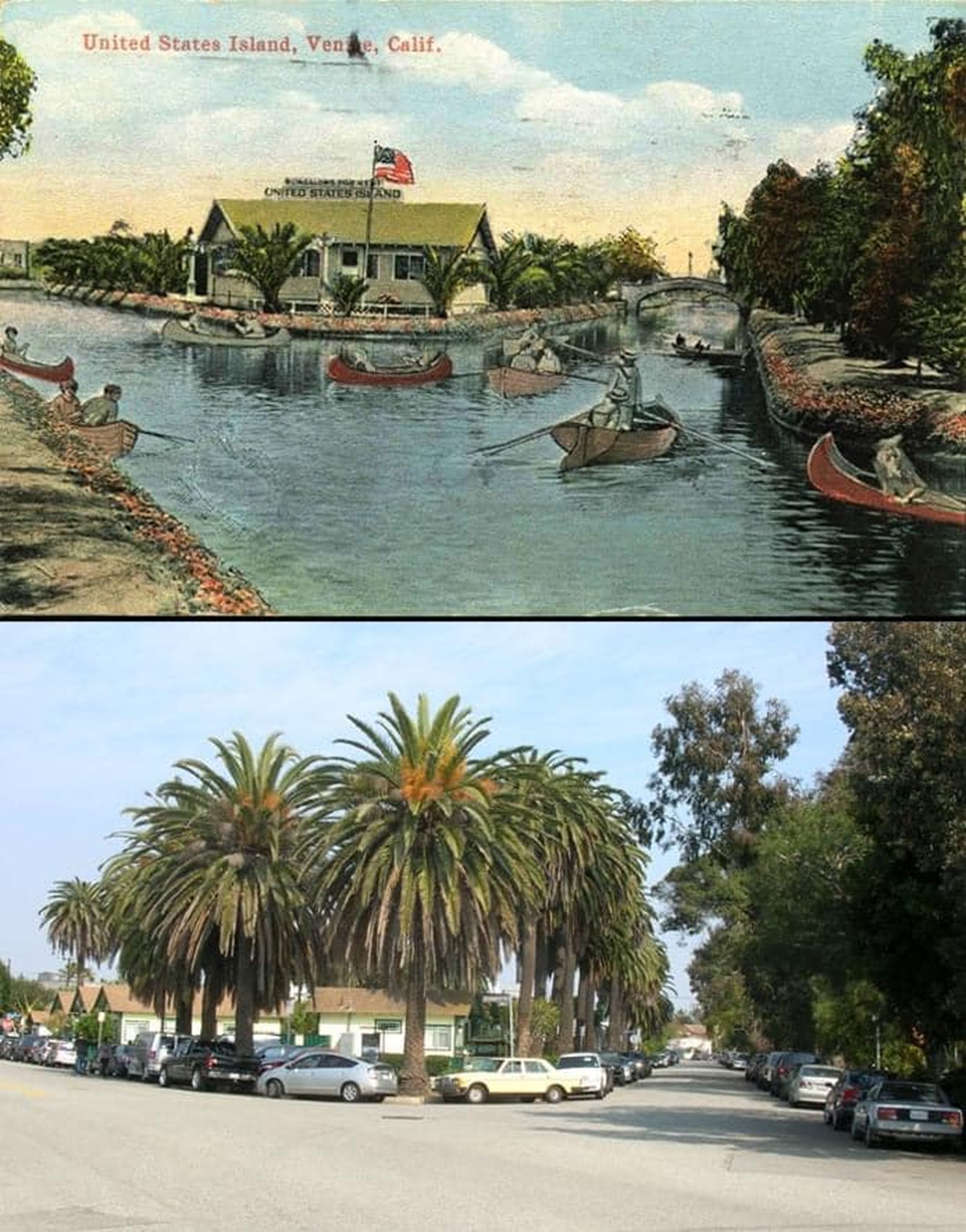 |
|
| (Then and Now)* |
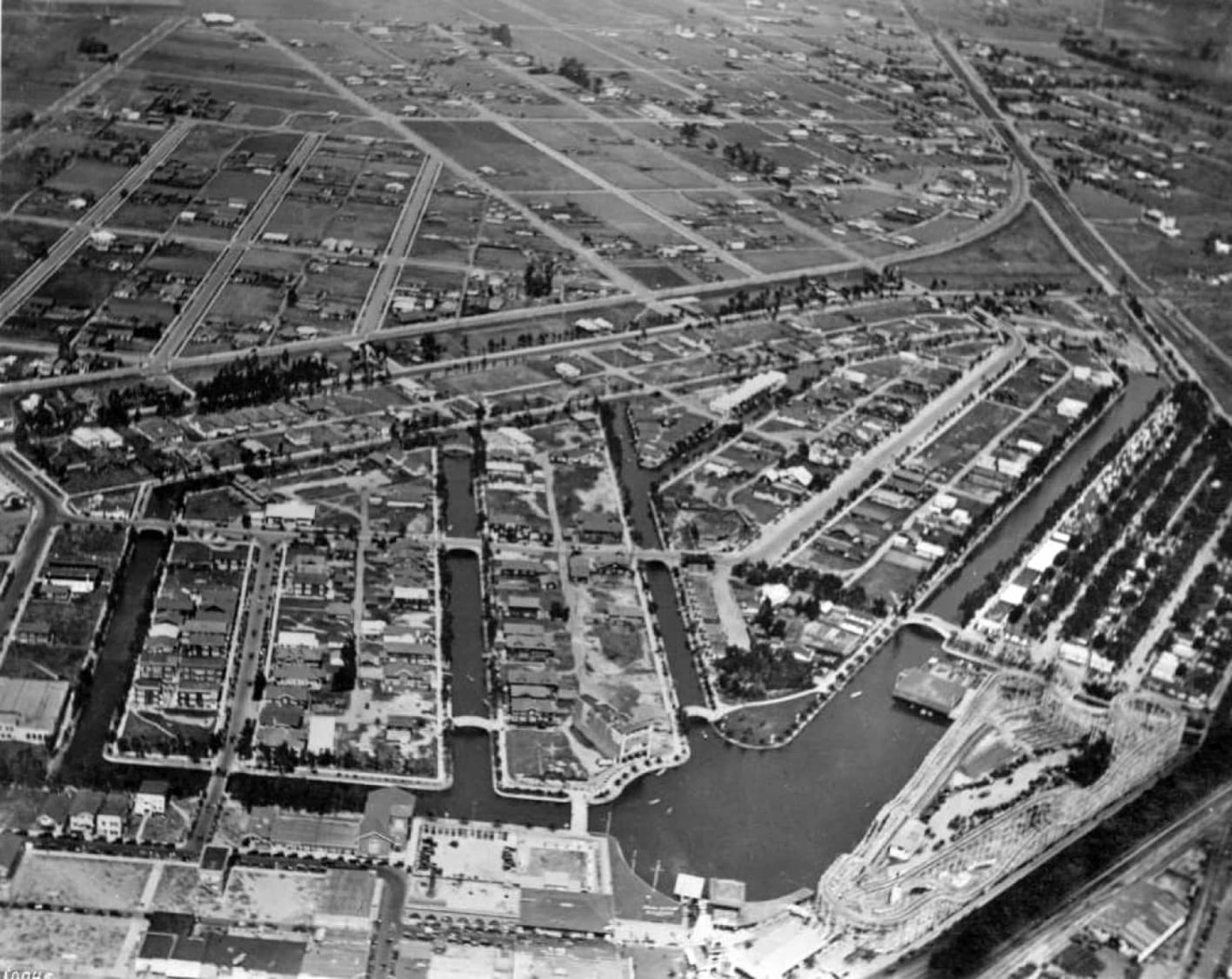 |
|
| (1920s)* - Aerial view of the Venice canals looking easterly with the Venice Lagoon at lower center-right. Note all the undeveloped land at top of photo. |
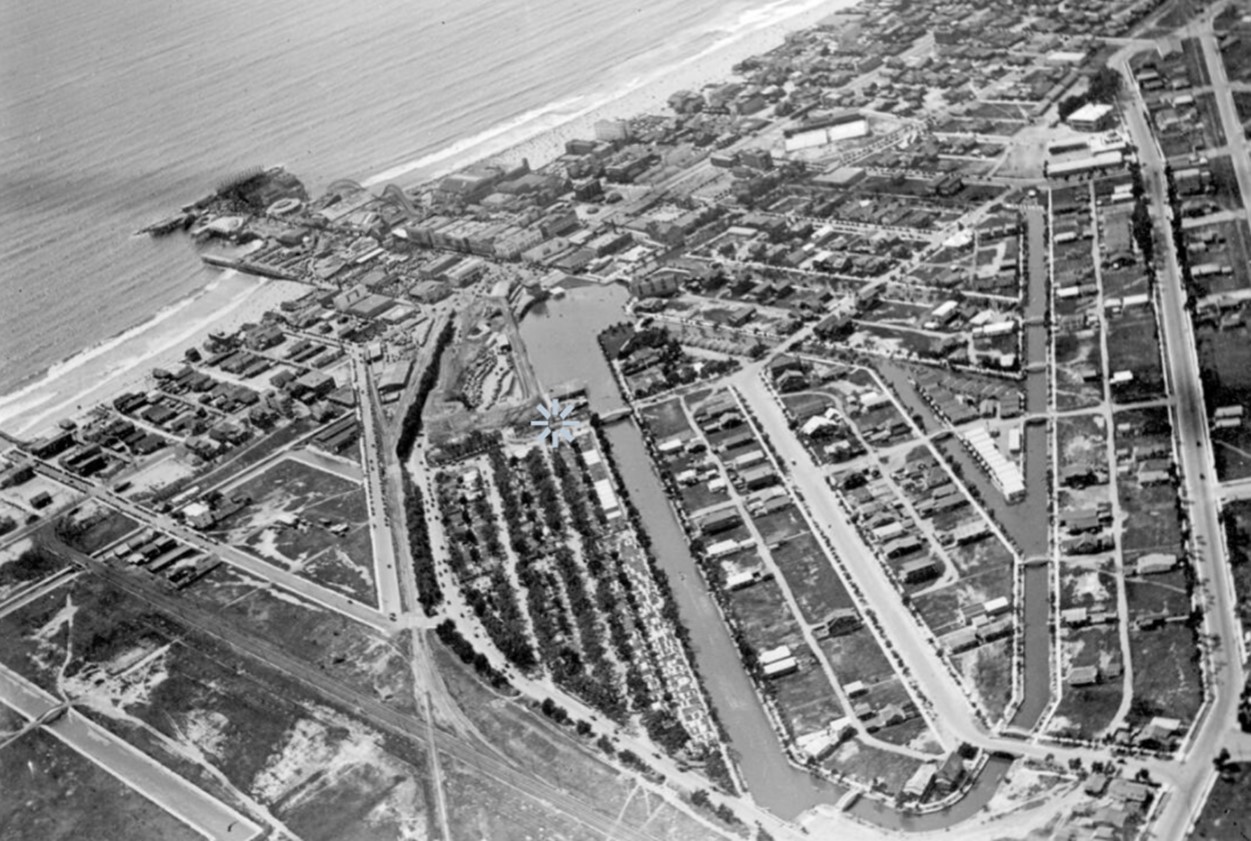 |
|
| (1918)* - Aerial view of looking west showing extent of the Venice Canals with Venice Pier at upper-left and the Venice Lagoon at top center. |
Historical Notes Before 1929, the area covered by canals was approximately three to four times as large as today. The entire area between Abbot Kinney, Pacific, and Venice Blvd. were canals. These canals were: Coral Canal (now Main St.), Cabrillo Canal (now Cabrillo Ave.), Venus Canal (now San Juan Ave.), Lion Canal (now Windward Ave.), Altair Canal (now Altair St.), Aldebaren Canal (now Market St.), and Grand Canal (now Grand Boulevard). |
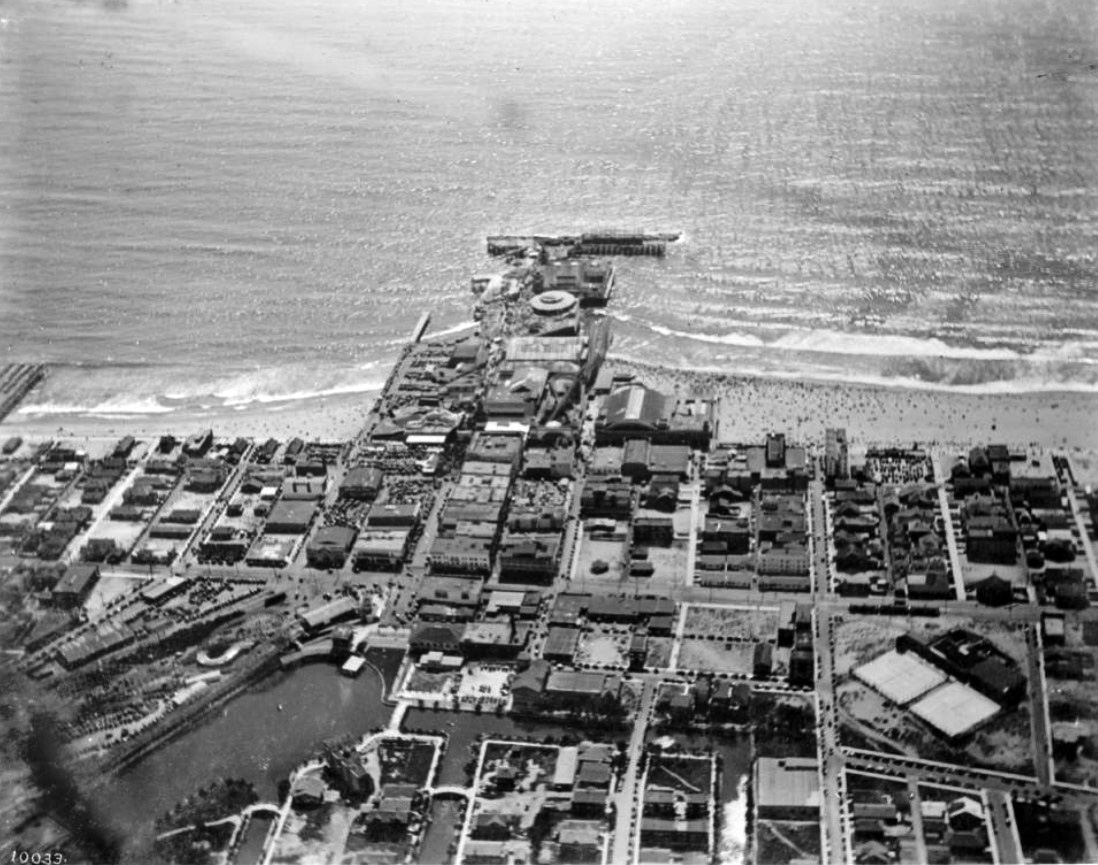 |
|
| (1918)* – Aerial view of the pier in Venice, looking west. At bottom of photo can be seen the Venice Lagoon and Canals. The Hotel Antler with its new large roof-mounted signboard can be made out at lower-left next to the lagoon. |
Historical Notes Today, the traffic circle at Pacific and Windward Avenues is located on top of what once was the Venice Lagoon. |
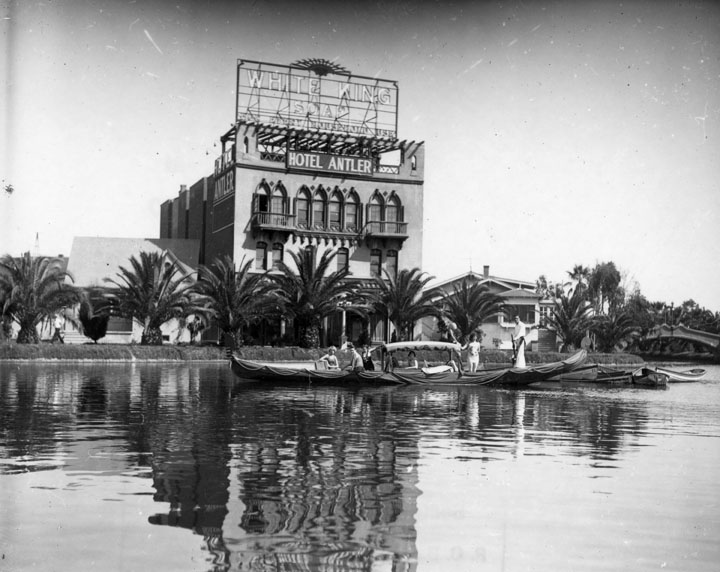 |
|
| (ca. 1920s)^ - View of gondola with several ladies on it, and a gondolier to steer, works its way across the canal. Behind them is the Hotel Antler. |
* * * * * |
Venice Miniature Railway
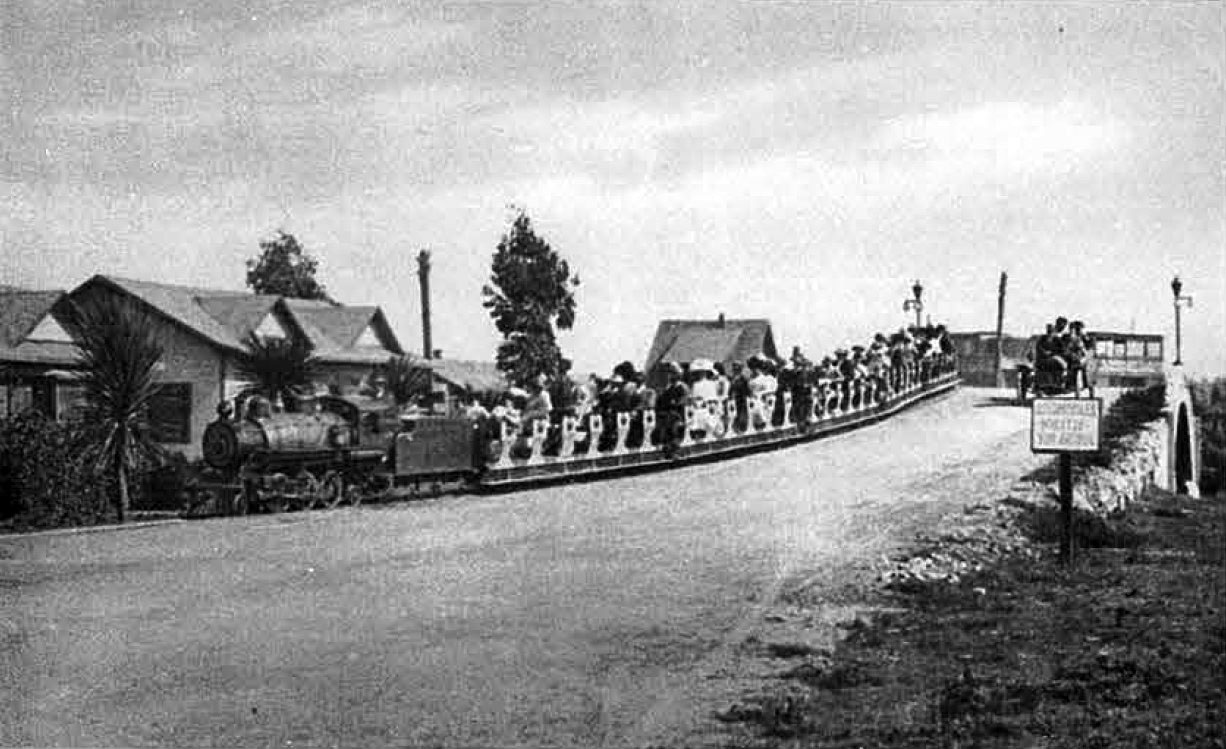 |
|
| (ca. 1905)* - View of the Venice Miniature Railway train crossing over a Venice Canal bridge on its way back to Windward Avenue at the Venice of America Amusement Park. |
Historical Notes When Abbot Kinney was building Venice in 1905, he decided that his new resort should have an internal transportation system to shuttle visitors and residents around town. He turned to John J. Coit who operated a successful eighteen inch gauge (1/3rd scale) miniature steam railroad at Eastlake Park (now Lincoln Park) in Los Angeles. He persuaded him to oversee the construction and management of a mile and three quarter long railroad that would take passengers from the Windward Avenue business district on a loop across canal bridges and through the canalled residential district, then return via a loop up Washington Boulevard, past its Lake Avenue maintenance yard and back to the Windward station along Mildred Avenue. |
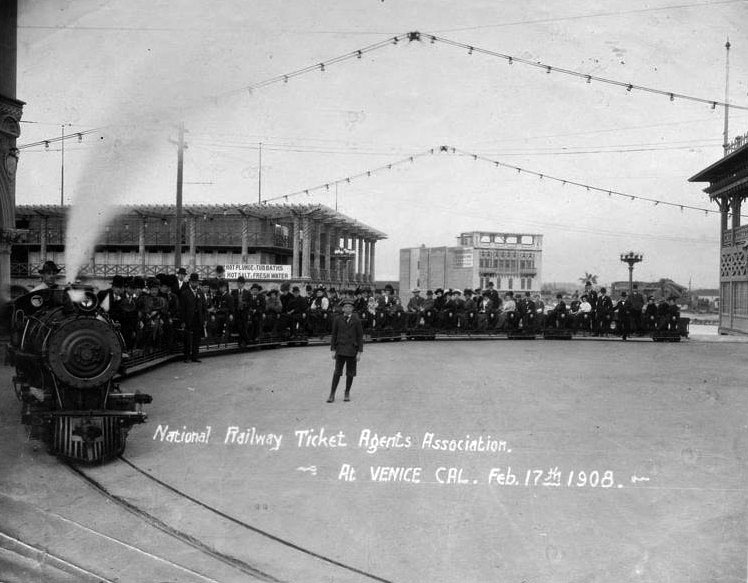 |
|
| (1908)^ - View of the Miniature Railroad Ride filled to capacity at the Venice Amusement Park. |
Historical Notes The cost of a trip around Venice was five cents, although residents could buy a book of tickets for $1.00 which made the run only two cents. At that time, it cost 15 cents to ride from Los Angeles to Venice on the Los Angeles Pacific Railway. |
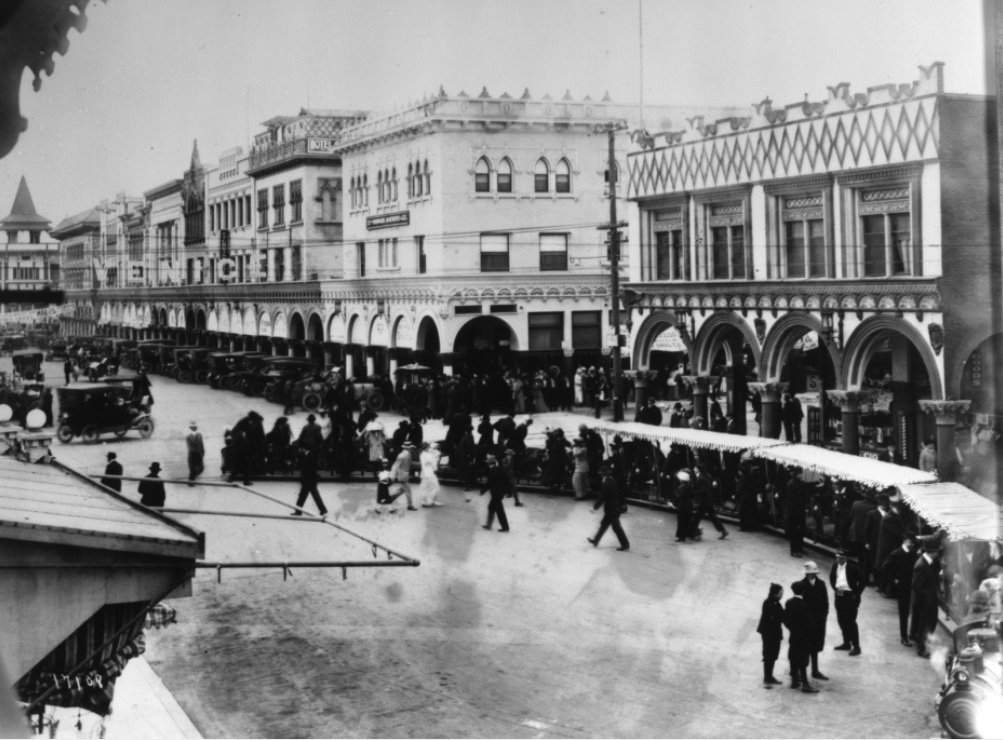 |
|
| (1910s)* – View looking west down Windward Avenue towards the ocean showing the Venice Miniature Railroad. |
Historical Notes Kinney installed the Venice Miniature Rail Road (V.M.R.R.) as both a tourist attraction and as a means to escort potential home builders and buyers to look at the subdivided parcels he was promoting. The train was very popular for its time, but it interfered with traffic. |
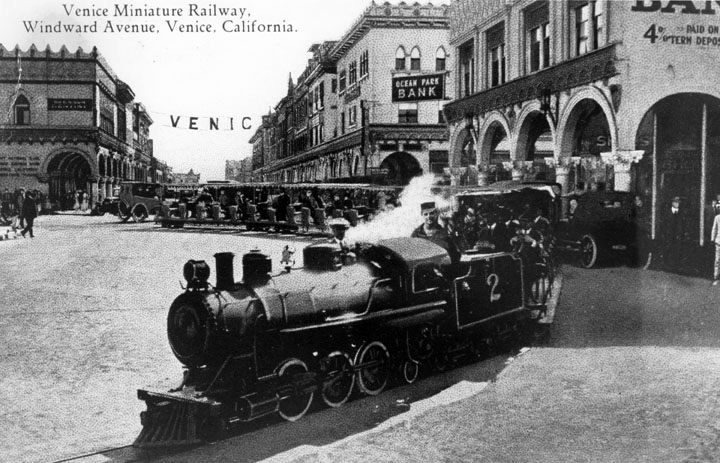 |
|
| (1912)* - Postcard view of the Miniature Railway on Windward Avenue in Venice. The miniature railroad would carry passengers for trips around the Venice streets, including Windward Ave. as shown here, and around the canal area. |
Historical Notes The Venice Miniature Railroad remained a popular ride and had run on weekends for twenty years. However, the train was opposed by merchants along its route on Washington Boulevard. In 1925, the city of Venice passed an ordinance that would prohibit miniature railroads from operating on streets, thus leading to the demise of the long running Venice Miniature Railroad. Click HERE to see more in Early Southern California Amusement Parks. |
* * * * * |
Windward Avenue
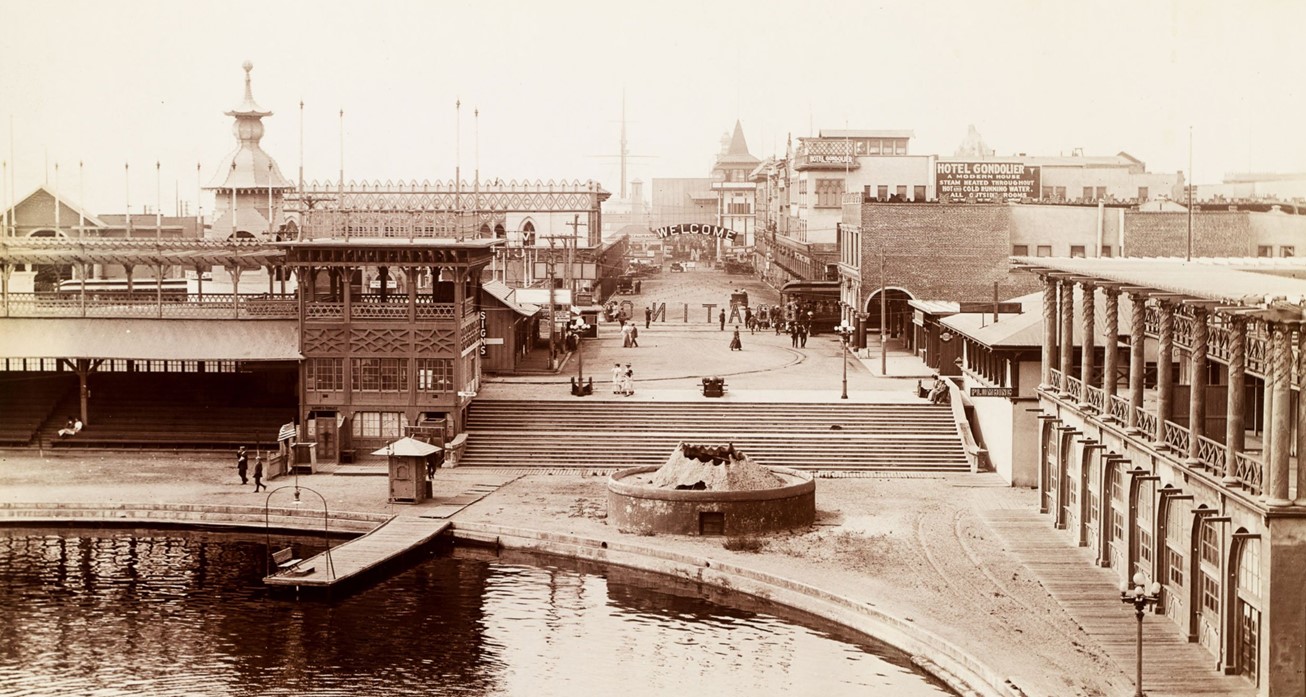 |
|
| (ca. 1906)* – View of Windward Avenue from the Venice Lagoon, with the Abbot Kinney Pier, Ship Café, and Auditorium visible in the distance. A sign reads: 'Hotel Gondolier, a modern house, steam heated throughout, with hot and cold running water.' The u-shaped tracks of the Venice Miniature Railroad are seen at the center of the image, with a streetcar stopped toward the center-right. Photo from the Ernest Marquez Collection. |
Historical Notes Windward Avenue, a key feature of early Venice, California, was envisioned by developer Abbot Kinney as the central artery of his grand Venice of America project, which opened in 1905. Modeled after its namesake in Italy, Kinney sought to bring the charm of European canals and culture to Southern California. The avenue stretched from the Venice Lagoon (now Windward Circle) to the Pacific Ocean, functioning as both a commercial hub and a picturesque promenade. |
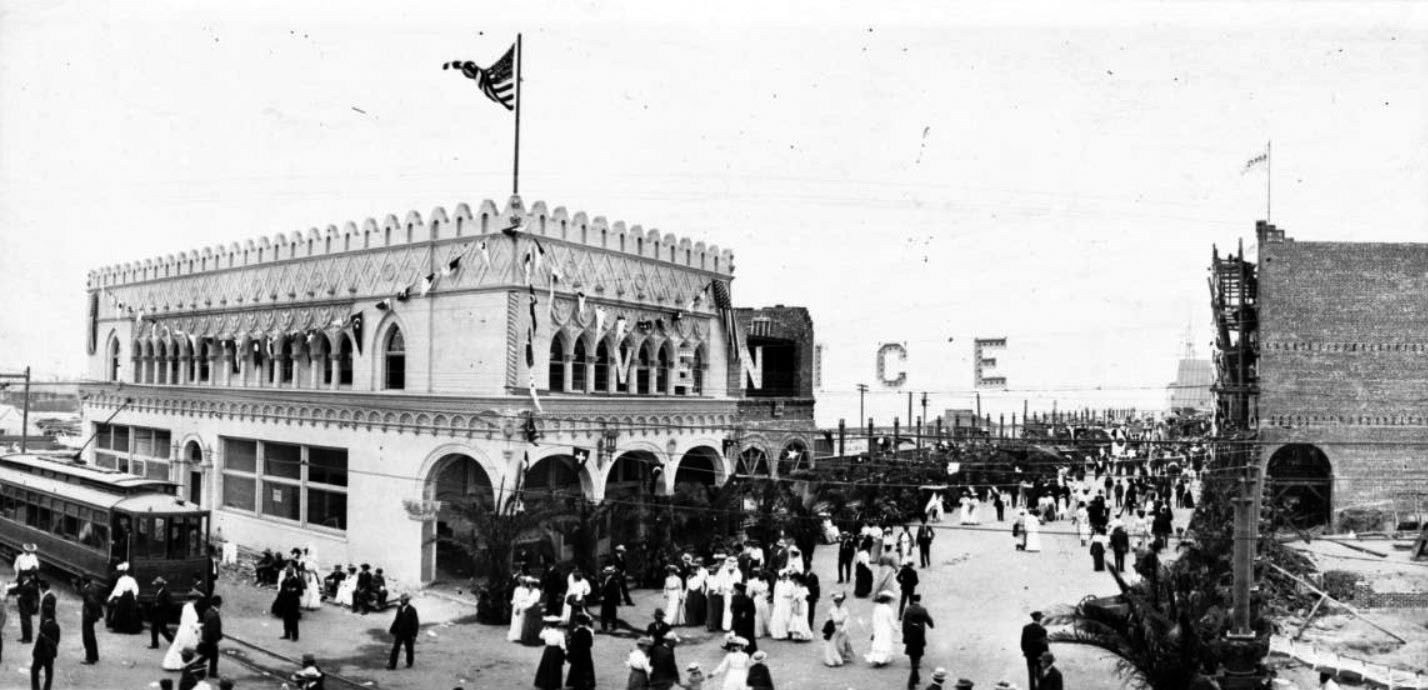 |
|
| (ca. 1905)* - Panoramic view showing a streetcar passing by a crowded pier in Venice. A wide walkway intersects perpendicularly with the train tracks, and hundreds of people can be seen walking on the road. This would be called Windward Avenue, also known as "The Gateway to Venice." |
Historical Notes In 1905, the founding year of Venice, Windward Avenue was two blocks long, stretching between the canal system and the pier, lined with hotels that featured hot salt water in every room. |
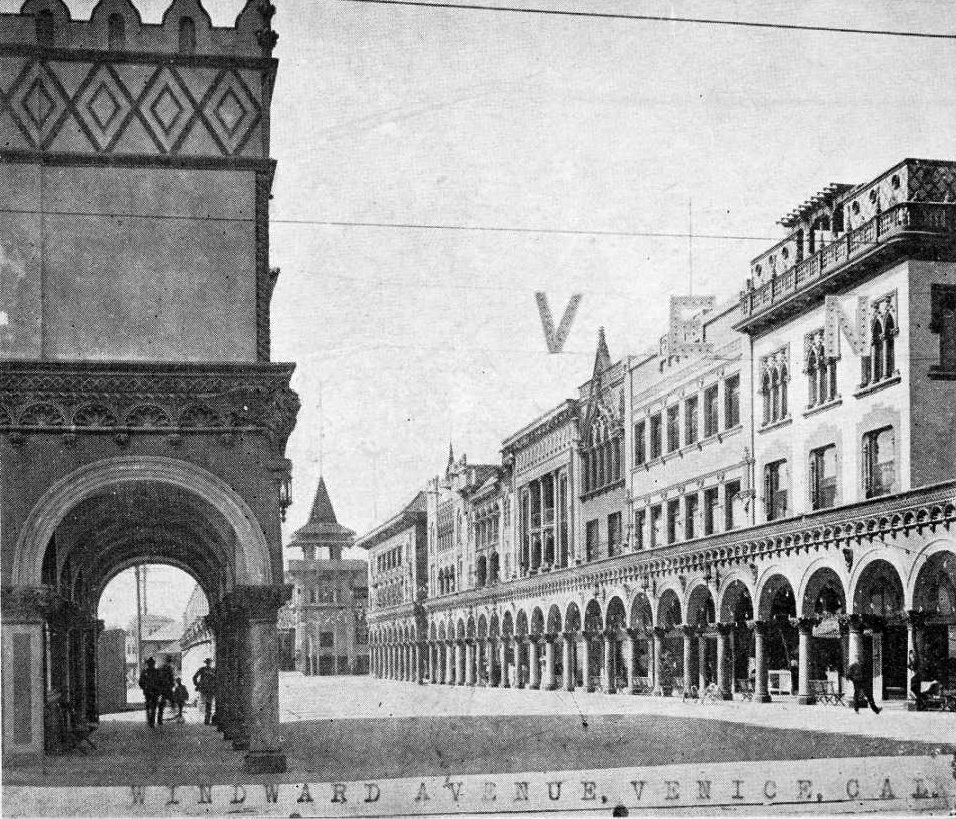 |
|
| (ca. 1905)^^ - Postcard view looking east on Windward Avenue in Venice. |
Historical Notes The Venice, Italy-inspired architecture of Windward Avenue was the whole advertising gimmick which brought Angelinos from downtown out to the Venice Beach area in the first place (back in 1905! It was quite a trek back then; a good gimmick was definitely NEEDED to pull folks away from the then-popular Downtown LA district. |
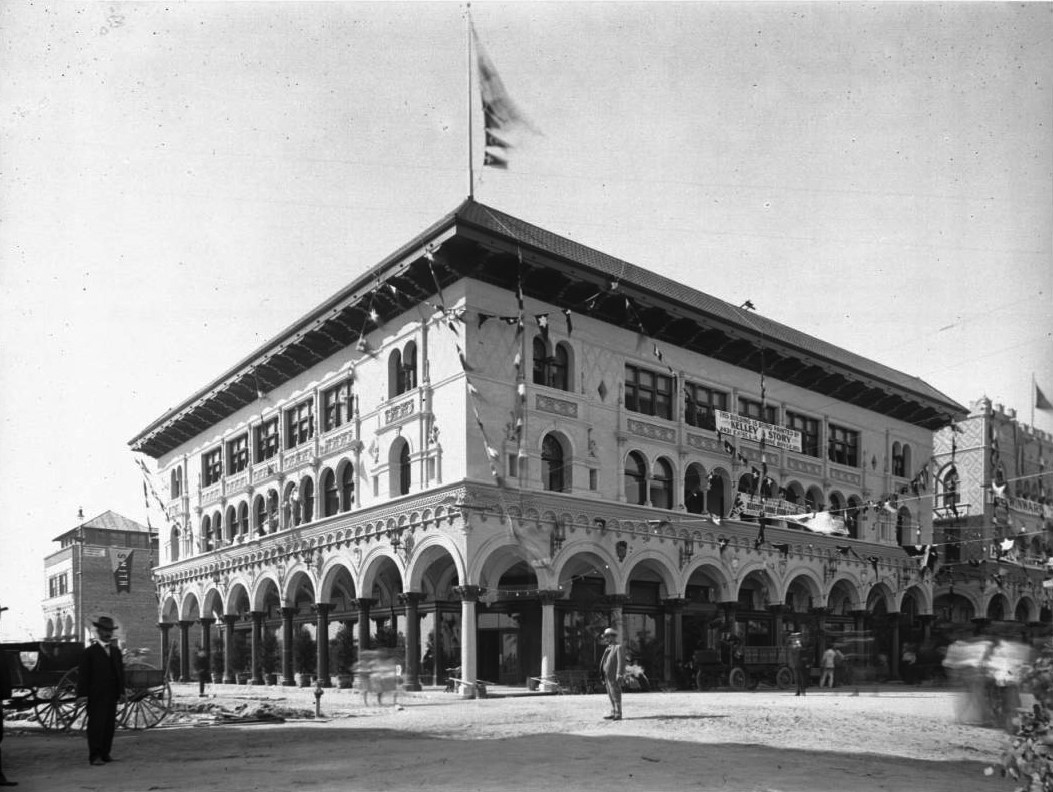 |
|
| (1905)^^ - View showing the newly constructed Saint Mark's Hotel on Windward Avenue at Ocean Front in Venice. The 3-story building has a two colonnades topped with arches supporting the roof over the sidewalk on two sides. Streams of banners fly from the roof of the hotel. |
Historical Notes Ground was broken for the St. Mark's Hotel on December 5,1904. It was one of Venice's original buildings and stood until 1964 when it was demolished. |
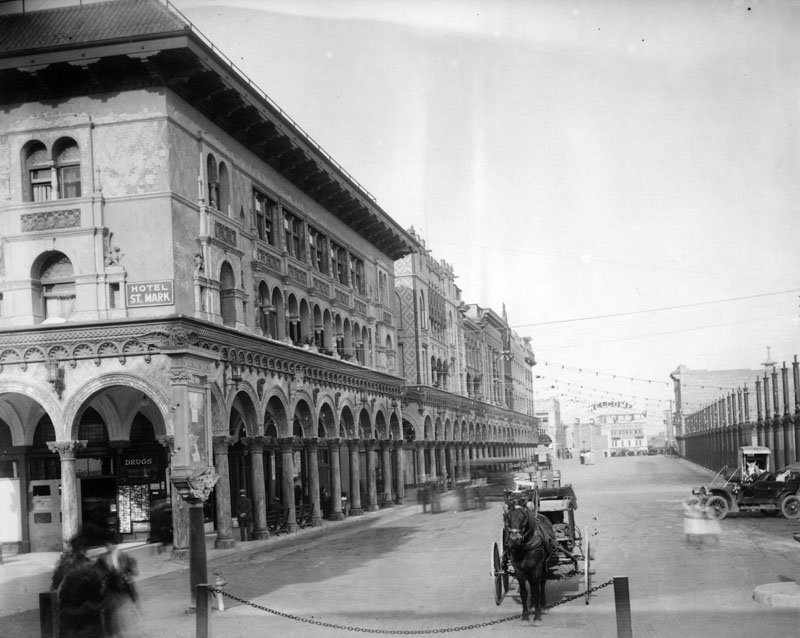 |
|
| (1906)^ - View looking west on Windward Avenue with the St. Mark's Hotel at left. A horse-drawn wagon is in the foreground. |
Historical Notes In 1906, Windward Avenue was built-up on the north side, but not the south side. The south side didn't really come into its own until prohibition came along and fancy basements were constructed.^ |
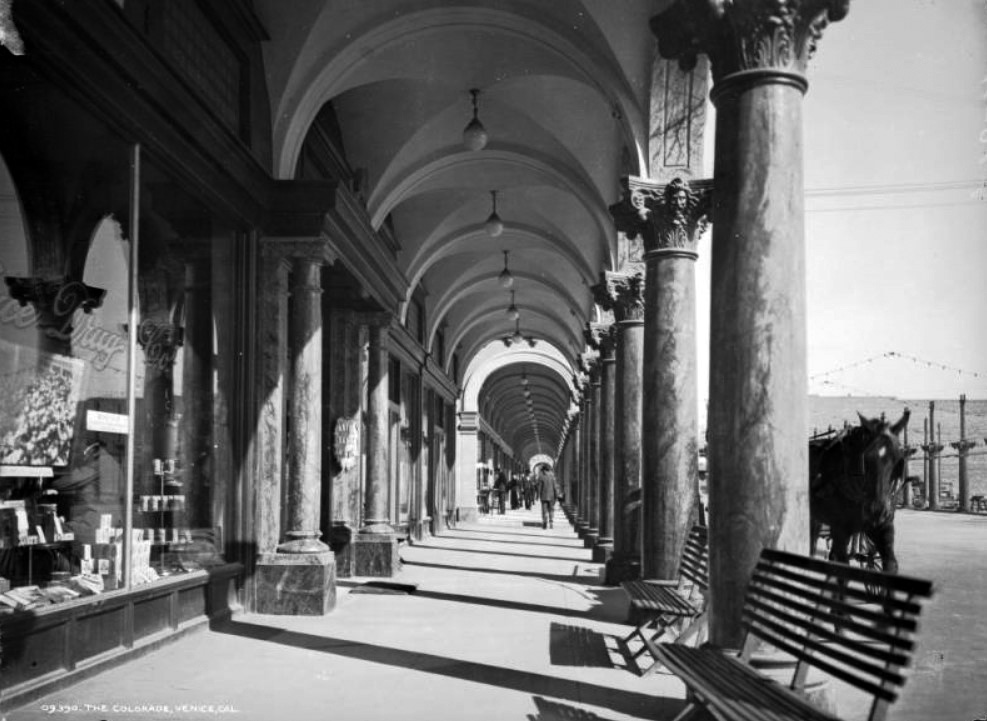 |
|
| (ca. 1906)^ - View of the colonnade at St. Mark's Hotel in Venice showing pedestrians on the sidewalk, a horse, wooden benches, and a man behind a window. Signs read: "(?) Drug Co." "Ice cream" "Hotel Saint Mark." |
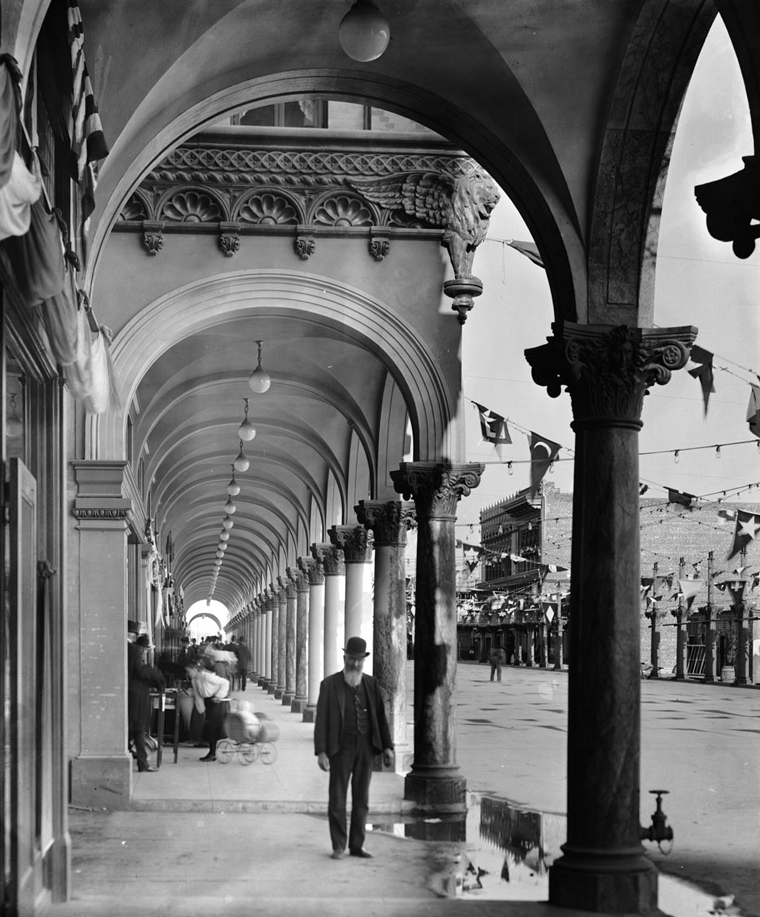 |
|
| (ca. 1906)* - View of the Saint Mark's Hotel on Windward Avenue in Venice Beach. An outdoor corridor houses a street arcade. A man with a beard stands in the foreground near one of the many pillars and arches forming the corridor. |
Historical Notes The colonnade, made up of dozens of Corinthian columns supporting Venetian-style arcade buildings on Windward, Pacific, and Market avenues, still serves as the gateway to the city and is one of Venice's most recognizable landmarks. |
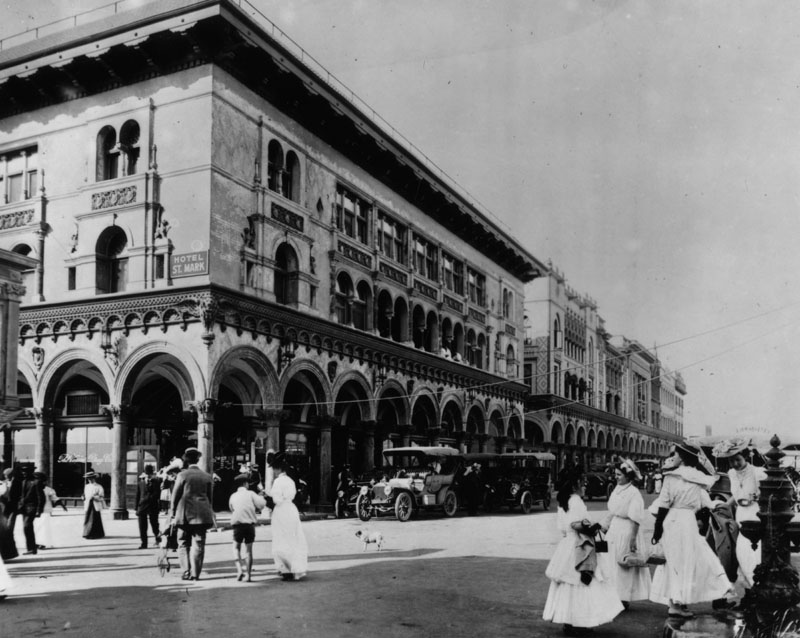 |
|
| (ca. 1906)^ - A corner view of the exterior of a business building on Windward Avenue in Venice which includes the St. Mark's Hotel. |
Historical Notes When Venice was constructed in 1905, the business district utilities were placed underground in two tunnels running beneath the alleys on either side of Windward Avenue. The two tunnels originated at the heating plant and powerhouse located on Windward near the lagoon (current site of the B of A building near the traffic circle). In addition, some hotels along Ocean Front Walk constructed tunnels beneath the promenade to the beach because an ordinance forbid bathing suits on the boardwalk. The St. Mark's Hotel at the corner of Windward was one. During Prohibition in the 20's, rum runners would unload their booze from boats beneath the pier and sneak them into the St. Mark's tunnel. |
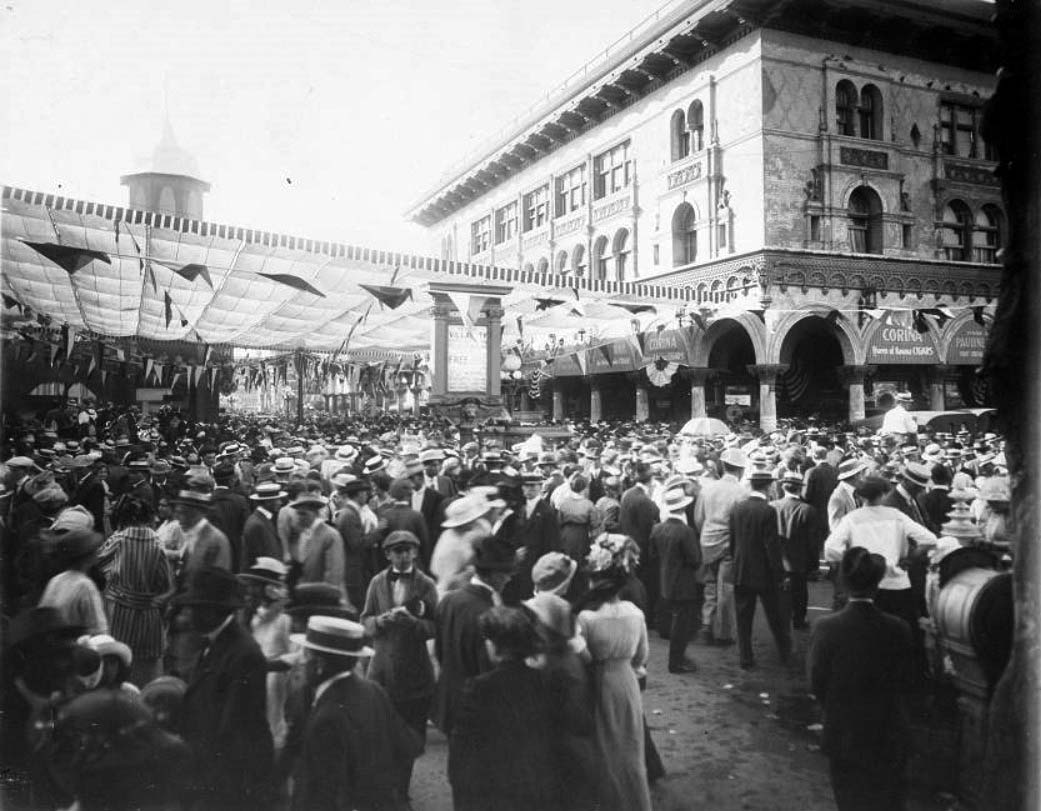 |
|
| (ca. 1910)* – View showing a large gathering of people in front of the St. Mark's Hotel. |
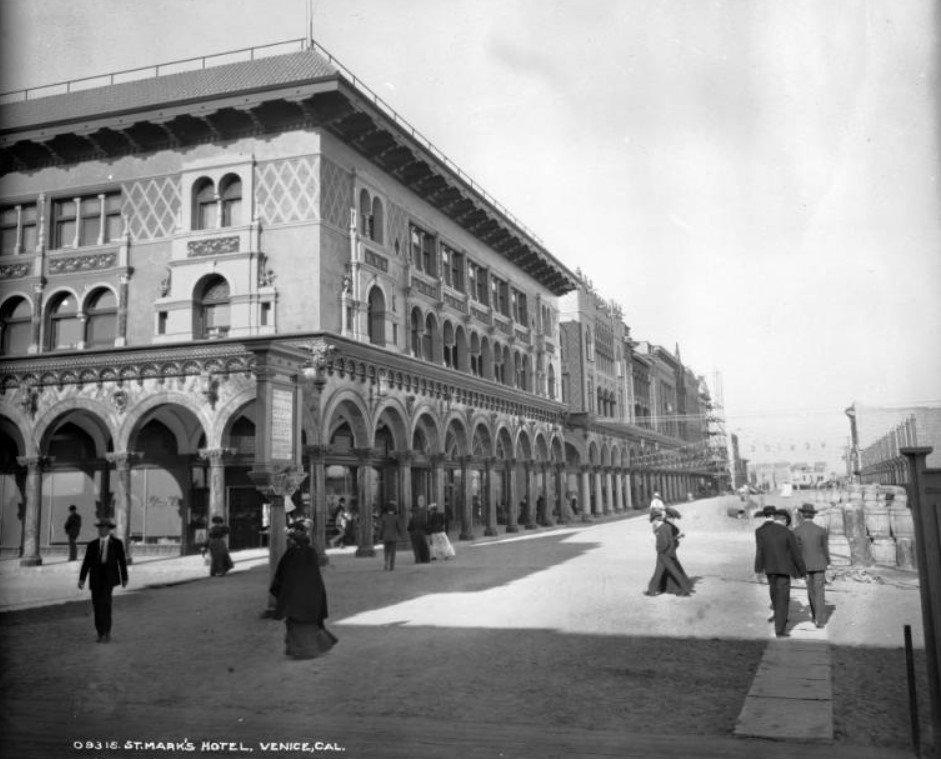 |
|
| (ca. 1910)* - Pedestrians walk in the street near St. Mark's Hotel. The Romanesque style building has arched windows and an arched colonnade. Signs read: "Venice Events, Dancing" and "Venice." |
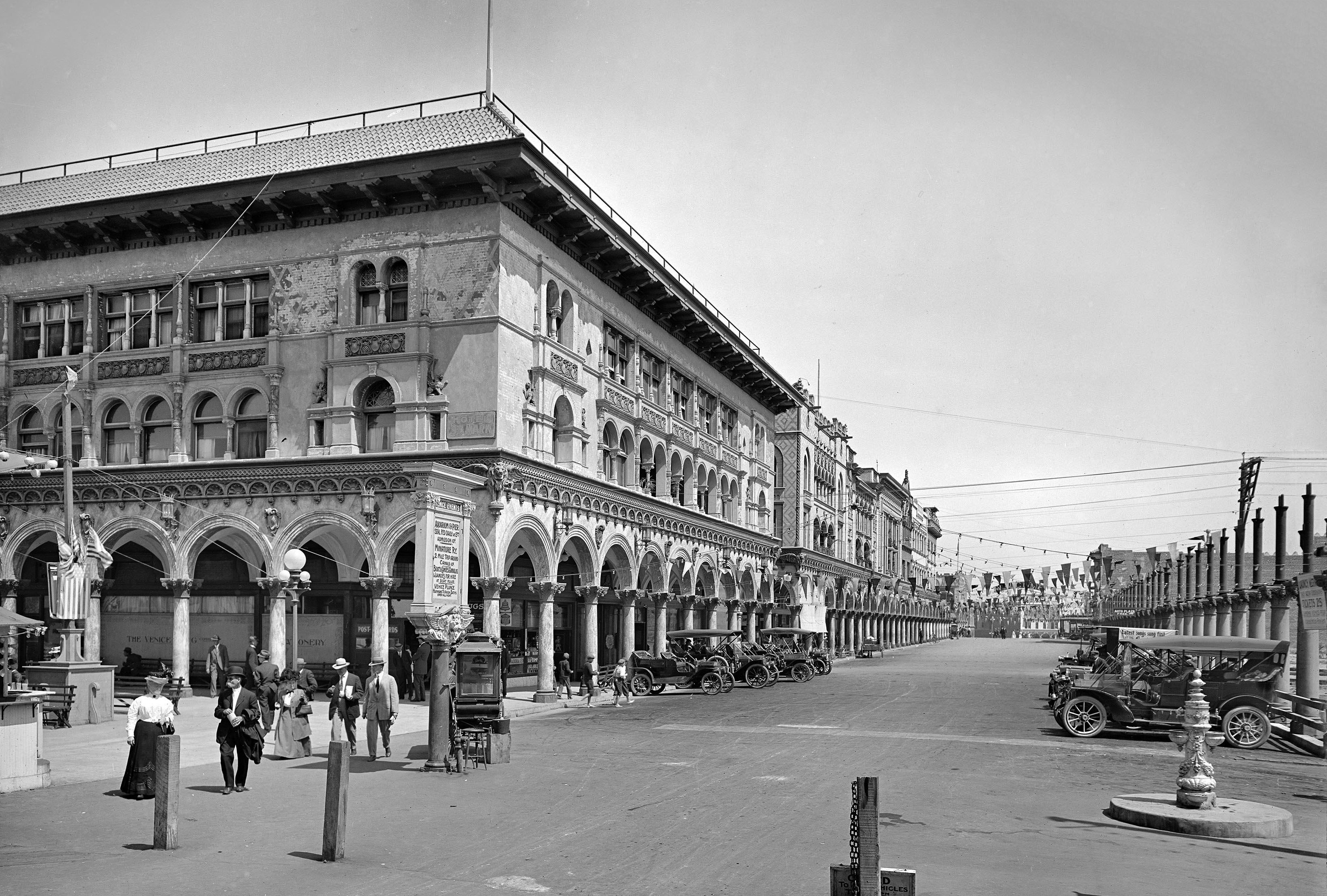 |
|
| (ca. 1912)* - A corner view of the St. Mark’s Hotel and the colonnade with its Corinthian columns extending two blocks down Windward Avenue. Photo: Library of Congress |
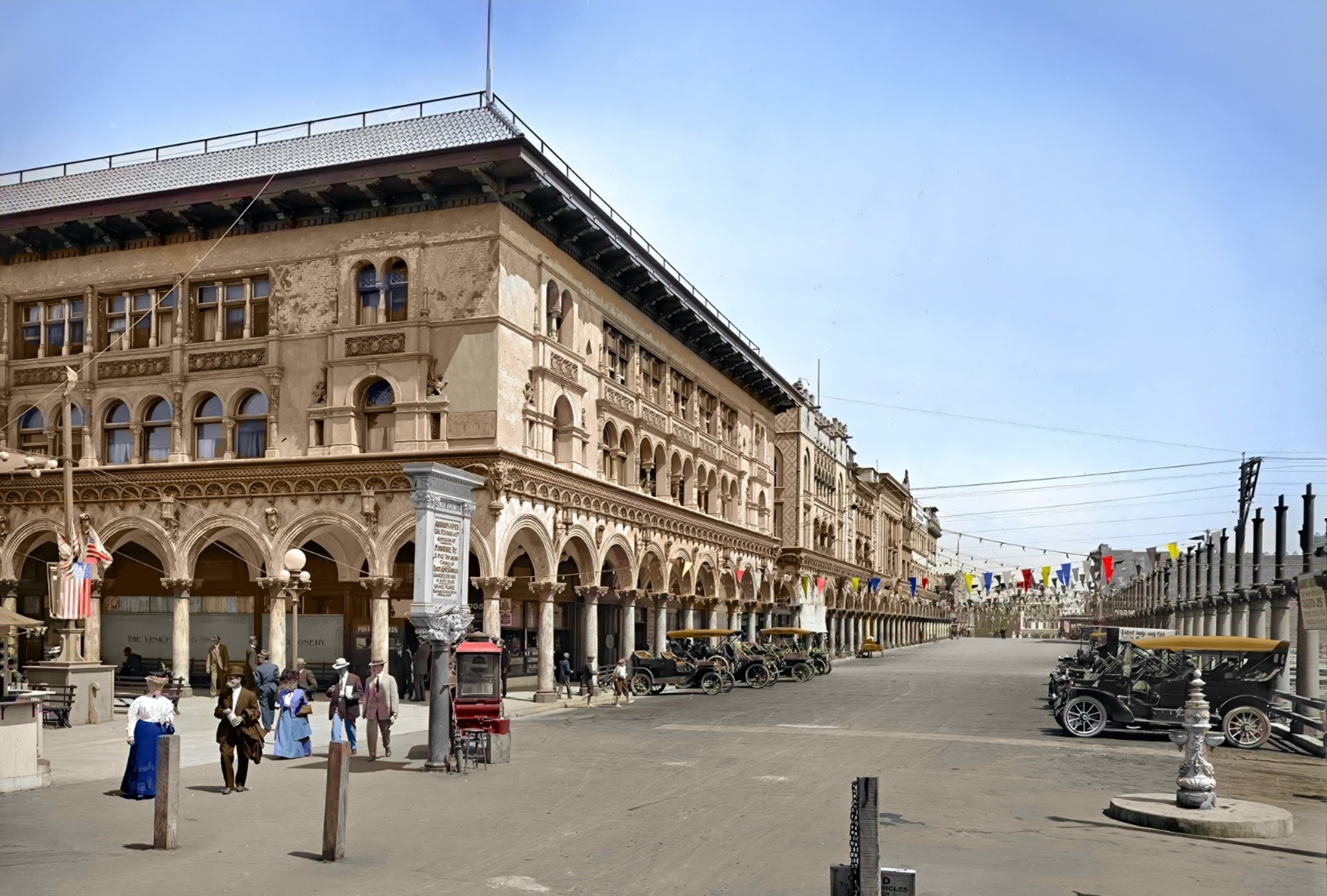 |
|
| (ca. 1912)* - A corner view of the St. Mark’s Hotel and the colonnade with its Corinthian columns extending two blocks down Windward Avenue. Photo: Library of Congress; Image enhancement and colorization by Richard Holoff |
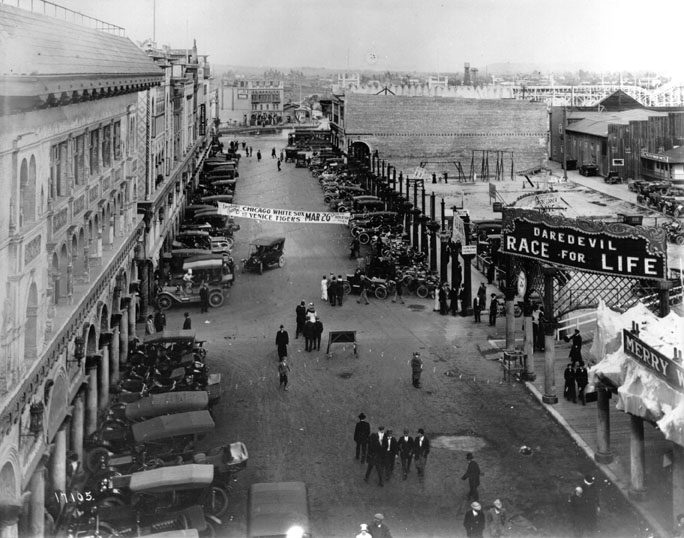 |
|
| (1913)^ - Looking from a roof at the end of Windward in Venice, one can see the street below and in the distance the piers along the ocean. A banner across the street announces a baseball game between the Chicago White Sox and the Venice Tigers. Click HERE to see more on the Venice Tigers in Baseball in Early L.A. On the right hand side of the street you can enter attractions such as the Daredevil Race for Life and the Merry Widow. |
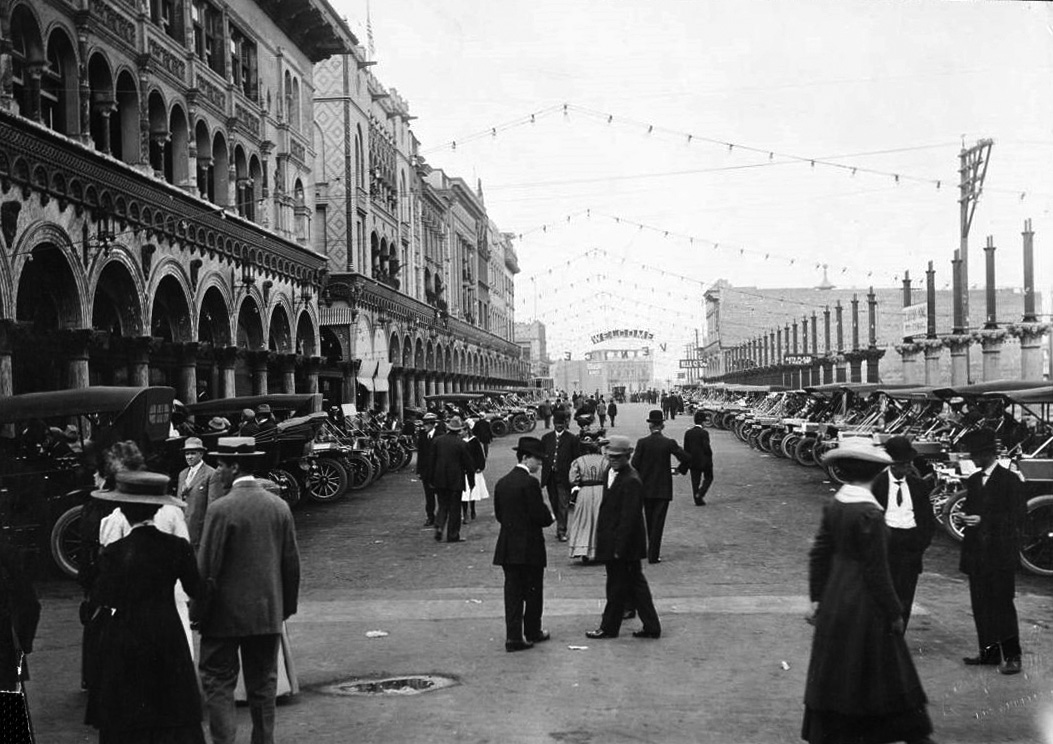 |
|
| (ca. 1915)* – View looking west on Windward Avenue showing well-dressed men and women walking down the center of the street. Buildings on the right have yet to be completed. |
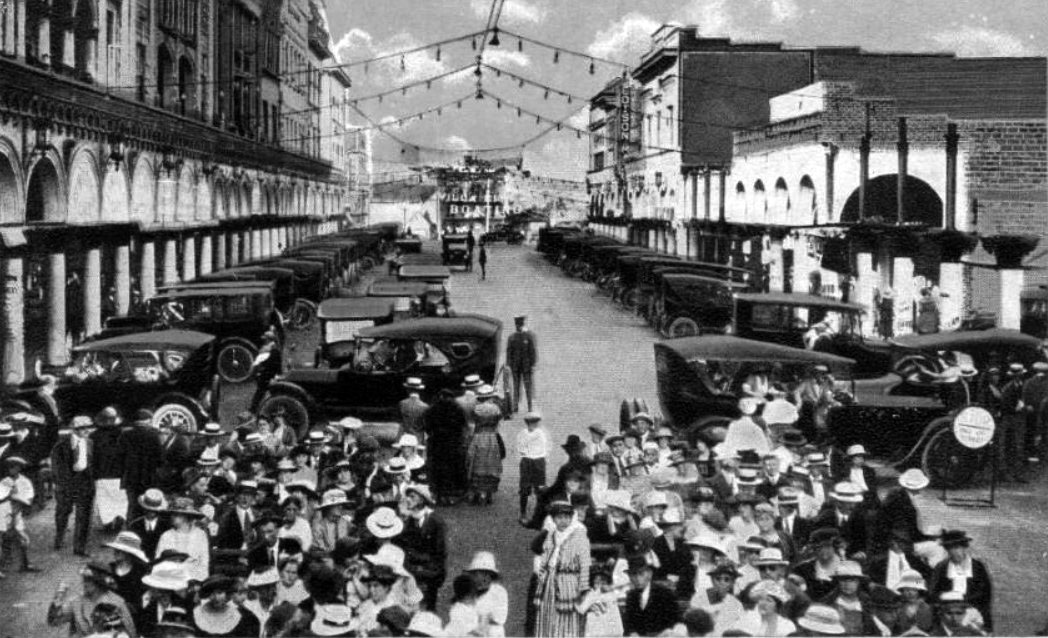 |
|
| (ca. 1920)* – Postcard view showing a large group of people waiting in line on Windward Avenue, Venice. The street behind is full of parked vehicles. |
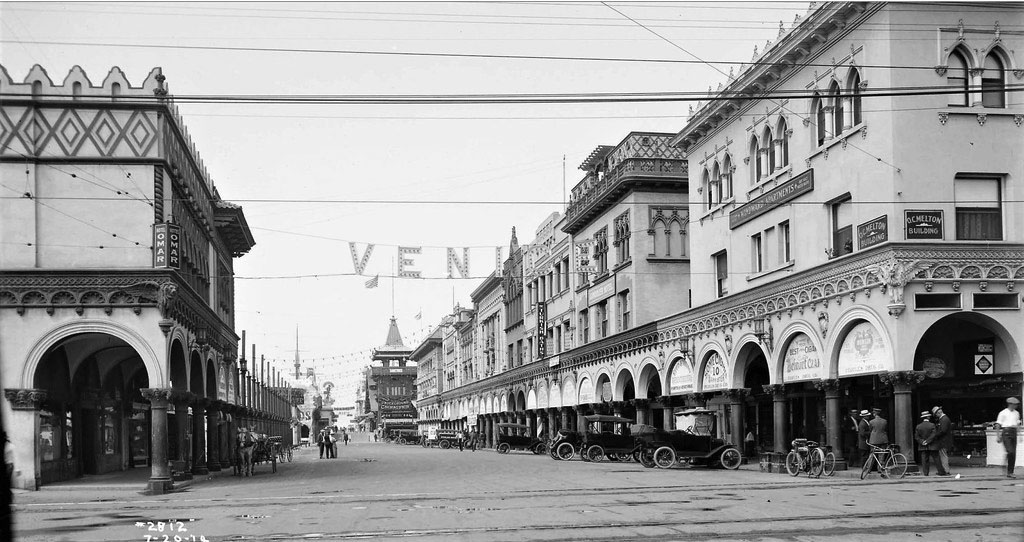 |
|
| (1914)* – View looking west on Windward Avenue showing a Turkish Bath House, theaters, an apartment house, automobiles, motorcyle, and bicycles parked along the street. The Hotel Omar is seen at left. |
.jpg) |
|
| (ca. 1910s)* – Sailors on shore leave venture down Windward Avenue in Venice. |
.jpg) |
|
| (1914)* – Detailed view looking west on Windward Ave with double decker bus seen on the left. Autos, motorcycle, and cars are parked on the right in front of the Windward Apartments. |
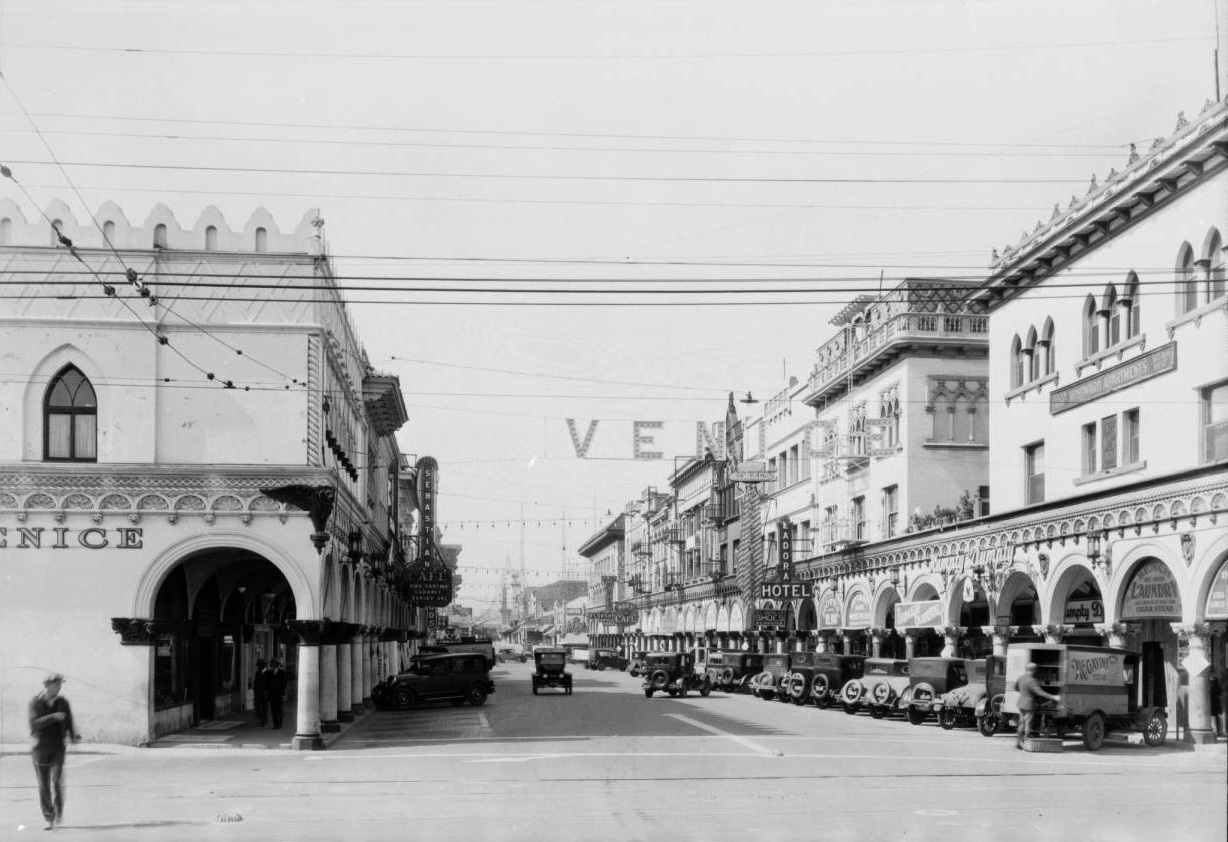 |
|
| (ca. 1929)^^ - View looking west of Windward Avenue in Venice Beach, showing cars parked diagonally along the side of the road. The two-lane paved street runs is lined by two-story buildings at left and three-story buildings at right. Both sets of buildings have covered arcades in front of them. The buildings are light-colored and house shops, hotels, and restaurants. A sign that says "Venice" is suspended over the street. Legible signs include, from left: "Sebastian Café Ming Dancing Cabaret Dorsey Orc.", "The Florsh Shoe", "United", "Mars Café", "Ladora Hotel", "W. L. Douglas Shoes", "Hotel Del Mar", "Men's Wear", "Humpty Dumpty", "Beach Soft Water Laundry Cigar Stand". |
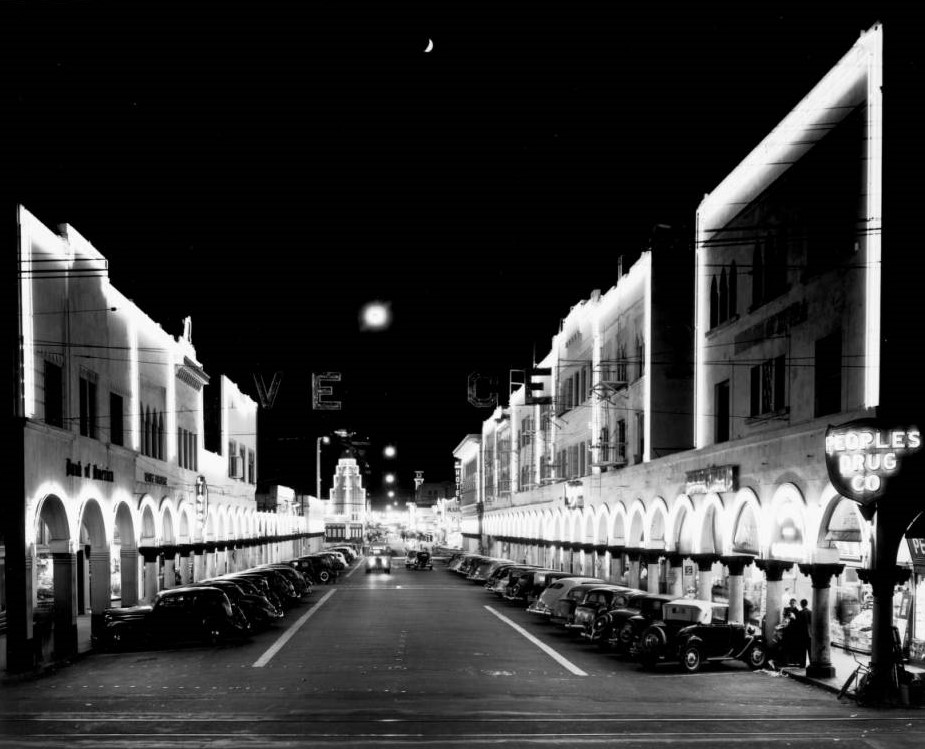 |
|
| (1939)* – View showing a brightly lit Windward Avenue at night. Photo by Dick Whittington |
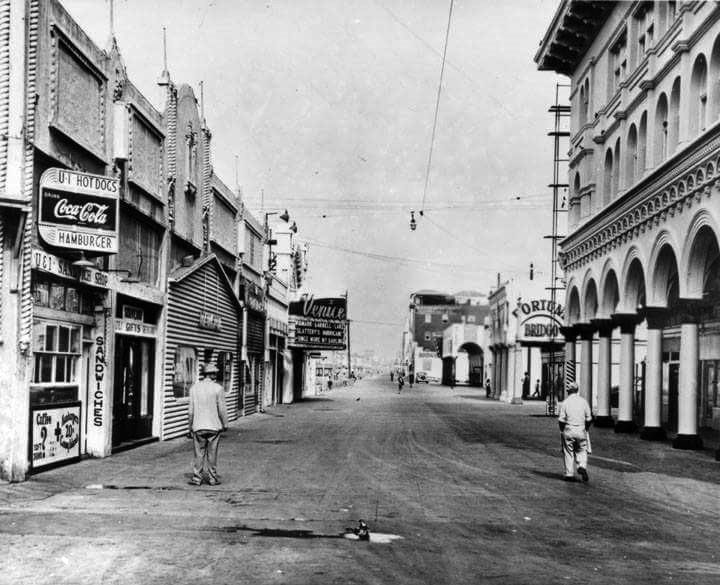 |
|
| (1949)^ – Two men are seen walking along a near-empty Ocean Front at Windward Avenue. The St. Mark's Hotel is on the right (NE Corner) and In the distance can be seen the Venice Theater*. |
Historical Notes The Venice Theatre opened in 1920 as the California Theatre on the water side of Ocean Front Walk. The location was between Windward Avenue and Market St. (formerly called Zephyr). In the 1923-24 directory it's listed at 1506 Ocean Front Walk. |
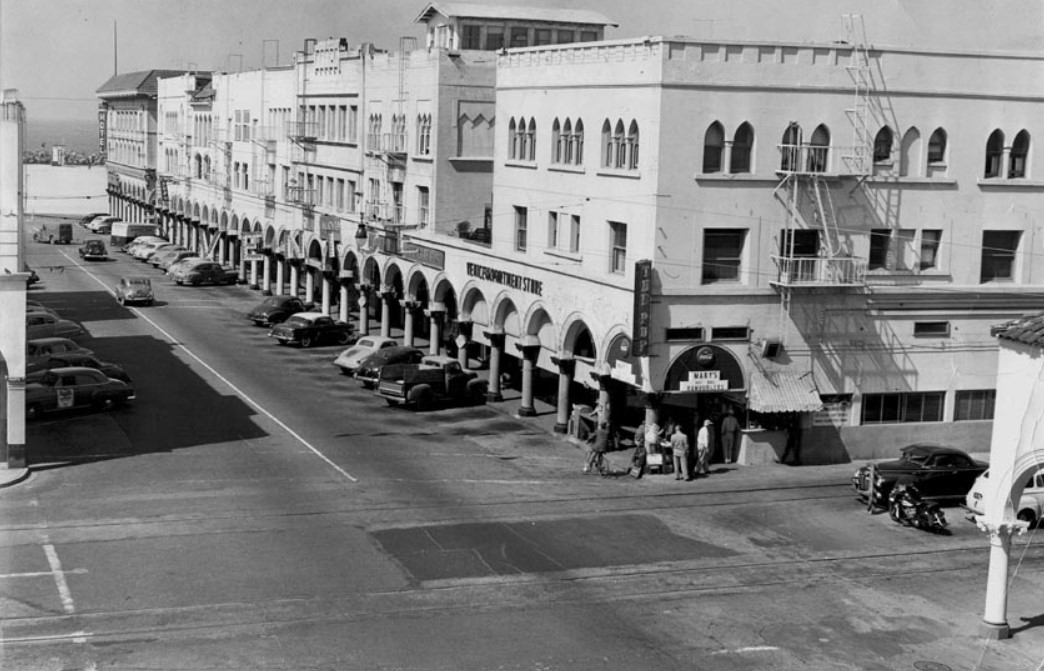 |
|
| (1953)^ – View looking west at Windward Avenue in Venice – Looking towards site of pier. |
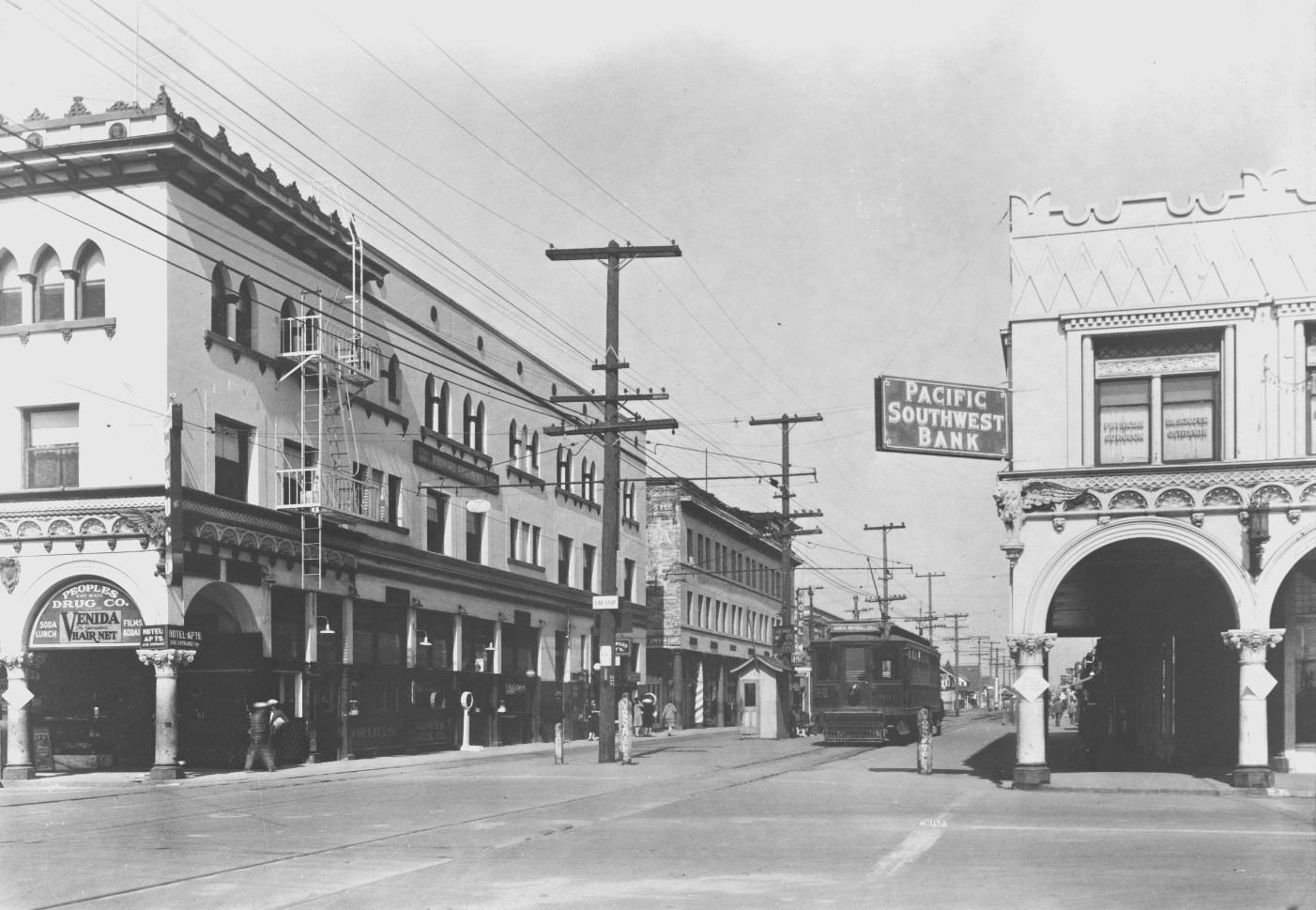 |
|
| (n.d.)* - Windward and Trolley Way (Pacific Avenue) with Pacific Southwest Bank on the right, People's Drug Store and Windward Apartments on the left. |
Historical Notes On plat maps for the neighborhood Trolley Way is also referenced as Electric Avenue, which makes sense as the train cars operating on it were electric. |
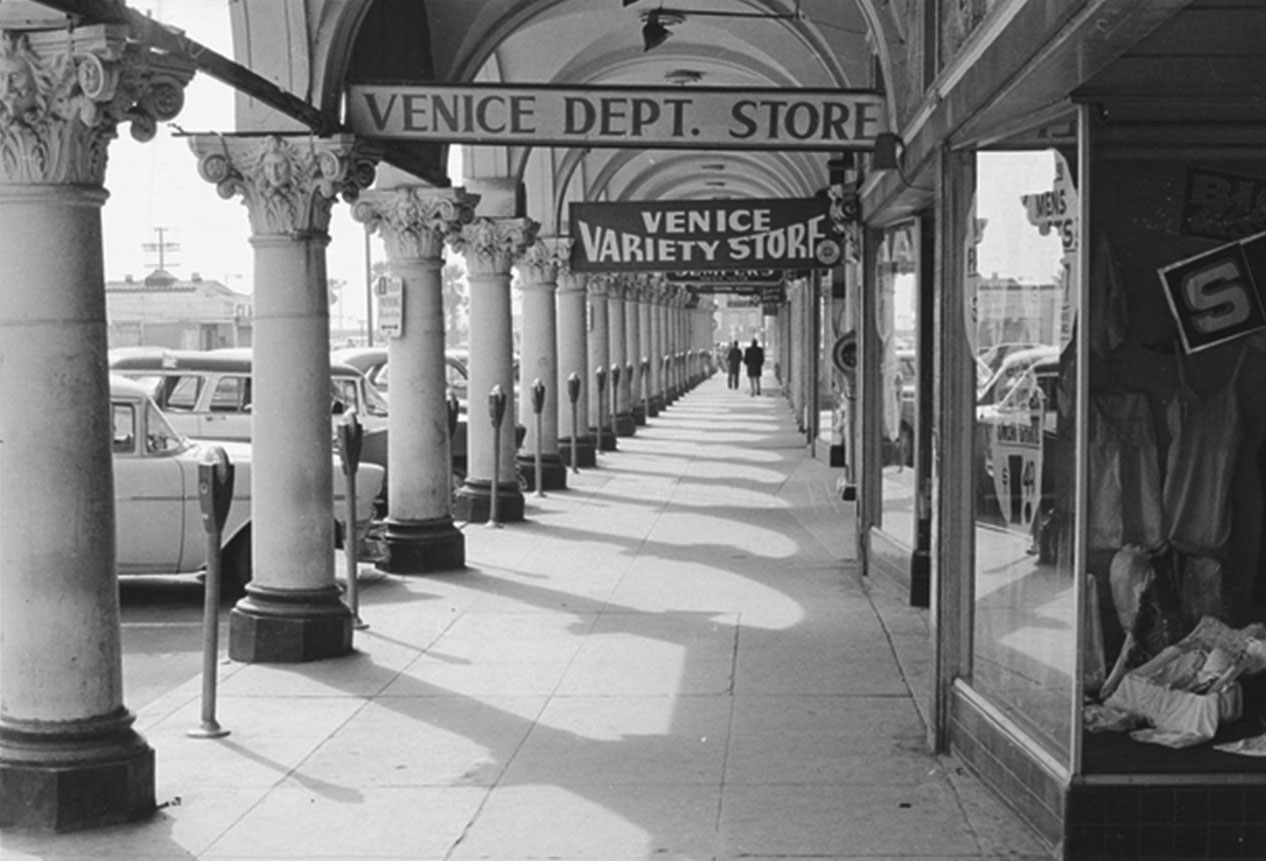 |
|
| (1950s)* - Windward Avenue in Venice Beach...mid 1950's. |
Then and Now
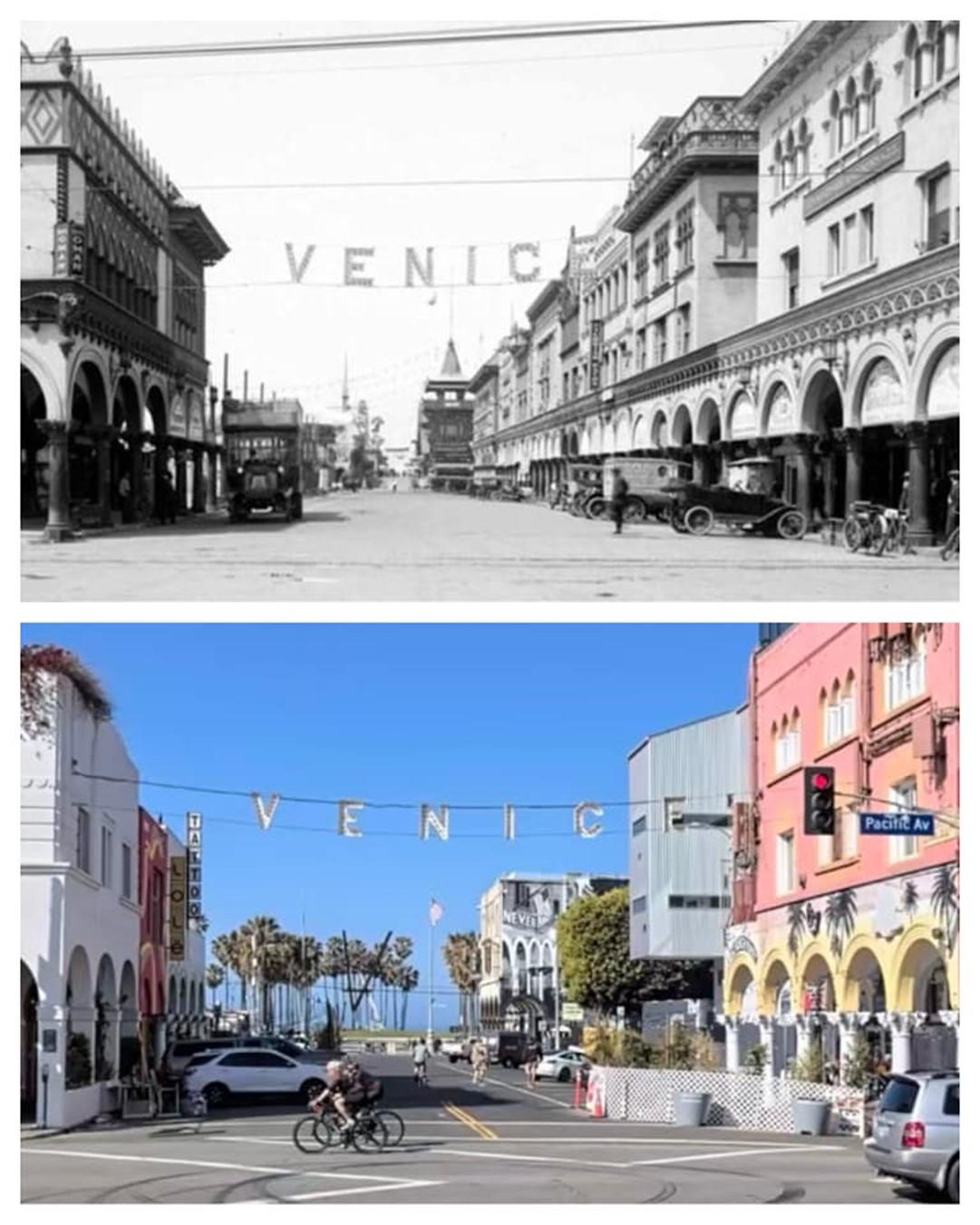 |
|
| (1914 vs 2023)* - Windward Avenue looking west at Pacific Avenue. Photo comparison by Trey Callaway |
Then and Now
 |
|
| (1914 vs 2023)* - Windward Avenue looking West. Contemporary image taken by @mileschatterji. Photo comparison by Jack Feldman. |
* * * * * |
Ocean Front Walk and Windward
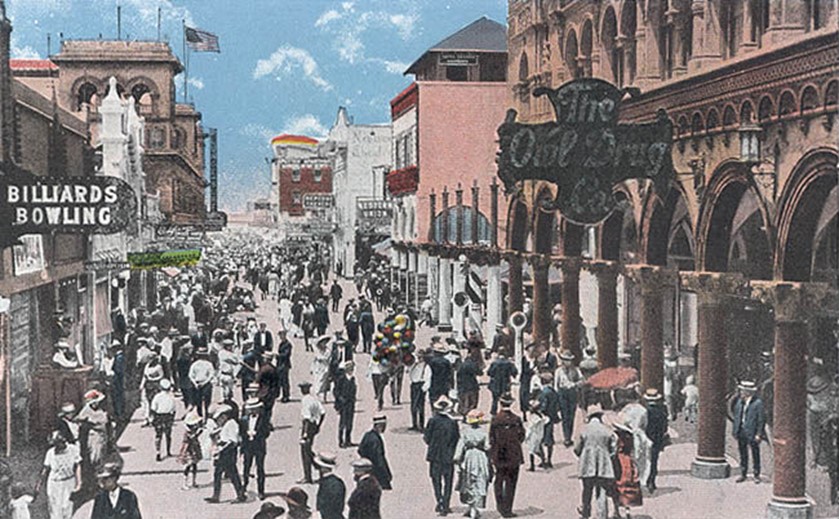 |
|
| (ca. 1921)* – Postcard view looking north on Ocean Front Walk from Windward Avenue. That green thing sticking out on the left just beyond the "Billiards Bowling" sign is the marquee of the California Theatre. You can see a bit of the big white arch of the facade. The large structure just beyond the theatre is the Plunge, once advertised as the largest indoor saltwater pool in the world. On the right it's the St. Mark's Hotel at Windward and Ocean Front. Down in the next block on the right there's a glimpse of the arches of the facade and the protruding signage at the Neptune Theatre. |
Historical Notes In the early 1920s this stretch was the show window of “Venice of America,” lined with arcades, hotels, cafés, and amusements that Abbot Kinney had clustered at the foot of Windward Avenue. At left, the green blade sign marks the California Theatre, which opened July 1, 1920 on the water side of Ocean Front Walk, built on the former site of the scenic railway. Just beyond stood the Venice Plunge, a vast indoor salt-water bath house; contemporary sources described a 150×100-foot pool and roughly 1,500 dressing rooms to handle the crowds. On the right is the St. Mark’s Hotel; a block up on the right you can glimpse the arches and projecting sign of the Neptune Theatre, a vaudeville and movie house that first opened as Hyman’s Theatre in 1911. The postcard freezes Venice at a peak moment: only months earlier (December 20, 1920) a fire had destroyed the wooden Abbot Kinney Pier at the end of Windward Avenue, but Ocean Front Walk carried on as the district’s main midway. |
 |
|
| (1923)* - Firefighters march in parade on Ocean Front Walk in Venice. Neptune Theatre in background, Strand Cafe and Mecca Cafe in foreground. |
Historical Notes Holiday and publicity parades were constant on Ocean Front Walk during the 1910s–30s—a mix of marching bands, floats, lifeguards, athletes, and film personalities—staged to bring crowds to the arcades and cafés along the colonnades. This 1923 view, with the Neptune Theatre behind the line of firefighters and restaurants like the Strand and Mecca in front, captures how civic spectacle and seaside commerce fed each other: Ocean Front Walk doubled as both promenade and parade route, and Windward Avenue was often roped off for street carnivals. |
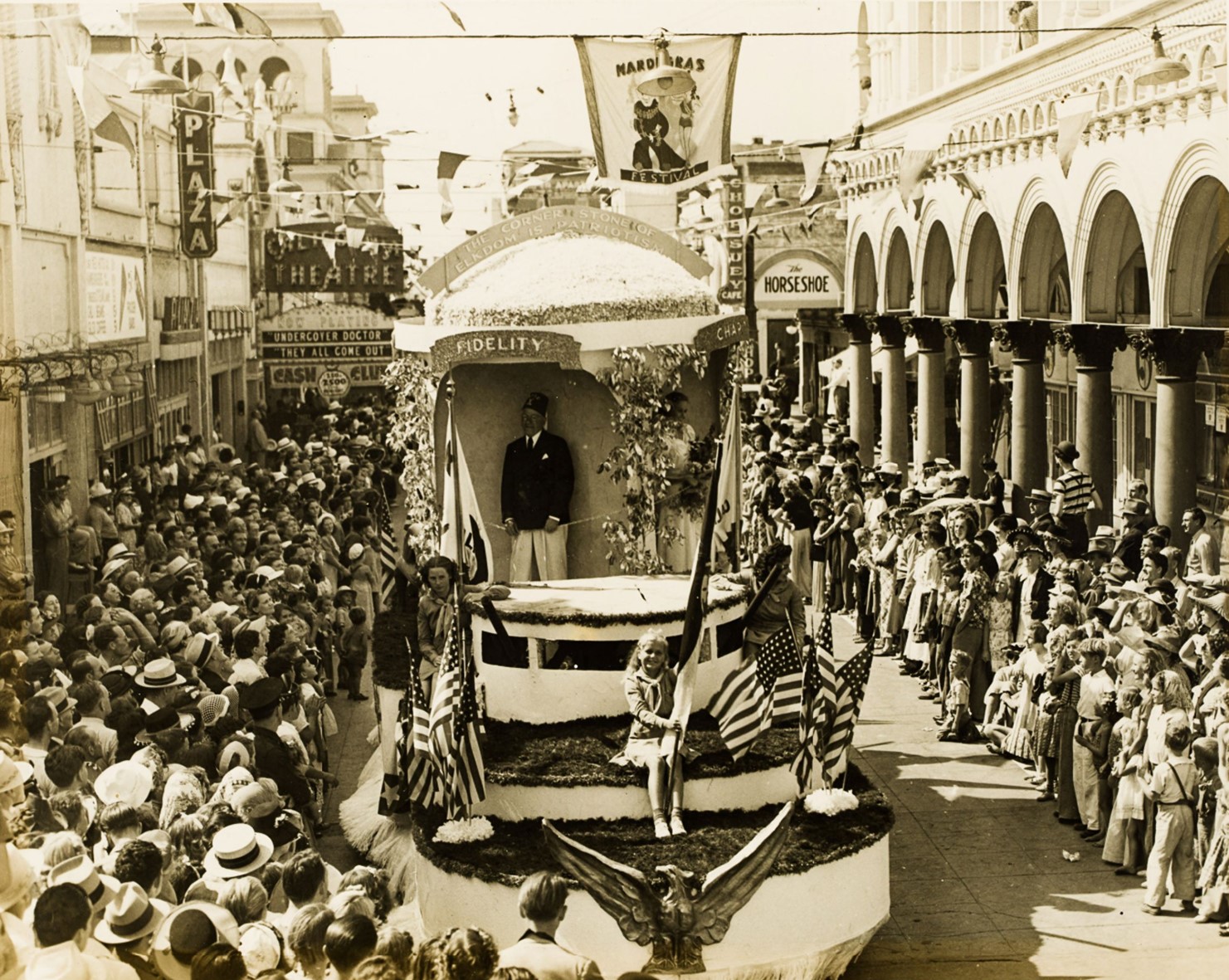 |
|
| (1939)* - A Mardi Gras Festival parade on Ocean Front Walk near Windward Avenue in Venice, with the colonnades of the St. Mark’s Hotel visible on the right. Signs along the parade route include ‘Undercover Doctor’ and ‘They All Come Out’ on a movie marquee, as well as 'Plaza,' 'The Horseshoe,' 'Chop Suey Cafe,' 'California Theatre,' and 'Mardi Gras Festival.' A float in the parade displays the message 'The cornerstone of Elkdom is patriotism, fidelity, [charity?],' featuring a girl, young women, and an Elks member wearing a fez. Photo from the Ernest Marquez Collection. |
Historical Notes Venice launched its own summer Mardi Gras Festival in August 1935, modeled after New Orleans but timed in August to draw beach crowds. Pageantry included the arrival of King Neptune by outrigger canoe, the coronation of Queen Venetia, and parades along Ocean Front Walk and Windward with entrants wearing enormous papier-mâché heads crafted in local studios. By 1941 the festival ran four days and drew press estimates of about 500,000 before World War II ended the tradition. The film titles on the California Theatre marquee here—Undercover Doctor (1939) and They All Come Out (1939)—help pin the date of this photograph to the ’39 season. |
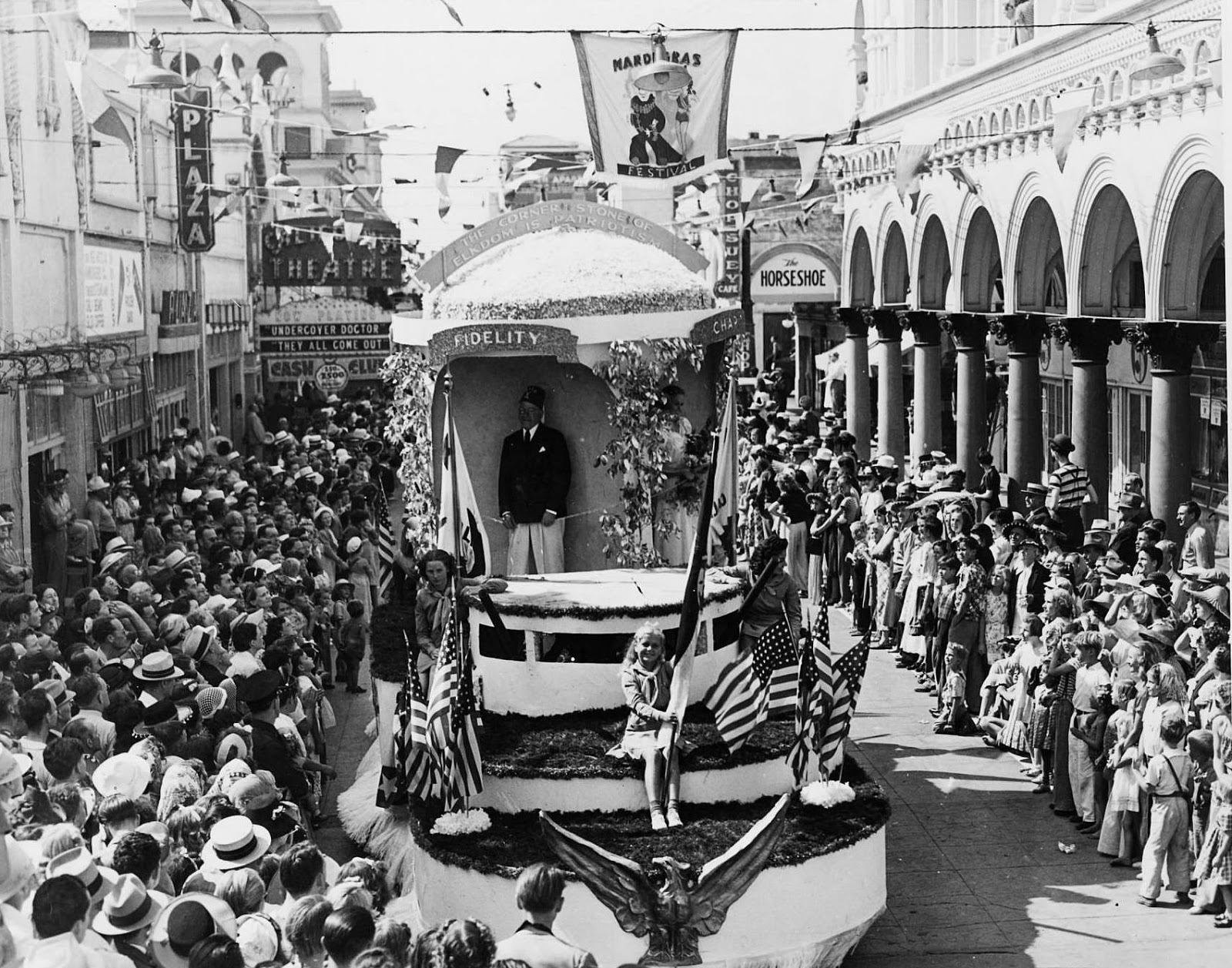 |
|
| (1939)* - A Mardi Gras Festival parade on Ocean Front Walk near Windward Avenue. Photo from the Ernest Marquez Collection. |
Historical Notes By the late 1930s, Venice’s Mardi Gras had become a regional draw, mixing beauty pageants, street carnivals, and elaborate floats with seaside amusements. Costumed entrants and masked performers processed beneath the Windward colonnades and past theaters, cafés, and game halls, advertising the very businesses that sponsored the festivities. The crowds—and the revenue—were central to keeping the Ocean Front Walk entertainment zone humming on summer weekends. |
 |
|
| (1937)* - Looking north on Ocean Front Walk with The Plunge just beyond and the beach off to the left behind the California Theatre. |
Historical Notes The California Theatre sat on the water (west) side of Ocean Front Walk between Windward and Market Street (Market had been called Zephyr until 1925). It anchored a block of amusements that also included the now-vanished Plunge just beyond it. Address listings in the early 1920s place the theatre around 1506–1508 Ocean Front Walk; it later rebranded as the Venice Theatre in the 1940s. Photographs from the late 1930s show a streetscape of arcades and two- and three-story façades whose plaster and pressed-brick details echoed the Venetian theme. |
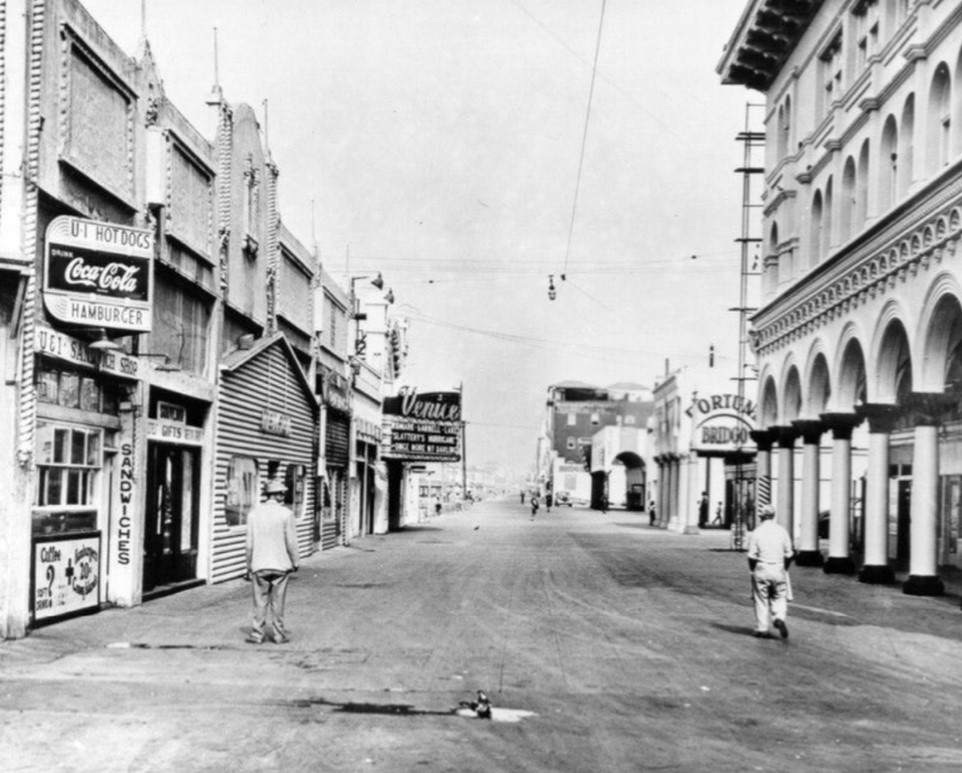 |
|
| (1949)* - A look north on Ocean Front Walk towards Ocean Park. Far down on the left is the Venice Theatre (formerly the California Theatre), and on the right is the St. Mark's Hotel. |
Historical Notes After World War II the seaside resort slid into neglect as Los Angeles consolidated control (Venice voted to merge with L.A. in November 1925; consolidation followed in 1926), piers were removed or closed, and code enforcement squeezed aging buildings. The Venice Theatre was still operating in 1949, but the Plunge had already come down; the Abbot Kinney Pier had been dismantled in 1946. Within a few years, the city cleared the entire west/ocean side of this block, including the theatre. |
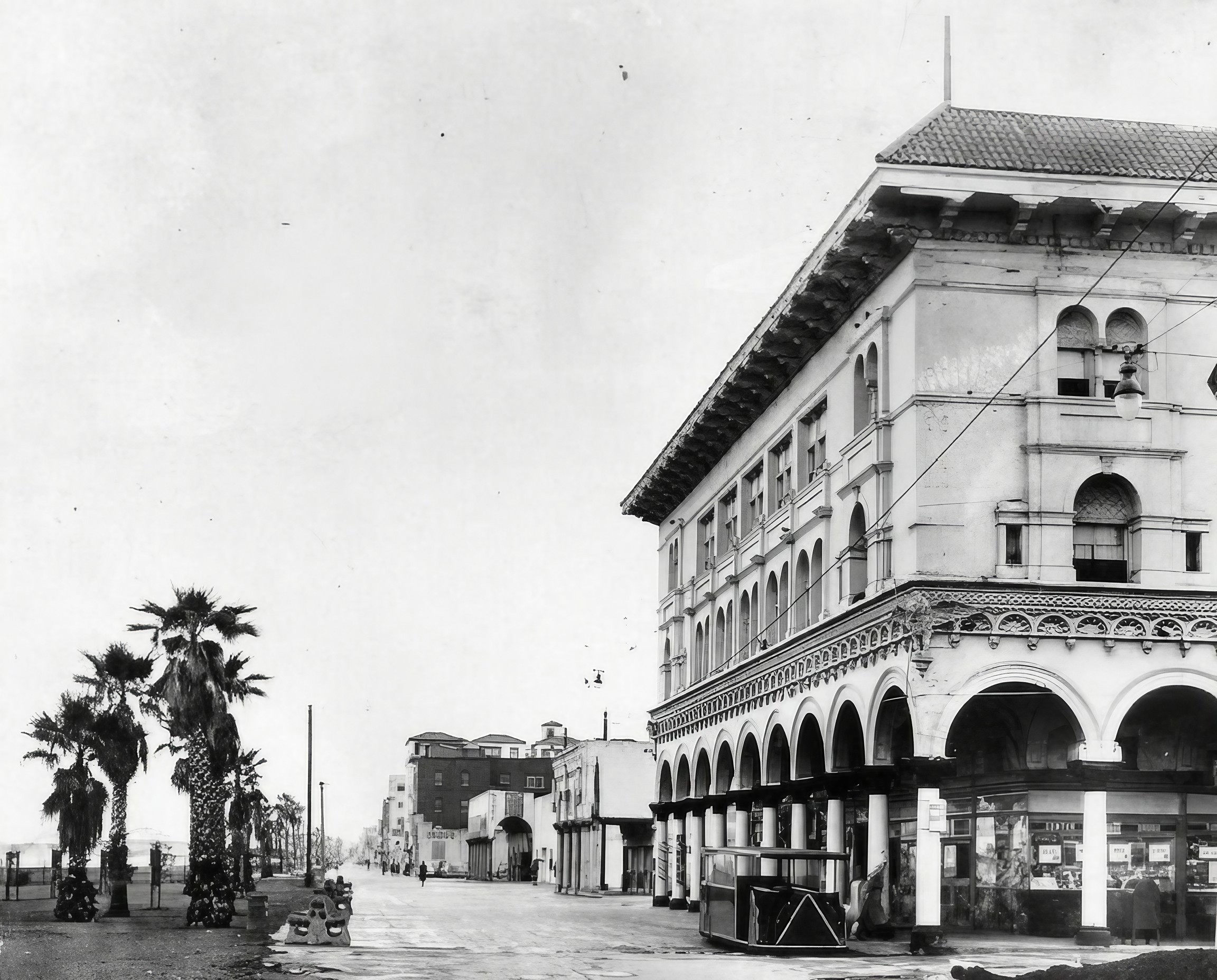 |
|
| (1955)* - Looking north on Ocean Front Walk at Windward Avenue. On the corner on the right is the St. Mark's Hotel, with a drug store filling the street level rooms. An empty tram car sits on the corner by the hotel. Note: All the buildings on the left (ocean side) have been demolished. |
Historical Notes This scene shows the aftermath of early-1950s urban renewal on the ocean side: the California/Venice Theatre and its neighbors were demolished in 1952 as part of a plan to widen the beach and open views. On the inland side, the St. Mark’s Hotel still stood in 1955, but it was removed during the mid-1960s wave of demolitions that leveled hundreds of Venice buildings. The vacant west side would later be landscaped into Windward Plaza Park. |
Then and Now
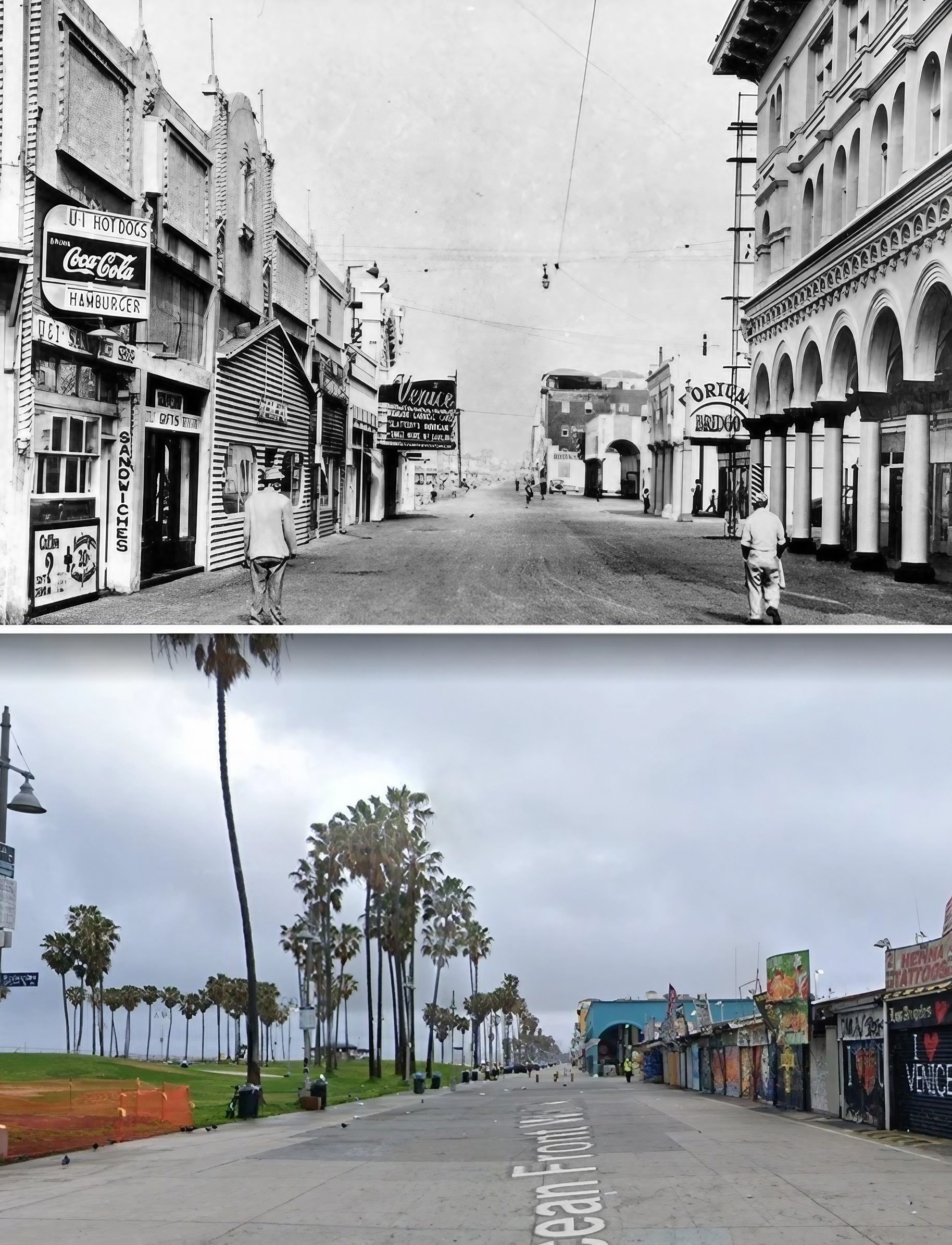 |
|
| (1949 vs 2022)* - Looking north on Ocean Front Walk from Windward Avenue in Venice. The St. Mark’s Hotel on the right was demolished in the mid-1960s. The entire row of buildings on the left, including the Venice Theatre, was also demolished and today is the location of Windward Plaza Park. Photo comparison by Jack Feldman. |
Historical Notes Ocean Front Walk has been repeatedly remade. The 1905 colonnaded resort thrived through the 1920s–30s, declined after the war, and then saw large-scale clearances in the mid-1960s that erased much of Windward and the beach-side frontage. In the late 1970s, outdoor roller-skating exploded here—Mayor Tom Bradley even dubbed Venice the “roller-skating capital of the world” in 1978—and a new arts/bohemian identity took hold. Recent decades layered in public amenities, including the Venice Beach Skatepark (opened 2009) near Windward. Today’s boardwalk mixes souvenir stands, street performance, murals, and recreation—a very different, but still crowded, promenade. |
Before and After
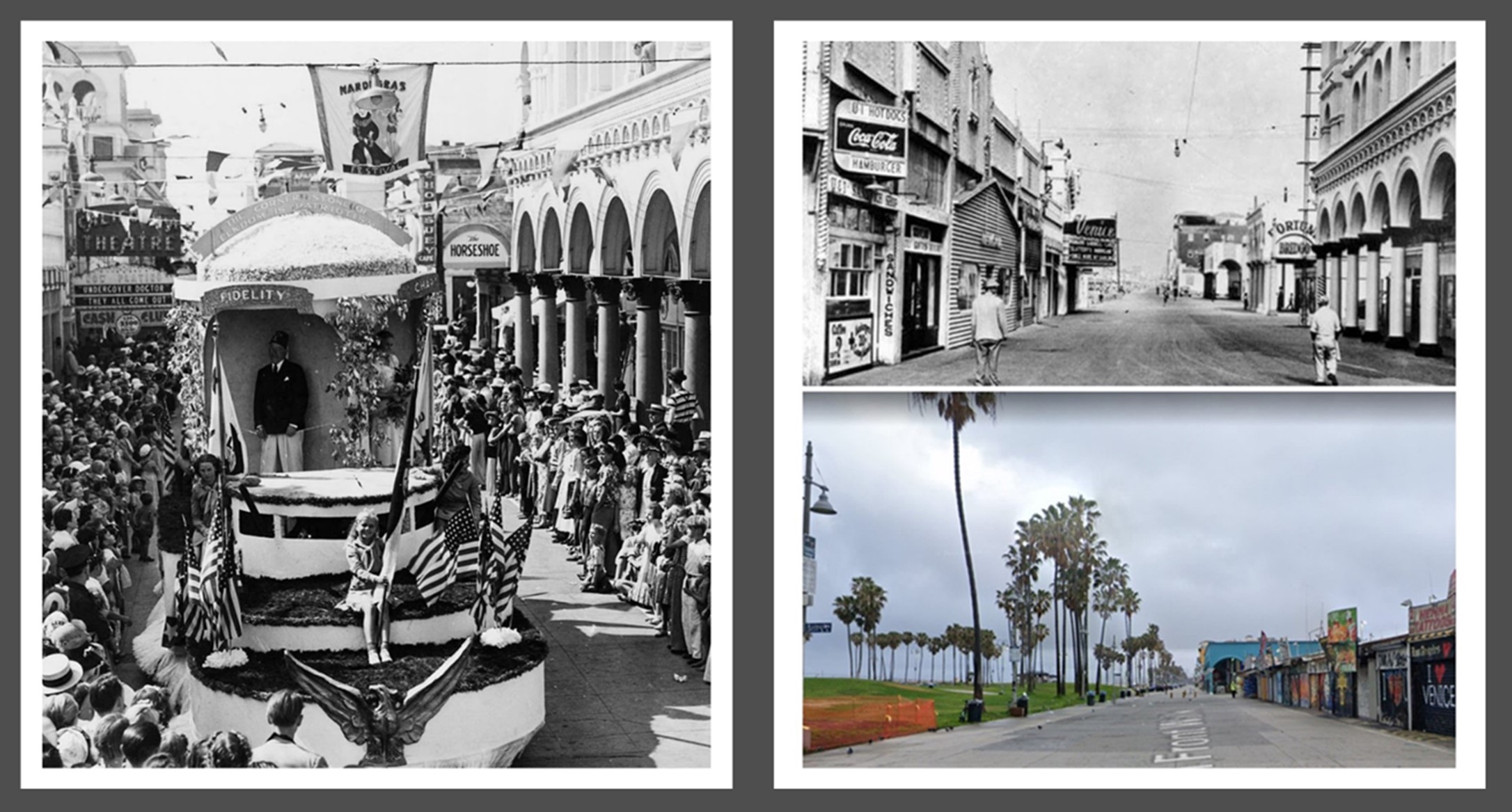 |
|
| (1939 / 1949 / 2022) - Ocean Front Walk just north of Windward Avenue. |
Historical Notes The three frames chart a century of change in a single block: (1) late-1930s Mardi Gras pomp against a backdrop of theaters and cafés; (2) post-war decline and imminent clearance (by 1949 the Plunge was gone and ocean-side demolition was near); (3) a contemporary leisure park replacing the old west-side structures, with the colonnades and Windward’s axial view still defining the walk. The cross-street once labeled Zephyr on maps had become Market Street by 1925; most of the Venetian-revival façades between Market and Windward were removed during mid-century renewal. |
* * * * * |
Ocean Front Walk - Venice
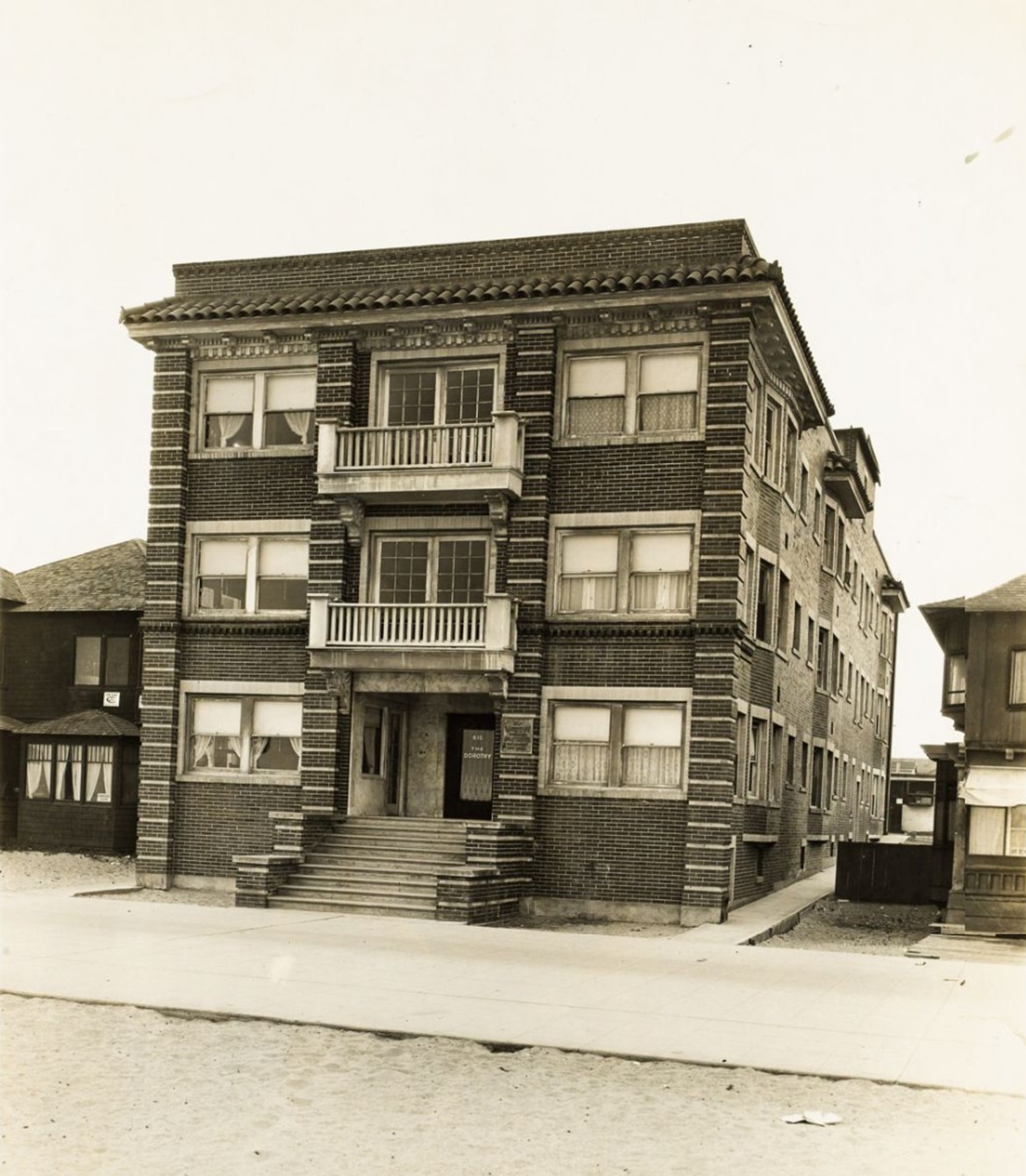 |
|
| (ca. 1920s)* – The Dorothy Apartments at 615 Ocean Front Walk, Venice, California. This three-story brick building with its tile roof and twin balconies stood just steps from the sand. The glass door is lettered “The Dorothy. 615.” reflecting the apartment house’s identity in the late 1920s. |
Historical Notes The Dorothy Apartments were one of the early multi-unit walk-ups built steps from the sand as Venice shifted from a resort of weekend hotels to a community with long-term tenants. Assessor records date the building to 1910, and a period photograph confirms the identity—the glazed door reads “The Dorothy. 615.” Its original look (three stories of brick with a tile roof and twin street-front balconies) fit the boardwalk’s 1910s–20s pattern: masonry construction with modest ornament facing the arcades and beach. Being south of Windward, the Dorothy sat outside the 1952 ocean-side clearance zone that erased the California/Venice Theatre block, which helps explain why the building survived when so much else nearby did not. |
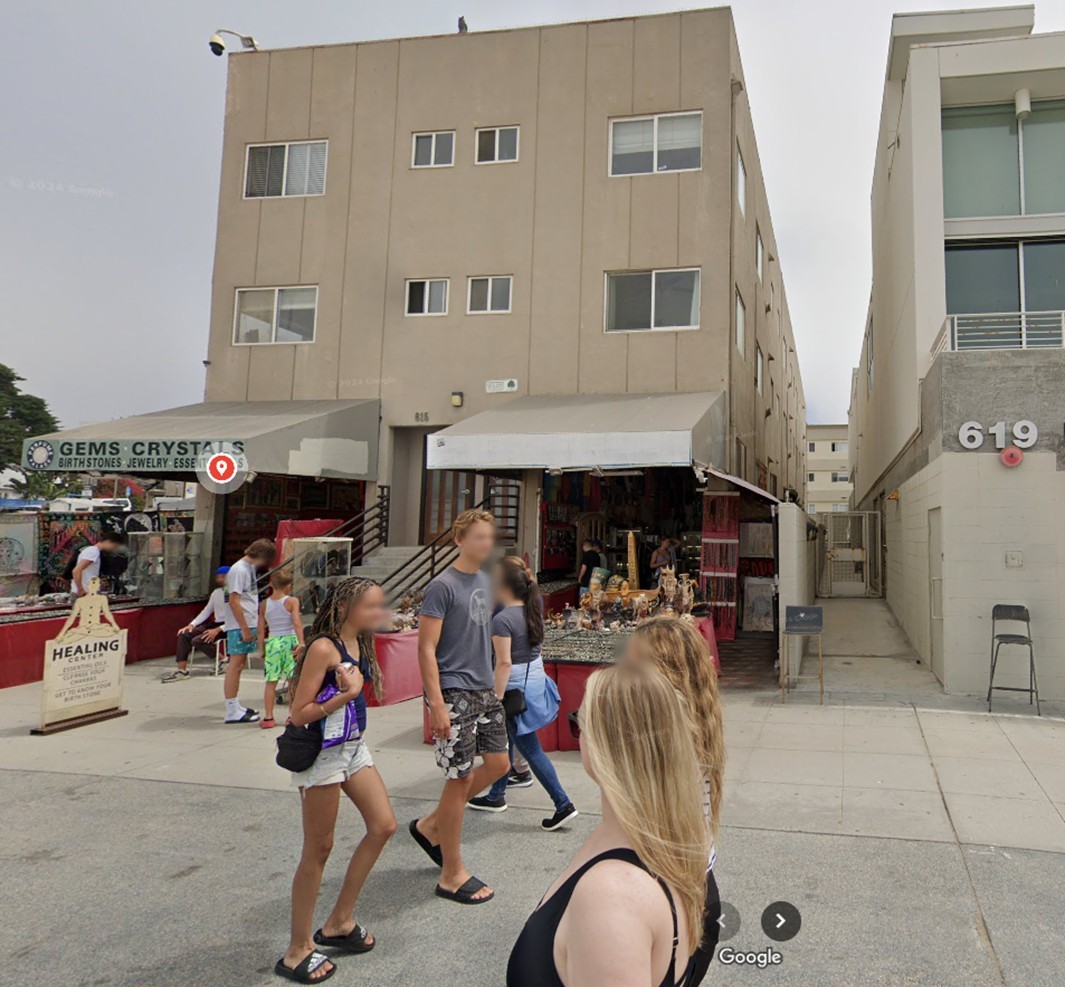 |
|
| (2024)* – The former Dorothy Apartments at 615 Ocean Front Walk, Venice, California. Though the brick façade, tile roof, and balconies are long gone, the building’s original three-story form and window placement reveal its identity. Now resurfaced in stucco and converted to retail at street level, it remains a presence on the Venice Boardwalk nearly a century after it was built. |
Historical Notes Though its brick skin and balconies have been stripped and the exterior resurfaced in stucco, the building’s three-story massing and window rhythm still match the 1920s view. Public records show later alterations—a documented 1942 renovation and a substantial 1976 alteration—and today the property functions as a mixed-use boardwalk building with ground-floor retail and upstairs apartments that continue to lease. The persistence of the footprint and fenestration makes it a rare physical link to the pre-war apartment era on Ocean Front Walk. |
Then and Now
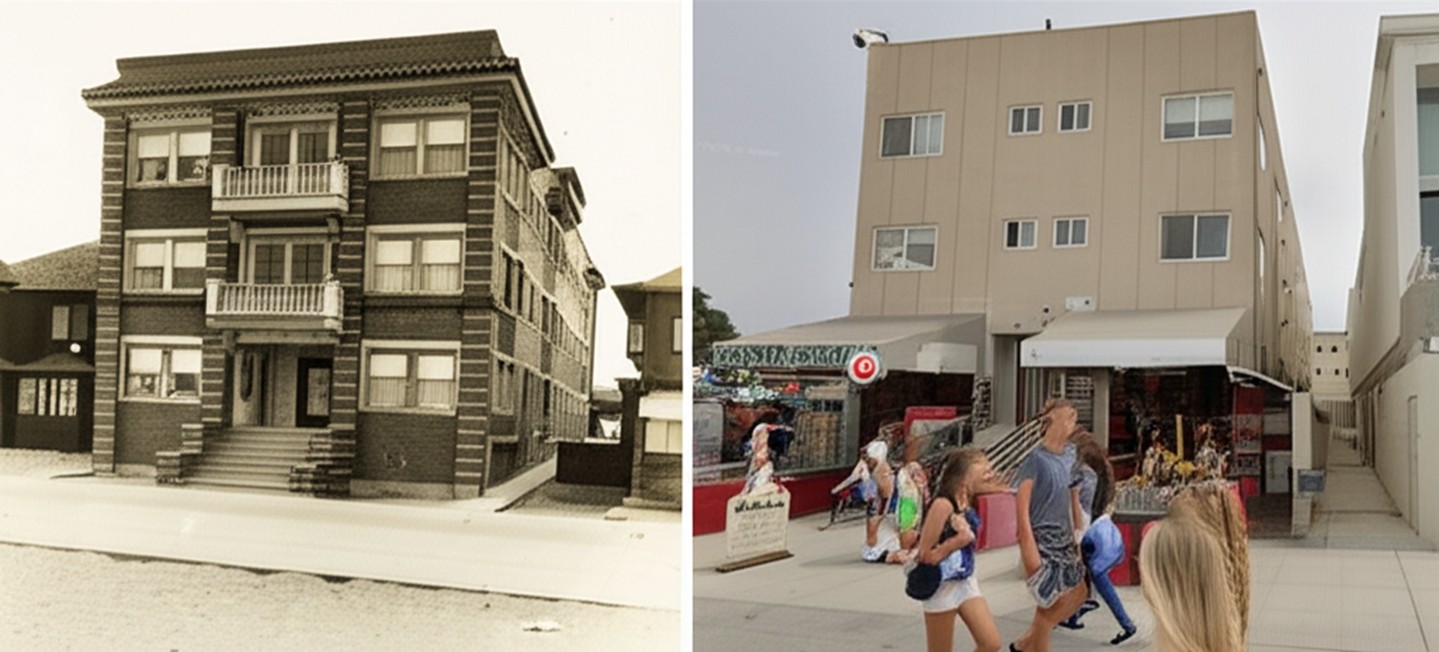 |
|
| (1920s and 2024)* – The Dorothy Apartments at 615 Ocean Front Walk, Venice, California. The original three-story brick structure, with its tile roof, balconies, and decorative details, has survived but in a dramatically altered form. Stripped of its ornamentation and resurfaced in stucco, the building has been adapted for modern use with ground-floor retail shops opening onto the Venice Boardwalk. Photo comparison by Jack Feldman. |
Historical Notes Side-by-side, the photographs show how Venice buildings have been adapted rather than restored: the Dorothy kept its bones (plan, height, bays), while successive owners simplified the exterior to meet post-war tastes and maintenance realities. That trajectory mirrors the boardwalk’s own story—ornate resort façades gave way to plainer skins as uses shifted to storefronts, rentals, and tourist retail. Despite heavy change across the district, the Dorothy’s surviving form makes it an instructive case of continuity amid transformation on the Venice waterfront. |
* * * * * |
Please Support Our CauseWater and Power Associates, Inc. is a non-profit, public service organization dedicated to preserving historical records and photos. We are of the belief that this information should be made available to everyone—for free, without restriction, without limitation and without advertisements. Your generosity allows us to continue to disseminate knowledge of the rich and diverse multicultural history of the greater Los Angeles area; to serve as a resource of historical information; and to assist in the preservation of the city's historic records.
|
For more Historical Los Angeles Views click one of the following:
For Other Historical Views click one of the following:
See Our Newest Sections:
To see how Water and Electricity shaped the history of Los Angeles click one of the following:
Water:
Power:
* * * * * |
References and Credits
* DWP - LA Public Library Image Archive
^ LA Public Library Image Archive
^*The Valley Observed: Street Name Origins; Timeline of Valley History
+*The Eastsider LA: Avenue of the Palms
*# blogdowntown: Third Street Tunnel
#* About.Com: History of Electric Vehicles
#+ Facebook.com: Classic Hollywood/Los Angeles/SFV
#*^Library of Congress: Venice Lagoon
##*A Visit to Old Los Angeles: CSULB
*##LA Times: Dig Into History You'll Find Snake Oil..Victor Girard Kleinberger ; 1900 Fashion
^##Metropolitan Transportation Library and Archive
##^CSUN Oviatt Library Digital Archives
###Denver Public Library Image Archive
*#*Historical Los Angeles Theatres: The Philharmonic Auditorium; Downtown Theatres
*^#LincolnHeightsLA.com: Legion Ascot Speedway
**#KCET - Lost Tunnels of Downtown LA; Three Forgotten Railway Inclines; Edendale Red Car Line; The Origins of Elysian Park; When L.A. Was a Horse-Powered Town; How L.A. Celebrated Sunset Boulevard's Opening in 1904
^*#California State Library Image Archive
^^#forum.scraperage.com: Aliso St; Hill Street Tunnel, 1903; Broadway Tunnel
*#^History of Hermosa Beach - Maureen Megowan
^#*City of Redondo Beach HIstory
^#^Noirish Los Angeles - forum.skyscraperpage.com; Broadway Tunnel; Sugarloaf Point; Angels Flight; Avalon; Boylston Yard
+#+Silentlocations.wordpress.com: Venice Minitiare Railroad
++#Everydayarmour.blogspot.com/
^^*Early Downtown Los Angeles - Cory Stargel, Sarah Stargel; Hollenbeck Hotel
***Los Angeles Historic - Cultural Monuments Listing
**^Historicechopark.org: Echo Park Lake; Elysian Park
*^*California Historical Landmarks Listing (Los Angeles)
*^^Nuestra Señora la Reina de los Ángeles: losangelespast.com
^^^Aerofiles - US Aviation Firsts
***^Oviatt Library Digital Archives
***#Pinterest.com: 1890's to 1920's Los Angeles - Anna Blanc's LA; Snapshots - Avalon Bay
#***S.S. Hermosa: pasadenastarnews.com
#**^LA County Library Image Archive
#*#^Brand Park and Studios: glendale.ca.us
*^#*On Bunker Hill: Crocker Mansion
*^#^Huntington Digital Library Archive
^^*^Restaurantwarecollectors.com: Angelus Hotel
^^^#Los Angeles Fire Department Historical Archive
#*^^Flickr.com: Views of Los Angeles
^*##Calisphere: University of California Image Archive
^##^Glendale Historical Society
^#^#U.S. Geological Survey Photographic Library
*#**Los Angeles Westerners Corral: Venice Miniature Railway
^#*^Facebook.com - Bizarre Los Angeles
*#*#Abandoned & Little-Known Airfields – Paul Freeman
^#*#Angels Flight Goes to the Movies
*##*Chatsworth Historical Society
+##+Restaurant-ing Through History: Ice Cream Parlors
**#*Creating a Landmark: the Historic Casino Point
*###Pacific Coast Architecture Database (PCAD): Bryson-Bonebrake Block
###*Glendalecagov.org: Glendale History
*##^Wikimapia: Pacific Electric Edendale Cut
#**#Debunking Venice's Historic Myths
#^^#Facebook.com: Garden of Allah Novels, Martin Turnbull
****#Tumblr.com: LA History - Leonis Adobe
#+++Facebook.com: West San Fernando Valley Then And Now
#+#+Glendale News-Press: Tropic
**#**Electric Railway Historic Association: Angel's Flight
**^*^Pacific Electric Historical Society
^^^**Metropolitan News: H. Jevne Co. Offers Free Home Delivery
^^^^#A History of the Los Angeles City Market
*#*#*Venice Miniature Railroad - Jeffrey Stanton
*^ Wikipedia: H.J. Whitley; Occidental College; Beverly Hills; Beverly Hills Hotel; Los Angeles Railway; Pershing Square; Broadway Tunnel: Isaac Van Nuys; Sawtelle; Port of Los Angeles; Tournament of Roses Parade; Angels Flight; Occidental College; Mt. Washington, LA; Broadway, LA; Hancock Park; La Brea Tar Pits; Los Angeles City Oil Field; Deadman's Island (San Pedro); Moses Sherman; Rose Bowl Game; Hollywood Hotel; Hollywood HIgh School; California Club; San Pedro; Salt Lake Oil Field - Gilmore Oil Field; Westwood; 2nd Street Tunnel; Hermosa Beach; Los Angeles Memorial Coliseum; Redondo Beach Pier; Redondo Beach; West Hollywood; Pacific Palisades; 1910 L.A. International Air Meet at Dominguez Hills; Hancock Park; Marlborough School; Pacific Electric Building; History of the Los Angeles Police Department; History of Los Angeles Population Growth; Avalon Bay Stereoscopic View; History of UCLA; Leslie Brand; Venice Canal HIstoric District; Leslie Brand; Grand Central Airport; Leonis Adobe; Los Angeles Herald-Examiner; Camera Obscura; Friday Morning Club
< Back
Menu
- Home
- Mission
- Museum
- Major Efforts
- Recent Newsletters
- Historical Op Ed Pieces
- Board Officers and Directors
- Mulholland/McCarthy Service Awards
- Positions on Owens Valley and the City of Los Angeles Issues
- Legislative Positions on
Water Issues
- Legislative Positions on
Energy Issues
- Membership
- Contact Us
- Search Index